- Search Please fill out this field.
- Manage Your Subscription
- Give a Gift Subscription
- Newsletters
- Sweepstakes
- Airlines + Airports

20 Tips First-time Fliers Need to Know
Whether you're flying domestically or internationally, here's how to make your first flight more enjoyable.
Congratulations, you’ve booked your first flight! Pat yourself on the back, because there are only a few more steps between you and a seamless flying experience. If you’re like most people, exploring something new — like the cabin of an airplane — can be daunting. While not every first-time flier will mistake the emergency exit for the bathroom, there are some common errors newbie travelers frequently make. To help you have a smooth and stress-free journey, we've compiled 20 tips first-time fliers should know.
Book a specific seat.
If you prefer aisles or windows to middle seats, be sure to choose your seat early. Select your preferred option when booking your ticket or log onto the airline’s website before your flight. Many airlines list the airplane model on their ticketing page, but you can also use a third-party site like SeatGuru to view seat maps. Don’t see a spot you love? Sign up with the website ExpertFlyer , which alerts you when your seat of choice frees up and is available to book.
Download your airline's app.
Skip the long lines at the airport by using your airline's app to check in, grab your boarding pass, and head straight to security. You can also use the app to check your flight status, including delays, cancellations, or gate changes in real time. Many airlines let passengers access in-flight entertainment through their app, so download it in advance if you want to watch movies on your own device.
Buy travel insurance.
Even if you plan everything perfectly, things can go wrong when you travel, from flight delays to lost luggage. Travel insurance can compensate you for some of these expenses and, at the very least, provide you with peace of mind. Whether you're looking to purchase flight insurance or a comprehensive plan that covers medical expenses like emergency evacuation, plenty of options are available. Some credit cards offer some degree of protection, such as lost baggage or flight cancellation insurance, so it's worth checking your perks before your trip.
Pack light.
The general rule when you pack for a trip is that you don’t need as much as you think you do. Traveling with only a carry-on can save you time at the airport and help you avoid the hassle of lost luggage, but you'll want to pack efficiently to maximize space. We've got a handy-dandy carry-on packing list to make sure you don’t overthink it.
Make sure your carry-on is the right size.
Domestic and international travel each have a different set of rules when it comes to carry-on bag sizes. Before you head to the airport with your carefully packed bag, check your airline’s carry-on size restrictions and if you have an additional tote, make sure it qualifies as a personal item.
Avoid packing large liquids in your carry-on.
If you’re not checking a bag, remember that carry-on liquids, gels, and aerosols have to be 3.4 fluid ounces or less and fit in a clear, quart-size bag. We recommend using a TSA-approved toiletry bottle set to transport your shampoo, conditioner, and other liquids without any issues.
Check your passport expiration date.
There is nothing quite like the panic that comes from booking a spontaneous vacation and realizing your passport is expired — or not realizing that you need a passport to visit Canada or Mexico. Adding to the challenge is that some countries won’t allow you to visit within six months of your passport’s expiration date in case you take an extra-long vacation. In short, it never hurts to check your passport’s expiration date and, if necessary, renew it before your next big trip. Also, if you're flying domestically, make sure your state-issued ID is valid for travel per TSA's identification rules .
Review your itinerary.
Traveling between time zones or around the world can be confusing. That’s why it always pays to take a tip from Santa Claus and make a list and check it twice. Go through your itinerary, confirm your airport (Did you book Heathrow or Gatwick? JFK or Newark?), your connection times (How long does it take to get to the train station? Which time zone is that?), and your plane tickets, including whether or not your name is spelled correctly on your documents.
While you’re working your way through the list, confirm your reservations for everything from hotels, flights, trains, buses, and tour groups.
Arrive at the airport early.
Most airlines recommend arriving at the airport three hours before an international flight or two hours before a domestic flight. If you're a first-time flier, give yourself extra time, especially if you’re flying during the holidays, traveling with kids, or checking bags. You can speed up the process by checking in online, booking a business class ticket with priority check-in privileges, flying with a carry-on only, or signing up for TSA PreCheck or Clear , which allows you to get through security faster.
Figure out your phone plan.
If you're flying out of the country, contact your service provider in advance to buy data roaming and an international calling plan. If you do not want to use your phone while traveling abroad but have it with you, shut off the data roaming on your device or risk a hefty phone bill. Download travel apps before your trip and use them when you’re on the hotel’s Wi-Fi or purchase a local SIM card so you text, call, and use data while abroad.
Be respectful of your fellow passengers.
Plane cabins are cramped spaces, so it's important to be mindful of how your actions impact the people around you. There are several unwritten rules of airplane etiquette, such as wearing headphones while listening to audio, avoiding smelly food and fragrances, and sticking to your assigned seat. Most of these are common sense, but it's a good idea to review some of the unspoken rules of air travel , especially if it's your first time flying.
Adjust to your new time zone as soon as possible.
If you're traveling across time zones, you'll likely experience jet lag. To quickly recover, get a head start on resetting your body's internal clock by adapting to your new time zone during the flight (or even a few days before you depart). On a long-haul flight, set your watch or phone's clock to the new time zone so you can sleep when it's nighttime in your destination and arrive feeling relatively refreshed. Plane cabins are notoriously dry environments, so staying hydrated and avoiding caffeine and alcohol while in the air can help you mitigate the effects of being at a high altitude.
Don't exchange too much money before you travel.
It’s a good idea to have some of the local currency on hand when you land, but don’t overdo it. Too much cash invites disaster if it’s stolen or lost. Figure out your budget and grab some cash at your bank or an airport ATM. If you do run out of cash, it’s easy to withdraw more at a local bank or ATM in most countries.
Alert your bank of your vacation plans.
There are few things more frustrating than having your credit card frozen when you’re on vacation because your bank thinks your card has been stolen. While most banks are now sophisticated enough to know when you're traveling based on your recent purchases (e.g., flights, hotel reservations, etc.), you may want to notify your credit card company’s fraud department that you’re leaving the country just in case.
While you’re on the phone with your credit card company, ask them to send you a credit card with a chip in it (if you don’t already have one). While most places can still swipe your card’s magnetic strip, many countries are relying on chip technology for things like train ticket machines, gas stations, and food purchases. Having a chip card option can make your life easier when you travel.
Bring backup entertainment.
Most airlines offer free onboard entertainment, including movies and TV shows you can watch on a seatback screen or your personal device. Some carriers have limited options, so it's a good idea to check your aircraft's amenities while booking your ticket. In any case, it's wise to bring a book, laptop, or tablet you can use in case the in-flight entertainment system isn't available. Make sure you pack your charger or a portable power bank in your carry-on and bring your own headphones for better sound quality.
Wear comfortable clothing.
Whether you're taking a red-eye or a shorter domestic flight, you'll want to dress comfortably for the journey. Opt for loose-fitting, breathable clothing, including an extra layer in case you get cold on the plane, as well as shoes you can easily slip on and off while going through security. Vacation is not the time to break in a new pair of kicks, so make sure you wear a tried-and-true comfy pair to the airport.
Bring your own snacks.
Don’t wait until you get to the airport to buy snacks for your flight. The restaurants and stores after security are notoriously pricey and often have limited options. Instead, pack your favorite nibbles that comply with the TSA’s rules. Stick to solid food items that don’t require refrigeration, such as protein bars or dried fruit and nuts.
Schedule a recovery day.
Many of us have limited vacation days, meaning we have to cram a lot of sightseeing, culture, food, and relaxation into an incredibly short time span. While you might be tempted to hit the ground running as soon as you land, scheduling some downtime after your flight can help you fully recover from any fatigue or jet lag. The same goes for the flight home — if you can, take a day off to relax and unpack before diving back into your usual routine, or you might end up needing a vacation from your vacation.
Use credit cards for purchases.
Back in the day, travel lore was to stick to cold hard cash (or traveler’s checks) while abroad. These days, the best exchange rates are often found using your credit card. When the sales clerk asks if you want the charge in dollars or the local currency, always opt for the local money as you’ll usually end up with a better rate.
That said, check whether your credit card charges foreign transaction fees and, if it does, apply for a new one before your trip. Chase Sapphire Preferred card and Platinum American Express are just two options that don't charge these fees.
Don't panic if things go wrong.
Follow Douglas Adams' advice from The Hitchhiker’s Guide to the Galaxy : “The most important thing a traveler needs to remember whether making their way through time and space or simply to Cleveland is this: Don’t Panic.” Things happen both at home and on the road and while missed connections, lost train tickets, or disappearing hotel reservations can be incredibly frustrating, panicking helps nothing. Stay organized and keep a cool head. By the end of the trip, you’ll probably have a great story to tell.
:max_bytes(150000):strip_icc():format(webp)/Julia-Eskins-Headshot-Julia-Eskins-2000-422db59e8e3a4b15b4c26bc7bfa75413.jpeg)
Related Articles
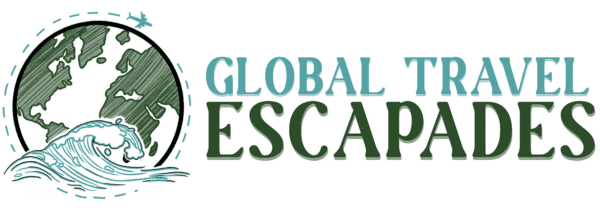
41 Useful First Time Flyers Tips: How to be Prepared (2024)
Whether you’re flying for the first time with your family, friends, or solo, navigating an airport can be both incredibly exciting and stressful-inducing. However, the most important thing to remember is that we’ve all been there at some point in our lives and it’s going to be okay! To make sure your experience is as smooth as possible, here are my 41 best first time flyers tips for everything from searching for flights to getting off the plane at your final destination .
Traveling Soon? Here Are the Travel Resources I Use!
🏡 Accommodations: I use Expedia or Booking for hotels and Hostelworld for hostels ✈️ Flights: I find the best deals on StudentUniverse & Skyscanner 🗺️ Travel Insurance: I suggest Safetywing as an affordable option 🤿 Tours & Experiences: I love to use Viator and Get Your Guide 🚗 Car Rentals : I recommend DiscoverCars for all your rental car needs! 📱 E-Sim: The company I’ve had the most positive experiences with is Airalo Use code ‘KRISTI7012’ for an extra $3 off your ESIM from Airalo!
41 Useful First Time Flyers Tips (2024)
The first step of every airport journey is booking your flight. Two flight search engines I highly recommend are Skyscanner and StudentUniverse . If you haven’t heard of StudentUniverse, you can read my in-depth review of StudentUniverse to help you decide whether you want to use them.
1. Check Airline Luggage Restrictions
As you shop around for the best flight tickets, it’s important to always check the airline’s luggage policies. Being aware of the restrictions and ensuring your luggage is compliant both in terms of size dimensions and weight limitations will help you avoid any unwanted surprises or fees. The first time I solo-traveled, I didn’t think to do this because I genuinely thought that there were universal sizes for carry-on and checked suitcases. I mean, you think this would be the case!? Unfortunately, I found out by way of a surprise $100 added fee that this was not the case. Thus, do yourself a favor and check luggage restrictions and weigh your bag at home! Trust me, it’s better to spend a few minutes searching for a tape measure and scale in the back drawer than handing airport staff your credit card 🙃
PRO TIP: If you’re flying with more than one airline, be sure to check the luggage policies of each airline! Budget airlines are notoriously strict!
Quick Guide to Luggage Sizes
- Personal bag or item: Typically a small purse, handbag, or school-size backpack that can be stored underneath the seat in front of you. There is no weight limit for your personal bag, unless otherwise specified by the airline.
- Carry-on bag or hand baggage: A smaller suitcase or duffel bag that can be stored in the overhead bins near your seat. Some airlines have no weight restrictions for carry-on bags, while others have strict limits. The main thing to remember is that you must be able to lift the bag into the overhead bin by yourself.
- Checked baggage or hold baggage: Large suitcases or pieces of luggage that must be weighed and checked in by airport staff. You won’t have access to checked luggage throughout the flight nor will you take checked bags with you through airport security. Most airlines have a weight restriction of 23 kg or 50 lbs for checked luggage.
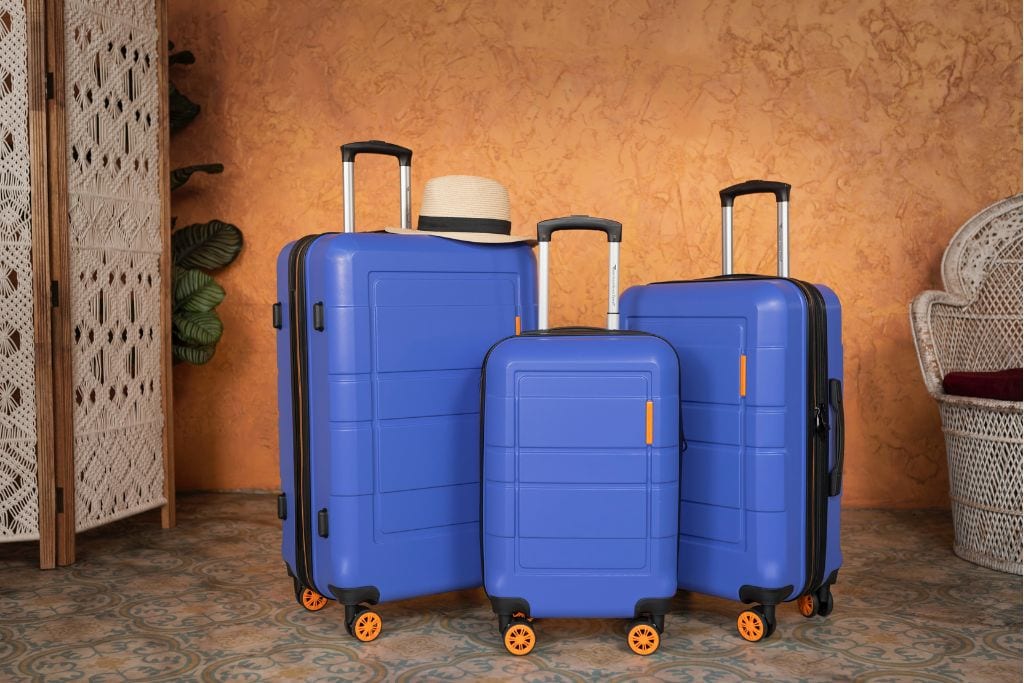
2. Make Your Luggage Identifiable
On your carry-on bag and any checked bags, I recommend attaching a luggage tag that has your contact information. These are helpful if you get separated from your luggage and can be great identifiers when you’re picking up your checked bag from baggage claim. With all the madness in the travel industry, a little travel hack is to place an Apple Air Tag inside your checked bag. Airports have been in absolute chaos as of late, so this is one way to get the most up-to-date information on your bag’s whereabouts. Plus, if the airport claims to have lost your checked luggage, you can show them your bag’s location using the Apple air tag, and this can expedite the retrieval process.
If you don’t have a dedicated luggage tag or Apple air tag and don’t plan on buying one, I suggest putting a piece of paper with your contact info inside your luggage.
3. Place Important Travel Documents in Folder
One travel tip that I wish I had discovered back when I was a first time flyer is to use a school folder to keep all my important documents together. I always print and place my housing accommodations paperwork, travel insurance papers, flight info, and any other documents in a nice folder. While it may seem silly to do this when we have smartphones, your phone can be unreliable when you’re in a foreign country and don’t have stable Wi-fi. Furthermore, being organized and knowing where things are is one of the best things you can do to alleviate any airport anxiety. Remember, success favors the prepared…and organize d!
4. Exchange Currency in Advance
If you are traveling abroad to a location with a currency different from your home currency, I strongly recommend exchanging currency at least 3 weeks before your trip. This is because foreign exchange rates at airports and abroad are typically worse than your local home bank. And even in the age of travel credit cards, it’s always a good idea to carry a little bit of cash on you in case of emergencies. Plus, small vendors and taxi drivers oftentimes only accept cash. In general, I recommend getting $100 USD worth of foreign currency per week you’re traveling. When you request money from your bank, it usually takes anywhere from 3 days to 2 weeks to arrive via mail. Thus, make sure you give yourself ample time!
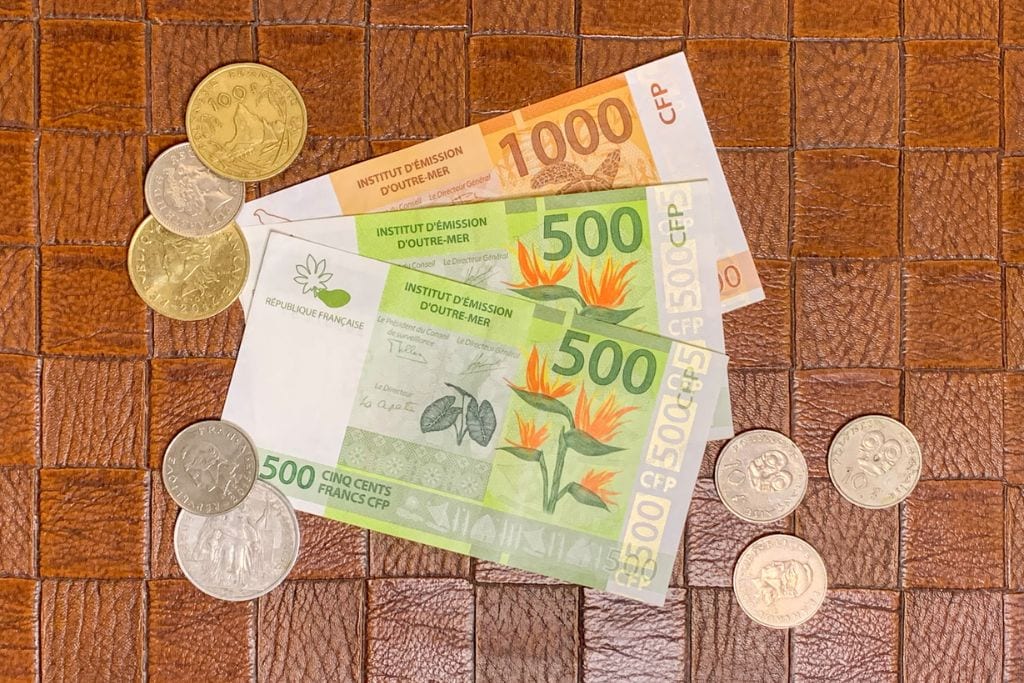
First Time Flyers Tips: Travel Essentials to Pack
When it’s a couple of days before your trip, it’s time to start packing! Here are some travel essentials I bring every time I fly and encourage you to as well.
5. Bring a Portable Luggage Scale
In this day and age, it’s all too easy to accidentally overpack or bring a few too many travel souvenirs home. Something that’s been absolutely life-changing for my travels is carrying a portable electric luggage scale. They are super light, easy to use, and help keep you in check. I find them to be especially worth it if you plan on traveling to several destinations in a single trip. Gone are the days of added fees because of overweight bags.
👉 Click to buy the $12 portable electric luggage scale I love to use and highly recommend.

6. Stay Hygienic
With COVID-19 and new variants cropping up seemingly every 6 months, it’s better to be safe than sorry. I recommend bringing a small travel-sized bottle of hand sanitizer as well as a pack of anti-bacterial wipes . Airports and planes are quite dirty with the amount of foot traffic they get. Therefore, I like giving myself a little bit of peace of mind by wiping down the seat tray before I set anything that’s mine on it. Furthermore, hand sanitizer is a way to clean up if you have a window seat and don’t want to disturb your seatmates to get to the bathroom.
7. Pack a Portable Battery
One thing that I have found to be incredibly useful over the years is a portable battery for my phone. There have been so many times when I’ve shown up at the airport, and the outlets don’t work. In turn, I spend the entire time trying my best to save my phone’s battery. Plus, some airplanes don’t provide you with outlets, such as those running shorter flights. The worst thing is arriving at a foreign destination and not being sure if you’ll have enough battery power to last until you reach your housing accommodations. Remove the added stress and anxiety of low batteries by investing in a good portable battery.
👉 Buy the same portable battery that I use and recommend. You get two for the price of one, so it’s a steal in my humble opinion 🤠
8. Invest in a Travel Pillow
For those longer flights, or really any flight that you might fall asleep on, it’s so worth investing in a travel pillow. I used to do 10-hour flights without a travel pillow, and even when I had a window seat, I would wake up feeling like death. Sometimes, my neck would be in pain for a couple of days after the flight due to my head whiplashing forward so many times. The lesson learned is to save yourself the pain and get a travel pillow. Your neck will thank you later, and you can use it for car rides, train rides, or pretty much anywhere you might fall asleep.
9. Pack a Light Jacket
Even if you’re headed to a hot and sunny destination, I recommend always carrying a light jacket in your personal bag or backpack. Airplanes get pretty chilly if they’re blasting the air conditioner. If nothing else, they make a decent pillow if you don’t have a proper travel pillow. That being said, your jacket likely can’t keep you warm and serve as a comfortable pillow.
10. Bring Headphones
One of my most valuable first time flyers tips is to always bring headphones or earplugs. If you have noise-canceling headphones, that’s even better. On nearly every flight, there is inevitably always at least one screaming child who makes sleeping a struggle. It’s during times like these you’ll want something to dim the noise, especially if you’re already anxious about flying. Recently, I was on a flight where I kid you not, there were 30 children under the age of 5 on the flight. Literally over a fourth of the passengers on the flight were small children. Never in my life had I been so grateful to have canceling headphones. Even when I’m not trying to sleep, having headphones to block out the external noise from the airplane itself makes the flight experience more enjoyable. Thus, I strongly recommend packing something to help block out the noises.
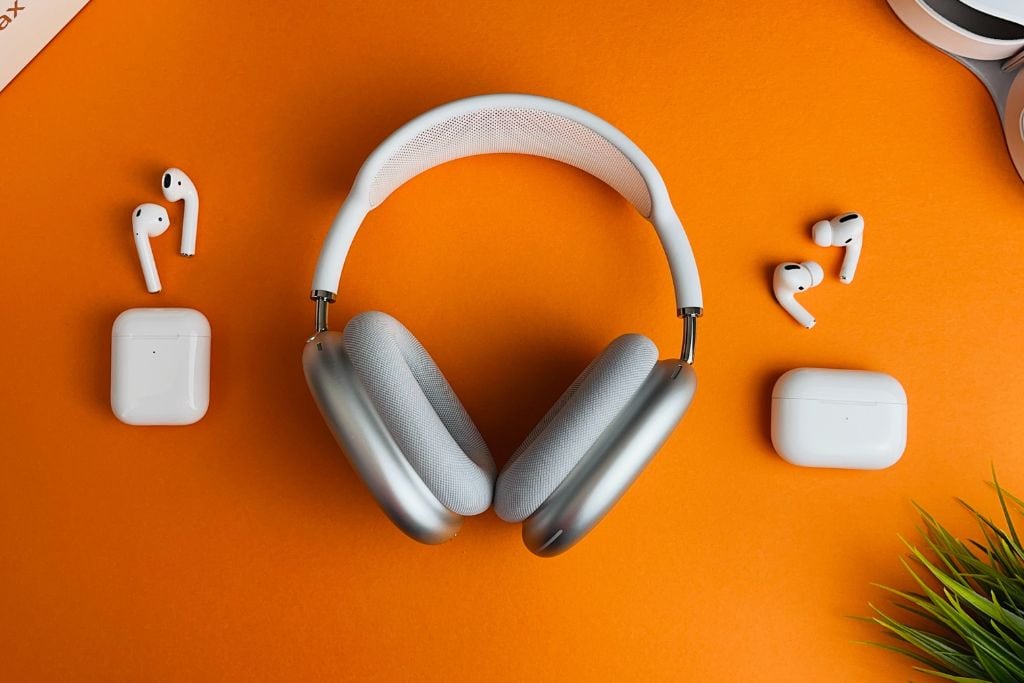
11. Stay Hydrated
A must-bring item is a reusable water bottle. One of the effects of flying and being at a high altitude is dehydration. Thus, it’s crucial to make an effort to stay hydrated. You can’t go through security with any liquids in your water bottle, so make sure you drink everything or empty it before you head inside the airport. After going through security, I recommend immediately finding a water fountain to refill your bottle up. This way, you won’t forget to do it later and can relax once you reach your boarding gate.
12. Bring Snacks for Provisions
Another tip for first time flyers is to bring a couple of snacks. For example, I always try to pack a few granola bars, a sleeve of crackers, and some mint mentos to chew on. Having snacks also come in handy if your flight is delayed, and you don’t want to pay for overpriced airport food! Just keep in mind that if you’re flying internationally, you may have to declare some food items. If you bring anything that isn’t allowed into the country, like fresh fruits, border control will likely have you throw them out.
NOTE: Don’t forget to pack some gum to help pop your ears during the flight!
13. Personal Entertainment
Since not all flights provide in-flight entertainment, I recommend bringing something to help you pass time. For instance, I like to download 5 or 6 shows from Netflix as well as an audiobook onto my phone at home. Don’t rely on airport Wi-fi to download large files because airport Wi-fi is often slow or has a time limit before they ask you to pay. The worst is when you can connect to the Wi-fi but don’t have internet access, so it feels like quite the tease. To avoid the struggles of airport Wi-fi, just assume that there is none, and that way you’ll be pleasantly surprised if it actually works!
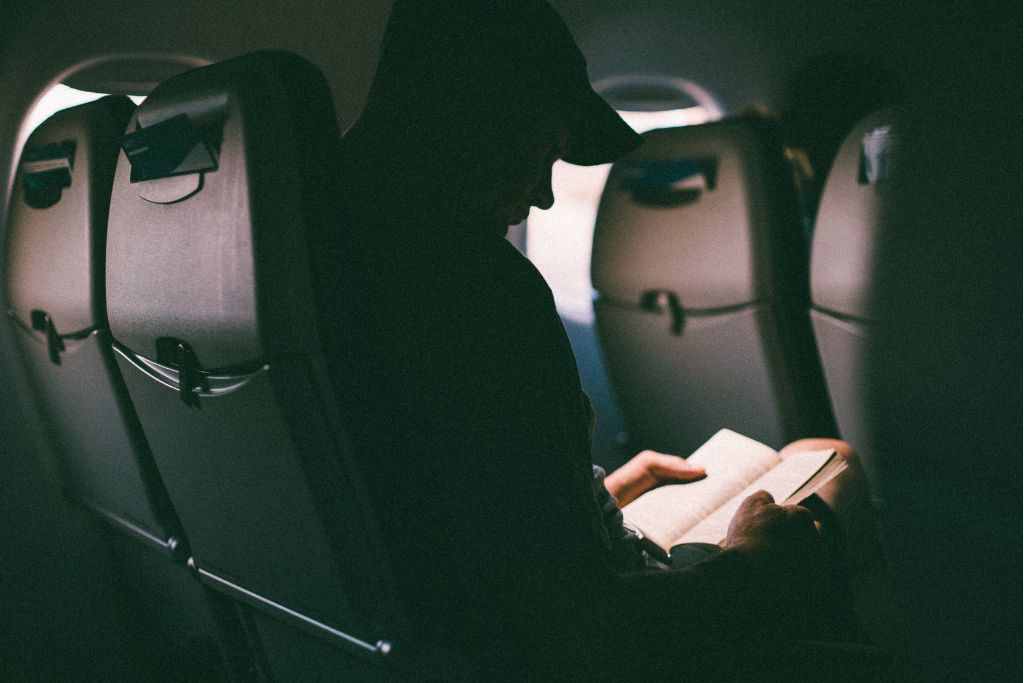
What to Do the Day Before Departure
When it’s the day before your flight, I have four first time flyers tips to ensure everything is ready to go!
14. Check-in Online in Advance
A couple of days before your flight departs, your flight provider will often send you an email reminder or two. At this time, I recommend setting some sort of alarm or reminder on your calendar to go off exactly 24 hours before your flight departs. 24 hours before your flight takes off is when most airlines allow you to check-in , and you definitely want to check in as soon as possible. There are three possible benefits of doing this: First, you will receive a move favorable boarding time. Typically, passengers are assigned boarding groups (or zones) based on rewards status and check-in time. The earlier you check-in, the earlier you get to board.
An earlier boarding time also means you’ll have an easier time getting settled in your seat and finding space in the overhead bins for your carry-on bags . If you’re in one of the last boarding groups, overhead bin space becomes limited and you may be forced to store your carry-on bag somewhere far from your seat. In turn, retrieving your carry-on bag can be a massive hassle and take more time.
The last and best reason to check in early is that you may be able to select your seat preference at no additional cost . Normally, you have to pay extra if you want a specific seat. However, a little travel hack is that if you check in immediately, some airlines let passengers without seat preferences pick their desired seat. Knowing where you’ll be sitting can help reduce stress and anxiety, especially if you’re someone who knows they want an aisle or window seat.
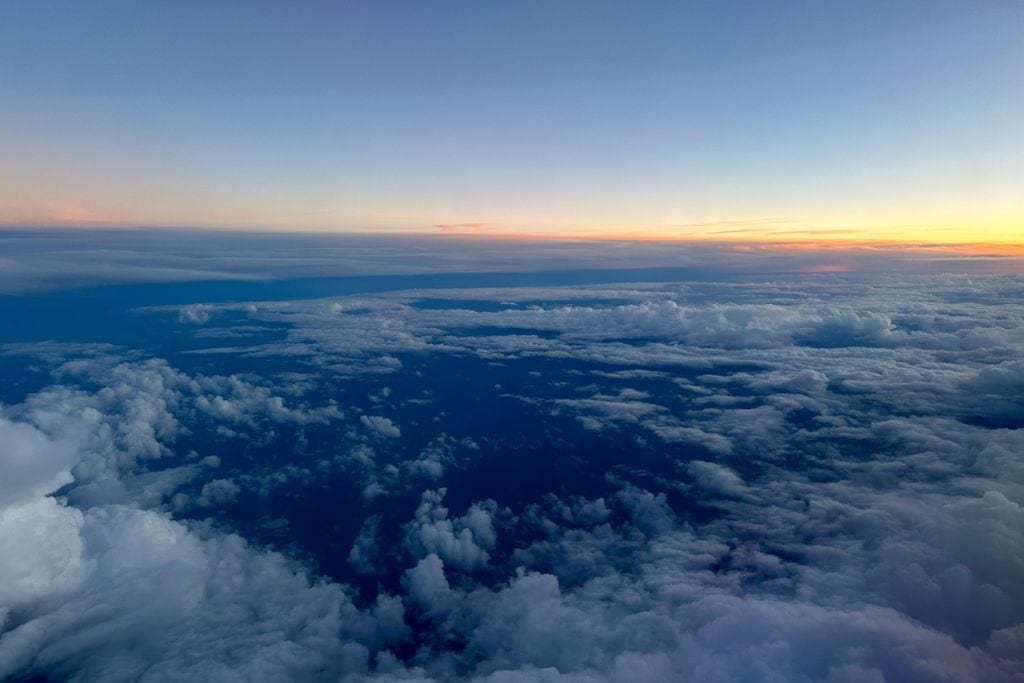
15. Send Flight Information to Family
After you check in, it’s always a good idea to send your flight information to a trusted family member or friend. This way someone outside your travel group knows what your general travel plans are and approximately where you are supposed to be at certain times. For example, I always email my parents my flight number and flight departure/arrival time for every flight I take. Even though there is nothing they can really do if something unexpected happens, at least they can track the flight and stay informed. Plus, It can just add an extra layer of peace knowing someone is looking out for you.
✈️ PROTIP: I highly recommend the app Notion for trip planning as it allows you to seamlessly share your travel information with trusted people. Additionally, the app updates in real-time, so all parties can see any changes made to your itinerary.
16. Take a Screenshot of the Ticket
Another first time flyers tip is to always take a screenshot of your ticket. If the airline sends you your boarding pass online, be sure to take a screenshot to ensure that you have it handy in the event you can’t load your email. Remember that airport Wi-fi can be finicky, and you don’t want to accidentally hold up any lines.
17. Know Your Backup Plan
The last thing you should do the day before leaving is make a backup plan. In the hopefully unlikely event something happens, such as your flight being canceled or heavily delayed after you’ve arrived at the airport, come up with a plan of action. It can be anything as simple as making a note on your phone of the customer service number or deciding to hunker down at the airport. Merely knowing what the first step is in the event something unexpected happens will help you remain calm as you evaluate your next step.
TSA Tips for First Time Flyers
Part of the airport security process is having your body checked as well as examining the items in your carry-on bag and personal bag. In my opinion, this is the most dreaded and stressful part of flying. There are usually lots of people, TSA agents are often yelling, and I just want to get through as fast as possible. To make sure you’re prepared and minimize the chances of being yelled at by TSA agents, here are a few first time flyers tips on things you should do before you leave for the airport.
18. Wear a Comfortable Outfit
First, you’ll want to make sure you’re wearing something that is comfortable to wear for the duration of your flight. Whether this means jeans, shorts, or sweats, the main thing is that you feel good in them, especially if you have a long-haul flight. No one likes to sit in the same position for long periods of time while wearing restrictive clothes. And if you want to dress to impress someone waiting for you on the other side, remember that you can always change in a bathroom immediately after deplaning at your destination.
Another thing to consider is that the more accessories you wear, the longer it will take for you to go through the TSA security checkpoint. I usually keep it simple and opt to wear some sweats, a regular t-shirt, and a light jacket.
19. Easy to Remove Shoes
Similar to the point above, it’s recommended you wear shoes that are easy to remove. At nearly every airport I’ve been to, TSA staff will ask you to remove your shoes before you walk through their giant scanners. You don’t want to get flustered because people behind you are getting impatient while waiting for you to remove your shoes.
I also highly suggest wearing socks with whatever shoes you pick. If you wear sandals, just know you’ll have to walk around barefoot, and airport floors are absolutely disgusting. Additionally, there’s a good chance your shoes will get stepped on or rolled across by at least one person’s luggage, so bear that in mind as well if you choose to wear your best sneakers.

20. Place Liquids in a Plastic Bag
Part of TSA guidelines is that any liquids, such as shampoo, lotion, and contact solution, must fit in a quart-sized plastic bag. In addition, each individual item can’t be more than 3.4 fluid ounces or 100mL. To expedite the process, I recommend putting all your liquids in a clear quart-sized plastic bag before you leave for the airport. If you wait until to do this at the airport, you run the risk of having anything that doesn’t fit in the bag thrown away or confiscated. I also suggest storing your liquid bag near the top of your personal bag. You don’t want to have to unpack everything in your carry-on or spend excessive time searching for your liquid bag.
👉 PRO TIP: I highly recommend using TSA-compliant reusable travel bottles to store your shampoo, conditioner, and cleansers. They help reduce plastic waste and are awesome!
21. Check TSA Guidelines
Double-check that you aren’t accidentally bringing something onto the plane that isn’t allowed. If you do, your bag is isolated from the rest of the bags and inspected by a TSA agent. Depending on how busy the airport is, this can take up quite a bit of time. It’s always better to just show up prepared and get through security as fast as possible. If you aren’t sure if your bags are TSA compliant, check TSA’s hefty list of what is and isn’t allowed .
22. Place Valuables in Personal Bag
One of the last things to do before heading to the airport is to make sure you put all your valuables in your personal bag. For example, I keep my laptop, wallet, phone, tablet, camera, chargers, and liquids bag in my personal backpack. Your personal bag is the safest spot for your valuables because it’ll likely never leave your sight.
23. Keep Your ID Handy but Safe
At the airport, you’re typically asked to present your ID and passport (if traveling internationally) at least three times. Two first time flyers tips that will save time and help you be prepared are keeping your ID in an easily accessible location and a safe spot. What I mean by this is placing these important items in a pocket that is only accessible from within your personal bag. This way, you’ll always know where your ID and passport are and don’t have to awkwardly spend time in line rummaging around in your bag for your stuff. Similarly, you don’t want to store anything of great value in a small pocket on the outside of your bag that can be easily opened by someone standing behind you. As someone who had her wallet stolen in Paris, always be vigilant of airport thieves and people trying to pickpocket.
What Should a Beginner Do at the Airport
24. arrive early.
Finally, it’s time to head to the airport! Give yourself ample time to go through the airport process and security, especially if you’re flying out of a large airport. The general rule is to arrive 2 hours early if you’re flying domestically and 3 hours if you’re flying internationally.

Upon arrival at the airport…
If you are checking in a large piece of luggage, look for the check-in counter that corresponds to the airline that you are flying with. Head over there so they can weigh your bag, check your passport and ticket, and check in your bag. From there, or if you aren’t traveling with a checked bag, head in the direction of the airport security checkpoint. There are usually large signs indicating where to go, but when in doubt, just ask airport staff. They’re there to help you, so don’t be afraid! When you get to the security checkpoint, there’s always an agent checking your ticket and ID (or passport). As mentioned before, TSA agents will ask you to remove any liquids and large electronics, such as a laptop or tablet, from your bags. You’ll also be asked to remove your shoes, belts, and hats. Pretty much remove everything until you just have a shirt, bottoms, and socks — or a single layer of clothes.
25. Check Flight Departure Board
When you have gone through security and have all your items packed safely in your bags again, check the flight departure board. This will give you the most up-to-date information on your flight and tell you which gate to wait at. Afterward, just follow the signage to your gate and look for a water fountain to refill your water bottle! Once you’ve found your gate, make sure you continue to frequently check your flight status. Sometimes, your gate number will change at the last minute. Most of the time, they’ll make an announcement if this happens, but not always.
NOTE: Make sure you know your flight number.
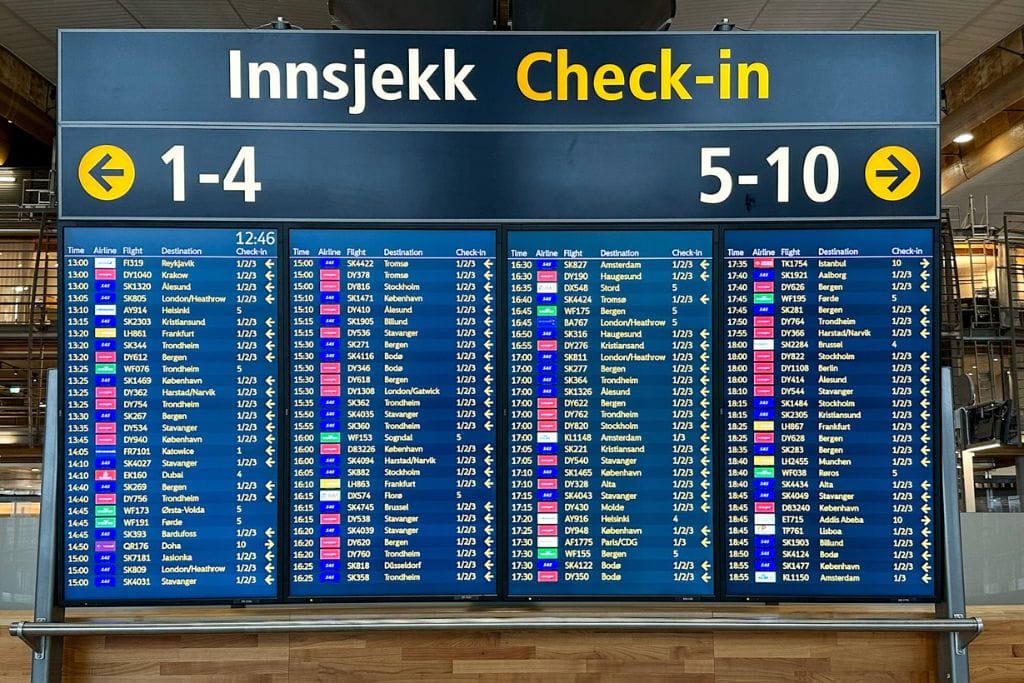
26. Use the restroom before boarding
About 20 minutes before boarding, I recommend going to the bathroom before boarding your flight. You definitely want to avoid having to use the cramped bathroom on the plane, especially toward the end of a long flight. To put it lightly, they can become less than ideal after 50+ people have used them. Plus, you don’t want to have to disturb the other people in your row if they’re sleeping.
First Time Flyers Tips: How to Board the Plane
27. listen for announcements.
Approximately an hour before your flight departure, start listening for boarding announcements. The exact time they begin boarding should be listed on your ticket, but depending on if there are any delays, this time may change.
28. Get Out Boarding Pass
When you start to hear announcements, this is a good time to get out your boarding pass and ID (or passport). Make sure you know your boarding group or zone number. Airport gate agents will start to call boarding groups or zones to the front. If you line up out of order, they’ll tell you to step aside or go to the back.
29. Carry-on bag in Overhead Bin
When you board the plane, set your personal item in your seat first before trying to put your carry-on bag in the overhead bin. This will hopefully prevent you from accidentally bumping into the people around you with your personal bag. Afterward, store your carry-on bag in a manner that takes up the least amount of space. This usually means wheels first and making sure the upright handle faces you.

30. Personal Bag Under Seat
Once you’ve taken care of your carry-on bag, place your personal bag under the seat in front. Sometimes people are able to bring a purse and a small backpack as their “one” personal item. If you do, make sure both of them fit underneath the seat in front. You don’t want anything loose in your lap during take-off because it’s a safety hazard.
31. Phone on Airplane Mode
After the doors close and the plane begins to move, put your phone in airplane mode. This is done as a safety precaution since our phones emit electronic signals that interfere with the plane. Furthermore, airplane mode helps to save your phone’s battery life, which is always a good thing! From there, follow the instructions of your flight crew as they explain all the safety measures in place.
32. Proper Airport and Travel Etiquette
As a general reminder, throughout the entire airport process, it’s important to be respectful of other people’s spaces. Everyone is feeling all kinds of emotions, so just be mindful of people’s personal space bubbles. For example, share the armrests and try to keep your body parts contained in your seat space. For anyone with long hair, make sure your hair doesn’t block the screen on the back of your chair. Essentially, just be courteous and kind.
What to Expect Flying for the First Time
Aside from what I’ve already mentioned, there are a couple of things you can expect during take-off and your actual flight. When the doors close, the cabin crew will walk the aisle closing overhead bins, checking everything is stored away properly, and making sure passenger seatbelts are buckled. The pilot and co-pilot will simultaneously introduce themselves and give you some general flight information.

Time for Take-off
Then, as the plane heads towards the runway, the plane will turn off any main lights and eventually announce, “prepare for take-off.” When this happens, there’s usually a loud rumble from the engines firing up. After a few moments, the plane will rapidly accelerate and begin to lift into the air. Your ears may become plugged, and you might feel slightly pushed back into your seat.
Cruising Altitude
When the plane reaches its cruising altitude, the pilot will make a few announcements, and shortly thereafter, cabin crew attendants will begin offering drinks and a small snack. Depending on how long your flight is, you may receive a meal or two. The general rule is that if you’re on a long-haul flight (6 or more hours), a meal is included. If you have any dietary restrictions, be sure to make a meal request in your flight portal on the airline’s website beforehand. This will give the airline time to prepare you a special meal.
Another thing to note is that there may be light or even a decent amount of turbulence during the flight. This is 100% normal and happens on nearly every flight. The turbulence is caused by the plane encountering strong, irregular wind currents. Do your best to remain calm and make sure your seat belt is buckled.
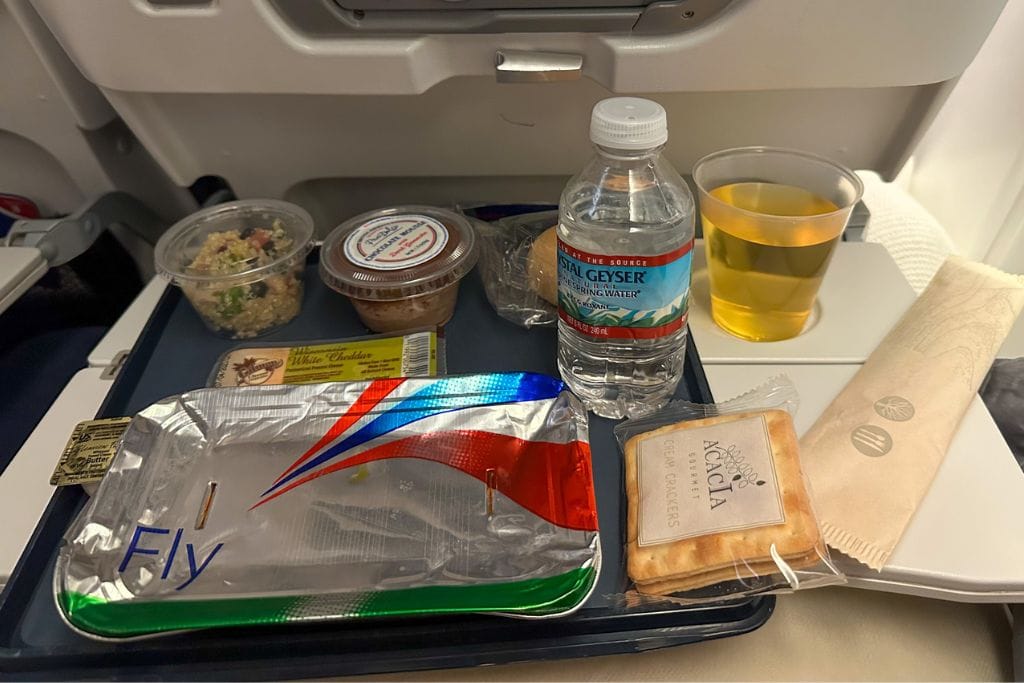
Prepare for Landing
About 45 minutes before the plane lands, the pilot typically makes an announcement to, “prepare for landing.” At this time, you put your seats back in their upright position, fold up your trays, and store away any large electronics. In terms of feelings, there may be occasional but short stomach drop moments during the plane’s descent. Also, your ears may also become plugged again. As the plane lands, the plane may skip along the runway and shake a little bit. However, this should only last for a few seconds as the plane will rapidly decelerate. Upon landing, the plane will slowly make its way to your arrival gate.
Is Flying for the First Time Scary?
Unfortunately, the answer to this question completely depends on the type of person you are. Some people find the experience to be thrilling as they think of where they’re headed, while others hate the concept of flying in a metal tube. I will say that even after visiting 20+ countries and taking 50+ flights, I still get anxious about going through the airport process. I hate being yelled at or accidentally doing something wrong, so it can be stressful navigating an airport in a foreign country. That being said, I don’t think the physical act of flying is scary. The one thing to know is that you’ll likely be feeling all kinds of emotions and however you feel is totally okay.
5 Tips for First Time Flyers With Anxiety
If you are feeling especially anxious, here are 5 first time flyers tips to cope with the anxiety.
33. Simple Reminders
When you start to panic or feel stressed, try to remind yourself of simple facts. For example, the pilots are incredibly well-trained and quite literally have gone through over ten thousand hours of training. If something unexpected happens, they are trained to assess the situation and respond appropriately. Similarly, the plane itself and its equipment is regularly inspected. You have no reason not to trust the equipment Finally, remind yourself that flying is the safest mode of transportation. You are safer in the hands of these amazing pilots than driving to the grocery store in your own car or traveling by public transportation.
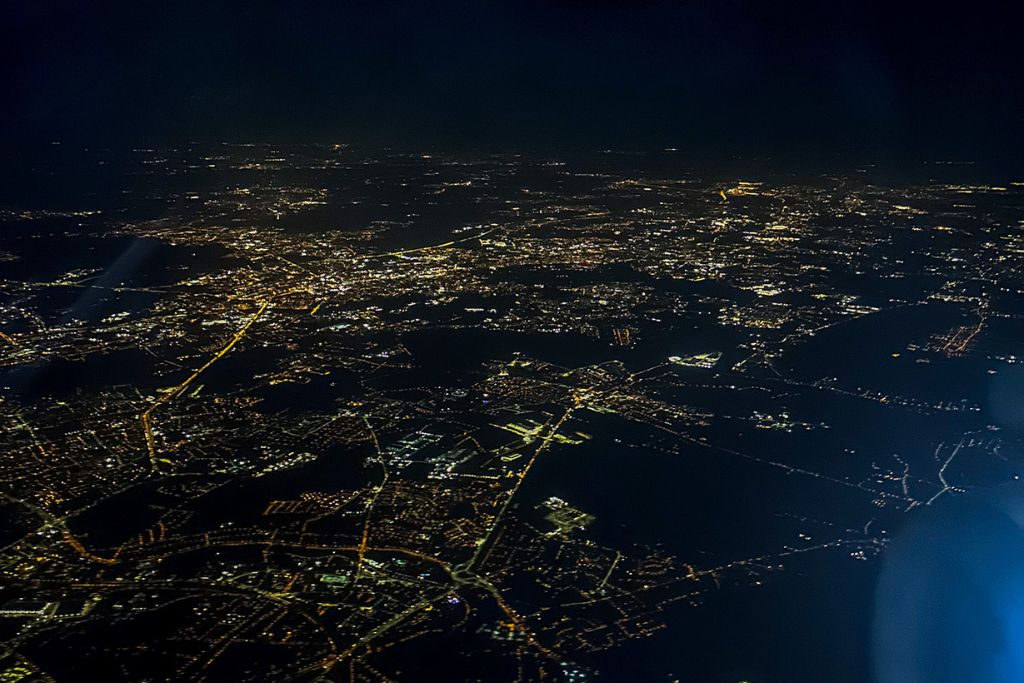
34. Listen to Music
As I mentioned earlier, one way I like to calm myself during flights is by listening to music. Blocking out the external noises on the plane with headphones is a powerful tool to distract your mind. Escape into the world of music and focus on the lyrics of a song instead of your surrounding environment.
35. Read a Book
Alternatively, I also recommend listening to an audiobook or reading a physical book. Both of these things can distract your mind by getting you to think about the information at hand rather than where you presently are.
36. Talk with your Neighbor
If you would rather not be alone with your thoughts, try striking up a conversation with your seat neighbor. Focus on them instead of yourself and what’s going on in your head. Plus, you already know that you have at least one thing in common with them: you’re both headed to the same destination! Ask them why they’re flying there or where their final destination is if they are connecting to another flight. Nine times out of 10, people love talking about themselves, and if you put yourself out there, you give yourself the chance to connect with so many wonderful people.
37. Ask for Help
If you feel sick or like you can’t control your anxiety, don’t hesitate to ask for help. People are often good and want to see you doing well. Remember, the flight attendants are trained to support you in any way they can and have likely assisted lots of passengers who have anxiety flying. You can trust them to support you if you find yourself panicking or struggling.
What to Do When the Plane Lands
After the plane safely lands and starts heading to your arrival gate, the pilot will make some final announcements about your arrival destination. These are a few tips everyone should remember, not just first time flyers.
38. Remain Seated
When the plane reaches your arrival gate, the seat belt sign will turn off, indicating it’s safe to unbuckle your seat belt. As this happens, I urge you to remain seated. You will likely see lots of people around you immediately standing up and starting to retrieve their carry-on bags from the overhead bins. Please don’t do this. It slows down the deplaning process, and you will likely be told to sit down by the flight crew. During this waiting period, airport grounds staff are safely attaching the plane to the tunnel that connects the plane to the airport.

39. Turn off Airplane Mode only if…
While you wait, you can turn off airplane mode on your phone if you’re traveling domestically. In the event you’re traveling internationally, I recommend waiting until you can switch to stable wifi before turning off airplane mode. The reason is that your phone will immediately begin searching for signal and wifi networks to connect to. As it does this, it uses up cellular data. If you’re in a foreign country, there’s a good chance you’ll be charged extra for using data abroad. For example, I know that my phone plan charges $40 per day I use any cellular data internationally. This obviously can become expensive quickly, so exercise caution. There are only two times I recommend turning off airplane mode while you’re sitting on the plane in a foreign country. First, if you know your phone plan includes international data or you can afford international data with your cellular plan. The second case is if you have obtained a special sim card meant for the foreign country or countries you’re visiting.
40. Wait to Grab Your Bags
Normally, the flight crew doesn’t make any announcements over the loudspeaker about when to start grabbing your bags. Instead, they just inform the first couple of rows when it’s okay. From there, the immediate row behind the front few will follow suit and slowly retrieve their bags. This process continues until the back of the plane. I suggest waiting until it’s your row’s turn to exit the plane to retrieve your bag. If you try and get it earlier, you run the risk of accidentally bumping someone with your bag. Just try to be patient and remember to be especially aware of your surroundings.
41. Know Where to Go
After exiting the plane, you might be unsure where to go. Don’t worry, I’ve been there as well. Here are a few first time flyers tips to help guide you. First, when in doubt, refer to your trip itinerary to see which of the following situations applies to you.
Connecting Flight
For connecting flights, look at a nearby flight departure board to figure out which gate you need to head to next. If your flight was delayed or you aren’t sure which direction to go, ask airport staff for help. Again, they’re there to help you, so remember to be kind and patient!
NOTE: In the event you’re crossing international borders, such as flying from the US, connecting in Canada, and flying to Paris, you may have to go through another security checkpoint.
Domestic Flights
If you have flown domestically and are at your final destination, follow the signs to baggage claim to pick up your checked luggage. There is often a sign that reads flight numbers and indicates which conveyor belt corresponds to which flight. After you pick up your checked bag, or if you don’t have one, you’re all set to leave the airport!
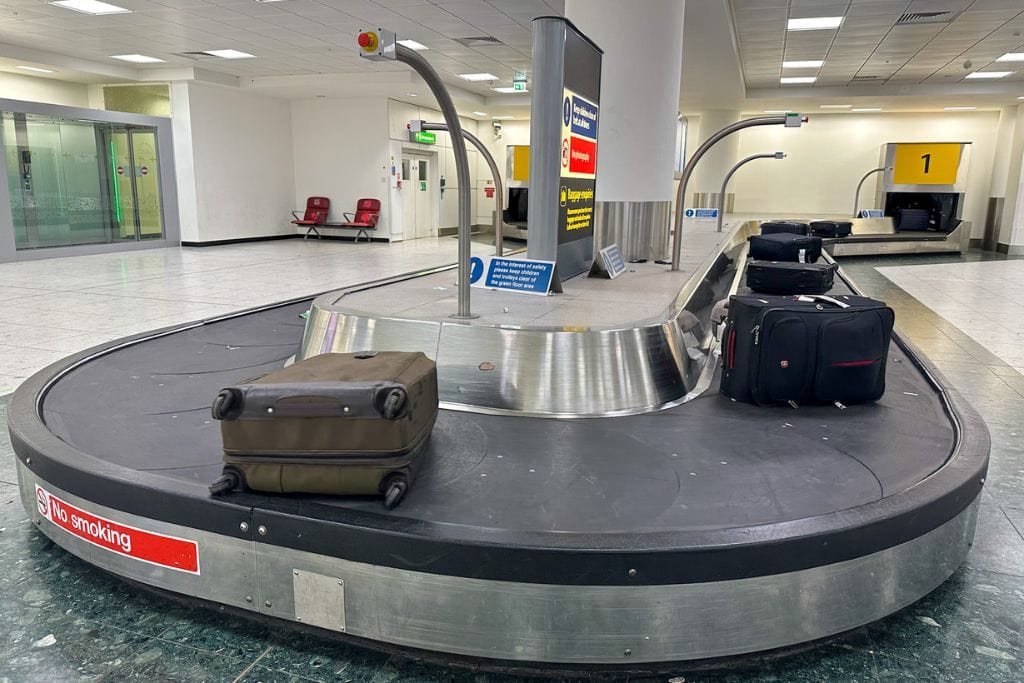
International Flights
If you were on an international flight, you’ll have to go through immigration and customs before reaching baggage claim. Immigration and customs vary slightly from country to country, but this is how they both generally work. Immigration concerns people moving between countries. An immigration officer checks your passport, asks a couple of questions concerning the details of your trip, and may possibly ask you to fill out some forms. Think of it as a mini-interview with an extremely high chance of being successful. Contrastingly, customs is all about the items you’re transporting. You will state what you’ve brought into the country and answer a few questions. Depending on the country’s rules, you’ll be able to carry on your merry way, or customs officers may ask you to fill out additional forms to declare some goods. Upon completing immigration and customs, you can head over to the baggage claim area to retrieve your checked luggage. Afterward, or if you didn’t check any luggage, breathe a sigh of relief that you made it and can finally exit the airport! YAY!
Wrap-Up: First Time Flyers Tips (2024)
I know figuring out the whole airport process can be overwhelming and scary at times, but with my abundance of first time flyers tips, you will hopefully be able to fly with confidence. Remember that you got this and success favors the prepared. When in doubt, simply ask for help because that’s what airport staff is there for. With that, I wish you a smooth airport journey and safe travels!
Need More Travel Resources?
Head over to my dedicated Travel Resources Page! You can view all my favorite places to book everything from housing and transportation to activities and ESIM cards! It’s also where you’ll find my ultimate packing list that’s great to use as a comprehensive guide on what to bring on your next global travel escapade! As always, feel free to reach out to me if you have any questions or need guidance on your upcoming travels! I promise I’m friendly! 🤠
Save This Post for Later!
Kristin is the founder of Global Travel Escapades, a blog dedicated to helping travelers explore beautiful destinations and planning their wildest travel dreams. She has explored 30 countries and is on a mission to visit 50 by age 30. Along the way, she has lived in places like sunny San Diego and the vibrant French capital! Ultimately, Kristin hopes her passion for adventure, delicious food, and all things F1 & tennis inspires others to plan their next travel escapade!
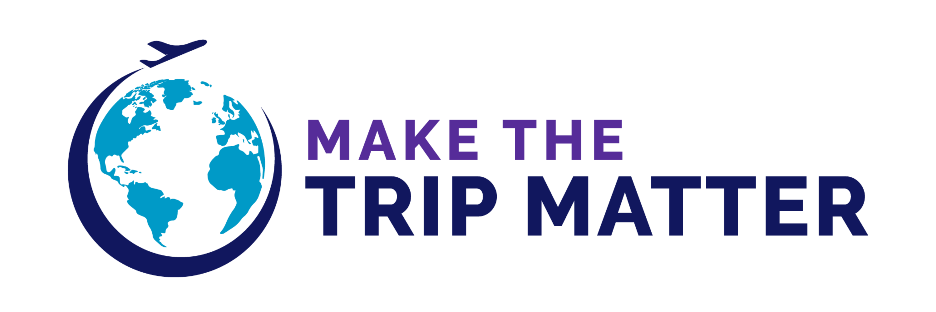
First Time Flyer Guide and Checklist: Top 50+ Tips

From the first time I can remember flying as a kid, my parents would have me “lead” them around the airport and ask me to figure out what we had to do next. Even still, I was a nervous wreck on my first solo trip as an 18-year-old! But the trip went smoothly, and I quickly realized how EASY it can be to fly . This post gives advice for first-time flyers and a detailed airport guide and flying checklist to alleviate any stress before flying for your first time.
What Is It Like Flying for the First Time?
Flying for the first time is not nearly as scary as it feels like it will be!
Did you know that air transportation is actually the SAFEST form of travel?
My best piece of advice for first-time flyers is to be prepared for their flight (just follow this guide!) and know what to expect because the most stressful part of flying for the first time is getting through the airport.
Once you are on the plane it’s just a matter of relaxing until you land!
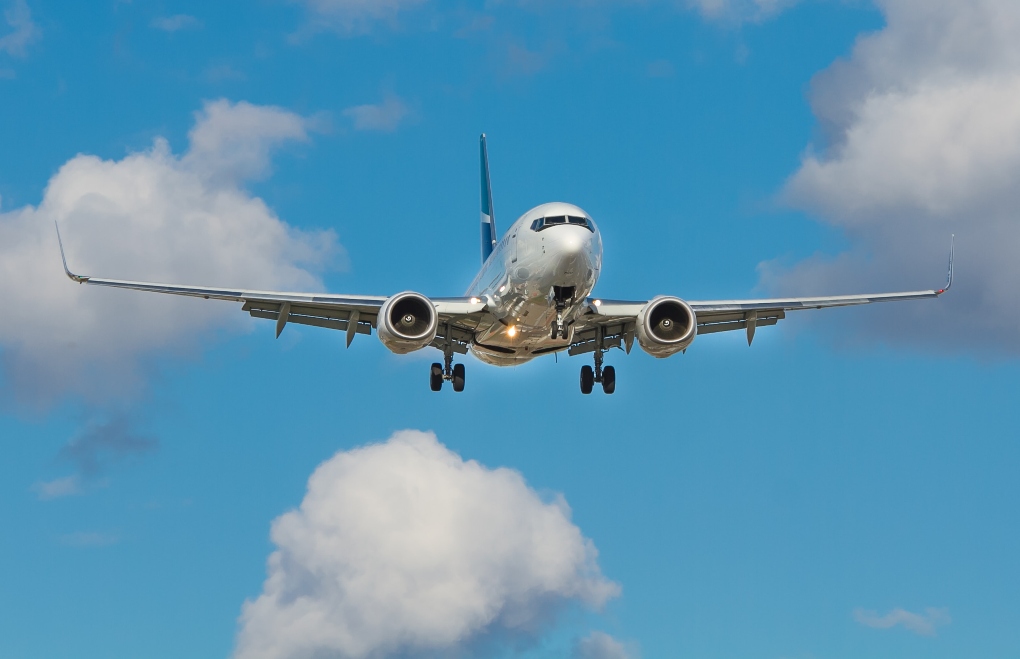
The actual experience of being on an airplane, I think, can be quite fun. Take off and landing will feel a bit like being on an elevator or a very calm rollercoaster. The airplane will begin to “taxi”, which is where they drive around the airfield to get into the proper position on the runway. Then, the plane will speed up and lift off.
When you get close to landing, there will be an announcement letting you know to prepare for landing. Landing is much quieter than take-off, the only thing you might feel is a small jolt when you touch down.
There may be some turbulence during your flight, this is normal! Turbulence happens when the airplane goes through a patch of irregular air. The captain may warn you first if there is a big patch of turbulence, but for the most part, it will just feel like light bumps and is nothing to worry about.
The ONLY Checklist You NEED for a Trip Abroad
Even after traveling the world… I STILL use this list before every trip!
Unsubscribe at any time.
How Do You Calm a First-Time Flyer?
It is normal for people to feel anxious about their first flight. If you or someone you are traveling with is on their first airplane, the best way to calm them is to prepare them. Become familiar with the process of going through the airport and what to expect during the actual flight.
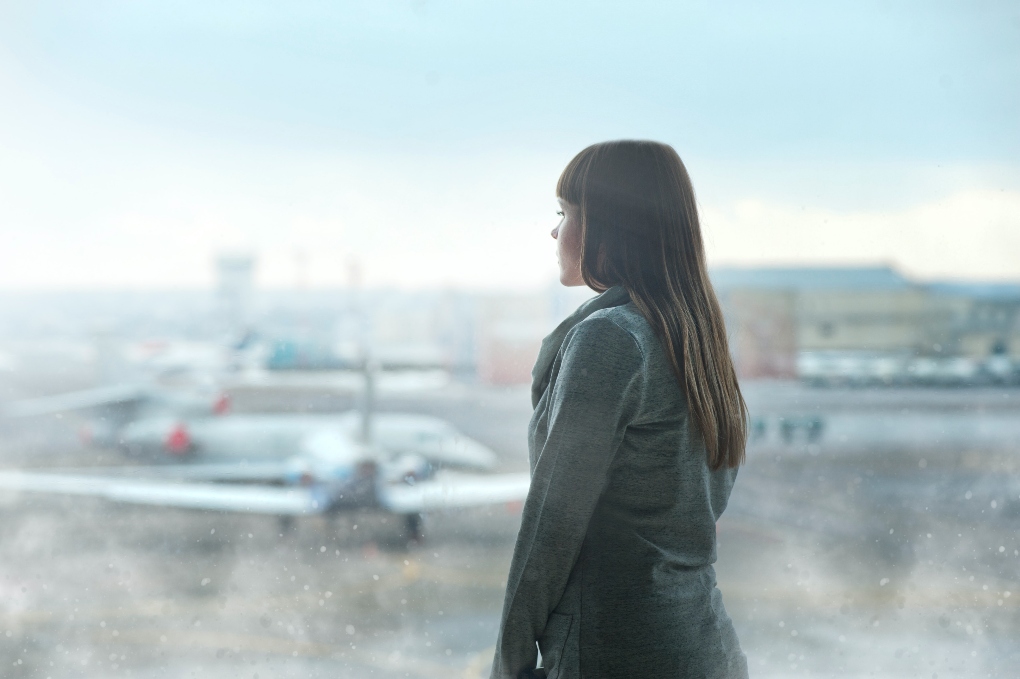
Something that helps me is reminding myself that air travel is the safest form of travel, it’s FAR safer than driving even, which we do all the time.
If you want to know the statistics: There is 1 fatal accident per 16 MILLION flights. With fatal car crashes, the odds are 1 in 144. Insanely higher! So just remember that you are much much safer on an airplane.
Tips for First Time Flyers With Anxiety
Anxiety is normal for many people who travel by air. Even I can get a bit anxious on a plane, and I have been on more planes than I could even begin to count in my life. Here are a few helpful tips for a first-time flyer’s guide to experiencing anxiety:
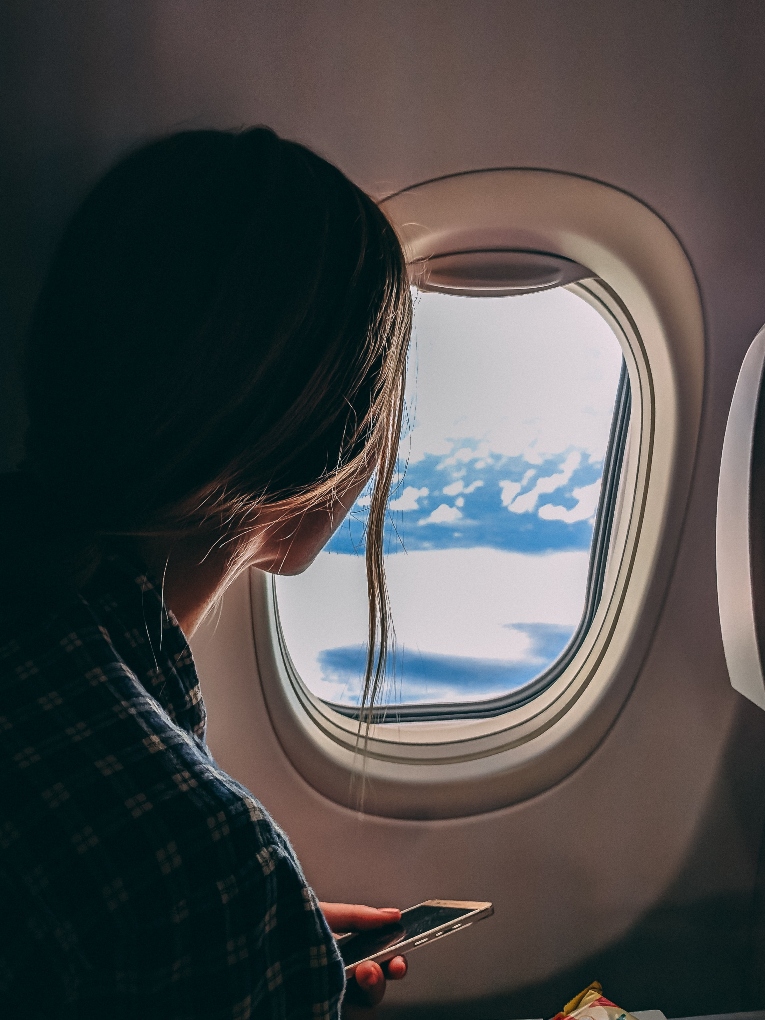
- Get to your gate early. A big part of people’s anxiety starts with worrying about missing their flight.
- Being at your gate early lets you settle in. Take a walk, do some light stretches, or start listening to a calming book or music.
- For some people, having a drink or two (just don’t go crazy!) beforehand might help to calm the nerves – it’s why airport bars are popular!
- On the plane, if turbulence or something is making you anxious, practice calming breaths and clearing your mind of the anxious thoughts.
- Some flyers find it comforting to walk the plane and do some light stretches in the back.
- When we hit especially bad turbulence, I focus on breathing in and out slowly and repeating a phrase that calms me down. Often, I have to repeat, “It’s just a bit of turbulence, we’ll be through it soon.” Even though I logically know turbulence is completely normal!
- If you are prescribed anxiety medications , make sure to take your meds regularly or ask your doctor about how to take them to help specifically with flight anxiety.
ONE OF THE BEST PRODUCTS FOR FIRST-TIME FLYERS Memory Foam Neck Pillow + Eye Mask + Ear Plugs
Can I Use My Phone on a Plane?

Yes, you can use your phone on a plane if it’s in airplane mode. Some airlines and flights may ask that you turn your phone off completely during take-off and landing, especially if there is a bout of bad weather or the airport is busy.
For the most part, you can use your phone throughout the flight so long as airplane mode is turned on. This means you will not be able to use data but will have all other phone functions. Most airlines nowadays offer WiFi onboard the plane , but almost always for a fee.
What Do You Do at an Airport for the First Time?
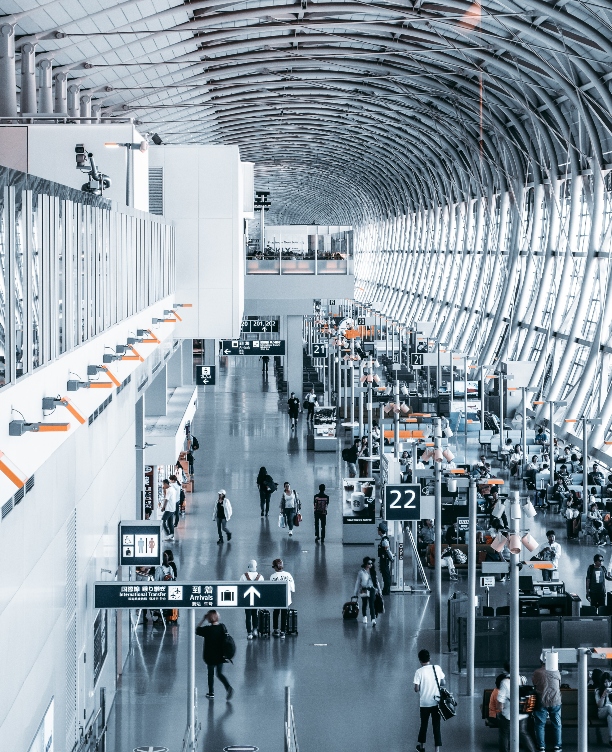
This first-time flyer guide will outline what to expect for flying and exactly what to do at the airport step by step. Some airports are big and confusing, others are small and straightforward. Either way, once you know what to do at the airport it will be easy to navigate any airport , as they all follow the same structure.
Enjoy being at the airport! Maybe I’m just an oddball travel junkie, but I think airports are so much fun. There is great people-watching and seeing the destinations on the boards makes me think about all the possibilities of places to visit and how big the world is.
BUYING PLANE TICKETS FOR YOUR FIRST FLIGHT
1. how to pick your destination.
If you don’t already have a destination in mind but know you want to take a trip, there are a few things to keep in mind:
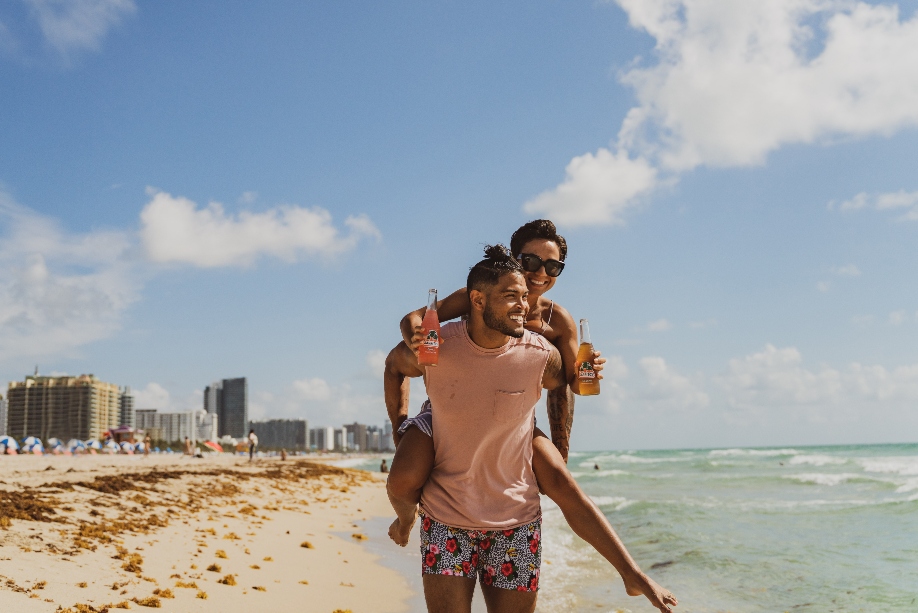
- Weather – What time of year are you trying to travel? Look up the weather of your possible destinations during this time of year.
- Length of flight – For your first flight it might be better to pick somewhere closer that has a shorter flight.
- Price of flight – If you aren’t familiar with flying, you won’t have much of an idea of the price range of flights. Use a search tool such as Skyscanner to check for destinations and see what options for pricing you will have.
- Accommodation availability – There is nothing worse than buying a flight somewhere and THEN realizing there aren’t many options for places to stay or the options are out of your budget.*
- Be spontaneous – My favorite thing to do is pull up Skyscanner’s “Search Everywhere” tool and see what cities or locations have the best deals and cheapest flights. This is the perfect tool for someone who has a time frame in mind for a trip, but no idea where to go.
❗ *Still looking for accommodation? I use HostelWorld to find the best global hostels and Booking.com to find the best global hotel deals.
International vs Domestic Flights:
As a first-time flyer guide, it will be easier to pick somewhere domestic. However, first-time flyers shouldn’t be afraid of going international! There are so many amazing places to see, don’t limit yourself to staying local . For your first time going international, try to pick somewhere with a familiar culture and/or a language you speak.

💡 Browse through some of my destination guides for inspiration , and take a look through my travel resources page for the best tools that I use for both domestic and international trips.
2. How to Buy Plane Tickets
Once you know where you want to go, the next step is keeping an eye on flight prices. If you have an airline you have been recommended or have researched and would prefer to use, it’s best to just keep an eye on their website directly .
Otherwise, do some initial searches on flight prices to see if they are in your budget. If they are a little high, or you are far enough out you have the flexibility to see if the price will drop, then set up a ‘flight alert’ on Skyscanner to get notified when the ticket price goes down.
3. When to Buy Plane Tickets
Generally, you want to book plane tickets well in advance of your trip. Occasionally you can find great fare drops right before the flight, but that is a pretty risky gamble as they usually actually spike in price the last few. days before a flight.
For domestic flights, roughly 3 weeks to 3 months is a good time to buy tickets.
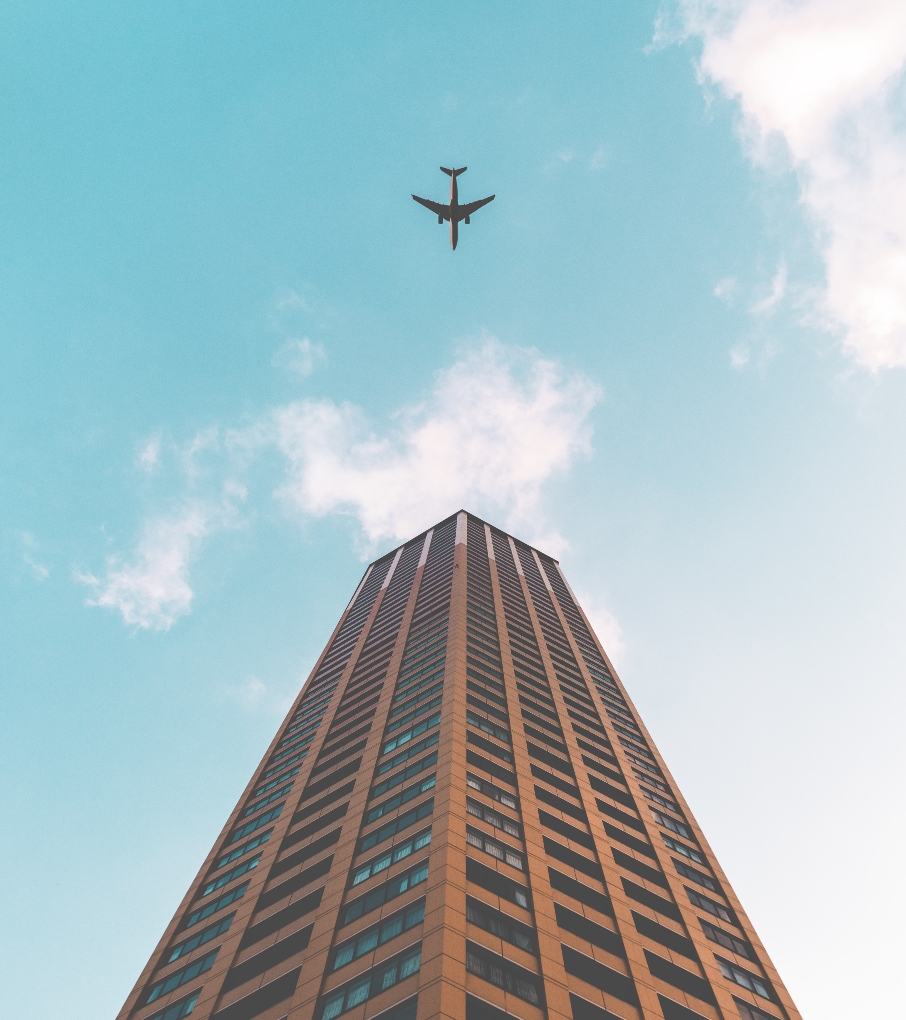
For international flights, give yourself even more time. Book at least one month out, but the best times to book range from three to five months out.
Keep in mind the time of year you will be flying in too. If you are flying during popular travel times such as the holidays or the summer, you probably want to look at flights even further out.
Another tip : I book most of my flights on a Tuesday or Wednesday. Flight prices tend to drop by a little bit during the week.
4. Where to Look for Plane Tickets
There are quite a few flight search engines that claim to find the best prices. Buying affordable plane tickets is the art of finding the right timing, staying patient, and researching across platforms.
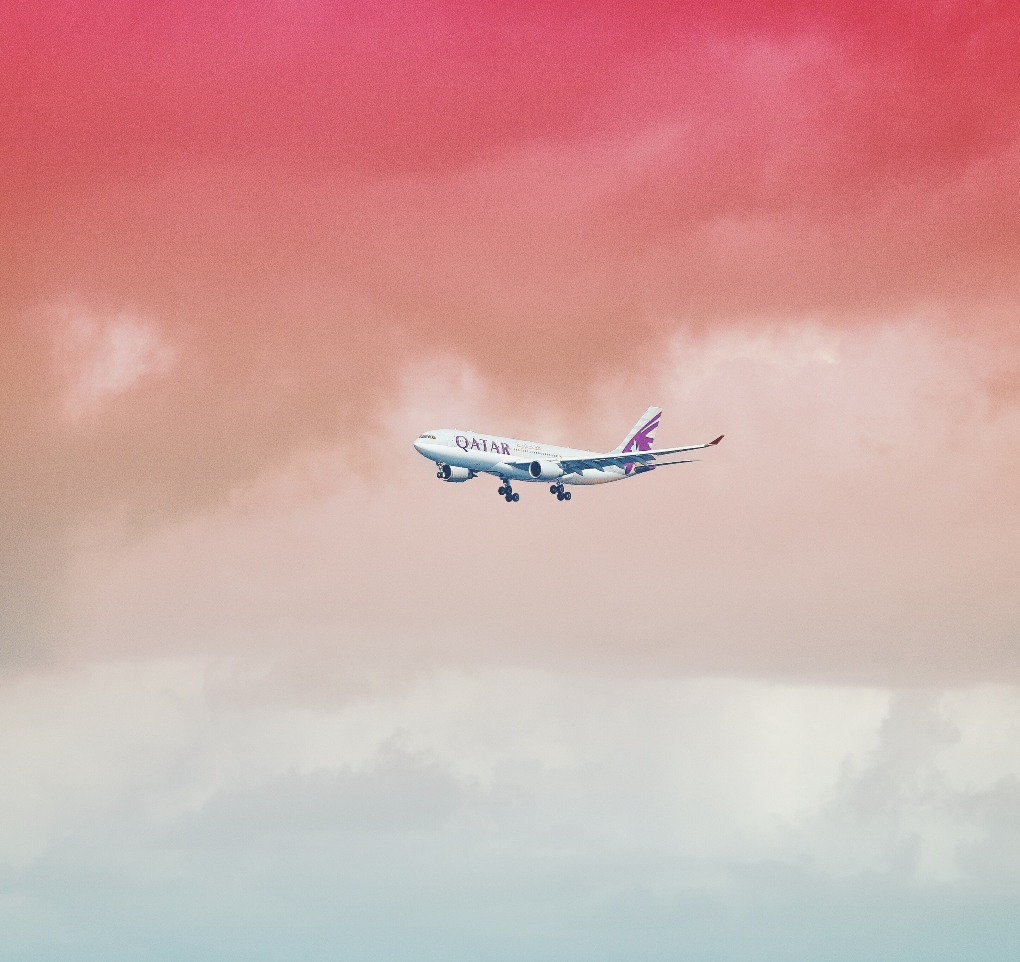
The best way to buy plane tickets is to buy directly from the airline if they have a decent price for the flight. Otherwise, these are the flight search engines that I use and recommend:
Going (Formerly Scott’s Cheap Flights):
This is a FREE email list that sends you flight deals and fare drops from your home airport. I highly recommend everyone to sign up for this free service, you never know when they will send a deal for somewhere you are looking to go.
This list is perfect for the spontaneous traveler who doesn’t have a destination in mind. I have found many great deals through Going , and my friend once found a roundtrip ticket to Australia from Los Angeles for under $500!
➡️ CLICK HERE TO SIGN UP FOR GOING
Skyscanner :
This is my favorite flight comparison tool for finding the best deals on flights. Skyscanner searches across airlines to find the cheapest flights. Plus, I love that you can search “everywhere” and “anytime” to find the cheapest flights. If you are flexible on the days you can fly, while searching you can see what days have the lowest prices.
➡️ CLICK HERE TO SIGN UP FOR SKYSCANNER
❗Is Skyscanner legit? Read my review of Skyscanner HERE
Google Flights :
This is another favorite tool of mine to check for cheap flights across airlines. Google Flights is easy to use and reliably provides great deals.
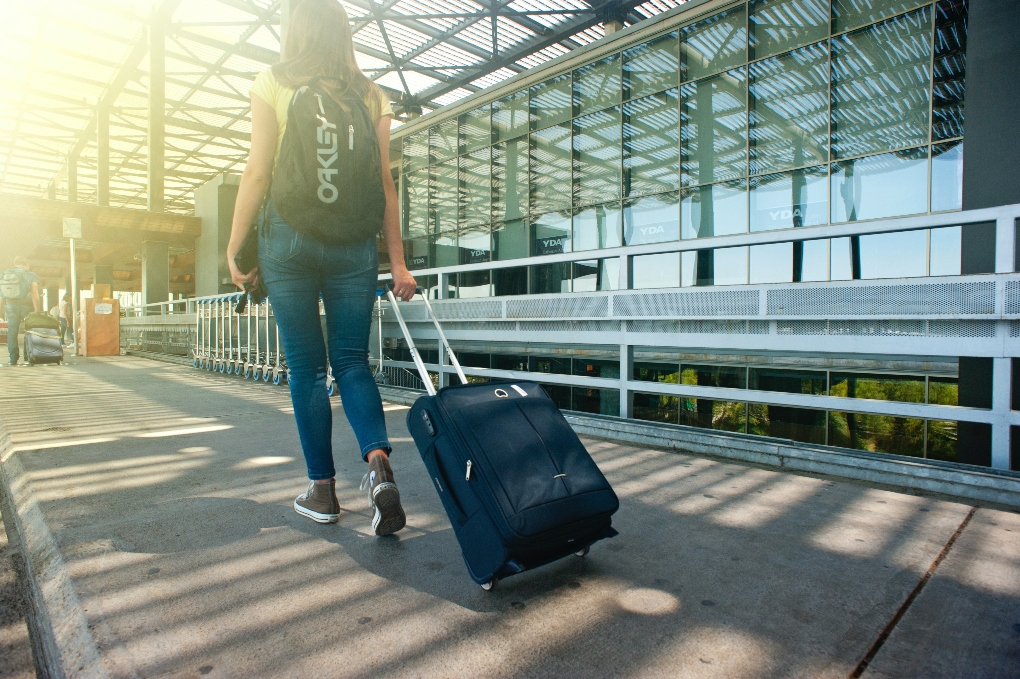
5. Understanding Flight Add Ons
Of course, buying plane tickets is never as straightforward as it should be. Airlines will upcharge for just about everything nowadays.
While buying your ticket you will have plenty of places where the airline tries to add on features (i.e. extra legroom, meal service, baggage options). You can look through each option and decide what you want to add to your flight, or simply skip through and stay with the base rate.
6. Choosing Your Baggage Needs
Pretty much every airline nowadays will charge you a fee for checking a bag . Most airlines will allow you one carry-on (a small suitcase size and has to fit in the overhead bins) and a personal item (either a purse or as large as a standard backpack).
The budget airlines might not even allow you a carry-on without an extra fee or weight restrictions.
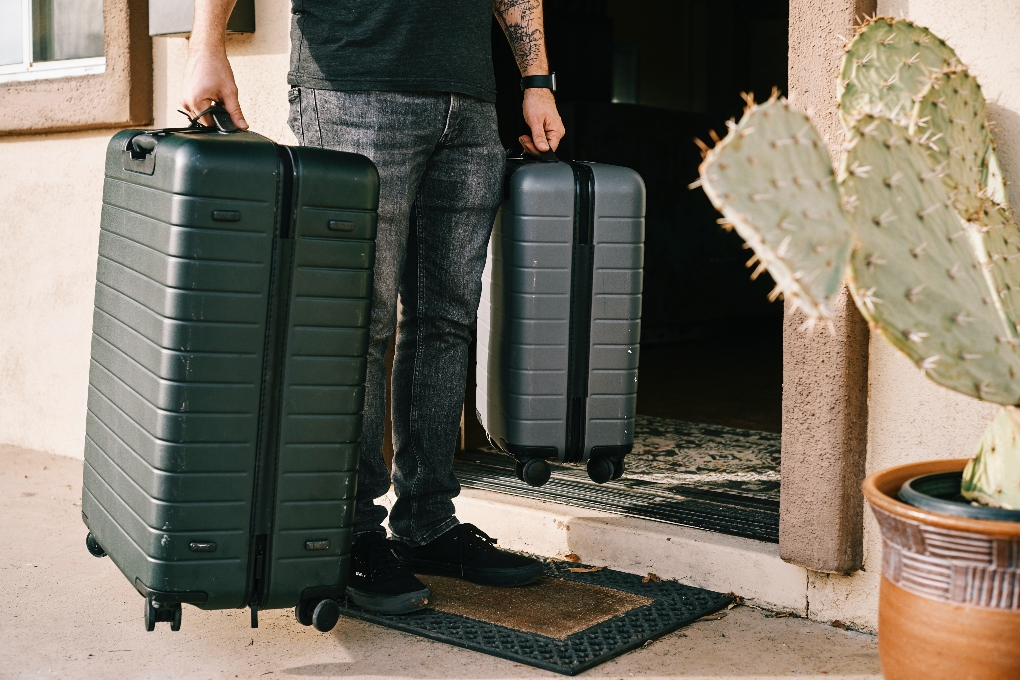
Usually while buying your ticket the airline will give you the option to choose how much baggage you will be bringing. Otherwise, check the airline’s website for their policy on baggage and what they allow to be carried on board. You will also be able to check online for the restrictions on dimension and weight that each airline allows.
🔻 One of the BEST travel carry-on backpacks! 🔻
Some flights will have a randomized seating selection, meaning it is the first available seating when you get on the plane. Most airlines let their passengers pick their seats ahead of time but may charge you to pick a seat and will certainly charge extra for better seats.
If you are traveling alone or are comfortable having your seat pre-assigned by the airline you might be able to save some money on not choosing a seat.
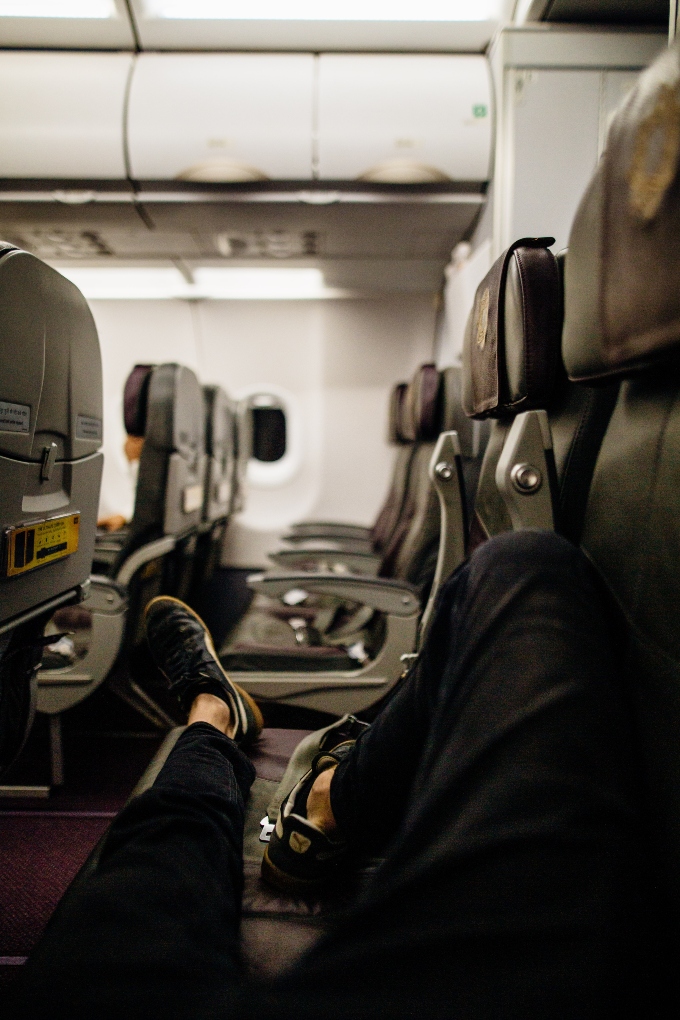
FIRST-TIME FLYER’S GUIDE TO PREPARING FOR YOUR FLIGHT
8. have the proper identification for flying.
To fly within the U.S. you will need a valid form of identification. As of May 7th, 2025 every passenger over the age of 18 will need to have a “Real I.D.” or a passport .
Depending on your destination and vaccination status, you may also need to show proof of a negative COVID-19 test or proof of vaccination.
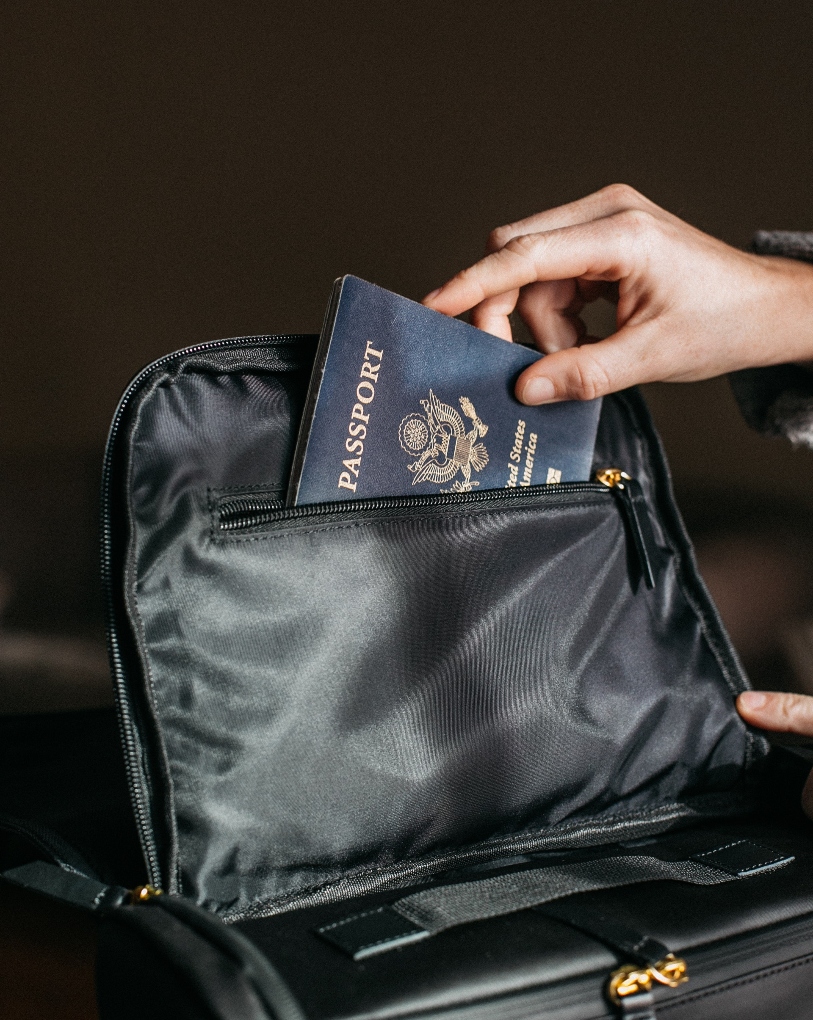
9. Buy Travel Insurance
Any time you travel you should always have travel insurance to cover you in case of an emergency. This is different from your normal health insurance and covers emergency travel situations such as delays, lost baggage, natural disasters, etc.
I use and recommend SafetyWing for medical and travel insurance. It is affordable, reliable, and flexible insurance that is specifically designed for digital nomads who will be traveling long-term, though it mostly covers emergencies which is perfect for short-term travelers and first-time flyers as well.
For an idea of how much insurance will cost you, use the tool below. Or, to purchase insurance directly from SafetyWing, CLICK HERE.
10. Know When Flyers Need to Be at the Airport
Domestic flyers:.
The standard recommendation for domestic flights is to arrive 2 hours before your flight.
This is to give you plenty of time to check in, check your bag, make it through security, and arrive at your gate before boarding starts.
As a first-time flyer’s guide, I encourage you to stick to this recommendation to give you plenty of time to make your way around the airport without worrying about being late.
However, if you are not checking a bag and you are at a smaller airport, you might have more wiggle room and could probably arrive an hour and a half to one hour before your flight, depending on your comfort level.
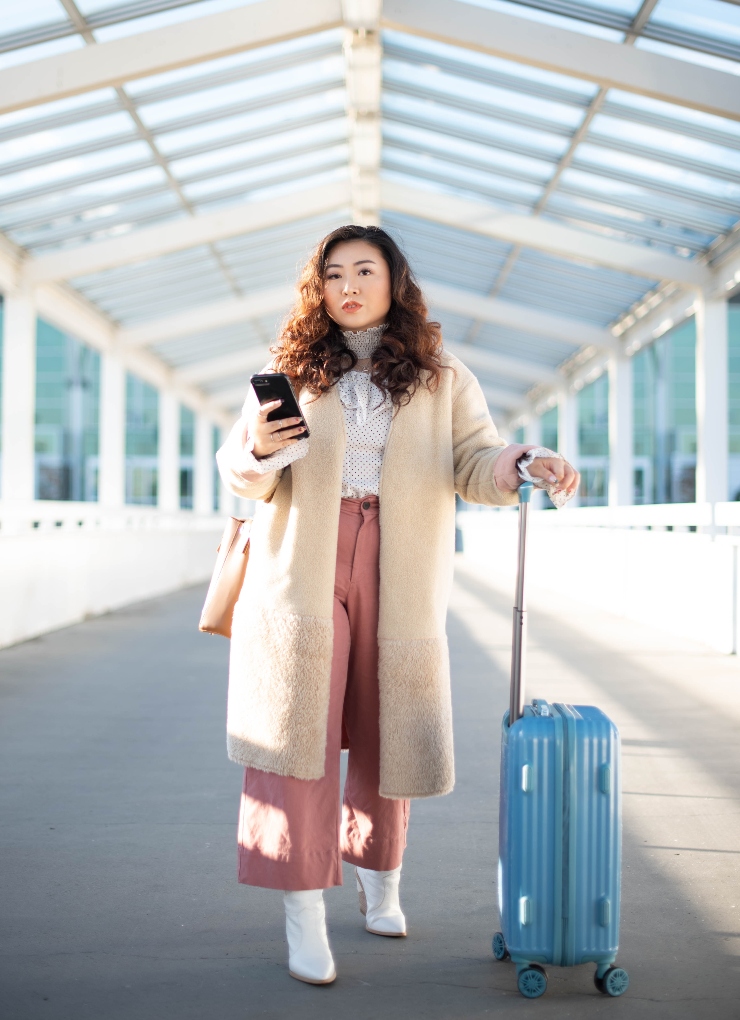
International Flyers:
The standard recommendation for international flyers is to arrive 3 hours before your flight.
11. Research How to Get To and From the Airports
If you aren’t familiar with where your airport is, research how long it will take you to get there and how you plan on getting there. If you need to park your car at the airport, you should know where to park it and how much it will cost.
Same thing on the arrival side, make sure you know how you will be getting from the airport to your accommodation at your destination.
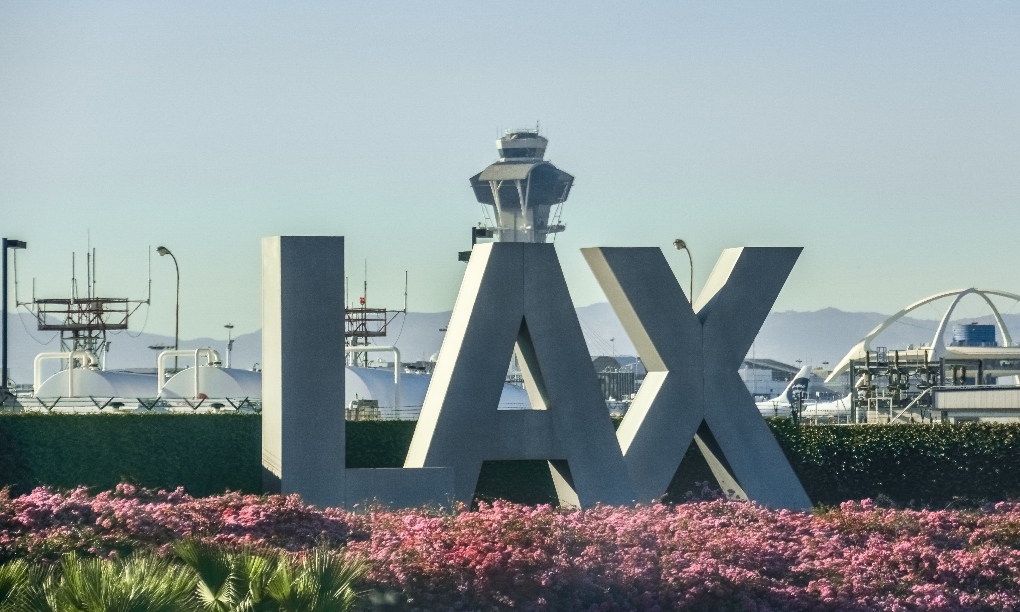
❗ Do you need to rent a car for your first time flying? I recommend DiscoverCars for finding the best deals on rental cars during your trip.

12. How to Dress for Your Flight
People dress in a wide range for flights from comfortable to business-appropriate , so there is no right or wrong way to dress for your first time flight.
I recommend layering for your flight (or at least having a light sweater handy in case you get cold on the plane) and wearing clothes and shoes that are easy to remove for security.
Take into consideration the climate of where you land as well.
13. Prepare Your Entertainment
Some flights will have an entertainment system built into the seats. For shorter flights, your airline either won’t have in-flight entertainment or you might have to pay for it. For long flights (especially international ones) the airline might have free movies, TV shows, music, etc.
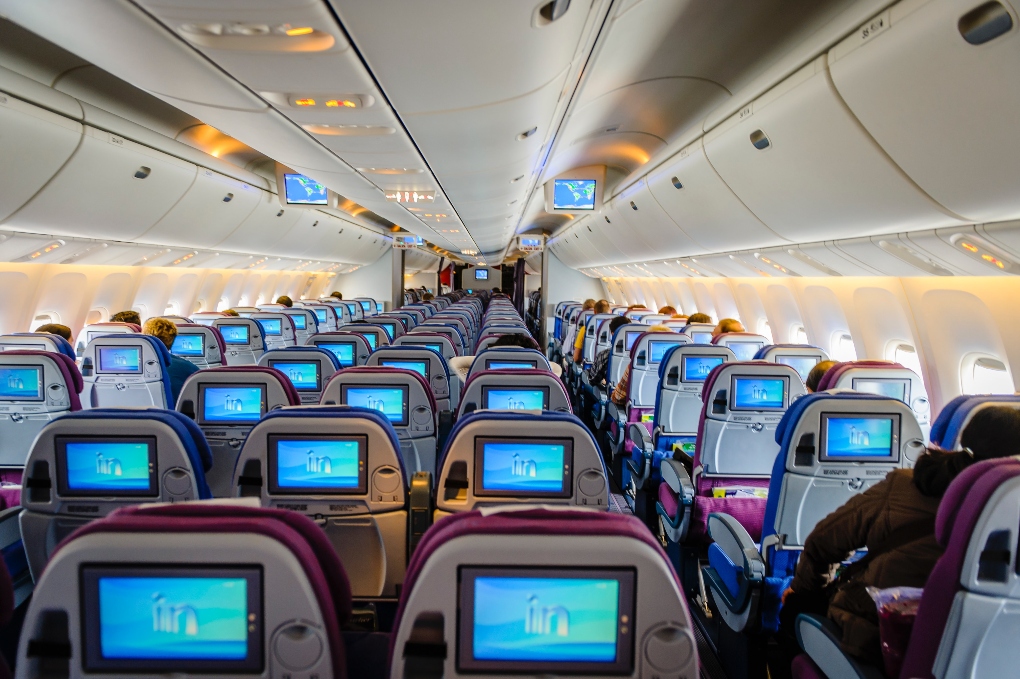
Beyond in-flight entertainment and bringing your own reading material (i.e. books, magazines), I recommend doing the following before your first time flying:
Download Apps:
If you want games (especially if you’re traveling with kids) or other apps that you can access without WiFi, make sure to download them ahead of time.
Download Books, Movies, Podcasts etc.:
I always make sure to download entertainment for myself onto my phone so I can use it in airplane mode. You can download shows on your Netflix app, or Podcasts and Books off of various apps.
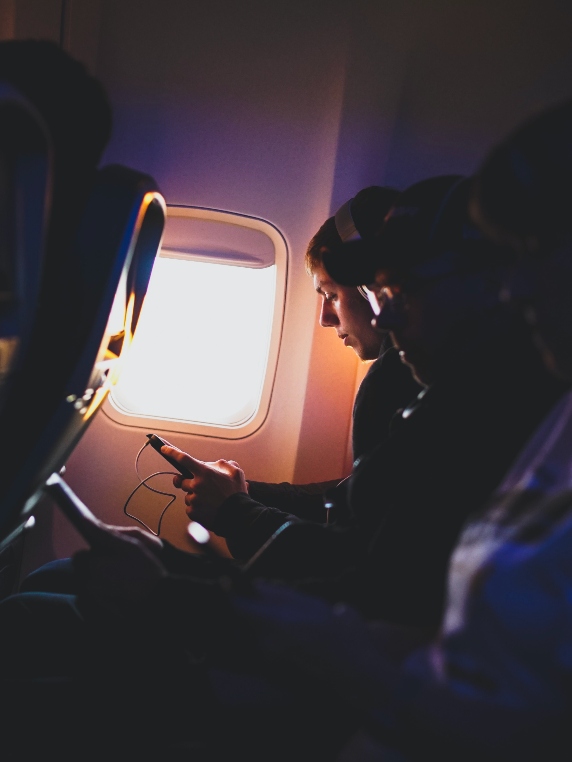
Airport WiFi:
Almost all airports should have free WiFi available . If you have a smartphone, I recommend downloading the app (where applicable) for your airline. Often you will be able to use the app to be alerted to any flight or gate changes.
14. Pack Snacks
If you want to save some money on airport food, pack snacks! Most food should be fine to go through security, they may just ask you to take it out.
15. Prepare Your Foreign Currency
If you are traveling internationally, you might want to exchange some money ahead of time . Your local bank should be able to exchange foreign currencies. There is no need to travel with too much cash as that can be risky and exchange fees likely won’t be in your favor.
Get enough ahead of time that you have money for transportation and maybe some food and ‘just in case’ cash. Using ATMs or money exchanges at the airport upon arrival can be overpriced .
⭐️ But PRO TIP , get the Charles Schwab debit card (it’s free to open a checking account ) to receive unlimited ATM fee rebates for cash withdrawals worldwide. This card has saved me so much money while traveling!

FIRST TIME FLYER’S GUIDE TO CHECKING IN FOR YOUR FLIGHT
16. checking in online.
You can either check in ahead of time or do it in person when you arrive at the airport. Most airlines will send you a link to check in to your flight 24 hours in advance .
You can typically confirm your seating and verify flight details or any add-ons at this time. If you check in online or through the app, you will receive a mobile boarding pass. Simply show this pass on your phone at security and the gate or print it out in advance.
Personally, I always check in online ahead of time if I have the option. Not only does it save time and the hassle of waiting in more lines at the airport, but I also like knowing that I am set for my flight in advance.
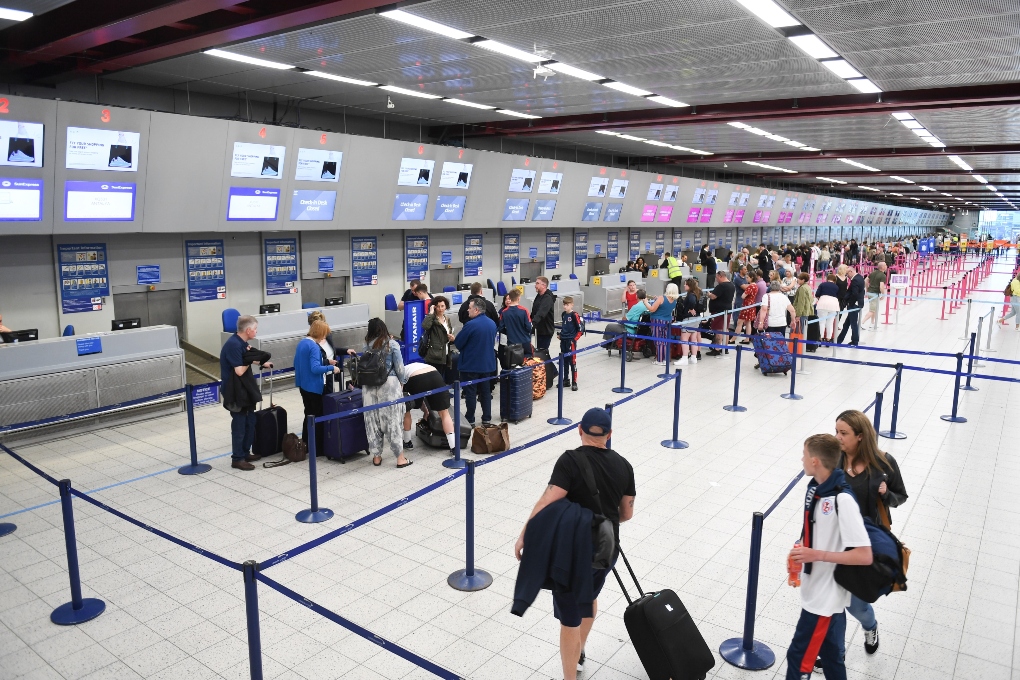
17. In-Person Flight Check-in
If you choose to check in when you arrive at the airport you will be looking for your airline’s check-in counter that lists your flight destination. You will be walked through the check-in process and able to check your bags at this point.
18. Checking a Bag vs. Only Carry-Ons
If you need to check a bag you will look for your airline’s bag drop-off or check-in counter . Most airlines have a designated bag drop area now for online check-ins. Though you still might have to wait in the check-in line, so give yourself plenty of time on arrival.
If you only have carry-ons and have already checked in online, you can continue straight past your airline’s counter and on to security.
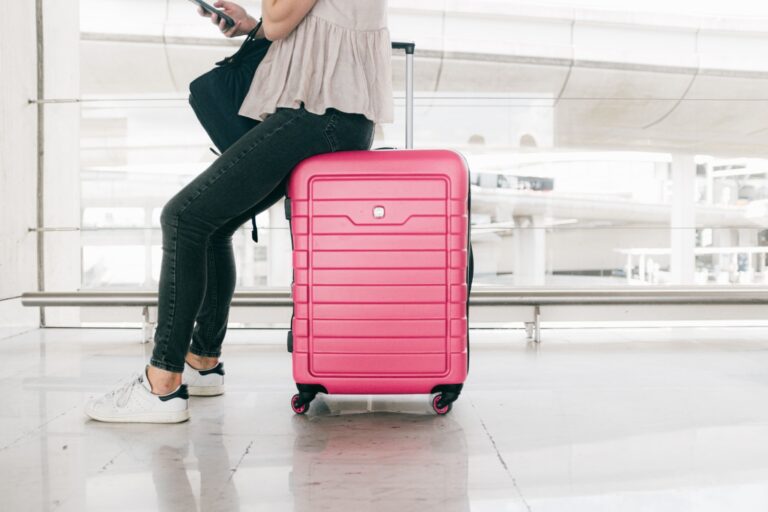
19. What to Do After Checking in
After you check-in, your next step is to head through security. Usually, at this point, you are just following the signs to get in the right line for security.
20. Asking for Guidance at the Airport
Don’t be afraid to ask for help at the airport! There are plenty of workers between those at the check-in counter, security, professionals with badges walking around the airport, etc. They know the airport very well and will gladly guide first-time flyers in the right direction if they get confused.
FIRST TIME FLYER’S GUIDE TO AIRPORT SECURITY
Airport security may seem like a daunting and complicated process, but you will get the hang of it quickly after the first time or two. Here is a first-time flyer’s guide to making airport security a breeze:
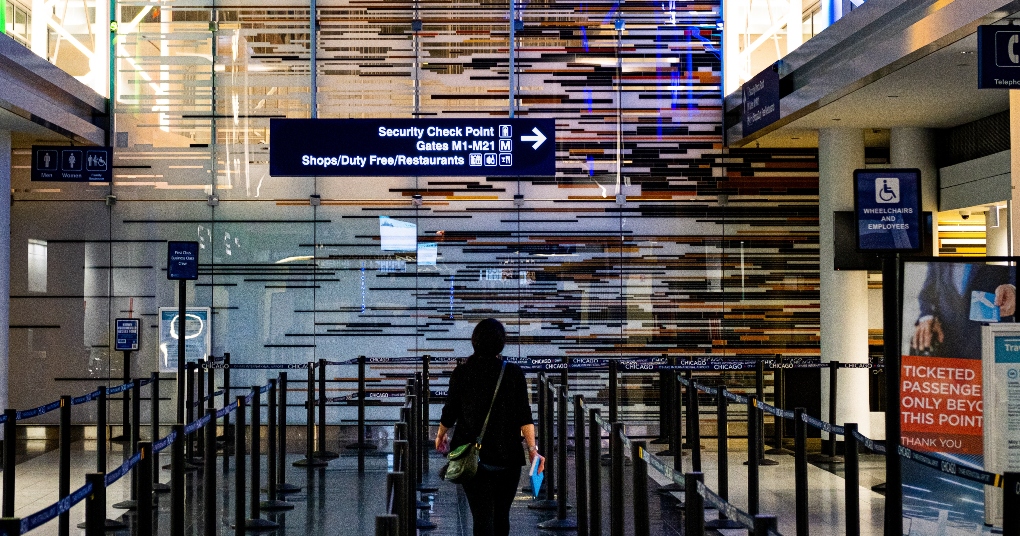
21. Make Sure All the Liquids in Your Carry-on Are Under 3.4 Ounces
You would be surprised how many liquids you might accidentally try to pack without thinking about it being a liquid. A few items to remember to watch the size on are: shampoo, conditioner, soap, sunscreen, any alcohol you are gifting or bringing with you, anything you are currently drinking, nail polish remover, vaseline/gel chapstick, some makeup, perfume, gel or spray deodorant, etc.
Some airports also require all of your liquids to fit in one quart-size clear bag which they may provide.
22. Don’t Pack Aerosol Cans (Bug Spray!)
Aerosol cans are not allowed through TSA. Though I have (accidentally) gotten away with it a few times, this includes even simple things like bug spray.
>>> TIP: use Picaridin lotion instead, or bug-repellant wipes .
23. Double Check the TSA’s List of Prohibited Items While Packing
Take a look at the TSA list of prohibited items while you are packing your carry-on. Familiarizing yourself with the list may save you some time and money from having to throw items away at security.
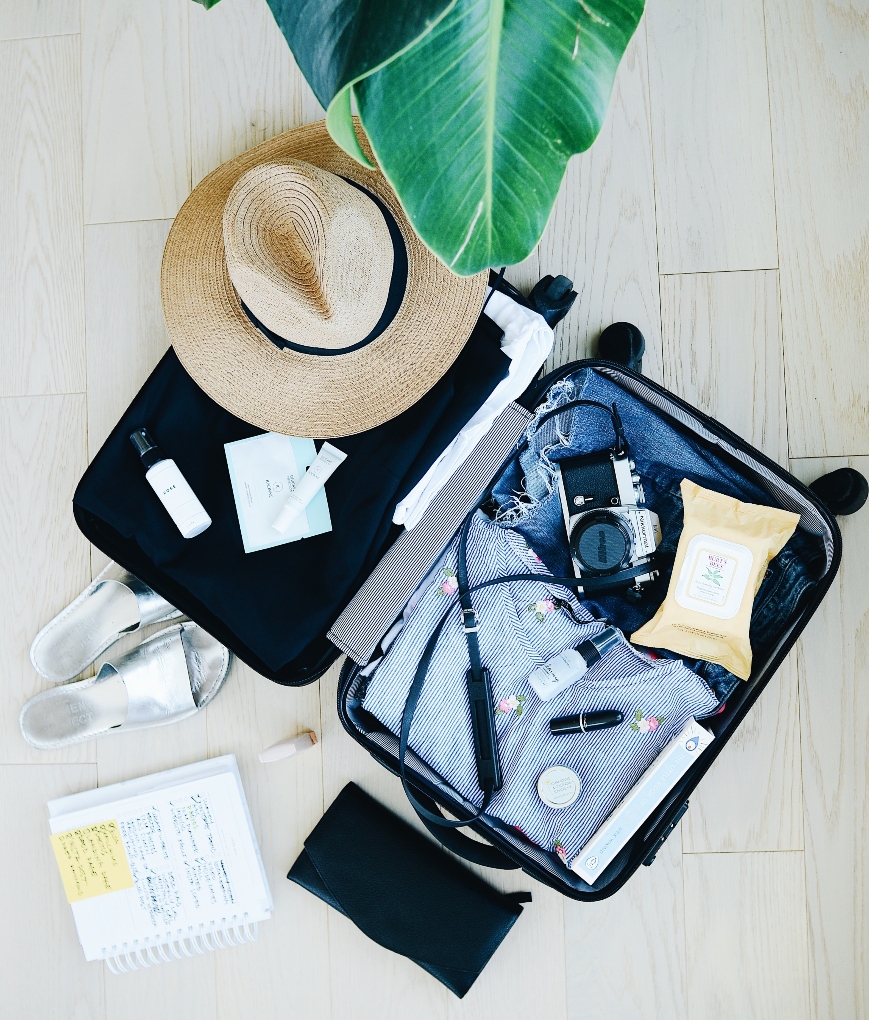
24. Have Your I.D. And Boarding Pass Out
You will have your I.D. and boarding pass checked before entering security. Have it out and ready to hand off as the line for security sometimes moves quickly.
25. Be Prepared to Take Your Shoes Off
In the U.S., most passengers need to remove their shoes for security. Those with TSA PreCheck , older than 75, or kids 12 and younger will not need to remove shoes.
26. Jewelry and Security
Small jewelry such as earrings, necklaces, and rings can stay on through the scanner, but remove anything big and metal that might set off the sensor.
27. Take Any Personal Electronics Out of Your Bag (i.e. Laptop, iPad)
Remove any electronics and place them in the bins. If you have your laptop in a computer bag or case it will need to be fully taken out.
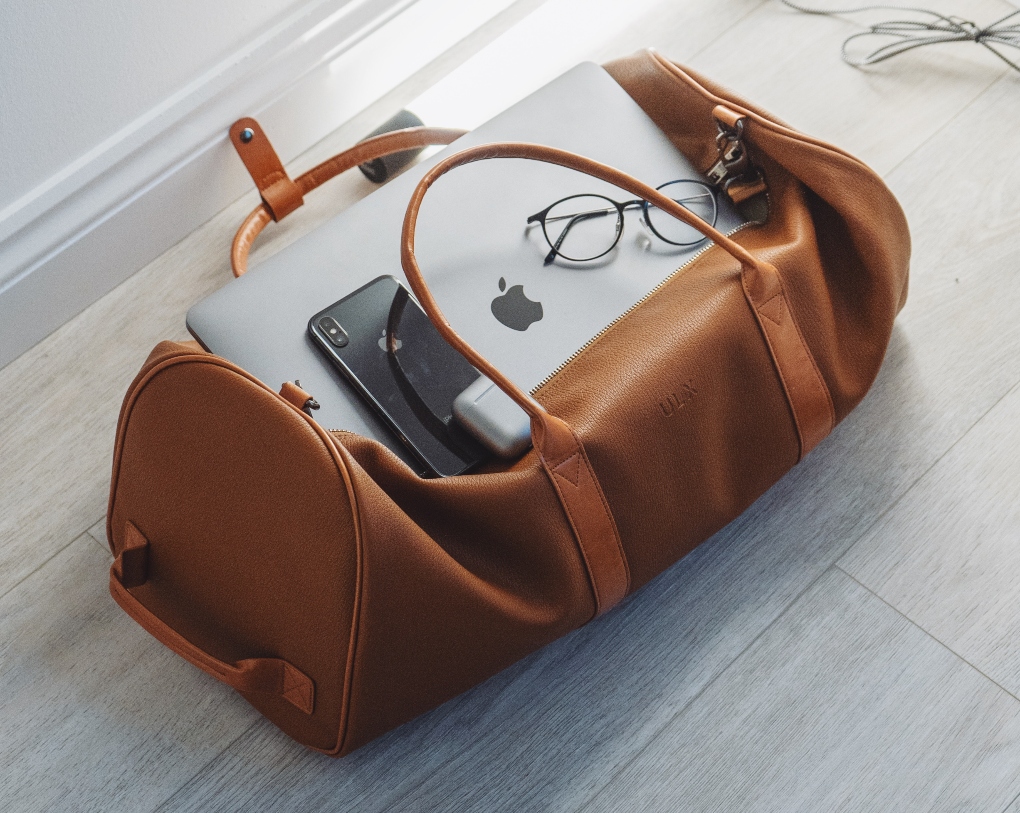
28. Take Off Your Belt
29. take off your jacket, 30. put your phone in the bin, 31. double-check your pockets, 32. make sure to drink or dump the water from your bottle, 33. listen to security personnel, they will help with what to do.
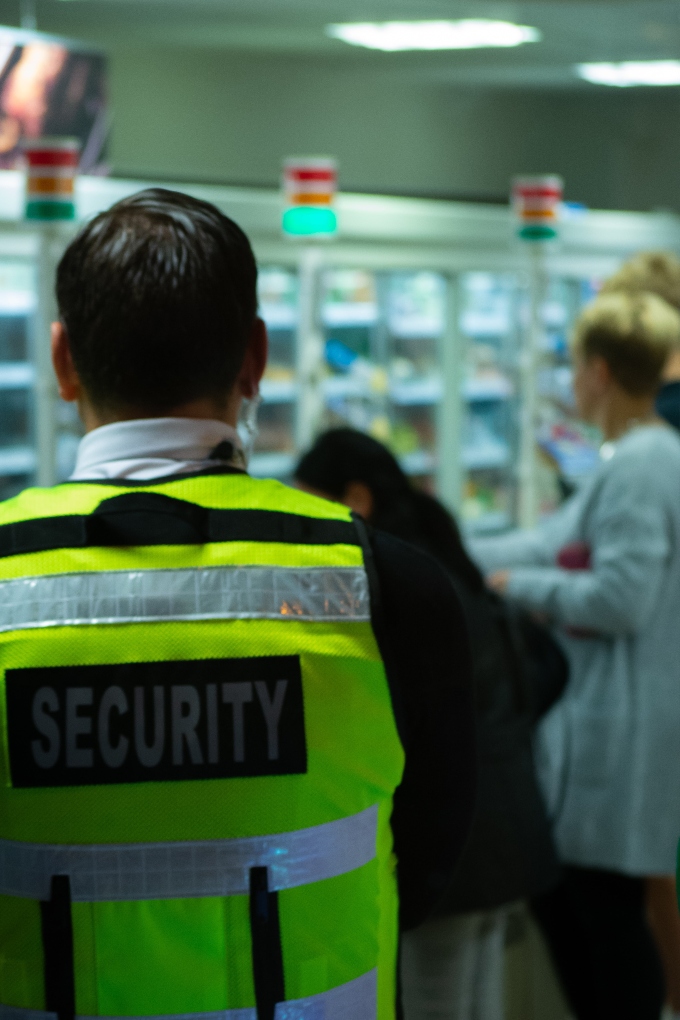
34. Moving Through the Scanner
Once all your belongings are moving through the security conveyor belt, you will be asked to step through a full-body scanner. Usually, you will spread your feet out and lift your hands above your head.
Next, you will be directed out of the scanner. Pause for a bit upon exiting until the security personnel clears you to pick up your belongings.
35. Pat Downs
On occasion, the scanner may pick something up, even if there is nothing there, or perhaps you forgot to remove something metal. The security personnel may use a handheld scanner or will lightly pat you down (following specific guidelines and boundaries to not be inappropriate).
It is a passenger’s right to refuse to be pat down, but you will not be allowed to fly if you don’t comply with TSA security checks.
36. What to Do if Your Bag Is Flagged
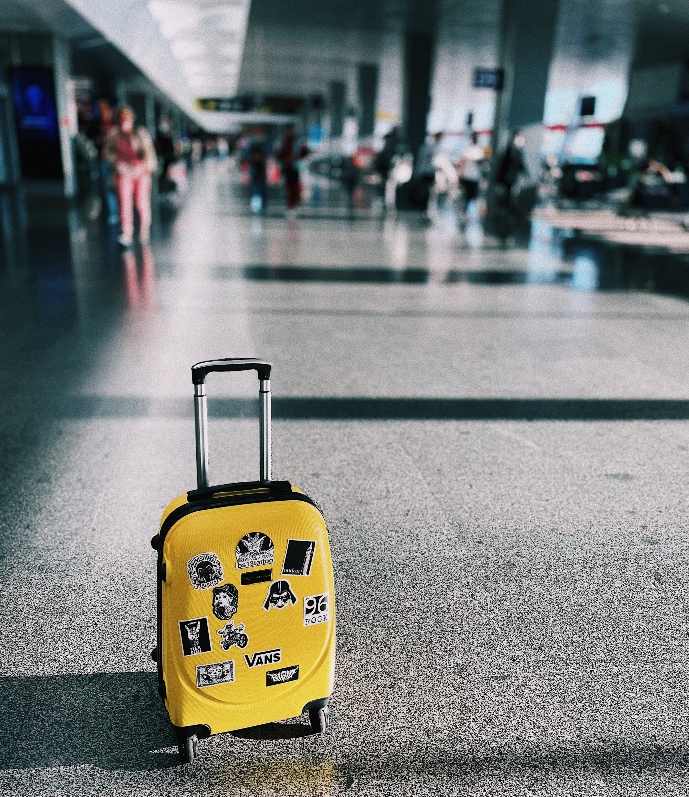
Having your bag flagged is not usually a big deal either. Little things might get picked up in the scanner that security wants to double-check, or perhaps you forgot a liquid that is too big.
Security personnel will ask you to step aside and ask to inspect your bag. You may have to pull some of your things out to let them search for what set off the alarms. Usually, this happens very quickly and you are on your way.
37. Duty-Free at the Airport
If you are questioning whether you can bring something on the plane or not, it is always a safer bet to just leave it at home and buy it at one of the many shops that are past security and what is known as “duty-free.” Duty-free refers to items that you do not have to pay import, sales, value-added, or other taxes on.
Looking For Travel Inspiration and Advice?
Get the latest updates sent straight to your inbox!
FIRST TIME FLYER’S GUIDE TO BOARDING AND THE FLIGHT
38. reading your boarding pass.
Once you exit security, your next step will be to head to your gate . Your boarding pass (the printed version, not so much when it’s on your phone) usually lists your gate, the time that boarding starts, and your seat number.
39. Checking Airport Boards and Signs
There will be big electronic boards throughout the airport that list which flights are at which gate and if they are on time or delayed. I always cross-check my boarding pass with the electronic signs, because your gate might change.
Follow the signs around the airport that direct you to your gate. Again, when I arrive at the gate I check to see that my flight is indeed listed at the gate .
If you get there especially early, your gate might still be showing the flight before yours, in which case you will have to wait and keep an eye on the large boards to make sure nothing changes .
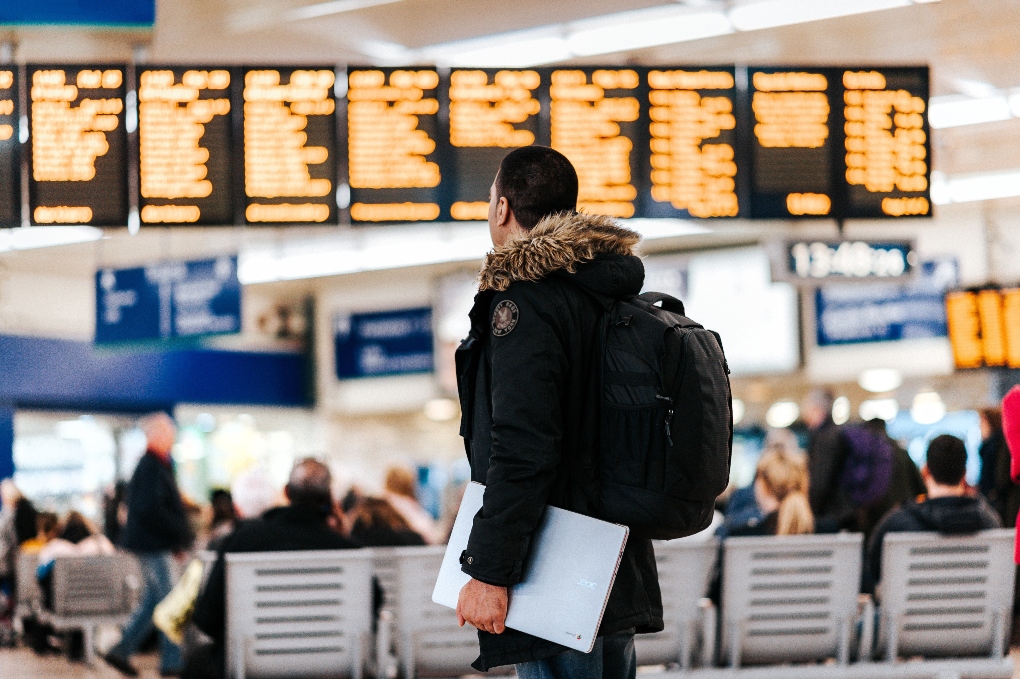
40. At Your Gate and Waiting
Once you reach your gate you are waiting until boarding starts. Find a seat and relax! Or, wander through the shops, find something to eat, or take a light walk to stretch your legs before your first flight.
41. Boarding Your Flight
Boarding zones:.
When your flight is ready to start boarding, the airport personnel will make announcements over the speaker or from the desk. Flights (especially larger ones) typically board by zone . Watch and listen for your zone to be called before getting in line to board. Your boarding pass will note what zone you are in.
Boarding Pass and I.D. Out:
Most flights at this point just check your boarding pass (since your I.D. was already checked at security), but I always keep my I.D. handy just in case.
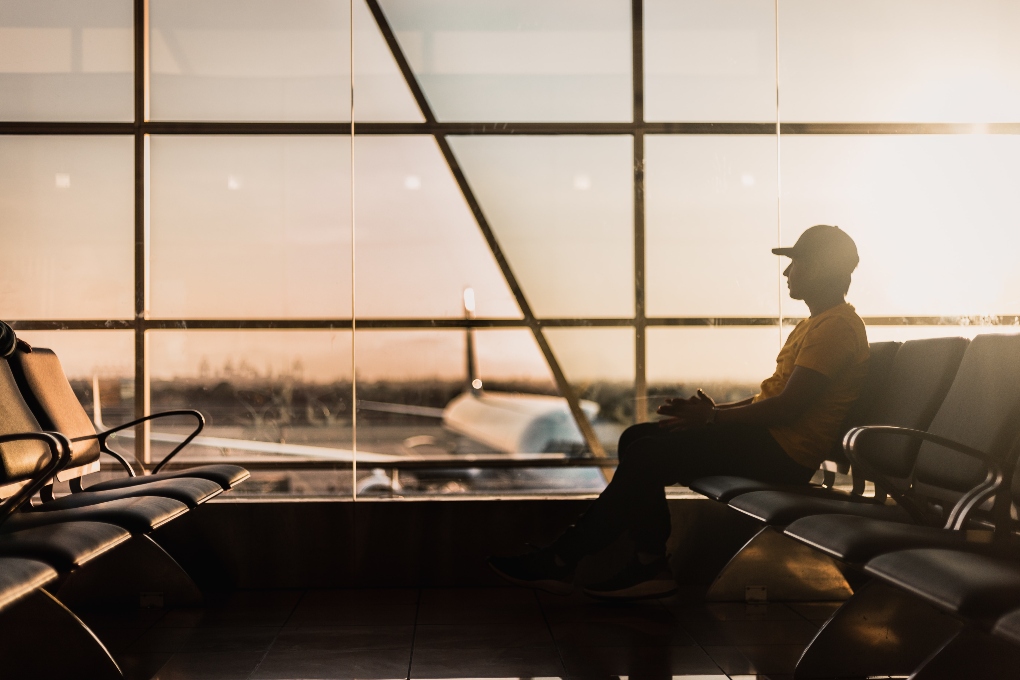
42. Checking Carry-on Bags
If the flight is full, your flight might ask for volunteers to check their carry-on bags or will require some people to check bags if they don’t get enough volunteers. If they ask you to check your carry-on they won’t charge you (unless it is oversized and won’t fit in the cabin) and it’s not a big deal.
You will simply pick up the bag upon arrival as if you checked it like normal. Just don’t forget to take anything out of the bag that you might need during the flight!
43. Getting on the Plane
When you get on the plane, there is usually a flight attendant at the front who will guide first-time flyers to their seat or answer any questions. Otherwise, just walk to your seat and make sure to check above the seat for the letter that corresponds to the window, middle, or aisle seat.
There is a figure of a person on the diagram to show you where the aisle is.

Storing Baggage:
If you have a carry-on, put it in the bin above your seat. Make sure that it is rotated the proper way so it fits and the door will close over it. Put your personal item under the seat in front of you.
44. Put Your Phone on Airplane Mode
All electronics should be put on airplane mode before take-off, this is to ensure there is no interference with the airplane’s signals. Unless told by your flight attendant, you don’t have to turn your electronics all the way off.
Airplane WiFi:
Airplanes nowadays typically have WiFi available for passengers to purchase. You can ask your flight attendant what options they have available.
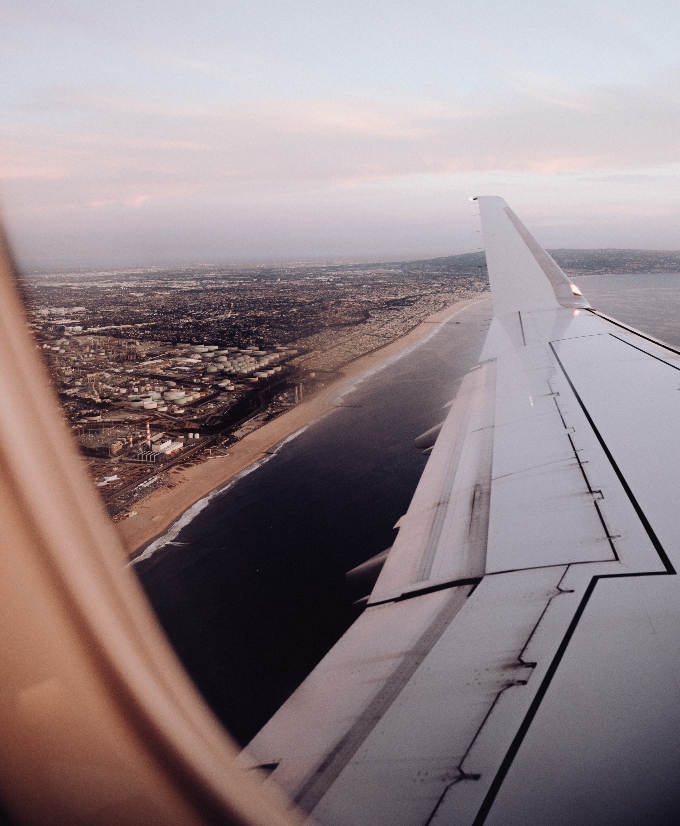
45. Listening to Airplane Emergency Measures
Flight attendants will either display or play a video about the emergency and safety measures of the aircraft. As a first-time flyer, you should pay attention to this guide in the very slim chance there is an emergency.
Don’t be alarmed by the message , they are required to go over safety but airplanes hardly ever encounter any issues.
46. In-Flight Service, Snacks, and Meals
Depending on your airline and the length of the flight, you might be served a snack and beverage or even a meal or two. All airlines have paid food options available that you can browse.
Budget airlines, especially on shorter flights, have started not giving anything out for free – this is why I recommend packing your own snacks! If you aren’t sure, ask your flight attendant what their options are.
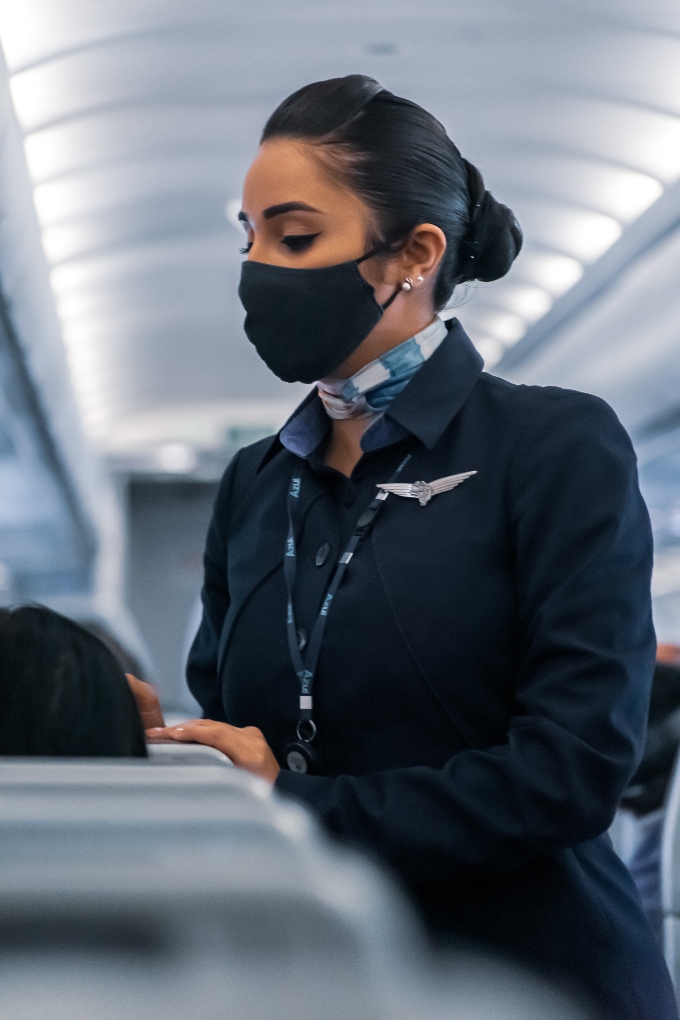
47. Stay Hydrated
Flying always dehydrates you, so make sure to drink plenty of water. Staying hydrated is one of the best ways to help prevent jet lag.
48. Relax and Enjoy!
Landing and what to do after your flight.
After landing, you may have to wait in your seat for a bit as the plane makes its way to the proper gate. The plane will deboard row by row from the front, just sit tight and wait your turn to exit.
49. Following Signs to Exit
When you exit the plane, you will want to follow the signs to the baggage claim and exit. If you didn’t check a bag, just head straight to the exit.
50. Understanding Baggage Claim
Once you reach baggage claim, there will be a few conveyor belts. Look for the one marked with your flight’s information, or look for an electronic board that has information. Depending on how fast you reach baggage claim, you may have to wait a bit.

51. Pick-up, Taxis, and Rideshares
Most airports now (especially bigger ones) have separate areas for passenger pick-up and Taxis and rideshares (Uber, Lyft, etc.). Follow the signs for what you need.
Some airports (such as Los Angeles) may even have you take a shuttle to get to the rideshares, in which case you shouldn’t call your ride until you make it to the designated area and know where to wait.
52. Layovers and Connecting Flights
If you have a layover or connecting flight, there will be separate signs pointing you in the right direction back towards the gates. Some airports will have you pass through security again, but many will not.
When you are checking your bag, make sure to ask if your bag will be checked through to your final destination . If you are on the same airline for both flights, this is pretty standard practice.
It can get a bit trickier when you switch airlines. If you need to pick up your bag, you will have to head to baggage claim and then back to the ticketing counter to check it for your next flight.
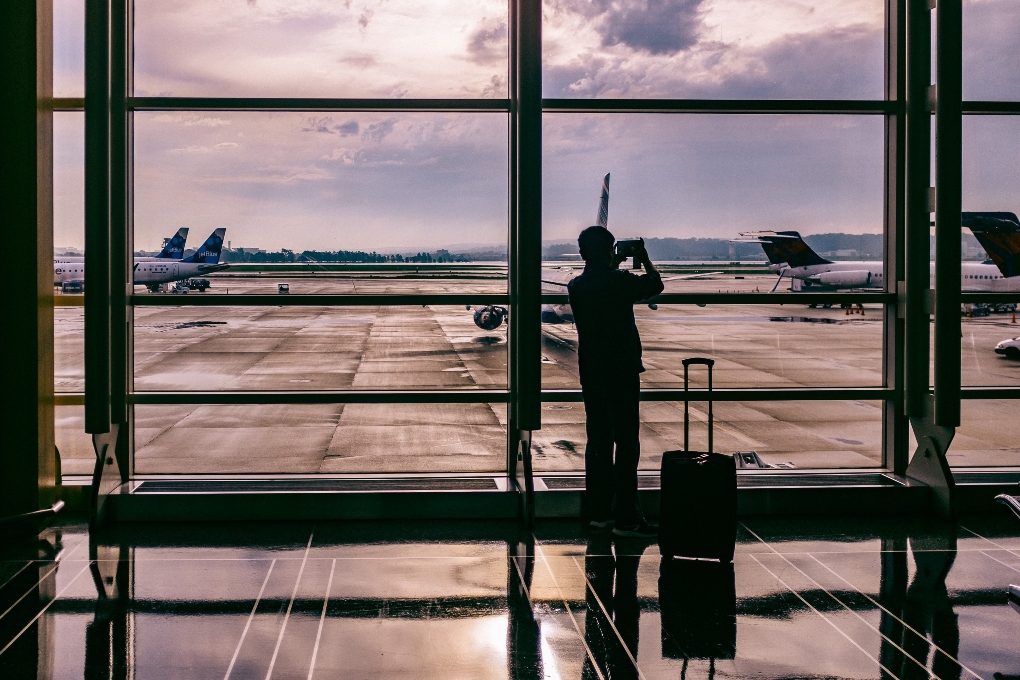
FIRST TIME FLYERS’ CHECKLIST
Summary: tips for flying on a plane for your first time.
Preparing for your first time flying is extremely helpful, but no two flights are ever the same , so don’t stress the little details too much! Each airport has its quirks and layouts, so follow signs, ask for help if you need it, and reference this first-time flyers guide.
For travel junkies like me, airports are fun to find interesting restaurants, fun souvenirs, or to people-watch and dream about your next vacation. Plus, it opens up a world for you to explore if you can get comfortable flying (especially now that remote jobs are changing the way we travel ). Enjoy your first flight!
Looking for resources to use for your next trip or move abroad? CLICK HERE for my favorite travel and expat tools!
Janelle Axton is a travel consultant and owner of Make the Trip Matter, a service dedicated to helping people create a lifestyle around frequent travel and extended time abroad. She grew up in California and spent time living abroad in Ireland in addition to traveling to over 25 countries.
Similar Posts

Scotland vs. Ireland (2024): Tourist and Expat Guide
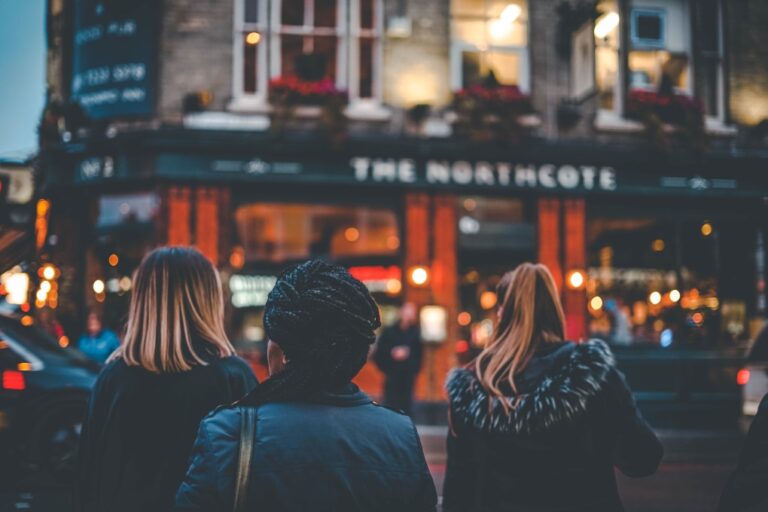
Is Dublin Safe? BEST Safety Tips for Travelers in 2024

Guide to Working Remotely Abroad For a U.S. Company in 2024
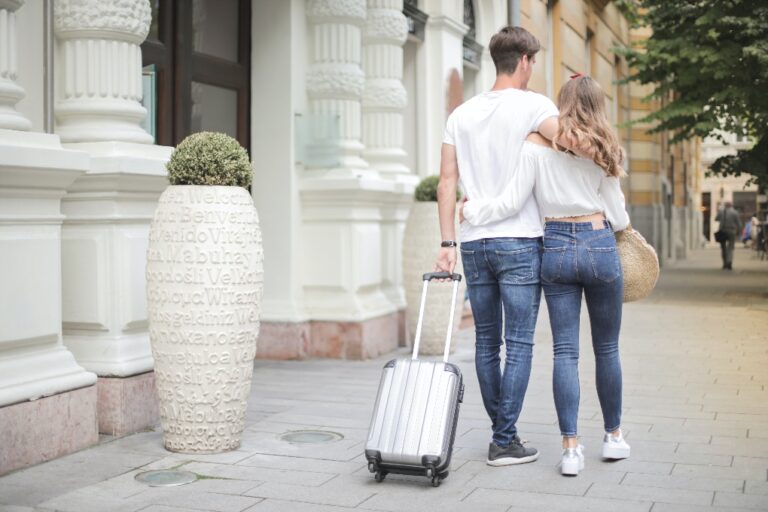
45 Romantic and Fun Things to Do in Dublin for Couples (2024)
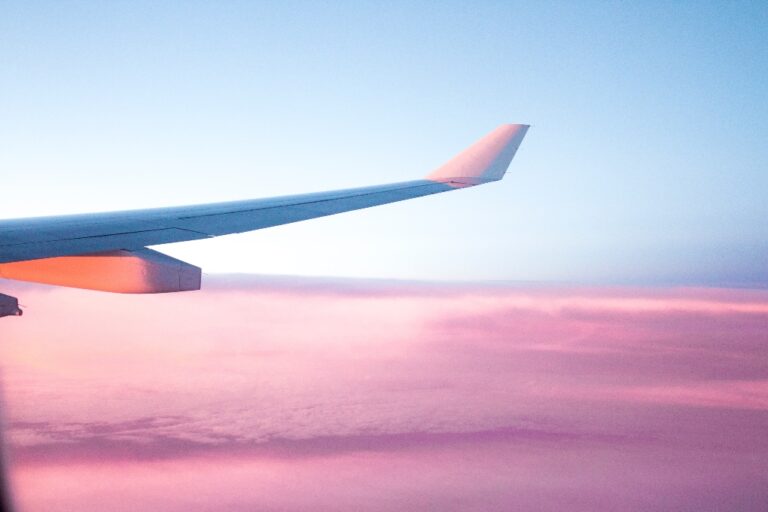
Is Skyscanner Legit? Review and Tips 2024
- Credit cards
- View all credit cards
- Banking guide
- Loans guide
- Insurance guide
- Personal finance
- View all personal finance
- Small business
- Small business guide
- View all taxes
You’re our first priority. Every time.
We believe everyone should be able to make financial decisions with confidence. And while our site doesn’t feature every company or financial product available on the market, we’re proud that the guidance we offer, the information we provide and the tools we create are objective, independent, straightforward — and free.
So how do we make money? Our partners compensate us. This may influence which products we review and write about (and where those products appear on the site), but it in no way affects our recommendations or advice, which are grounded in thousands of hours of research. Our partners cannot pay us to guarantee favorable reviews of their products or services. Here is a list of our partners .
7 Must-Know Tips for First-Time Flyers

Claire Tsosie is an assigning editor for the team responsible for expanding NerdWallet content to additional topics within personal finance. She has edited articles on a variety of topics, including home improvement, Social Security, estate planning, Medicare, crypto and business software. Previously, she was a credit cards writer at NerdWallet. Her work was featured by Forbes, USA Today and The Associated Press.

Kenley Young directs daily credit cards coverage for NerdWallet. Previously, he was a homepage editor and digital content producer for Fox Sports, and before that a front page editor for Yahoo. He has decades of experience in digital and print media, including stints as a copy desk chief, a wire editor and a metro editor for the McClatchy newspaper chain.
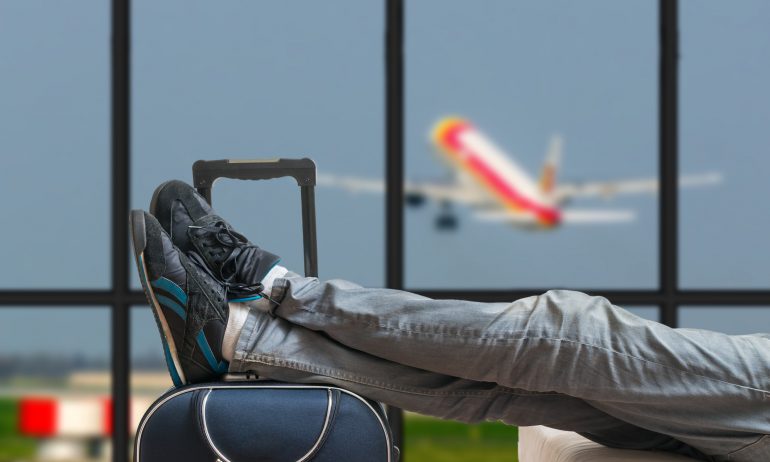
Many or all of the products featured here are from our partners who compensate us. This influences which products we write about and where and how the product appears on a page. However, this does not influence our evaluations. Our opinions are our own. Here is a list of our partners and here's how we make money .
Flying on an airplane for the first time — or the first time in a long while — can be an exciting, life-changing adventure. But it can also be incredibly stressful.
You want to head for the gate with the swagger of a seasoned traveler, but that's hard to pull off when you don't know how much it costs to check a bag, or what to expect when you go through airport security.
So how can you deal? Reviewing these tips before takeoff can boost your confidence, making your trip easier and more worry-free.
Best advice for first-time flyers
1. check the airline's luggage requirements.
It’s easy to overpack — but if you do, it could cost you. Before your flight, visit your airline’s website to review luggage size and weight restrictions, as well as baggage fees. While these vary by airline and fare paid, here's what you can typically bring with a standard fare on a major airline:
Two carry-on items for free: one full-size carry-on the size of a small rolling suitcase or smaller, and one small personal item, such as a purse or backpack.
One checked suitcase (often, one weighing under 50 pounds) for $35 to $40. Checking additional bags could cost more.
If your carry-on bag is too bulky, you may have to pay to check it. Likewise, if your checked bag is over a certain size, you may have to pay a higher-than-usual fee to check it. It's best to avoid these surprises, if possible.
"If you’re a nervous flyer, little things can really set you off,” says Jackie Sills-Dellegrazie of New York City, founder of the travel blog The Globetrotting Teacher . “Even if it’s not a big deal, and you get to the check-in counter, and they say, ‘Oh, by the way, there’s a $35 bag fee,’ and you weren’t expecting that, that could just be something that rattles you."
Remember, if you pack light enough , you could avoid baggage fees altogether.
Having an airline credit card can mean waived checked baggage fees, as well. For example:
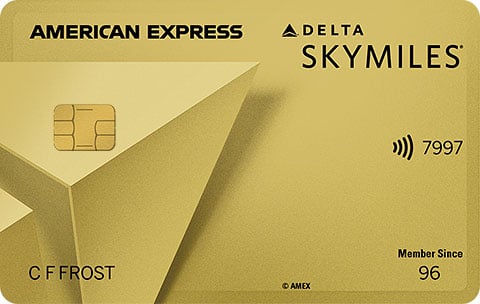
on American Express' website
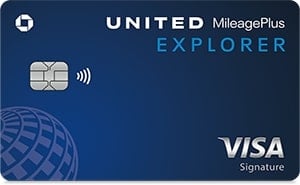
on Chase's website
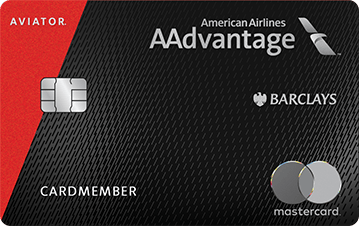
on Bank of America's website
$0 intro for the first year, then $150 .
$0 intro for the first year, then $95 .
First checked bag free for you and up to eight others on your reservation. Terms apply.
First checked bag free for you and a companion traveling on your reservation.
First checked bag free for you and up to four others traveling on your reservation.
First checked bag free for you and up to three others traveling on your reservation.
First checked bag free for you and up to six others traveling on your reservation.
2. Pack essentials in your carry-on
If you’re packing anything that’s hard to replace — say, prescription medicine, contacts or glasses, or important paperwork — put it in your carry-on bag. This way, you won’t be without that item in the rare event your checked bag goes missing. You'll also want to pack some in-flight entertainment, such as your laptop, headphones and a book or magazine.
Just make sure you’re following the Transportation Security Administration’s rules for what you can pack . You can’t, for example, bring a big bottle of contact lens solution in your carry-on, but you can bring a 3.4-ounce bottle. And keep in mind that if your carry-on bag is too big to fit under the seat in front of you, you may have to check it. More rules may apply if you're flying internationally.
» MORE: 10 ways to minimize mix-ups on your first trip abroad
“The overhead compartments fill up quickly,” says Jeff Klee, CEO of CheapAir.com, an online travel agency based in Calabasas, California. “If you’re in the back of the plane, you might find that there’s no more room, and you’ll have to do a gate check of your bag at the last minute, which isn’t particularly fun." Checking your bag at the gate means your full-sized carry-on bag will travel with the other checked bags during the flight, rather than in the overhead bin.
3. Arrive at the airport two hours early
Catching a plane isn’t like catching a bus; it’s a much longer process. In fact, the TSA recommends showing up at least two hours before takeoff for domestic travel, and three hours for international travel.
Ultimately, you need to give yourself enough time to get your boarding pass, check your bags and go through security before your plane starts boarding. Sometimes, that takes 10 minutes. Other times, especially during peak travel times, it can take much longer.
It’s worth keeping in mind that boarding the plane isn’t a free-for-all, either. Airlines typically start boarding passengers 30 minutes before takeoff in groups. Generally, a boarding time will be printed on your ticket.
4. Keep your ID handy
Decades ago, airport security was relatively lax. “There was one point where you could just walk up to a gate, whether you were flying or not, whether you had ID or not,” Klee says. Nowadays, TSA agents check IDs for passengers over 18.
Save time by having your ID card, driver’s license or passport handy as soon as you step foot into the airport. You’ll need it when checking bags and going through security, and you don’t want to hold up the line while rummaging through your wallet.
5. Wear easy-to-remove shoes
Going through airport security might be the most stressful part of flying — but if you know what to expect, the whole rigmarole can feel much less taxing. Typically, unless you have TSA PreCheck or Global Entry , you have to:
Remove your shoes (unless you’re 12 and under or 75 and older).
Empty the contents of your pockets and remove your hat, belt, jacket, wallet and bulky jewelry
Remove your laptop and liquids from your bag.
Send these items — and your carry-on bag — through an X-ray machine.
Walk through a metal detector or a body scanner (or opt for a pat-down).
Preparing for this — say, by wearing shoes you can easily slip on and off and making sure the items in your carry-on are TSA-compliant — can make the process faster.

WANT TSA PRECHECK FOR FREE?
A number of popular travel credit cards reimburse you for the application fee for trusted traveler programs like TSA PreCheck and Global Entry. Among them:

Statement credit of up to $100 as reimbursement when you charge the application fee for TSA PreCheck or Global Entry to the card. Available once every 4 years.
Statement credit of up to $100 as reimbursement when you charge the application fee for TSA PreCheck, Global Entry or NEXUS to the card. Available once every 4 years.
If your credit card offers reimbursement for the application fee for programs like TSA PreCheck or Global Entry, you must pay the fee with the card. You cannot submit a claim for reimbursement if you paid with some other method. Reimbursement will usually appear as a statement credit in your account within two months.
Cards typically offer reimbursement of only one fee once every four to five years. Check the terms and conditions of your card for the specific rules that apply. Note also that these cards only reimburse the application fee for a trusted traveler program. They don't automatically enroll you in the program or guarantee that you'll be accepted by the program. You still have to apply and go through the required screening, which in the case of TSA PreCheck and Global Entry includes an in-person appointment.
Aeroplan® Credit Card .
Bank of America® Premium Rewards® credit card
Capital One Venture X Rewards Credit Card .
Chase Sapphire Reserve® .
Citi® / AAdvantage® Executive World Elite Mastercard® .
Delta SkyMiles® Platinum American Express Card .
Delta SkyMiles® Reserve American Express Card .
IHG One Rewards Premier Business Credit Card .
IHG One Rewards Premier Credit Card .
Marriott Bonvoy Brilliant® American Express® Card .
The Platinum Card® from American Express .
Southwest® Rapid Rewards® Performance Business Credit Card .
United Club℠ Infinite Card .
United℠ Explorer Card .
United Quest℠ Card .
U.S. Bank Altitude™ Reserve Visa Infinite® Card .
Terms apply.
» SEE the best credit cards that pay for TSA PreCheck and Global Entry
6. Respect other passengers' space
These days, flights are generally fully booked, and most seats offer limited legroom. This might stress out your fellow flyers, so be sensitive.
“If any of your stuff or body parts are going into another space that’s not yours, you really have to be mindful of that,” Sills-Dellegrazie says. “It can be as simple as, you put your ponytail over the top of the seat and now it’s hanging … across someone’s TV screen, and you don’t even realize it."
Similarly, if you wear perfume or cologne, eat smelly foods or listen to loud music, you might unintentionally upset the person sitting next to you. Of course, you can't plan for everything — maybe you're traveling with an upset child, for example — but do what you can to avoid an in-flight faux pas.
7. Have a backup plan ready
Now for a game of “worst-case scenario,” first-time flyer edition: What happens if you miss your flight or your flight gets delayed or canceled ?
First, take a deep breath.
If you miss your plane because of unforeseen circumstances, such as a major traffic delay, the airline will often put you on standby for the next flight without charging extra. Just remember that you generally need to notify the airline within a couple of hours of missing your flight to get rebooked for free.
If it looks like you'll miss a connecting flight , check the smartphone app offered by your airline or the screen in the airport to find out which gate your flight departs from, and whether you've actually missed it. If the flight is delayed, you may still have a chance to board. If you miss the connection and the airline was responsible, you can generally also rebook that flight free of charge — and maybe even get some free meal or hotel vouchers for the hassle.
Smart travelers mitigate the risks of unexpected travel disruptions by booking their flights using a credit card with travel insurance or purchasing a separate standalone travel insurance policy .
In general, be proactive. Have the airline's customer service phone number handy in case you get stuck in traffic, so you can call as soon as possible. Or if you're already at the airport, go to the customer service desk and asking about rebooking. Missing a flight can be a setback, but it doesn’t have to derail your travel plans.
To view rates and fees of the Delta SkyMiles® Gold American Express Card , see this page .
How to maximize your rewards
You want a travel credit card that prioritizes what’s important to you. Here are some of the best travel credit cards of 2024 :
Flexibility, point transfers and a large bonus: Chase Sapphire Preferred® Card
No annual fee: Bank of America® Travel Rewards credit card
Flat-rate travel rewards: Capital One Venture Rewards Credit Card
Bonus travel rewards and high-end perks: Chase Sapphire Reserve®
Luxury perks: The Platinum Card® from American Express
Business travelers: Ink Business Preferred® Credit Card

1x-5x 5x on travel purchased through Chase Travel℠, 3x on dining, select streaming services and online groceries, 2x on all other travel purchases, 1x on all other purchases.
60,000 Earn 60,000 bonus points after you spend $4,000 on purchases in the first 3 months from account opening. That's $750 when you redeem through Chase Travel℠.

1.5%-5% Enjoy 5% cash back on travel purchased through Chase Travel, 3% cash back on drugstore purchases and dining at restaurants, including takeout and eligible delivery service, and unlimited 1.5% cash back on all other purchases.
Up to $300 Earn an additional 1.5% cash back on everything you buy (on up to $20,000 spent in the first year) - worth up to $300 cash back!
on Capital One's website
2x-5x Earn unlimited 2X miles on every purchase, every day. Earn 5X miles on hotels and rental cars booked through Capital One Travel, where you'll get Capital One's best prices on thousands of trip options.
75,000 Enjoy a one-time bonus of 75,000 miles once you spend $4,000 on purchases within 3 months from account opening, equal to $750 in travel.


27 Best Tips for Flying for the First Time (2023)
Flying for the first time can be both exhilarating and frightening. There are many things you can do to make it easier and less stressful, though! I’ve rounded up 27 of the best first time flying tips to make it that much easier for you.
If this is your first time flying, much of your anxiety likely comes from just not knowing for sure what to experience. One of the best things you can do for yourself is to prepare ahead of time!
Knowing things like what to expect while going through security, what’s the best thing to wear on an airplane, and advice on avoiding extra luggage fees can be a game changer when it comes to being comfortable on your first flight.
Here are 27 travel tips for first time flyers that will have you flying like a pro on your very first flight.
1 Dress comfortably
One of the best first time flyer tips is to dress comfortably and to make sure you have layers.
Sitting on a cramped plane for hours can be a nightmare if you’re wearing clothes that are restrictive or make you uncomfortable.
Not only are you in a cramped space with little ability to move around, but pressure changes during the flight can cause your body to feel bloated or your legs to swell.
Make sure you wear unrestrictive clothing, comfortable shoes, and have a sweater or jacket in case you get cold once you’re in the air.
You’ll also thank yourself for wearing comfy clothing the first time you have to climb over another passenger to use the restroom!
By Tawnya at Money Saved is Money Earned
Click to view our recommendations :

RELATED: Road Trip Essentials: Make Sure to Pack These in Your Car
2 Stay hydrated
If you want to experience an enjoyable flight, staying hydrated is key. Airplanes create a humid environment, which can quickly lead to nausea, tiredness, and headaches. And a headache is the last thing you want at 40,000 feet!
Staying hydrated on a plane isn’t difficult. You should ensure that you drink plenty of water before and throughout the flight.
Equally, you will want to avoid coffee and alcohol (no matter how tempting the complimentary booze might be!) as these will dehydrate you even more.
Drinking water isn’t the only way to stay hydrated on a plane though. One way to see just how dehydrating airplanes are is by looking at your skin after a flight. With the harsh air conditioning blasting in your face for several hours, your face will quickly dry out.
You can overcome dry skin by packing a small moisturiser or facial spritz to apply throughout the flight.
A good lip balm is a must too to combat dry and painful lips! And finally, you may benefit from packing a nasal spray too, to avoid dry and painful sinuses.
By Hannah at Get Lost

3 Use points to pay for your flight
If you’re a first time flyer, you may not be aware that you can use credit card points to pay for your ticket.
Every airline has a reward program and you can sign up to start earning miles with them from your very first time flight experience.
However, unless you fly on that particular airline often, it’s going to take quite a while to rack up enough miles for a free flight.
Another option is to select a credit card that has a great sign up bonus and use those points to pay for your ticket.
The way this works is like this: once you’re approved for the card you applied for, you’ll typically have three months to put a certain amount of spend on it.
Once you’ve done that, the bonus points will be yours to spend as you choose!
At the time of this writing, the Chase Sapphire Preferred card has a sign up bonus of 60,000 points. You’ll need to spend $4,000 within three months to meet the requirement.
You can use that 60,000 points to splurge on something like a first class round trip ticket to Europe or go the more economical route and you’ll be able to book a few domestic economy flights.
Using points to pay for flights is one of the best flying for the first time tips there is. Use your points wisely and you’ll be flying for the second, third and fourth time in no time!
By Karee at Our Woven Journey
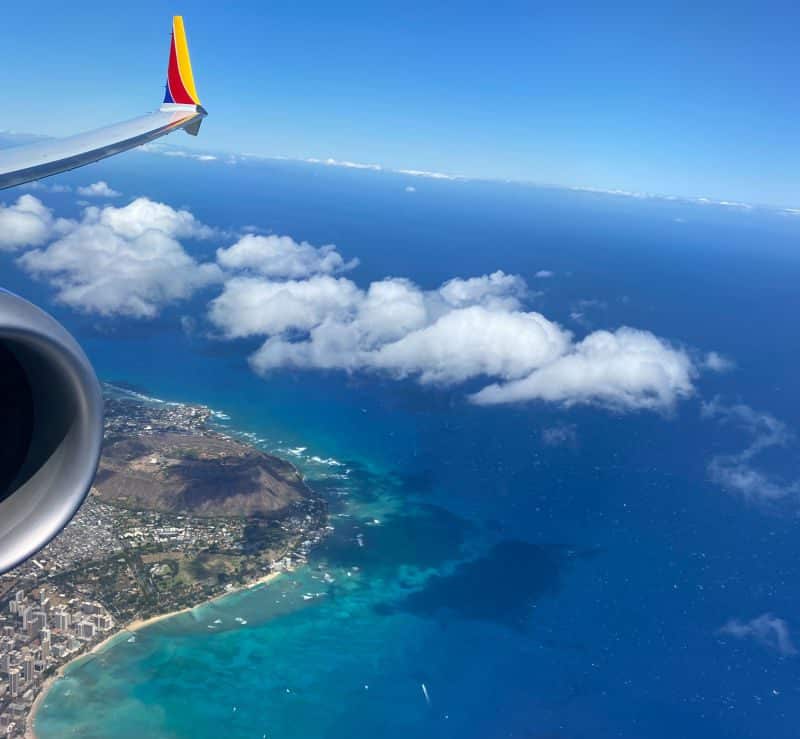
4 Know how to get over jet lag quickly
Jet lag occurs when you travel quickly to a new time zone which alters your natural circadian rhythm. It can cause fatigue and insomnia whilst you adjust, and the more time zones you travel through, the more affected you can be. Generally, the effects of traveling from west to east can be worse.
Our internal clock becomes mixed up partly due to a difference in exposure to light so one way to alleviate symptoms and help you recover from jet lag faster is to get outside soon after flying.
Exposure to natural daylight will reduce the release of melatonin hormones that make you sleepy and help wake you up so that you can stick to the schedule in your new time zone.
Melatonin products can help the other way around too, and help you to drift off if you are struggling.
And drink plenty of water before, during and after your flight, as dehydration will make it worse!
By Rosanna at Rosanna Etc.

5 Use packing cubes
One of the most surprising first-time flying tips is to use packing cubes. This seems an almost oxymoron because you are putting your stuff into more stuff.
However, since packing cubes use compression technology it makes your stuff take up so much less space. They usually have multiple zippers, the first to secure the contents, the second to compress the size down.
There are two strategies for utilizing packing cubes: the first strategy is to pack your daily outfit in each cube (or your family’s outfits), the second strategy is to pack by item in each cube.
I recommend packing by outfits, as this will enable you to turn them and put the dirty items in that same cube.
Usually, the packing cubes come in packs of three of multiple sizes. The smallest is perfect for your first day comfortable outfit and pajamas the night you arrive.
Make sure to tuck this into your carry-on just in case your checked luggage arrives late. Packing super light in a carry-on will make your flight less stressful.
By Rebecca at Whatever Packs Your Bag

6 Download movies before your flight
An excellent way to keep yourself entertained during a flight is to download a selection of Netflix or Amazon Prime movies to your device.
Some flights don’t come with onboard entertainment and others charge extra for a movie package. Instead of relying on the airline, it is a great idea to prepare your own entertainment.
If you already have a Netflix or Amazon subscription, all you need to do is download your favorite show to be able to watch it in offline mode.
You won’t be able to do this once you’re on the plane and don’t have wi-fi, so add this to your travel checklist to do before you travel. You can watch them on your phone, but for the best experience, watch can movies on one of these lightweight laptops for traveling .
Netflix and Amazon Prime both have a wide selection of shows. You can spend the flight time learning Spanish or watching a fascinating documentary.
Time passes more quickly when you’re watching your favorite shows which helps a lot, especially if you have trouble sleeping on a plane.
And before you know it, it will be time to land!
By Mal from Raw Mal Roams
➡️ Get a free 30 day trial for Amazon Prime Video
7 Know how to book cheap flights
Preparation for a flight actually starts when searching for a flight because no one wants to pay more than they have to.
Luckily, there are several tricks to help you find the cheapest flight possible.
First, be flexible with your travel dates when searching for flights. Some days of the week, month and year are cheaper than others. The larger your date range, the easier it is to pick the cheapest moment to fly.
Second, compare different airlines through a price comparison site such as Skyscanner. This way you’re sure to find the most affordable carrier. Websites of the airlines themselves are often the most expensive!
Third, don’t be lured into paying for extras. Be especially aware of low-cost airlines trying to upsell additional services: from extra luggage and priority boarding to selling lottery tickets on the plane itself. Most of these things you don’t need at all so be strict with yourself and keep your budget in mind.
By Emma at Emma’s Roadmap
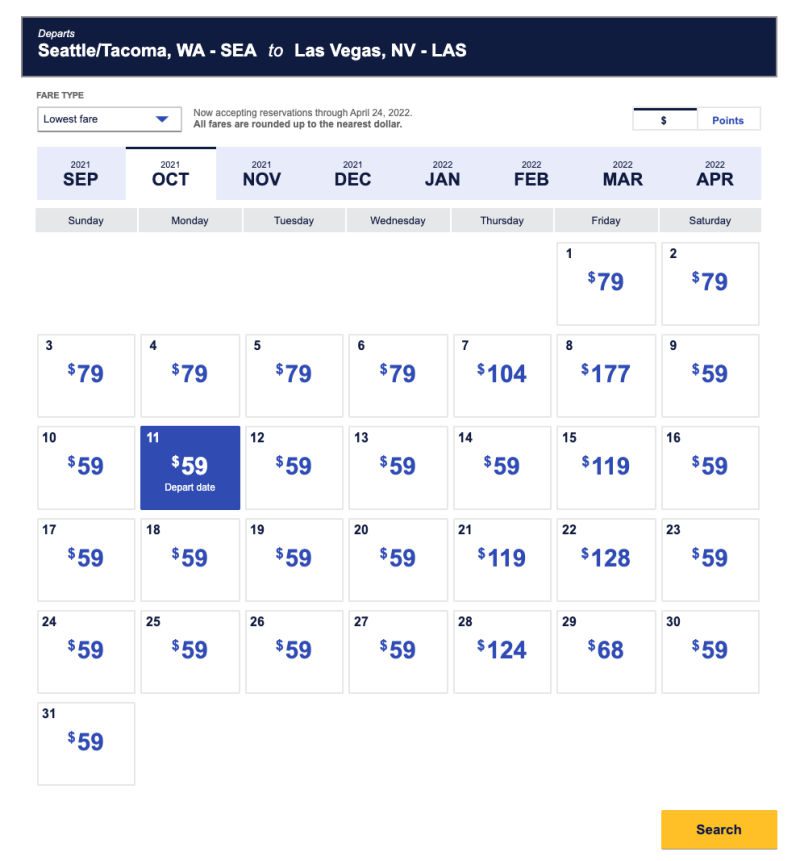
8 Pack valuables in carry-on luggage
If you are planning to travel and pack both a carry-on bag and checked luggage, this one is for you.
When it comes to flying on any airline, even if it’s rated number one in the world, there is always the possibility that your checked luggage will go missing. Especially if you have connecting flights!
Make sure to pack your valuables in your carry on luggage and store them in the overhead bins or below the seat in front of you.
Valuables can include many things. Firstly, make sure to carry your passport, wallet with money, and any high-value jewelry in a sling bag or concealed purse that you keep on your person at all times.
Secondly, keep essential medications and vitamins in your carry-on luggage (never in checked luggage!) as these cannot be replaced easily while you travel.
Thirdly, place your electronics, including your best camera for travel , phone, laptop and even drone in your carry-on luggage.
If you plan to carry a drone with you, ensure you pack the drone batteries in your carry on luggage, and the body of your drone in checked luggage. Always store battery packs in your carry-on.
As a good rule of thumb while travelling, never store your valuables far from reach!
By Haley of HaleyBlackall.com

9 Choose your seat wisely
Going on your first flight is an exciting experience that you will always remember. That is why it is important to choose your seats wisely! If you choose the wrong seat, your flight won’t be as enjoyable. Between catching beautiful views and stretching your legs, your seat choice can have a huge impact on your trip.
If your first flight is a short one, you should choose a window seat. The view from the window is always amazing. Between watching cities fade into the distance, beautiful sunsets, and cars that look like ants, you will be amazed by everything you can see from an airplane.
While window seats are ideal for short flights, you may be uncomfortable during a long flight . During a long flight, the best seats to choose are aisle seats. This is especially true if flying on a large airplane. Sitting in the aisle seat allows you to stretch your legs and use the bathroom as needed. There is nothing worse than crawling over strangers on a long flight to go to the bathroom!
If you really want to make sure you get the best seat on the plane, use SeatGuru for reviews of the aircraft you’ll be flying.
By Gabby at Journey to the Destination
10 Bring a neck pillow and blanket
When you head out on a flight, you want to be comfortable, and often the air conditioning is too cold, or the seats are uncomfortable. A good idea is to bring eco friendly travel products like a comfortable neck pillow so you can sleep well without hurting your neck and a blanket to stay warm . There is nothing worse than feeling cold on a flight.
A sarong is also a great versatile piece of travel accessory to bring. Taking this on the plane means you can re-use it on the beach or cover up if you are entering temples during your trip. It is super lightweight and takes up pretty much no space.
An extra pair of socks can also be ideal for the flight. Why not make them big and fluffy for extra comfort?
By Linn at Brainy Backpackers

11 Savvy use of your carry-on allowance
Depending on where you’re traveling to, sometimes you might only have carry-on luggage and some airlines are extremely strict with what you can take. In fact, some economy airlines will only allow one cabin bag so if you have more than one item, such as a purse and a backpack, one needs to fit inside the other.
The ultimate hack for first time flyers is knowing how to extend your carry-on luggage allowance. If you buy something in the airport (no matter how small), provided it comes in an airport carrier shopping bag, this becomes an extension of your carry-on luggage.
So, if you’ve already packed your cabin bag tight, use the shopping bag to hold all the essentials that you want to use on the flight. Not only does this mean you don’t have to keep getting up to take things out of your bag, but it also means more space.
If your airline isn’t quite as strict, it’s still handy to have one big carry on and one item that’s small enough to fit under your seat without being uncomfortable, but big enough to have all your essentials in it.
Don’t stress, just fly savvy.
By Kerry Hanson from VeggTravel

12 Be Ready to go Through Security Checkpoints
One of the most nerve-wracking parts of flying can be dealing with airport security. Even experienced travelers can have irrational anxiety dealing with getting their liquids ready and having laptops prepared to go through the detectors.
Because it’s an anxious time for everyone, people in line can also be quite rude. If you are slowing down the line, you risk alienating a massive line of people. No one wants to start their first flight that way.
While you’re in line for security, be sure to start preparing for the scanners right away.
You will need to remove any jackets or sweaters (you’ll need to go down to your lowest layer). Take all the items out of your pockets – or wear pants with no pockets to skip this step. Try to wear pants that don’t need a belt or take it off while you’re in line.
Keep your shoes on in line! Airport floors are gross – and some airports don’t require you to take them off.
When you pack your carry-on, be sure to put all the items that need to come out at security on one side. Laptops, tablets, and liquids will need to be removed. If you put your liquids in a small bag or Ziploc, it’ll make this even easier.
Also, keep in mind that any liquid containers have to be 3.4 oz or smaller and need to be packed together in one quart-sized ziplock bag.
By Nina of Nina Out and About

13 Use a foot-sling to relieve back and leg pain
If you suffer from low back or leg pain, the idea of sitting in a cramped airplane seat isn’t all that appealing. Shorter flights may not be a problem, but flights over a couple of hours long can be a pain, literally! One of the best travel accessories you can pack to help alleviate the pain is a foot-sling to use on your flight.
To use it, you simply lower the tray on the seat back in front of you, place the strap over the arms of the tray and then close the tray again. You can adjust the height of the sling as needed to make it as comfortable as possible for your back and legs.
One thing to note is you’ll want to be aware of the person sitting in the seat in front of you. Always take your feet out of the sling before you lower the tray or it will jolt their chair. Treat them like you would want to be treated and you’ll be fine.
You also want to be sure you’re not putting unnecessary pressure on the tray arms as you get comfortable.
Most foot-slings roll up small and take up very little space as a personal item in your carry-on bag. It can make a huge difference in how comfortable you are while sitting for hours, so if back or leg pain is an issue for you, you’ll definitely want to bring one of these along! This is one of the best tips for first time flying because once you get it, you can use it for every flight from now on.
14 Use a travel credit card with the best perks
Chase Sapphire Reserve is one of the best travel secrets every new traveler should know about. You can get access to airport lounges included in your credit card membership through Priority Pass. The lounges are available in many airports and some even have multiple lounges you can visit on the same day!
Not only that, there are many other benefits of using the card including a large signup bonus where you can receive credit towards purchasing a flight or other travel perks.
In addition, you are covered for car insurance when you rent a car so there are many wonderful perks that outweigh the cost of the membership.
You also get $300 credit off travel purchases so although there is an annual fee for the card, it’s reduced by this and the many other benefits that pay for themselves. If you’re a first-time traveler and hope to travel a lot more often, then this card is amazing and will have you prepared to travel the world.
Jackie of Jou Jou Travels

15 Avoid extra luggage fees
The quickest way to blow your travel budget before even stepping on a plane is being charged an unexpected fee for an oversize or overweight suitcase.
Most airlines charge for any type of checked baggage and some even charge for a carry-on. This can vary based on the type of ticket you bought as well. Before the trip, head straight to the source and check the airline’s website for specifics.
But don’t stop there! Be sure to check the airlines bag size and weight limitations too. A carry-on that is too big may have to be checked, with an additional bag fee. The easiest mistake, one that I have made and seen many others make, is trying to check an overweight bag.
Many airlines have a 50 pound limit. Sometimes 1-2 extra pounds can be ok, but not always. You can either take out a few pounds and add them to your your carry-on, or get stuck with an oversize bag fee upwards of $100.
All it takes is a few extra minutes of research, some measuring and weighing to avoid those extra fees. I recommend packing a luggage scale to use on the way home. Those souvenirs can get heavy!
By Hailey at America My Beautiful
Click to view our recommendation :

16 Avoid ear pain
For a lot of people, flying can lead to pain in the ears due to changes in air pressure. This can be quite uncomfortable, and sometimes even pretty painful. There are a few different tricks that can help with equalizing the pressure in your ears while flying in order to lessen the discomfort and pain.
One of the simplest things you can do to limit ear pain from flying is to drink plenty of water before and during your flight. The airplane air is dry, which makes the nasal mucous thicker and more likely to clog your Eustachian tubes (the tubes that connect your throat to your ears). Drinking also encourages swallowing, which can help equalize ear pressure. Other things you can do to help open your Eustachian tubes are chewing gum and yawning.
If none of the above tips work, you can try something called the Valsalva Maneuver to help clear your ears. To do this, keep your mouth closed, pinch your nose closed, and gently exhale – this should push air through your tubes and help them open up.
By Sydney at A World in Reach

17 Always use carry-on luggage
If you’re new to all of the airport protocols, packing can be a serious challenge! To make it simple, learn how to pack in a carry-on bag – no matter your trip length. Not only will it make your travels easier by knowing exactly what you brought with you, but you’ll see a number of other advantages.
With just a carry-on, you can save time at check-in and upon arrival at your destination since you won’t have to wait for your bag at the baggage claim. You’ll also be able to avoid the high baggage fees airlines have implemented, not to mention you won’t have to worry about your luggage, or anything in it, going missing!
And, best of all, if there are any changes to your travel plans, you’ll always have your bag with you!
To pack in a carry-on, first you’ll need to know what size bag your airline considers a carry-on and find the right luggage. From there, you’ll want to make sure your liquids pass TSA’s rules with each individual container being no larger than 3.4 ounces or 100 milliliters and all containers fitting into one quart-sized plastic bag.
Beyond that, you’ll need to pick your clothing wisely and avoid overpacking. From creating a capsule travel wardrobe to rolling your clothes and using packing cubes, your luggage will be compact and ready to go whenever you are!
By Julia at A Cure For Curiosity

18 Bring your own snacks
Whether your flight is just a short hour, or a long trans-continental journey, you should always bring snacks aboard! Especially in the current environment where delays are common, and you never know how long you may be stuck at the gate, or even worse, in the plane on the tarmac.
As far as what to bring, keep it simple. Things that do not require refrigeration and that can get jostled around are best, like protein bars and trail mix.
Try to avoid empty calories like candy, or salty things like chips. Hydration is very important on flights so in addition to avoiding salty snacks, also remember to fill up your water bottle after going through security.
For longer flights, you may need something a little more substantial. Wraps are pretty durable and much easier to eat than salads or sandwiches.
Don’t bring something that will waft through the air gagging other passengers like tuna. A turkey or cheese wrap can last a good few hours, and so can cheese and crackers, or yogurt. Best of all, these will provide needed protein and keep you energized.
One last tip, when bringing snacks on flights, remember your napkins!
By Denise from Chef Denise

19 Sign up for frequent flyer programs
Step one when you’re flying for the first time on a new airline is to sign up for their frequent flyer program. This way all of your profile information will be attached to your frequent flyer account number, making it easier for you to book future flights without re-entering the same data again.
Also, you will start accumulating miles right away and build them up over time, hopefully to the point of earning a free flight!
Feel free to make your flight reservation on the computer but afterwards, download the airline’s cell phone app so your data will be in accessible format throughout your trip, whether you have a nonstop flight or a long airport layover .
With your airline’s app you can view or change your seat, receive notifications about departure gate, time or delays, track your bags and access in-flight entertainment and wifi. You can even use it as a digital boarding pass so there’s no need to carry around the paper version. Each airline’s app may have different features but it’s definitely worth it to download and use the app during your first flight.
By Jenny at Global Game Plan
Related: What is the Southwest Companion Pass and why you should get it
20 Download audiobooks ahead of time
Having a variety of entertainment within reach can vastly improve a flight experience. Energy and mood levels fluctuate so it’s important to have a selection of activities or media at your disposal.
Feeling reflective? Jot down your thoughts in a journal. Looking for mindless entertainment? A few downloaded movies or TV shows might fit the bill. Do your eyes need a break from reading a book or watching a screen? Listen to an audiobook.
One advantage of audiobooks is that they’re available from different sources at reasonable prices. Or they can be sourced from your library free of charge from anywhere in the world with an internet connection. A more robust inventory is available with a subscription-based service such as Audible.
Downloaded, audiobooks take up no space (only the digital variety) so they’re a perfect choice for packing light travellers. Many audiobooks synchronize nicely with travel plans by heightening anticipation or enriching a person’s appreciation of a destination.
Fictional works set in a particular time or place, a biography of a national figure, or a homegrown author with cultural insights can contribute to a more meaningful travel experience.
If audiobooks aren’t yet part of your in-flight checklist or pre-trip packing list , take a test run at home while driving, gardening, or completing mundane tasks. They’ll help make your next flight much more enjoyable.
By Anne at Packing Light Travel
➡️ Get a complimentary 30 day trial to Audible, including one free book
21 More first time flyer tips: Use MyTSA app
One of the biggest stresses of flying for the first time can be not knowing how crowded the airport will be when you get there. Knowledge is power, though and you can at least get a reasonable estimate by downloading the MyTSA app before you go.
You’ll be able to see how busy the airport is likely to be on your specific day and time of travel. You’ll also be able to check estimated wait times to get through the security checkpoints.
This can be super helpful when flying for the first time! The standard advice most airports give is to arrive two hours early for a domestic flight and three hours for an international flight. While that holds true for most airports, it’s not always accurate.
For instance, smaller airports are rarely as busy as a larger airport. Being able to check the app to see how busy it will be for your first flight will help you decide how much time you actually need.
Remember, it’s always better to be early than late, but checking the app can help you decide just how early you need to be. The MyTSA app is available in the iTunes and Google Play app stores .
22 Get TSA PreCheck
If you have plenty of time before you’ll be flying for the first time, consider getting approved for TSA PreCheck. Not only will it save you time going through security, it will make the process much easier for you. That’s a big relief for anyone with first time flying anxiety.
As you get to the security line at the airport, you’ll notice there is a separate line for those with TSA PreCheck. It is almost always short than the main line. That’s partly because most people don’t have access to it.
It’s also because those who have applied for TSA PreCheck have already had a security check done by the government. Therefore, the screening process at the airport is minimal.
You won’t need to remove anything from your carry-on bags. That means you can leave your liquids (although they still have to be 3.4 oz or less and all fit in a quart-sized bag) in your carry-on. Same goes for leaving your electronics in your bag.
You also won’t have to take your off your shoes, belt or light jacket as you would if you went through the main security line. This makes it so much easier and less stressful to pass through security!
To get approved for TSA PreCheck, apply for it online . The cost is $85 and it lasts for five years. Even if you don’t plan to fly often, it’s definitely worth considering!
Another option is to apply for a travel credit card that covers the cost as one of its benefits. Chase Sapphire Reserve is a great option since it covers the cost of the TSA PreCheck along with the Priority Pass to airport lounges as was mentioned above.
23 Pack a small bag for all your inflight things
Getting situated on a plane can be stressful for even an experienced traveler, but when you’re flying on a plane for the first time it can be even worse. Here’s a smart travel tip that can make your 1st time flying experience go so much more smoothly. Pack all the little things you think you’ll need during the flight into a small bag.
Then, when you get to your seat you can easily remove it from your carry-on bag or backpack , store everything else and sit down in your seat. You won’t need to take any time get situated just to find your headphones in one bag, your laptop in the other and where did you stash your snacks anyway?
Get yourself a small bag and while you’re packing for your first flight, think about what you’ll want out while you’re on the plane. Pack the things like gum, small snacks, earbuds, phone charger, eye mask, your foot sling (see above) and any other little thing that tends to be hard to locate when you’re in a hurry.
Instead of standing in the aisle blocking others while you find what you need, you’ll be able to quickly grab your bag, put your carry-on or backpack away and sit down without worrying where all your things are.
Of course you may still want to grab things like your laptop or bento box (you’re packing your own snacks, right?), but those are easy to find and shouldn’t take you long to get situated. The main thing is to have all the little things you’ll want packed into one single bag you can grab and be done.
Then you can sit down, relax and enjoy your first time flying on an airplane!
Click to view our recommendation

24 Keep your passport, ID and boarding pass handy
There are many first time flyers tips and this one is important. You want to decide on one place to keep your passport, ID and boarding pass and keep them there at all times. This needs to be someplace that you can easily retrieve and then put away quickly.
If you’re checking any bags or printing a boarding pass at the airport, you’ll need to show your ID. Once you’ve got your boarding passes, either hold on to them until you get to security, or put them in an easy to grab location. Never set them down anywhere!
The best tip for going through security is to put them in a secured place, but keep your eye on that bag in particular as you go through. Ideally, you want to try to time it so that you’re going through the medal detector while your bags are going through the xray machine. That way, your important things are not left unattended for someone to (accidentally?) grab while you’re not looking.
At this point, you’ll only need your boarding pass to get on the plane. You can put your other ID safely away, but you never want it to be far out of reach. Don’t put it in your carry-on bag because there’s always the chance there won’t be enough room for everyone’s bags and yours might end up getting checked.
The easiest way to always know where your passport, ID and boarding passes are is to keep them in a designated holder. When you’re flying in a plane for the first time, you want things to go as smoothly as possible and this is one way that will definitely help you.
Click to view our recommendations

25 Consider wearing compression socks
You don’t need to have problems with circulation to benefit from wearing compression socks when flying, especially if it’s a long flight. Many people with a history of blood clots or poor circulation are understandably concerned about flying. Sitting for so long can cause problems, but wearing compression socks can help considerably.
While the benefit of wearing compression socks while flying is that they can help increase blood circulation, if you suspect any problems with your circulatory system, be sure to talk to you doctor before your flight.
There are several types of compression socks, but most people will benefit from wearing the kind that can be purchased at the pharmacy or online. If you’re flight is more than five hours, consider getting yourself some to wear. They are also good for long car rides, so you can save them to use for another time.
Be sure to put them on before you get to the airport though! Since they are meant to be tight, you wouldn’t want to wait until you got on the plane to try and put them on.

26 Use the restroom before boarding
You may have seen movies or pictures of restrooms on airplanes, but if this is your first time flying, I don’t think you can picture just how small they really are. The less time you need to spend in it, the happier you’ll be!
Some good advice for first time flyers is to plan to use the airport restroom just before time for boarding. Since you’re going to want to stay hydrated while on your flight, using the restroom before you board will lesson the number of times you’ll need to go before you land again.
If your flight is a short one, you may be in luck and not even need to use the restroom on the plane. Either way, once you board you won’t be allowed to use that one until your flight has taken off, the plane has leveled off and the captain turns off the seatbelt sign.
This could easily be an hour, so even if you think you don’t have to go before you board your plane, go anyway. Especially if you’re traveling for the first time with kids!
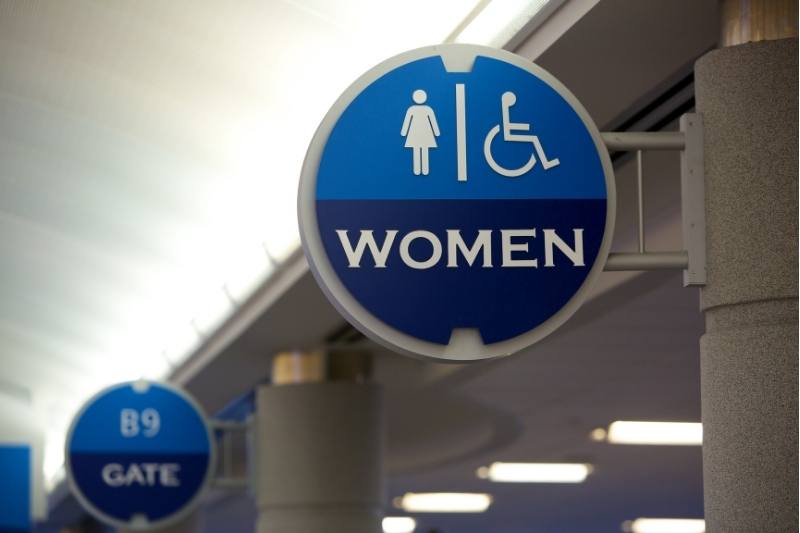
27 Bring your own headphones
Gone are the days when airlines handed out free headphones to everyone on the flight. Nowadays, unless you’re flying in first class or international travel, you need to plan to bring your own.
Some airlines have headphones for purchase, but you can’t count on that either. Of course, not all planes even have entertainment systems for you to plug into. If you’ve read the other tips for first time flyers we’ve already mentioned, you’ll know you should already plan to bring something to watch movies on anyway.
One thing to mention is that if the plane does have an entertainment system, it may have a two-pin socket. If that’s the case, you’ll need an adaptor to be able to plug your headphones in. This really only makes sense if you don’t plan on downloading your own movies to watch.
Another reason to bring your own headphones is to help with noise cancellation, especially if you’re flying at night. Something first time flyers might not realize is that the engines on airplanes can be loud. You may be seated near young children who can be loud. It’s also the universal symbol for “please don’t talk to me” if you’re sitting next to someone chatty.
Seriously, headphones are useful for more than just watching movies! Whether you pack an inexpensive pair just to get you through your first flight or want to block out all the extra noise going on around you, headphones can make flying first time much more enjoyable.

28 Pack essentials in your carry-on
Many travelers try to travel as light as possible, but there are times when we just can’t avoid checking a bag into the hold of the plane. In these circumstances, it may be tempting to put everything in the hold and to skip onto the plane light as a feather, carrying nothing at all (other than your phone and wallet, of course).
However, what if something goes wrong with your checked bag… ? Perhaps it gets delayed or lost in transit. Or perhaps you miss a connection and you can’t retrieve your bag from the baggage system while you wait for the next flight. You probably have travel insurance to cover any losses and delays, but having the losses covered financially is of limited comfort when you are separated from your personal possessions.
As evening turns to night, you realize how important basic things like toothpaste and pajamas are. And what about clean underwear and clothes the next day? Sure, you could buy new stuff, but that’s not ideal.
For this reason, it is a good idea to pack some essentials in your carry on, including a toothbrush and toothpaste, core toiletries, spare underwear, and a change of clothes – basically, the essentials you’ll want if you’re separated from your bag for a day or two.
by Martha from May Cause Wanderlust
Helpful tips for first time flying
If you’re going to be flying in a plane for the first time and are trying to prepare for what to expect, this list should cover it! Being prepared and knowing what to expect on your first flight is half the battle. Just follow the advice given here, especially if you’ll be flying alone for the first time and you’ll be just fine!
Enjoy your journey!
Karee Blunt
Karee Blunt is a nationally syndicated travel journalist, focused on discovering destinations and experiences that captivate and inspire others through her writing. She is also the founder of Our Woven Journey, a travel site focused on inspiring others to create memory-making adventures with their loved ones. Karee is passionate about encouraging others to step out of their comfort zone and live the life they dream of. She is the mother of six kids, including four through adoption, and lives with her family in the Pacific Northwest. You can learn more about Karee on her about me page.
- Karee Blunt https://ourwovenjourney.com/author/bluntpeeps/ Don't Skip These Top-Notch Attractions When You Visit Washington, D.C. With Kids
- Karee Blunt https://ourwovenjourney.com/author/bluntpeeps/ Top 20 UNESCO World Heritage Sites Everyone Should Know About
- Karee Blunt https://ourwovenjourney.com/author/bluntpeeps/ World's Most Recognizable Opera House, Plus 7 Equally as Stunning
- Karee Blunt https://ourwovenjourney.com/author/bluntpeeps/ Y2K Bug and Other Near-Disaster Events Gen Z Knows Nothing About
3 thoughts on “27 Best Tips for Flying for the First Time (2023)”
I will be traveling soon, September to be precise and this will be my first time boarding a plane, I’m kinda anxious cause I don’t know what to expect, I will be traveling from Nigeria to the Netherlands. I hope I get a smooth trip to my destination, after reading all the tips, I think I can do this
Hi Joy, how exciting that you’ll soon be taking your first flight! I truly hope you’re able to enjoy every minute of it. Try not to stress. You’re going on an adventure of a lifetime, but hopefully just the first of many more to come. 💗
Always eat food at the airport before you actually get onto the plane. There are so many cheap groundside restaurants at which you can order a meal from these days. Or merely take onboard your own free healthy snacks and things to do or stuff to read etc as well.
Consider audiobooks. You can find many different and cheap activity books located in the bookshops quite easily. Once on board the aircraft aim to spend the time flying in the air either drinking some white wine or reading/talking to the other travellers. I like to eat a dish of hot food beforehand.
Bring patience. You will need it for sure on route. Or take a shorter flight instead. Always a good idea. Research the hotels and activities at your destination carefully. Pick one that really appeals to you and also meets your needs. Good luck.
Leave a Comment Cancel reply
You must be logged in to post a comment.

First Time Flying? 35 Best Tips for First-Time Flyers
By: Author Kim Tate
Posted on Published: October 26, 2022
Taking to the skies for the first time can be a daunting experience, but with careful preparation, it doesn’t have to be. While you await your first time flying, there are some tips that you can use to help you have the best experience ever.
These tips work well for an international flight and domestic flights. This guide will help you understand all of the important things from the security checkpoint to understanding your boarding group – and everything in between.

In this article:
Best Tips for First-Time Flyers
1. check-in online.
Most airlines allow you to check in online up to 24 hours before your flight. This will help you avoid long lines at the airport and give you a better chance of avoiding a middle seat assignment. Online check-ins are the best because then you also have access to your flight number and gate number, right on your digital boarding pass.
Checking in online for your flight is a great way to save time at the airport. Simply log into the website or app for the airline you’re flying. There should be a button for you to press “check-in.” Once you press that button, you’ll be able to check in for your flight using your confirmation number and last name.
Don’t forget to arrive at the airport early so you can go through airport security and get to your gate on time. If you are checking bags, you will still need to go to the gate counters at the airport. Checking in online is a great way to make flying a breeze, so be sure to give it a try next time you travel.
2. Arrive early
Make sure to arrive at the airport at least two hours before your flight is scheduled. Whether you’re traveling for business or pleasure, it’s always a good idea to arrive early at the airport. Check-in and security lines can be unpredictable, and you don’t want to miss your flight because you were running late.
If you’re flying internationally, airlines typically ask you to arrive three hours before your flight.
Arriving early also gives you time to relax and grab a bite to eat before boarding. If you have any time to spare, you can also use it to do some last-minute shopping in airport stores.
Keep in mind that most flights start boarding about 45 minutes before the departure time. Also, know that many flights close the boarding door 10-15 minutes before the departure time.
So, next time you’re booking a flight, make sure to leave plenty of time for airport arrivals. It’ll make your journey that much smoother.
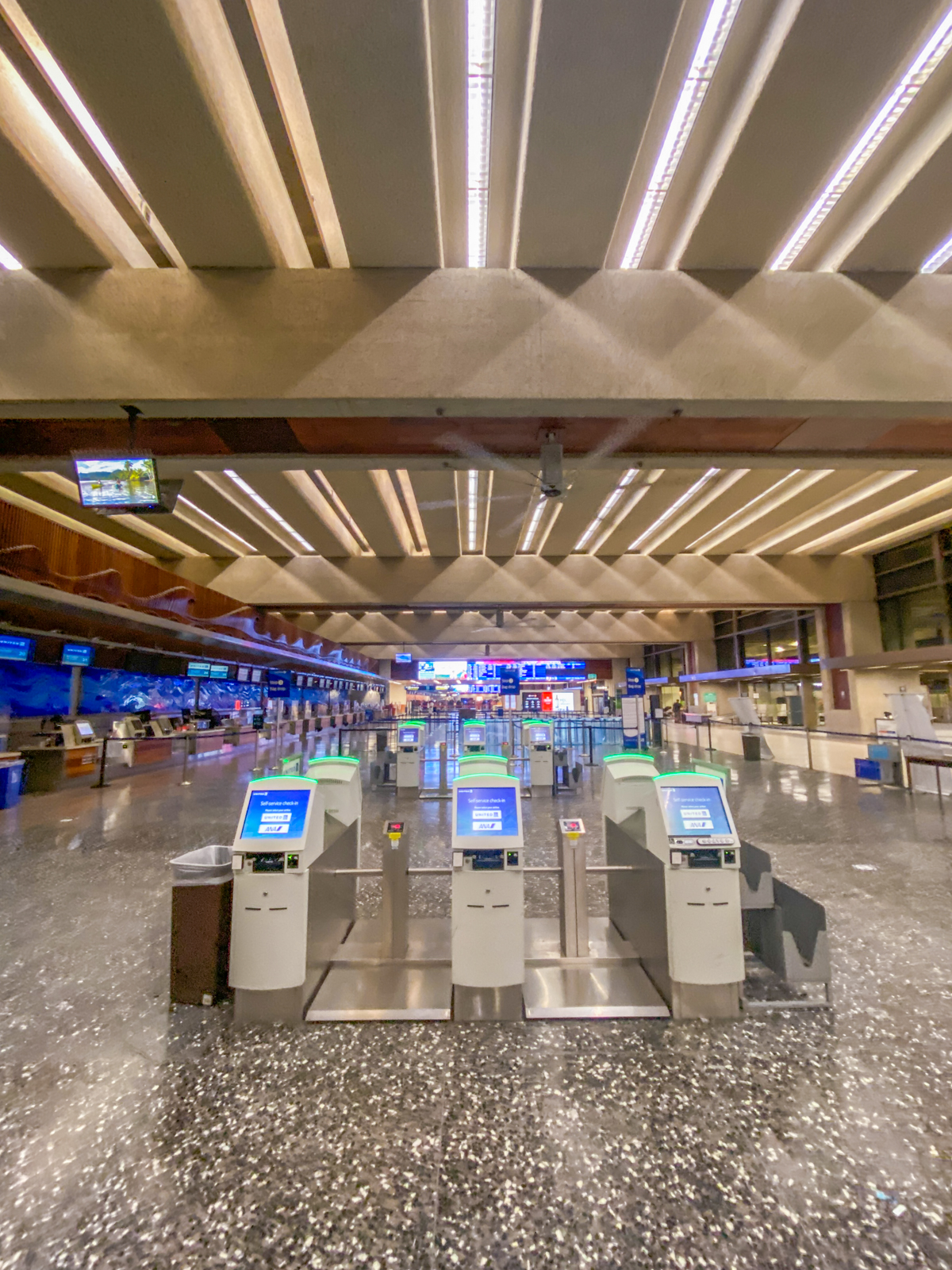
3. Get travel insurance
Even if you’re only flying for a short trip, it’s always a good idea to get travel insurance. This will protect you in case of any delays, cancellations, or losses. Some credit cards include travel insurance, but often have limitations.
Travel insurance can also cover you in case of injury or medical emergency or if you need to cancel your trip for any reason. Be sure to read the fine print of your policy so you know what’s covered.
Getting travel insurance is a great way to protect your finances while you’re on vacation. It’ll give you peace of mind in case anything goes wrong.
4. Join an airline loyalty program
If you fly frequently, it’s a good idea to join an airline loyalty program. These programs give you points for every flight you take, which you can then use to get free flights or other perks.
Some programs also allow you to upgrade your seat for free or get priority boarding. If you fly often, signing up for a loyalty program can help you save money and make flying more enjoyable.
5. Bring your own food and snacks
Airplane food can be expensive and not always the tastiest. To avoid spending money on airplane food, or going hungry on your flight, bring your own snacks and meals.
You can pack a sandwich, some fruit, or even some chips to munch on during your flight. Just be sure to check the airport’s rules about bringing food through security. Also, be mindful of life-threatening allergies and try to avoid bringing peanuts or tree nuts on flights.
Bringing your own food is a great way to save money and make sure you have something to eat during your flight.

6. Stay hydrated
It’s important to stay hydrated when you’re flying, as the air in airplanes is very dry. Be sure to drink plenty of water before, during, and after your flight.
You can also bring your own empty water bottle to fill up after you go through security. This will save you money and help you stay hydrated during your flight.
7. Dress comfortably
When choosing what to wear on your flight , comfort should be your number one priority. You’ll be sitting in a confined space for hours, so you want to make sure you’re wearing clothes that won’t make you uncomfortable.
Avoid wearing anything constricting, like jeans or a tight top. Instead, opt for loose-fitting clothing made from breathable fabrics. I typically wear aerie leggings with a side pocket or prAna hiking pants. I also bring a hoodie or cardigan in case the airport or plane is cold.
Dressing comfortably is key to having a pleasant flight. Be sure to wear clothes that won’t make you feel uncomfortable during your journey.
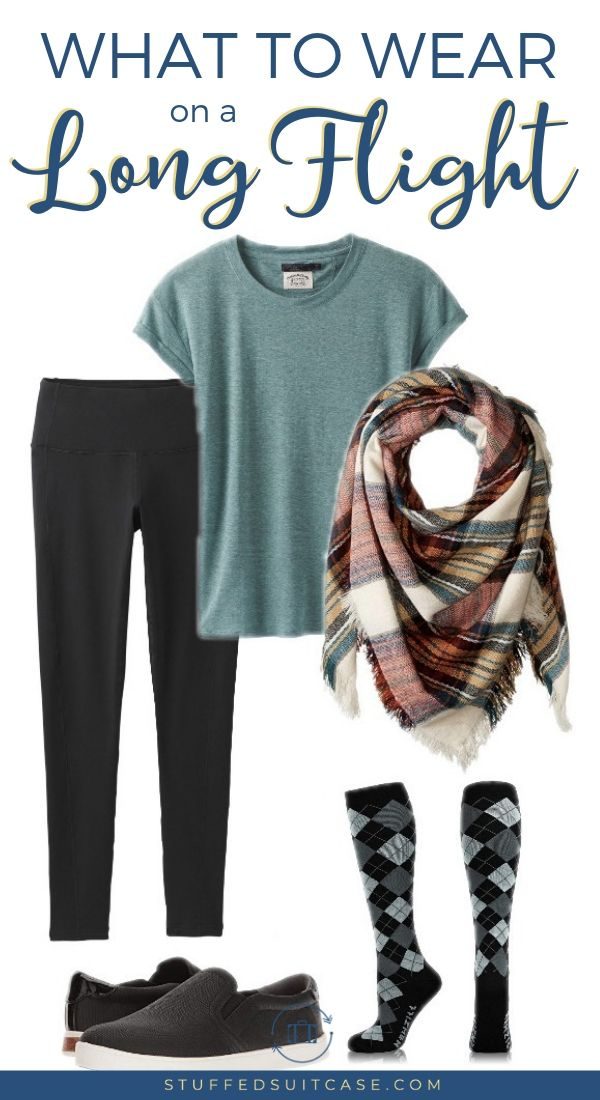
8. Bring a neck pillow
If you want to get some sleep on your flight, be sure to bring a travel pillow . This will help you stay comfortable and avoid pain in your neck and back.
There are a variety of different neck pillows to choose from, so be sure to find one that’s comfortable for you. You can also use it on long car rides or train journeys.
9. Use noise-canceling headphones
If you want to block out the noise on your flight, be sure to bring noise-canceling headphones. These headphones will help you sleep or concentrate, and they’ll make your flight more enjoyable.
Noise-canceling headphones are also great for blocking out crying babies or chatty seatmates. Be sure to pack a pair in your carry-on bag so you can use them on your flight.
10. Bring a good book or movie
To make your flight more enjoyable, be sure to bring a good book or movie. This will help you pass the time and make your flight go by faster.
If you get motion sickness, it’s also a good idea to bring a movie to watch. Watching a film can help distract you from the motion of the plane and make you less likely to feel sick. Of course, pack some motion sickness meds like Dramamine and ginger candies.

What NOT to Do Your First Time Flying
First-time flyers have a lot to learn – and there are plenty of potential mistakes that can be made along the way. To help you avoid some of the most common pitfalls, we’ve compiled a list of things NOT to do as a first-time flyer. For the most part, these are general rules of thumb for any airline. However, it’s always a good rule to look at the airline’s website to see what they have as acceptable and not acceptable, rule-wise.
1. Don’t forget to pack your carry-on essentials
This seems like a no-brainer, but you’d be surprised how many people forget to pack important items like their passport or medications. Make a list of must-have items before you start packing, and double-check that everything is in your bag before you leave for the airport.
2. Don’t overpack your carry-on bag
While it’s important to make sure you have everything you need, there’s no need to pack your entire wardrobe into your carry-on bag. Not only will this make it difficult to lug around the airport, but it could also get you stopped at security if your bag is too heavy or overstuffed.
3. Don’t wear bulky clothes or shoes
Again, security is a consideration here – you’ll want to avoid anything that will slow you down when going through the metal detectors. In addition, bulky clothing can be uncomfortable on a long flight, so it’s best to stick with more comfortable, form-fitting options.
4. Don’t forget to pack your headphones
If you want to watch in-flight entertainment or just drown out the sound of other passengers, you’ll need a good pair of headphones. Make sure to pack them so they’re easily accessible in your carry-on bag or at your seat.
5. Don’t wait until the last minute to book your flight
This one can be a real budget-buster – airlines typically release their cheapest seats well in advance, so waiting until the last minute to book is almost always going to cost you more. If you have flexibility in your travel dates, try to book your flight at least a few weeks in advance.
You also risk limited seat options when you book too late, and no one wants to pay hundreds of dollars to find themselves stuck with only having middle seats available.
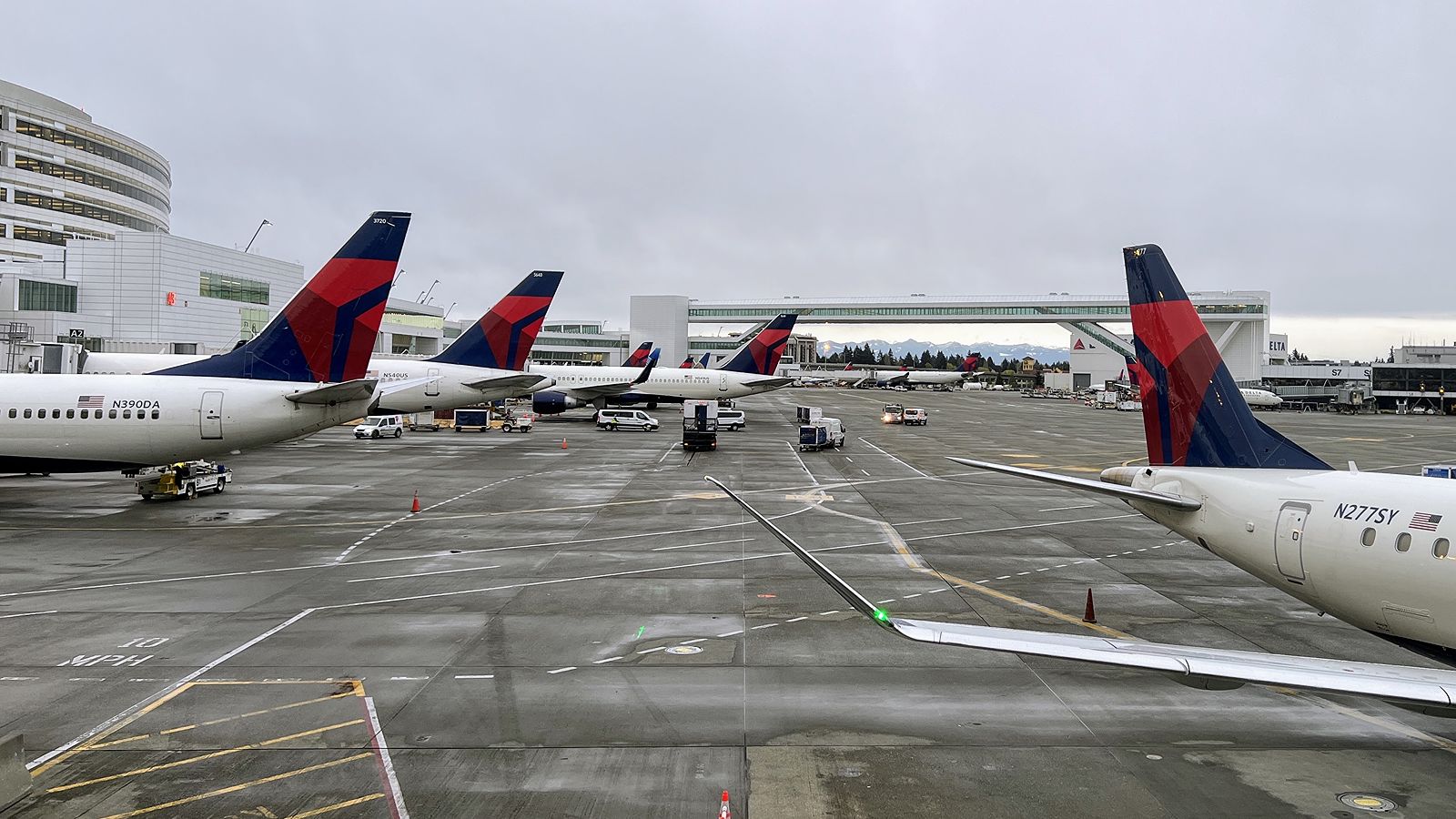
6. Don’t neglect to research your destination
Before you book your flight, take some time to research your destination and find out what there is to see and do. This will help you plan your trip and make the most of your time once you arrive.
7. Don’t skip the pre-flight safety briefing
Yes, it can be tedious to sit through another safety demonstration, but it’s important to pay attention in case of an emergency, especially for first-time flyers!
Plus, the safety briefing is your chance to find out where the exits are located – something that could come in handy if you ever need to evacuate the plane. It also helps you know the airline rules.
8. Bring something to keep your busy
Bring some books, magazines, crosswords, or whatever else you need to keep your mind occupied during the flight. Also, check to see how you can watch movies if that’s of interest. Some airlines have seatback screens, while others tell you to bring your own screen (i.e. phone or tablet) and download an app in advance to watch movies or tv shows.
Make sure you have easy access to these items, too. Your seat belt sign may be turned on and you won’t be able to access your upper bin carry-on bag, so keeping your entertainment items in a personal item bag at your feet can come in handy.
9. Don’t forget your travel documents
This one is essential – without your passport or other required travel documents, you won’t be able to get on the plane. Make sure you have everything you need before you leave for the airport and keep your documents handy to present them at security or during boarding.
Take note that if you’re flying domestically (in the USA) you don’t need a passport, but you will need an authorized government ID, like a driver’s license. Starting in May 2023, your state’s ID will need to be REAL ID compliant in order to be used to fly.
10. Don’t dress inappropriately
There’s no need to break out your best clothes for a flight, but it’s important to dress comfortably and avoid anything that could be considered offensive or inappropriate. In general, it’s best to err on the side of caution when choosing your travel outfit. Airlines have the right to refuse you boarding if your clothing is harmful or inappropriate.
Following these simple tips will help you avoid some of the most common mistakes that first-time flyers make. With a little preparation and planning, you can make your first flight an enjoyable and stress-free experience.
Tips for First-Time Flyers At the Airport

As you walk into the airport, you may be trying to understand how everything works. This section will give tips for first-time flyers at the airport. These tips will cover how to not get stressed, when you should board the plane, and everything in between.
Try not to get stressed out by security
It’s normal to feel a little anxious when going through security, but remember that everyone is just trying to do their job. Just relax and follow the instructions of the TSA agents. Keep in mind that you should move quickly and try not to get irritated at a TSA agent asking you to do something, it’s just a part of their job.
If it’s your first time flying, you likely don’t have any special security clearance like TSA PreCheck, so be prepared to remove your toiletries bag, your laptop, as well as coats, belts, and shoes. Also know that security checks can be random, so if an alert goes off and you’re moved for a secondary screening, just stay calm and follow the directions.
The security line could be considered the most stressful part of the trip, but the only way to get through it is to stay calm and allow plenty of time before your flight.
Don’t leave your bags unattended
This seems like common sense, but you’d be surprised at how many people do this. Unattended bags are a major security risk and will likely be confiscated by security. So, make sure to keep an eye on your belongings at all times. This is without a doubt a universal rule in airports. Don’t leave your bags unattended.
Double-check the weight and size of your luggage
This will save you a lot of hassle at the airport. Before you start packing, check for the size restrictions for carry-on and checked baggage for your airline. This will help you avoid any problems at the ticket counter, security, or the gate.
Make sure to weigh your bags before you go to the airport and know in advance what the fees are for checking luggage, so you’re not surprised at the check-in counter.
Don’t drink too much at the airport
You’re probably excited for your vacation and want to start relaxing as soon as possible, but it’s important not to drink too much at the airport. Alcohol can dehydrate you and make it more difficult to adjust to the time change. So, try to limit yourself to one or two drinks.
Airlines can also stop you from boarding if you’re too intoxicated. A first-time flyer should also try not to drink too much since they’ll want to be alert for the new experience and any decisions they need to make.
Grab some food before you get on the plane
If you’re flying during mealtime, make sure to grab something to eat before you get on the plane. Airplane food can be expensive and not very good. So, it’s always a good idea to have a little something in your stomach before you board.
Keep in mind that if you’re bringing any food or snacks on the plane, it’s considerate to try and avoid any strong-smelling foods that will make the plane smell.
Listen for your zone to be called
When it’s time to board the plane, they will usually call out the different zones in order. Listen for your zone to be called and then make your way to the line. Your boarding group should be marked on your boarding pass, but if you’re not sure what zone you’re in, just ask one of the gate agents.
If you want to enjoy dining and shopping at the airport before your flight, that’s fine. Just know that a general rule of thumb is to get to the gate at least 10 minutes before the plane’s boarding time. That’s BOARDING time, not flight time. Boarding time is typically around 30-45 minutes before your flight time and many airlines close the boarding gate door 10-15 minutes before the flight time.

Have your boarding pass and ID ready
This will help the process go much smoother. When you get to the front of the line, have your boarding pass and ID out so that the agent can easily scan it. If you’re fumbling around for your things, it will just hold up the line.
First-Time Flying Tips for Getting Off the Plane
Now that you’ve made it through your first flight, it’s time to get off the plane. Here are some tips for making a smooth exit:
Listen to the flight attendants
They will give you specific instructions on when and how to disembark from the aircraft. It’s important to listen to them because that’s what will get you off the plane the fastest! Always be respectful to your cabin crew, I like to always thank them when deplaning.
There will be a lot of people trying to get off the plane at the same time as you. Be patient and wait your turn. There’s no need to rush! Also, if you’re in the back, you are going to be waiting a while to get off the plane. While you may be anxious to stand up, you shouldn’t be in a big hurry because everyone else is in the same big hurry – which means everyone will be moving slowly.
Call your ride
When you land, it’s a good idea to check in with anyone who might be meeting you. This way, they will know that you’ve landed and approximately when to expect you.
Have your carry-on ready
If you have a carry-on bag, make sure it’s easily accessible so you can grab it and go as soon as it’s your turn to leave the plane. There’s nothing worse than having to dig around to find your bag when you’re trying to make a quick exit!

Follow the crowd BUT read signs
When you’re getting off the plane, it’s easy to follow the crowd. Many of them might know where they’re going and they’ll lead you to the right place. But, the best thing to do is to look for signs.
If you checked a bag, you’ll want to look for baggage claim signs. If you don’t need to go to baggage claim, you’ll likely head towards that area anyway and look for signs for ground transportation.
Hopefully, these tips will help you while you’re getting off the plane! It can be hard as a first-time flyer to know exactly what to do, but these tips will help you tremendously!
Etiquette Tips for Flying on a Plane
When you fly on a plane, there are certain etiquette rules that you should follow in order to make the experience more enjoyable for everyone. Here are some tips to keep in mind:
- Be respectful of other passengers and try not to disturb them. This includes keeping your voice down, not playing music or watching videos without headphones, and being mindful of personal space.
- Follow the rules and regulations of the airline and airport. This includes things like not bringing prohibited items on the plane and following security procedures.
- Be considerate of the crew members and listen to their instructions. This includes staying seated during turbulence and putting away carry-on luggage during takeoff and landing.
- Try to be patient and understanding if there are any delays or other problems.
- The person next to you may or may not want to have a conversation with you. It’s okay to say hi and strike up a conversation if the other person seems receptive, but don’t force it if they’re not interested.
- Pay attention to the seatbelt sign. It’s there for a reason, and it’s important to follow the crew’s instructions for when to buckle up.
- Be mindful of your personal hygiene. This includes things like using deodorant, brushing your teeth, and wearing fresh clothes. It’s also considerate to not wear perfumes or colognes when flying as some people are sensitive to scents.
- If you have food or drinks, be careful not to spill them on yourself or other passengers. Also, try not to pack allergens like nuts, and avoid strong-smelling foods.
- Try to keep your belongings organized and tidy, so that you’re not taking up more space than necessary or causing a mess.
- Make sure you have your credit card handy, so you don’t have to dig for it when the snack cart rolls through.
Following these etiquette tips will help to make your flying experience more pleasant for everyone involved.
Tips for Sitting in the Small Seats on the Airplane
Sitting in a small seat on an airplane can be quite uncomfortable, especially if you are tall or have long legs. Here are some tips to make the experience more bearable:
- Wear comfortable clothing that won’t restrict your movement. Read my post on what to wear on a long flight .
- Try to book an aisle seat so you can stretch your legs out into the aisle. But, don’t leave them there. People need to walk through the aisle and your feet don’t belong there.
- Another option is to book a window seat if you enjoy leaning and want to sleep as the wall of the plane makes that more comfortable than aisle seats.
- Pack some carry-on essentials to keep you comfortable and entertained.
- Pack light so you don’t have to struggle with heavy luggage in a small space.
- Bring a neck pillow and blanket to make yourself more comfortable.
- Avoid eating or drinking too much before your flight to avoid having to use the restroom frequently.
- Get up and walk around the cabin every few hours to keep your blood flowing.
- Wear compression socks to help prevent blood clots.
- Stay hydrated by drinking plenty of water during the flight.
- Protect yourself from germs by using hand sanitizer and avoiding touching surfaces in the cabin.
- Long-haul flights can be uncomfortable, so make sure you get up to use the bathroom, so you can stretch!
By following these tips, you can make sitting in a small seat on an airplane more bearable and even somewhat enjoyable. After all, it’s only for a few hours and then you’ll be at your destination!
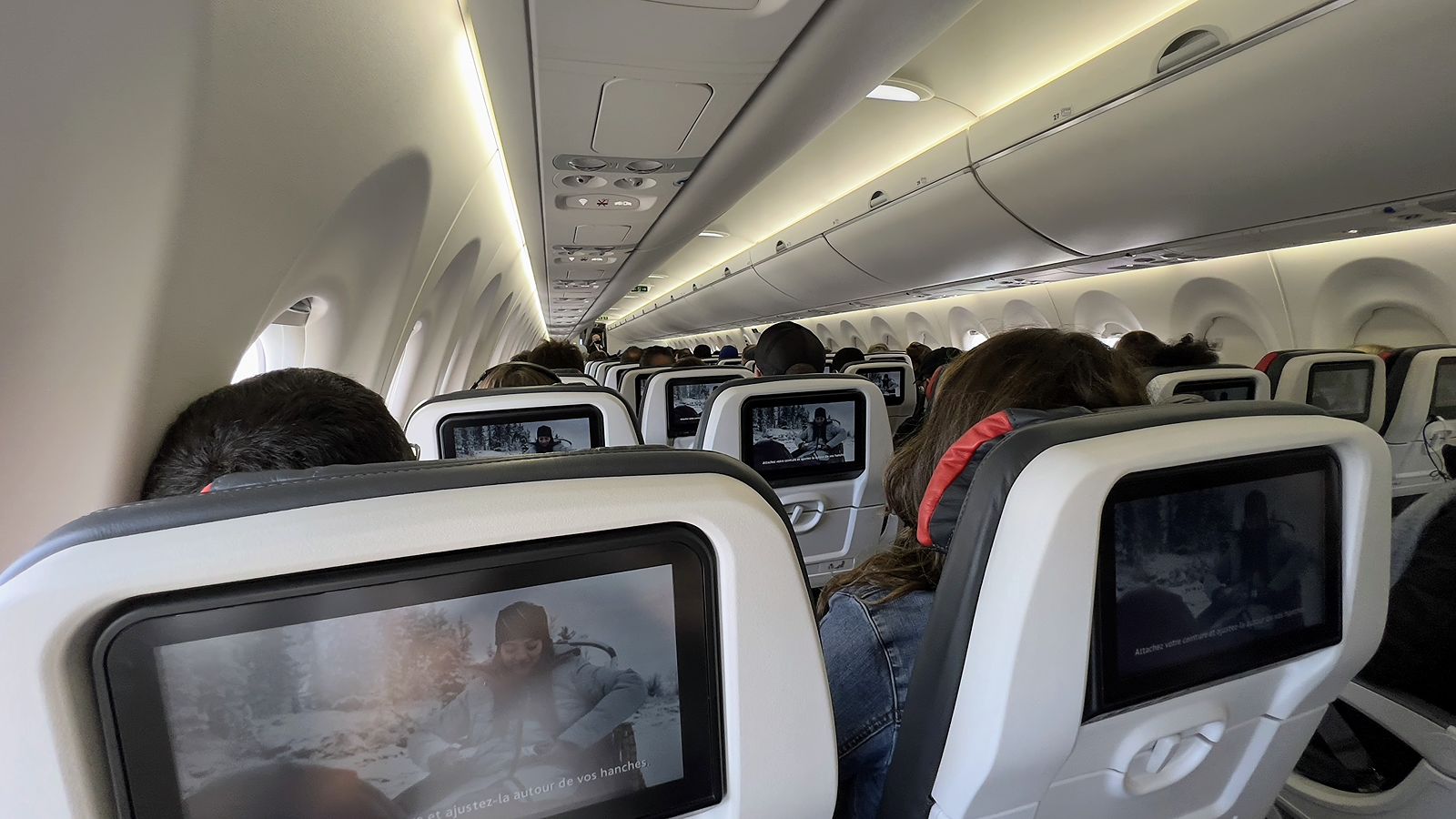
Tips for First-Time Flying Anxiety
- Air travel is the safest mode of transportation and becoming safer. It’s more dangerous to drive or run along a street. A NY Times article quoted an MIT professor who studied air travel and he determined that “ flying has become so reliable that a traveler could fly every day for an average of 123,000 years before being in a fatal crash. ”
- Develop and learn some stress-coping techniques. Meditation, body relaxation, and calming music can help you relax and combat the anxiety you might feel about flying. If your anxiety is really bad, you can talk with a physician about prescribing you medicine to help you calm down.
- Keep busy. Load up your phone or tablet with some shows or movies you want to watch or love. Or download some great books that will hold your interest. If you have something else to focus on, it can help keep you from focusing on your fear.
- Look to the flight attendants; they fly all of the time. Seeing them at ease and going about their work as if they’re on the ground instead of the air can help put you at ease. They’re also the ones to listen to in order to stay safe. If I do have turbulence or worry, seeing them at ease always helps make me realize that everything is operating as normal.
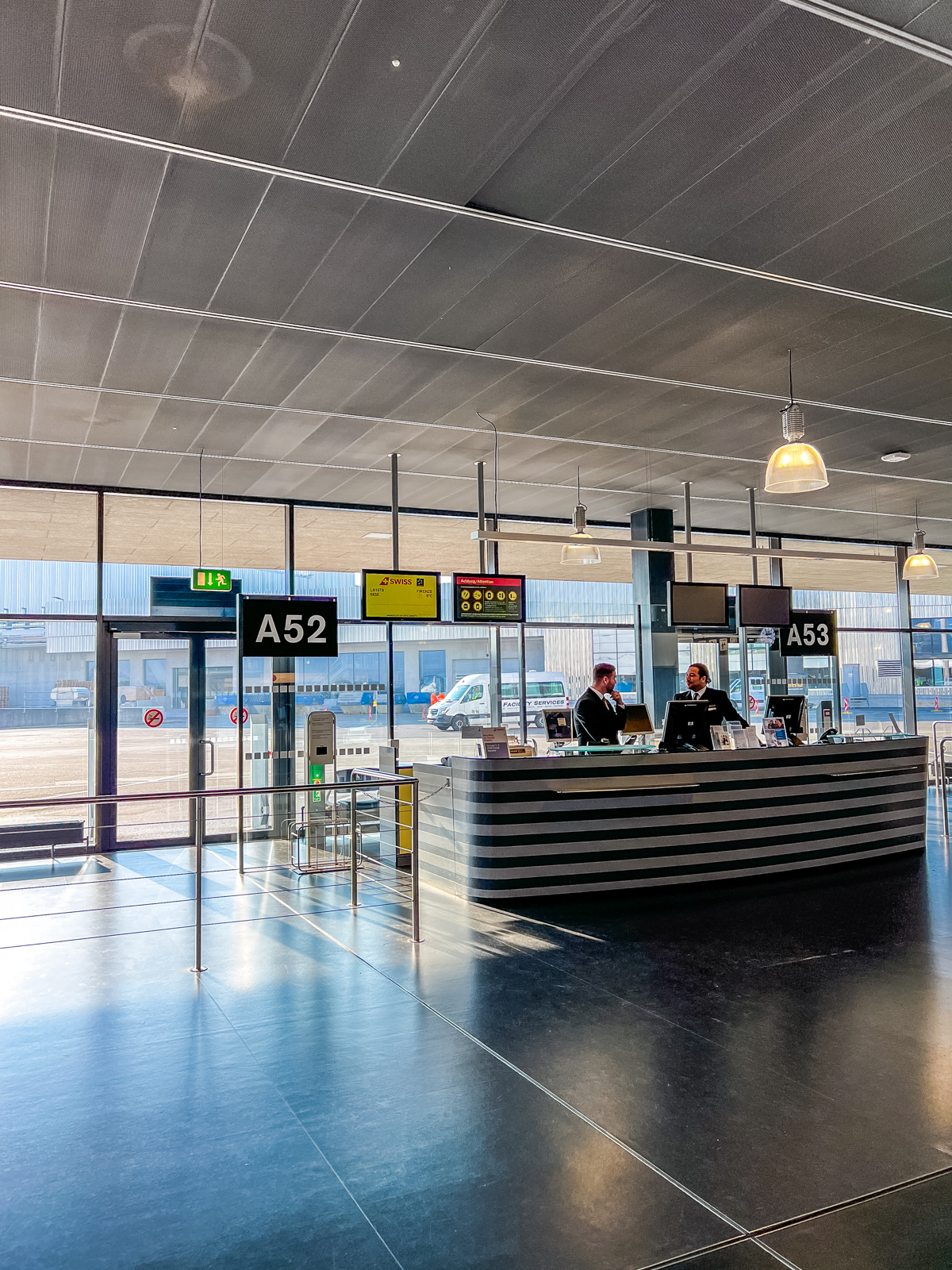
FAQs for Your First Time Flying on a Plane
Flying on a plane can be a nerve-wracking experience, especially if it’s your first time flying. But there’s no need to worry – we’ve got you covered with everything you need to know about flying, from the basics of booking a ticket to what to expect during your flight.
What are the different types of aircraft?
The most common type of aircraft is the single-aisle plane, which has one aisle running down the middle of the cabin. These planes are used for short and medium-haul flights.
The next most common type is the wide-body plane, which has two aisles running down the middle of the cabin. These are used for long-haul flights. Most planes are made by Boeing or Airbus.
What are the different classes on a plane?
There are three main classes on a plane: first class, business class, and economy class. First class is the most expensive and has the most amenities, while economy class is the least expensive and has the least amenities. Business class is in between these two extremes, but closer to a first-class experience.
Many airlines have started adding a premium or comfort class to their economy cabin. These seats often have a bit more legroom, but may just include pre-boarding.
What is the difference between a non-stop flight and a connecting flight?
A non-stop flight is a direct flight from one airport to another, while a connecting flight stops at one or multiple airports along the way. Connecting flights could be cheaper than non-stop flights, but they take longer and delays may affect your plans.
There are some cases where a flight is called a direct flight but it’s not non-stop. Direct flights don’t involve changing planes or a different flight number, however, they may involve a stop at another airport to
How do I book a flight?
You can book a flight online, through a travel agent, or by calling the airline directly. When booking online, you’ll need to provide your personal information and payment details. When booking through a travel agent, they will take care of everything for you. When calling the airline, you’ll need to provide your personal information and flight details, and many airlines charge a fee for phone bookings.
Booking online directly with the airline is typically the best option for pricing and cancellation. Although, you can shop for flight options online with various travel sites and google.com/flights.
What do I need to bring with me to the airport?
When flying, you’ll need to bring your passport, boarding pass, and any other required documents. You’ll also want to pack light, as you’ll have to carry your luggage with you through the airport. Most airlines have a limit of 50lbs per bag, so be sure to check the weight and size restrictions before packing.
What can I expect during the security screening process?
All passengers are required to go through a security screening before boarding their flight. This usually involves going through a metal detector and having your bags scanned by an x-ray machine. You may also be selected for a random pat-down search.
What should I do if I’m selected for a secondary screening?
If you’re selected for a secondary screening, you’ll be taken to a private area for a more thorough search. This may involve having your bags searched by hand and being asked to remove your shoes and jacket.
What can I expect during the boarding process?
When it’s time to board your flight, you’ll need to have your boarding pass and passport ready. You’ll be asked to show these documents to the gate agent, who will then scan your boarding pass and allow you to board the plane. Once on the plane, you’ll find your seat and stow your carry-on luggage in the overhead bin.
What can I expect during the flight?
Once the plane takes off, you’ll be able to sit back and relax. The flight attendants will come around with drinks and snacks, and you can watch a movie or TV show on the in-flight entertainment system. If you need anything during the flight, just ask one of the flight attendants. They’re there to help!
What should I do if I have a problem during the flight?
If you have any problems during the flight, such as lost luggage or an issue with your seat, just ask one of the flight attendants for help. They will be able to assist you and solve the problem.
What should I do when the plane lands?
When the plane lands, you’ll need to gather your belongings and disembark the plane. If you have any checked luggage, it will be waiting for you at the baggage claim area. From there, you’ll be on your way to your final destination!
These tips for first time flyers are important. If you don’t know what to do when you fly for the first time, this guide will help you out. Once you fly on a plane for the first time, you will be good to go after that! With a little experience, you will become less and less stressed about any flight that you take!
The only thing left to pay attention to when you’re a first-time flyer is yourself. Flying can be the best thing because you get extra time to relax and enough time to finally finish that book you’ve been wanting to read.
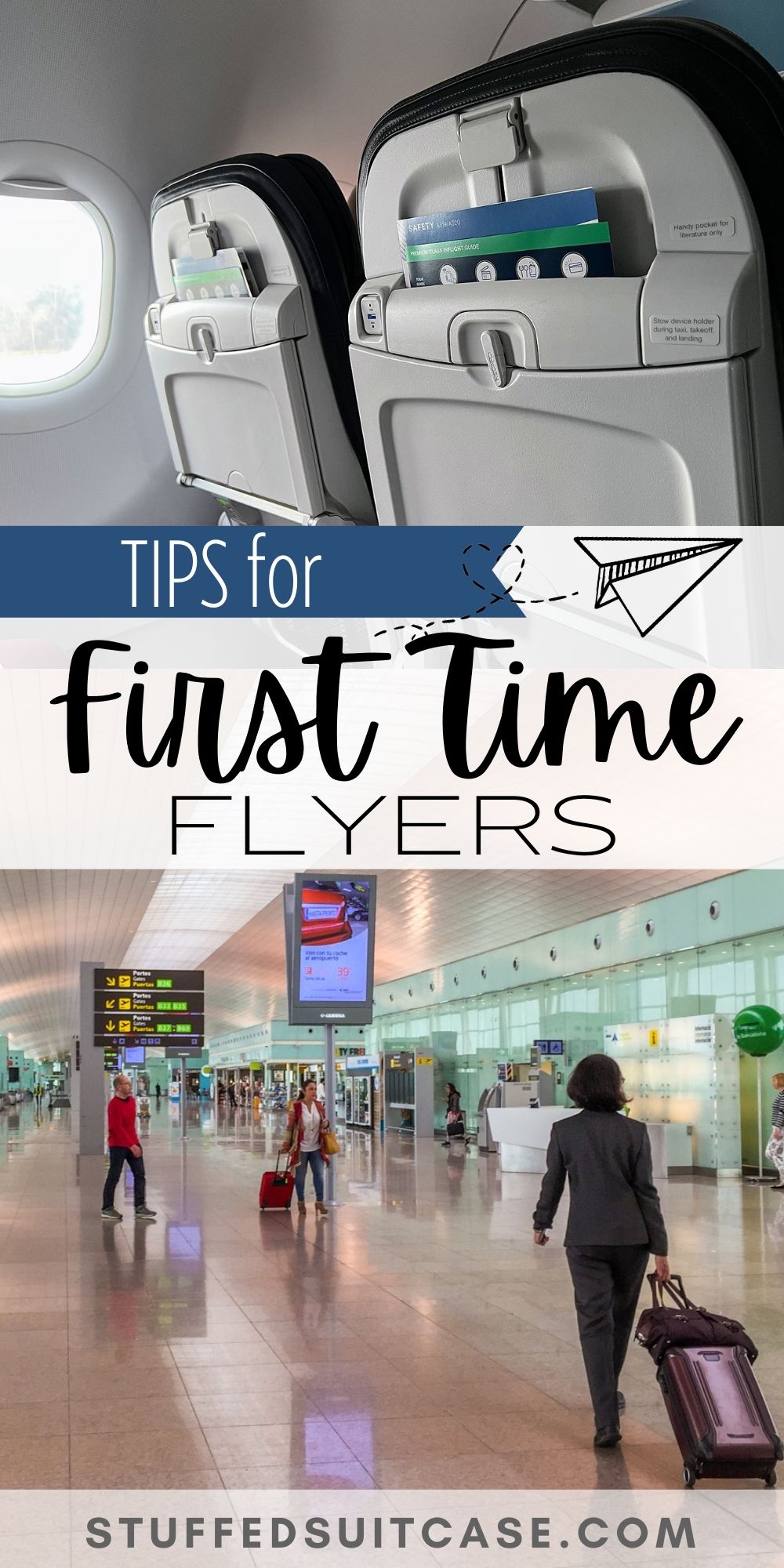
Share and Save This Post:
Friday 26th of May 2023
These are my tips for success. Plan your entire trip carefully. Try to make some brief summary notes. Best of luck. If you can do so, please do check in online. Be kind and friendly too. I love your blog as well.
Smile at folks. It is a good idea to eat dinner at the airport. Give way to people who may be in a rush. Know the general layout of the airport. Also pay very careful attention to security rules. In other simple words it is wise to be totally smart. You can do this.
Never rush. Have fun. An airport does not have to be a scary place. Far from it in fact. Remember that always. Request assistance if that makes you feel better. Stay calm and positive. Arrive early. Recommended at all times.
Beat the long queues. Last week I was at the airport nearest my home. I got there much earlier. Straight after passing security I decided to eat. So I had a meal before going to board. It was really worth it. I ordered fish and chips. Then I did shopping in the airport. Finally I boarded.
Bring puzzles. Pack a entire suitcase in advance. Call the airport ahead of time to help yourself. Inform them you require extra time to get onto the plane in question. I took a bag full of books this time in case. I read them in the departure area of the airport.
Read beyond the lines. I was equipped with hand gel and my water bottle.

31 First Time Flying Tips: Your Guide to a Stress-Free Flight [2024]
- Updated January 28, 2024
- Posted in Travel Planning
- Tagged as Airplane Travel , Travel Organization
Welcome! If you’re about to embark on your first-ever flight, congratulations! Air travel can be an exciting and rewarding experience, opening up a world of new possibilities.
It’s natural, however, to feel a little anxious or uncertain, especially if you’re unfamiliar with the ins and outs of flying.
In this comprehensive guide, we’ve gathered 31 invaluable first time flying tips to help make your journey as smooth, stress-free, and enjoyable as possible!
Some of the links in this post are affiliate links , which just means I earn a small commission at no extra cost to you!
Table of Contents
Planning Tips
Airport tips, money saving tips, entertainment tips, relaxation tips, our first time flying tips, 1. pack light.
We recommend weighing your checked luggage before leaving the house. Most airlines charge for any type of checked bag , and some airlines even charge for carry-on luggage.
It’s best to head over to the airline’s specific website to check the weight and size restrictions. When checking luggage, it’s very important to make sure you don’t exceed the weight restriction.
- Weigh your bag at home (or even while on vacation) using a luggage scale ( we prefer digital )!!
- Tip: If your bag exceeds the weight limit, redistribute some of the items between your checked and carry-on luggage.
2. Check the TSA Guidelines
- Check the Transportation Security Administration (TSA) guidelines for what is allowed in your carry-on luggage.
- Know what you can check vs carry on the airplane
- Pack your carry-on with extra clothing, toiletries, and medications (in case luggage is lost)
- Know the liquid restrictions: all liquids must be packaged in a 3.4oz container inside a quart-sized bag.
Knowing the TSA guidelines will save you time and prevent any unnecessary hold-ups at security.
3. Avoid Black Luggage
We’ve found that more colorful bags are, not only unique, but easier to recognize and keep track of in the airport.
For bags that you plan on checking, traveling is much simpler when your bags aren’t easily confused with other similar looking luggage. And most checked bags, from our experience, seem to be a darker color.
Don’t own colorful luggage? There are some ways to make your black bag stand out!
- Try using a brightly colored luggage strap
- Tie a colored ribbon to the handle
4. Choose Your Seat Wisely
If you choose the wrong seat, your flight may not be as enjoyable. Deciding on a seat where you can catch beautiful scenic views or one where you can stretch your legs can have a huge impact on your trip.
- For a short flight: choose the window seat for the views!
- For a longer flight: choose an aisle seat for that extra leg room!
5. Research Your Airline’s Policies
Every airline has their own set of rules and policies regarding baggage fees, flight changes, and cancellations. Become familiar with these so you aren’t surprised at the airport by any unexpected expenses.
Here are some things (not an exhaustive list) that you can research beforehand:
- Baggage Allowance (Number of bags, size restrictions, baggage fees)
- Check-in options
- Boarding zones/processes
- Security guidelines by TSA
- Complimentary services provided by airline (meals, entertainment, Wi-Fi)
6. Consider Wearing Compression Socks
Compression socks are designed to improve circulation and reduce the risk of blood clots. This is done by applying gradual pressure to your legs and helping to move blood back up to your heart.
During a flight, the reduced air pressure and limited mobility can cause blood to pool in your legs, leading to swelling and discomfort. I’ve found that wearing compression socks (particularly on longer flights > 5 hours) makes a big difference in how my legs feel.
You most likely can find the compression socks you need online or at your local pharmacy. If you have any circulatory disorder, however, we recommend consulting with your doctor first!
7. Pack Valuables/Essentials in Carry-On Luggage
We always keep our passport, ID, travel documents, medicine, electronics, an extra pair of clothes, and any valuable items in our carry-on.
In case our checked baggage gets lost or delayed (which rarely happens, but you never know), having these essentials with us means we can still carry on without much hassle.
It’ll make your trip much more enjoyable!
8. Keep Your Passport, ID, and Boarding Pass Readily Accessible
It’s really important to keep your passport, ID, and boarding pass readily accessible to ensure a smooth check-in process .
Having these documents close by also allows for a quick response to unexpected situations and easy proof of identity and travel authorization .
I found these super cute passport holders that I carry with us whenever we travel! I love how they have a place to hold our COVID-19 vaccinations card as well.
9. Keep Track of Lost Luggage
Consider investing in an AirTag if loosing luggage is a fear of yours.
What is an AirTag?
- Small tracking device developed by Apple that you can attach to your luggage to keep track of its location
- The Find My app on your iPhone or iPad can be used to locate the AirTag on your luggage
- Lost Mode can be enabled in the Find My app, allowing you to see the last known location of your AirTag on a map and receive alerts when its location is updated
- If your lost luggage with AirTag is found, the AirTag can be scanned with an iPhone or NFC-enabled device to view your contact information
10. Arrive Early
If it’s your first time flying, arriving early at the airport can help reduce any stress and anxiety. Unexpected delays, like long lines for check-in or security, can occur, so it’s wise to give yourself extra time to handle them without worrying about missing your flight.
- Arrive at least 1-2 hours before your scheduled departure time for domestic flights.
- Arrive 3 hours before your scheduled departure time for international flights.
- Airlines start boarding about 30 minutes before departure.
By arriving early, you’ll give yourself enough time to navigate the airport, find your gate, and get settled before boarding begins.
11. Check in Online
Checking in online before your first flight can help make the check-in process at the airport smoother and less stressful. When you check in online, you can usually select your seat and print your boarding pass ahead of time , which can save you time and hassle at the airport.
Typically, you can check in starting 24 hours before boarding time. Go to the specific airline’s website and follow the prompts. It will guide you through the process! To save time, check in online!
If you choose to check in online, you should still be early for your flight. You don’t want to risk missing your departure time!
12. Use the Restroom before Boarding
We strongly recommend that you use the restroom prior to boarding.
This is something that we do before all flights, even if we don’t have to go to the bathroom at that time. Since you’re going to want to stay hydrated on your flight, using the bathroom prior to boarding may help lessen the number of times you have to go in flight.
If your flight is short, you may be in luck and not even have to use the plane’s restroom.
If you do need to go on board, you won’t be able to use the restroom immediately. You’ll have to wait until the plane has taken off, leveled off, and the pilot has turned of the seat belt sign.
13. Sign Up For Frequent Flyer Programs
Signing up for frequent flyer programs is a great idea, especially since it’s usually a free perk!
Frequent Flyer Program Perks:
- Earn points or miles for flights and redeem them for free travel or upgrades
- Priority services
- Access to airport lounges
- Special promotions
If you’re a loyal customer, you can quickly earn points or miles towards your next flight. If you tend to price shop, it’ll take a bit longer to redeem points for any travel upgrades.
14. Book Flights in Advance
The earlier you book your flights, the cheaper they tend to be. We also like to book our trips earlier so we can secure our preferred travel dates and destinations.
While we book our trips over a year in advance, we recommend booking any domestic flight 2-3 months in advance and any international trips 6 months in advance to get the best deals.
15. Use Price Comparison Websites
When we’re looking for the best deals on flights, hotels, and other travel services, we find using price comparison websites extremely helpful.
These websites gather information from different airlines, hotels, and travel agencies, making it easy for us to compare prices and find the most affordable options . It saves us a lot of time and effort , as we can quickly see the prices from multiple sources all in one place!
They also offer additional features like flexible date searches and fare alerts , which are really useful when we’re trying to find the best deals.
Price Comparison Websites To Try:
16. Fly Budget Airlines
Opting to fly with budget airlines, such as JetBlue, Southwest, or Spirit Airlines can be a smart choice if you’re looking to save money.
- More affordable ticket prices
- Customizable ticket options
- Fewer in-flight amenities
- Reduced legroom
- Stricter baggage allowance
- Additional fees may apply for services like seat selection or checked baggage
For short flights, flying budget airlines may be a good choice . For longer trips, you may want to opt for an airline that offers some more amenities and better leg room.
17. Pack Snacks
Bringing your own snacks on board a plane can help you save money, ensure that you have access to food that you like, and make your flight more comfortable and enjoyable.
Depending on the airline and the length of your flight, options for in-flight meals and snacks can be limited . Airline food is also not the healthiest . The food can be high in salt, sugar, and preservatives.
Lastly, food in the airport and in-flight can be pricey . If you’re looking for a budget-friendly travel tip, we recommend packing your own snacks and not purchasing the over priced airport food.
In-flight Snack Options:
- Granola bars
- Dried fruit
- Food without nuts (Passengers on-board may have a nut allergy)
18. Use a Travel Rewards Credit Card
When you use a travel rewards credit card for your flight purchases, you can e arn points, miles, or cash back that can be redeemed for various travel-related expenses . By using the card for everyday expenses and paying off the balance in full each month, you can accumulate rewards quickly.
Before choosing a travel rewards credit card, compare the available options and consider factors such as annual fees, interest rates, rewards programs, and any additional perks offered.
Look for cards that align with your travel preferences and offer rewards that are valuable to you.
19. Use Points to Pay for Your Flight
Many airlines and credit card companies offer reward programs that allow you to accumulate points or miles based on your spending or travel activities. These points can then be redeemed to cover the cost of your flight.
Before booking your flight, check if you have any accumulated points or miles that can be used towards the ticket price . Most airlines have loyalty programs that offer various benefits, including the ability to use points for flights. You can also explore credit cards that offer travel rewards and sign-up bonuses, which can help you earn points more quickly.
Using points to pay for your flight can save you a significant amount of money , especially if you’ve been accumulating points over time.
20. Bring a Book or E-Reader
Bringing a book or e-reader on your flight is a good way to keep yourself entertained and makes time go by faster. It’s also a great way to take your mind off of any nervousness you might feel about flying.
If you forget your favorite novel, you can probably buy a magazine or book from one of the shops in the airport (unless you’re flying at odd hours) .
If you’re looking to save money, bringing your own book is the way to go!
21. Download Movies and/or TV Shows Before Your Flight
Many airlines offer in-flight entertainment, but it’s always a good idea to have backup entertainment options.
Before your trip, use streaming platforms like Netflix , Amazon Prime Video , or Disney+ to download your favorite movies or TV shows onto your device. This way, you won’t have to rely on an internet connection or the in-flight entertainment system to enjoy your preferred content.
Remember to charge your device fully before the flight and bring any necessary chargers or power banks to keep your device powered throughout the journey!
22. Listen to Music or Podcasts
Before your flight, create a playlist of your favorite songs or podcasts that you’ve been wanting to listen to. Music can be uplifting and help relax your mind, while podcasts can be informative or entertaining.
Using your own headphones , you can escape into the world of music or immerse yourself in interesting podcast episodes.
It’s a great way to engage yourself during the flight and distract from any nervousness or anxiety you may have about flying.
23. Bring Your Own Headphones
Most airlines provide headphones for in-flight entertainment, but they may not be the most comfortable or have the best sound quality. By bringing your own headphones, you can enjoy your favorite music, movies, or shows with better sound clarity and a more personalized experience.
If possible, I recommend using over-ear or noise-canceling headphones . They can help block out the noise of the aircraft and create a more immersive and enjoyable audio experience. If you prefer earbuds, make sure they fit well and provide good sound quality.
- Be prepared for the two-pin socket utilized by most aircrafts . For this reason, you’ll probably need to invest in a converter if you plan to using your own headphones with the aircraft’s inflight entertainment system.
24. Avoid Ear Pain
The change in air pressure can cause pressure to build up in the ears, resulting in discomfort or even pain.
Ways to relieve ear discomfort:
- Chewing gum or sucking on hard candy can really help.
- Yawn or swallow frequently during takeoff and landing to keep the Eustachian tubes open and release the pressure
- Valsalva maneuver : Pinch your nostrils and gently blow air through your nose
- Earplugs designed for flying that can help regulate the air pressure in your ears
- Stay hydrated to prevent dryness and ear discomfort
25. Combat Anxiety
If you’re feeling anxious about flying, you’re not alone! Do some relaxation exercises before flying to help yourself feel calmer.
- Deep breathing
- Visualization exercises as a form of meditation
- Distraction techniques – reading a book, listening to music, watching a moving during the flight
If your anxiety is more severe, you may want to consider talking to your doctor or a mental health professional about therapy and/or medication options.
26. Know The Trick to Jet Lag
Jet lag occurs when you quickly travel to a new time zone, causing fatigue and insomnia. Nothing is worse than getting to your destination and being completely exhausted.
When traveling to new time zones, our internal clocks get mixed up, partially due to a difference in the exposure of light. One way to alleviate this is by getting outside soon after flying.
Exposure to daylight reduces melatonin that is produced, a natural hormone that makes you sleepy when released. By effecting the release of melatonin, sunlight exposure can help you stick to the schedule in your new time zone.
There are also melatonin products that you can help to help you sleep if you’re struggling to do so.
Also, it’s important to stay hydrated. Dehydration can make jet lag worse!

27. Dress Comfortably
It’s very rare that I “dress to impress” when flying. Wearing comfortable clothing and shoes can greatly enhance your travel experience.
- Wear loose-fitting clothing so you can easily move around and get comfortable on the plane
- Wear comfortable shoes ! You’ll need a pair of shoes that can easily be taken on and off to go through security, but you should also be prepared to walk long distances through the airport
- And layer! The temperature on airplanes always vary. Be sure to carry a lightweight jacket in case you’re cold.
28. Stay Hydrated
Airplanes can be dehydrating, so be sure to drink plenty of water before, during, and after your flight. Whenever we fly, I like to bring an empty water bottle with me. Once we get through the security line, I can fill up my bottle at the next water fountain.
Not only will this save you money in the airport, but it will also come in handy when cruising and just traveling in general. I’ve trialed several types of water bottles and have found ones that are lighter weight , can be clipped or attached , and portable the most convenient for vacations. I even found one that is collapsible and will easily fit inside of book bags and purses!
Travel tip: Bring an empty water bottle to fill up once you pass security.
29. Listen to the Safety Briefing
Listening to the safety briefing on the airplane can help calm your nerves during a flight, especially if this is your first time flying!
When the flight attendants begin the briefing, make a conscious effort to pay attention and follow along. They will provide important information about the safety features of the aircraft and the procedures to follow in case of an emergency.
By familiarizing yourself with these details, you’ll gain a better understanding of the safety measures in place, which can help alleviate any anxiety or fear you may have.
30. Use a Calming App
If you’re flying for the first time and are experiencing some anxiety, you can try downloading a calming app to your phone to promote relaxation. The apps offer guided meditations, soothing sounds, and/or breathing exercises that are designed specifically for stress reduction.
Some apps you can download are:
- Flying with Claustrophobia
31. Bring a Neck Pillow and Blanket
There’s nothing worse than being cold or uncomfortable on a flight. A good idea is to bring some versatile pieces, like a sarong , that can be used as a blanket and re-worn outdoors.
An extra pair of socks is also nice to have. In addition to the compression socks, why not bring some big and fluffy socks to keep your toes warm?! This is especially helpful on those really long flights!
We hope these first time flying tips will relieve any anxiety and nervous energy you may be experiencing. Have fun and safe travels!
Pin this Post!
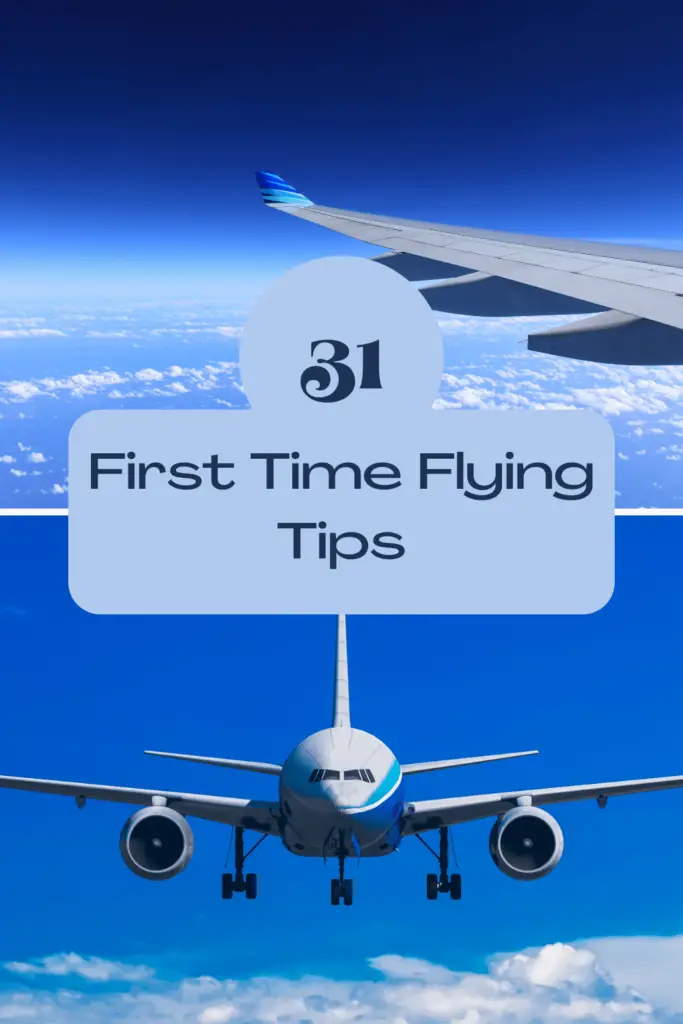
And please do me a little favor and share this article with others, for there’s a good chance that it will help them with their travels !
First Time Flying Tips FAQ’s
What must you do 30 minutes before a flight.
Before a flight, there are important tasks to complete around 30 minutes prior to departure. Check-in, go through security, keep your boarding pass and ID accessible, arrive at the boarding gate, inquire about seat availability, prepare your carry-on items, and stay updated on any announcements.
Arriving early and allowing extra time is crucial for a smooth travel experience.
Do I really need to arrive 2 hours before a flight?
The recommended arrival time before a flight is generally at least 1-2 hours before the scheduled departure time. While it may not always be necessary to arrive a full 2 hours before, it’s still important to allow enough time for check-in, security screening, and potential unforeseen circumstances.
Do I need to print my boarding pass?
Printing your boarding pass is not always necessary. Many airlines now offer electronic boarding passes, which can be accessed and displayed on your smartphone or mobile device. These electronic boarding passes usually include a barcode or QR code that can be scanned at various checkpoints throughout your journey, including security and boarding gates.
Share my adventures Share this content
- Opens in a new window X
- Opens in a new window Facebook
- Opens in a new window Pinterest
Sara & Josh
You might also like.
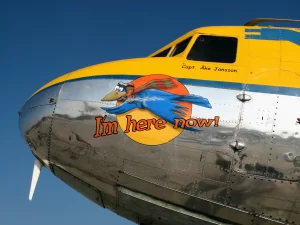
TSA PreCheck vs Global Entry vs CLEAR: All You Need To Know

How to Travel on a Budget: Insider Tips and Tricks!

How To Hold Your Mail When You’re On Vacation
Leave a reply cancel reply.
Save my name, email, and website in this browser for the next time I comment.

12 Travel Tips for First Time Flyers
You’ve finally booked that dream vacation you’ve always wanted, including your airline seats. But now what? Here are 12 tips for first time flyers from someone who’s done a lot of traveling and knows just how to make this experience for you as pleasant as possible.
Airports can be overwhelming for any traveler, so knowing what to expect can help you prepare for your trip. With these travel tips for first time flyers, you’ll feel prepared to take on any airport around the world and start experiencing what this amazing world has to offer!
This post contains affiliate links. This means if you purchase something from a link, I may make a small commission, at no cost to you. This helps me keep the site running and free.
If you like this post, be sure to sign up for my e-mail list for travel inspiration (and get your FREE budget printable), or connect with me on Facebook , Instagram , Twitter , or Pinterest .

Download Carrier’s Mobile App
When it comes to tips for first-time flyers, downloading the carrier’s mobile app is definitely important. Most if not all airline carriers will have a mobile app you can download to your smartphone. These apps are particularly helpful for check-ins, boarding passes, and guides for the airline. Some of the information we talk about in this guide can actually be accessed in the app itself.
If for some reason the app doesn’t work, you can always visit the airline’s website, it just won’t be as simple to navigate as a mobile app will be.
Set an Alarm to Check-In 24 Hours Before Departure
Airlines let you check in for your flight 24 hours before you leave. This can be done on the website or, you guessed it, the mobile app. Once you check in, you’re given the ability to access your boarding pass, which will be needed to get through airport security and onto the airplane itself.
I find it to be most beneficial to check in to a flight as close to that 24 mark as possible. Airlines assign you a boarding group, which determines when you can board the plane. The closer you are to checking in at that 24 hour mark, the more likely you are to board the plane closer to first. This is super beneficial for airlines like Southwest that have open seating.
Set an alarm on your phone or smartwatch for 2-3 minutes before that 24-hour mark. That way, you have time to get the app or website loaded so you’re ready to check in right when that 24-hour mark hits.

Make Sure Your Luggage Is All Appropriate Sizes
Different airlines have different luggage requirements for their planes. Some allow carry-ons for free, others do not. Some allow checked bags for free, others do not. Make sure you’re aware of how big your personal items, carry ons, and checked luggage can be for your particular airline.
Some airlines like Spirit and Frontier are extremely strict when it comes to how big certain items can be, going so far as to make every one boarding the plane check that their luggage size is compliant. If you aren’t, you have to pay large fees to check your bag, so it helps to plan ahead by making sure your luggage is the right size ahead of time!
Pack Essentials In Your Carry-On or Personal Item
We all hear horror stories about checked baggage getting lost between your departure and destination locations. Therefore, an important tip for first-time flyers is to make sure your most important items are with you on your carry-on or personal item.
I try to carry items such as medications, chargers, electronics, keys, and wallets with me at all times. That way, if something gets lost in my checked bag, I have my essentials with me – I can still take my medications, use and charge my electronics, and buy anything else I may need before my luggage is found.
Bring An Empty Water Bottle
This is one of my favorite tips for first-time flyers. The key word here is an empty water bottle. If you bring one with any liquid in it at all, you’ll have to throw it out as you go through TSA security.
When you bring an empty water bottle, you can take that through security without any issues. Then, you can fill it up with water at water fountains or water refill stations around the airport. This ensures you’ll be able to stay hydrated during your trip without having to pay the crazy airport prices for food and drinks!
Familiarize Yourself With The Airport(s)
Every airport has its own unique layout. Some are larger than others. Some have trains to get from one terminal to the next. Some have multiple security checkpoints, while some may only have one.
Before you leave, familiarize yourself with the airport you’ll be going to for take off as well as the airport you’ll be in once you land. Take note of where the TSA checkpoint is for security. Try to see where your departure gate is and how far of a walk it is from the security checkpoint. Also make note of where restaurants and restrooms are in case you want to grab a quick bite or use the restroom before you leave.
Once you land, it’s helpful to know which direction you need to head to grab your checked luggage. It’s also helpful to know where the exit for the airport is, and sometimes it’s different depending on if you’re picking up a rental car or just using a rideshare service like Lyft or Uber.

Plan Your Transportation To/From The Airport(s)
You’ve familiarized yourself with the airport, but how will you get there? And once you arrive, how will you get from the airport to your final destination?
Depending on where your departure airport is, you may choose to drive your own vehicle and park at the airport. However, since you’ll have to leave your car there for the entire duration of your trip, this can end up being very expensive very quickly. Look to see if you’re close to public transportation that stops at the airport or try using a rideshare service like Lyft or Uber. You could always ask somebody to drop you off as well.
Some airports are easily connected to the local city’s public transportation service, but if this isn’t an option your final destination is far away, you’ll need to figure out another way to get there. Most airports have easy access to some sort of rental car service. You may have to take a train or bus to get there, but they’re usually pretty close by.
Depending on the cost, you may choose to just use a rideshare service to reach your final destination. Just remember that you’ll have to pay that cost to get back to the airport as well.
Arrive Early
A tip for first-time flyers that most airlines will tell you themselves is to arrive early for your flight. The recommendation is to arrive at the airport 2-3 hours before your flight is scheduled to leave. If you know you live somewhere with a busy airport, you may want to adjust that accordingly.
Remember, it’s always better to arrive early than to be late and miss your flight. If you arrive early, you can chill at a restaurant or pay to relax at the airport’s lounge if they have one.
Many times, TSA will require you to take your shoes off when you go through security. Think about all the people that have walked on that floor and all the places across the world they’ve been. Your bare feet would now be on that same floor. Wear socks through security.

Prepare for Delays
It’s better to go into an airport expecting some sort of delay than to expect everything will arrive right on time. That way, you can plan everything with a bit of a buffer instead of smacking up against each other.
For example, if you’re traveling to a Disney World park that closes at 7 pm, don’t take a flight that’s going to land at your destination at 2 pm. If your flight is delayed, you’ll barely have time to get to and from the airport to your final destination before its closed down. In this situation, I’d recommend trying to get there around 10 am or 11 am.
Flights get delayed for a number of reasons including weather, staffing shortages, and breakdowns. If you give yourself time to account for those possible delays, you’ll be prepared for when they happen. Besides, if no delays happen, then you can relax and take your time getting to your final destination!
Don’t Be Afraid to Ask Questions
An important tip for first-time flyers is this – don’t be afraid to ask questions. There are people at airports who want to help you enjoy your experience as much as possible. You can ask people at the departure gate for information related directly to your flight, including questions about plane seating, boarding processes, and luggage.
Oftentimes, you can also ask people around you to help with any questions you may have as well. Usually, if they don’t have the answer, they’ll be able to point you in the direction of somebody who will.
Enjoy Your Trip
Traveling can be a stressful experience, but it doesn’t always have to be! If you follow these tips for first-time flyers, hopefully you’ll catch the travel bug just like I and so many other people have. Just remember that everyone is in the same situation as you – they’re all trying to get from point A to point B as quickly and smoothly as possible.
Sometimes, things happen we can’t plan for, but following these tips should help with some of that. And remember – when something goes wrong, it’s only temporary. When you get to your final destination, everything will be worth it.
Read More Travel Tips
How to Take Better Travel Photos with Your Phone
How to Plan a Trip with Google My Maps
Important Travel Safety Items for Any Trip
Figure Out How Much Cash You Need!
Save “Travel Tips for First Time Flyers” for Later

Author Bio: This is a guest post by fellow travel blogger Christian McIlwain of Vertigo Views . Christian has been a fan of theme parks and travel since he was a child. He has over twenty years of experience both researching and working in the theme park industry. He grew up visiting Kennywood Park throughout his childhood. Currently, he lives in Atlanta, GA where he frequently travels and visits Six Flags Over Georgia and Orlando area theme parks.
About The Author
Leave a Comment Cancel Reply
Your email address will not be published. Required fields are marked *

First-time Flying: 30 Must-Know Tips for First-time Flyers
Traveling for the first time? These tips for first-time flyers will guide you, from airport tips, how to deal with flying anxiety to all the necessary info .
We have all been first-time flyers at least once in our lives. The first time on a plane can be exciting but at times overwhelming as you don’t know what to expect or how to feel about the entire experience.
Normally as a first-time traveler, you have so many questions about traveling ranging from what to do at the airport , how to check-in at the airport, when to arrive at the airport, what the cabin luggage size should be, the carry on essentials you should pack or even how to book your hotel or air ticket in the first place plus all the necessary airport tips .
All these questions can be daunting if you don’t have where to get the answers from.
With this post, you’ll get all the necessary tips for first-time flyers from carry on luggage rules to how best you can handle flying anxiety.
So without any further ado, let’s look at the best things you should know if it’s your first time flying on a plane.
Related post: Important travel tips for first time travelers
First Time Flying Tips

Disclaimer* This post contains affiliate links and I might earn from qualifying sales.
Tips for first-time flyers before your travel date
You’re about to fly to a new country– yay congratulations!! But before you experience your first time flying on a plane, there are some important things you should do before traveling .
These will determine whether you’ll get to the plane or your dreams will be crushed.
Obtain a visa
The type of visa to be obtained will depend on the reason for traveling and where you’re traveling to.
The types of visas can range from a tourist visa, business, student, work, to many others. To see the general visa requirements, check with you’re nearest consular of the country you’re traveling to.
But some of the common visa requirements for most embassies include;
- Proof of a booked air ticket; round trip . If you haven’t booked your flight ticket yet, compare the prices of different flights with Skyscanner to choose the best deal.
- Proof of hotel booking . The country you’re traveling to wants to be sure that you already have where to stay when you reach their country. Not sure where to stay while in an absolutely new country, book your ideal hotel with booking.com or Hotelscombined to enjoy endless deals on discounted hotel rooms.
- A copy of your bank statement . Are you able to take care of yourself while in a foreign country? The embassy will always require a bank statement to gauge whether you can actually survive in their country. The embassy usually states the minimum amount that should be on your bank account for a certain period of time to be eligible to enter their country. (Pease note that this depends on the passport you’re holding and where you’re traveling to).
- Yellow fever Card . Even though a yellow fever card is mandatory in some countries, some of them do not require it. So, again, check with the embassy requirements to see if it’s needed.
Make a research about the country you’re traveling to

The best way to know about the country you’re traveling to is by making extensive research. You don’t want to be shocked on the first day you land in a new country.
It is wise to at least know some of the basics of the country from their culture, dressing code, food to the cost of living.
If you’re a budget traveler, you may want to read this post that shows how to travel on a budget .
Come up with an itinerary
I know some travelers are all about being spontaneous but having an itinerary can save you a lot of time and money by making you more organized.
Design an itinerary depending on your interests. This can be from visiting Unesco World Heritage Sites , national parks to big European cities.
Not sure which activities to go for in a certain country, click on this link to select activities you want to do based on the area or country you’re traveling to.
Related posts: Step by step guide to planning a trip Must have free travel apps that work offline
First time flying tips on your flight date

As a first time traveler, you might be asking yourself; how do I prepare for my first flight?
Some of the things to know when flying for the first time on your flight date are endless but we are going to look at the most important ones like when to arrive at the airport, airport check-in process, what to do when you get to the airport and all the general airport tips and hacks.
Packing tips
Don’t carry luggage that weighs more than what the airline allows unless you’re willing to pay for the extra kgs.
The accepted kgs of your luggage are always indicated on your ticket, so be sure to check it to avoid extra fees. You can buy this travel luggage scale to help you weigh your luggage before you go to the airport.
Also, find out what you can bring on a plane and all the hand luggage restrictions.
Every airline has different rules, so check with your airline to see what you can take in your hand luggage and the carry on luggage weight acceptable.
In that same manner, find out what you can take into a certain country and what you can’t. There are a number of packing lists online to help you know what to pack and below are some that you can check out.
- Packing list for Africa
- Packing list for Egypt + what to wear in Egypt
- Things to pack in your carry on
- Packing list for Paris in winter
- Ski trip packing list
- Europe in winter packing list
- Hostel packing list
- Beach packing list
- Packing list for a weekend getaway
What to wear on a plane
Wear comfortable clothes while flying. By comfortable, I don’t mean high heels or jungle boots but rather sweat pants, a comfortable pair of jeans, a t-shirt, or a really comfortable top are ideal.
Some of the comfortable clothes you can wear on a plane include;
- These kinds of sweatpants
- Leggings – every girl traveler needs a pair of these cute and comfortable leggings
- Warm and compression socks – ones you can keep on during the flight if you choose to take off your shoes.
- A warm fleece and a large scarf – it gets cold in the plane.
- A pair of comfortable shoes – this pair of sneakers always does it for me.
Wear easy-to-remove shoes. As you go through the security check at the airport, you’re going to have to take off your shoes a couple of times.
So instead of wearing gladiator shoes will endless shoelaces to untie, opting for flip flops or sneakers is a better choice.
Pro tip: Make sure you don’t have smelly feet or shoes as you don’t want to be embarrassed at the airport when you take off your shoes. But if you do, worry not, this fungus treatment will heal the smelly feet before your big trip.
Forego the belt if you can or wear clothes that don’t require one. While going through security, you’re required to remove your belt every now and then. So, if you don’t want to be inconvenienced, just do away with it.
While still at the point of packing, there are some travel essentials you should not leave behind as you travel. Below are some of them.
Travel Essentials you should never leave home. – A universal travel adapter : Since different countries use different adapters, I’d advise you to buy one universal travel adapter to cater for all regions. You can buy one from here if you don’t have it yet. – A power Bank : One of the things you should never leave behind while traveling is the Powerbank! Phones have now become a great deal of our lives that we need to use them for so many important things. So take a power bank with you so that you don’t run out of battery. This power bank is small, light, and has the capability to charge your phone and other devices multiple times. – Microfibre travel towel – I always opt for this microfibre travel towel because it is super lightweight, easy to wash, and dries easily. – First Aid kit : Regardless of where you’re traveling to, you’ll need to pack a First Aid kit for emergencies that might arise while traveling. Remember it’s always better to be safe than sorry. Just make sure that the one you pack has all the essentials and that it is small and light enough to fit in any kind of suitcase/ backpack. This first aid kit actually fits all the qualities mentioned above plus it is really cheap for what it offers. – Collapsible water bottle : I always prefer carrying a water bottle while traveling so that I can just refill it when I run out of water. It also helps be a responsible traveler since you won’t have to use tones of disposable plastic bottles which are not great for our environment. Any water bottle can work but I prefer this collapsible one as it doesn’t take a lot of space in my bag.
First time flyer Airport tips

- Reach at the airport 2 hours before your flight time if it’s an international flight and 1 hour before if it’s a domestic one. You’ve probably heard this countless times but it’s not just the excitement of a first flyer that should make you be at the airport early but also the fear of missing your flight.
- Check your ticket to confirm the terminal where your flight is to be. For big airports, make sure that your taxi driver drops you off at the exact terminal, or else you’re bound to waste a lot of time looking for your terminal or even “get lost” and eventually lose your flight.
- Be sure to have your passport, ticket, and all the necessary documents at all times. You can buy this this travel neck pouch to help you keep your travel documents organised.
- Use the screens in the airport to locate your check-in point so that you don’t end up at the wrong counter when the check-in time reaches.
- Ask for help from the airport officials. If anything goes wrong or you’re not sure of where to go, don’t panic; politely ask the airport staff for help and they will be at your service.
- Reach the check-in point on time.
- Request for a window seat at check-in. (that is if you want to enjoy the outside views from the plane). While at check-in, you’re given an option to choose the seat you want (if the attendant is generous enough to ask).
- When you’re given your boarding pass, memorize the gate number you’ll use to access the plane.
- Head to your departure gate and keep an ear out for any announcements related to your flight.
- Be sure that the boarding pass is with you at all times as it’s what you’ll use to board the plane. You can check out more airport tips from here .
Related post: How to pack light when traveling
First time flight: Tips for when you board the airplane

- Only sit on the seat number allocated to you on your boarding pass. Seat numbers look like 35A, 1B, & 27C and they are always located on the overhead bin above the plane seats.
- Place your hand luggage in the overhead bin, if it’s a small handbag or purse, place it under the seat in front of you. Now you can sit and get comfortable.
- Fasten your seat belt and wait for further instructions from the flight attendants.
- You will be given instructions on what to do in case of an emergency but don’t panic, that is the routine for all flights, not that something bad is anticipated to happen.
- If you are a nervous flyer, I recommend you don’t look outside the window until you get comfortable otherwise you might get more nervous. Regardless of how fun flying on a plane is, I’ve found it a bit scary a couple of times to look outside the window.
- Flying can get boring, more so if the flight is for long hours, so don’t just sit there: you can read a book, watch a movie if the plane you’re in has that provision, write if you’re a writer or a blogger or just sleep to kill the boredom.
- Wake up to watch the sunrise. If you traveled in the wee hours of the night, wake up to see the sunrise. The sunrise on a plane is one of the best sunrises you’ll ever see, so if you’re up for it- don’t miss out on it.
- Don’t be scared of Airplane Turbulence -“bumping of the airplane during the flight.” Chances are high that you’ll experience airplane turbulence but don’t freak out as this is absolutely normal especially when the weather is not so good. I have to be honest, I freaked out on my first flight because of this. However scary it might seem, you’re actually not in danger- you’re plane is not going down. Just tighten your seat belt if you had removed it before.
Even after following all those guidelines above, there are other unwritten airplane etiquettes that you should be aware of as a first-time flyer.

How do you calm your nerves when flying?
- Try to fall asleep so that you don’t hear the bumping of the plane.
- Watch an interesting movie that takes away your concentration from the turbulence.
- Don’t be uncomfortable in silence; the flight attendants are there to serve you, so if you have anything you want to know, just ask and help will be on its way.
- Chew gum or sweets. First-time flights can be exciting but complicated too. My first-time flight experience was rather painful as I had constant ear pain almost half the entire flight. What was the cause? The difference between the air pressure inside the inner ear and the pressure outside. Normally, the pressure in the inside inner ear is equal to the outside pressure, but due to the rapid change of altitude while flying, there is an imbalance that causes ear pain. How do you make sure it doesn’t happen to you? Chew gum. Chewing gum helps equalize the air pressure in the inside inner ear and that of the outside pressure.
Lastly, have fun. Forget the anxiety and pain and enjoy the flight. You’re never gonna have another first-time flight experience, so forego all the distractions and enjoy all that comes with flying.
Related posts: Things not to do when you travel How to stay safe while traveling
First-time flyer: Tips for when you leave the plane.

- The first thing to do when you board off the plane is to locate where your baggage is being dropped. Chances are high that you don’t know where, so use the direction arrows and screens in the airport to locate the cargo drop-off area for your plane. Again if you can’t locate it, ask for help from the airport staff.
- After getting your luggage, locate the customs area to get the necessary stamps to let you enter and stay in their country.
- Get an airport cab if you didn’t arrange for airport pick up and begin your adventures.
- Have fun, loosen up, be smart, stay safe, enjoy your trip to a new country, and don’t forget to take lots of pictures.
Check out this post to discover more travel tips and hacks that will help you as a first-time traveler.
Are you planning to take your first trip overseas or it’s your first time flying, I hope these tips were helpful.
Did you have a fun or weird experience during your first time on a plane? I would love to read your experiences and don’t forget to share with others that may need these tips.
More travel tips to help you plan your trip
- Camping tips for beginners
- Hiking tips for beginners
- Backpacking tips for beginners
- Backpacking hacks you need to know

Similar Posts

15 Cute Summer Travel Dresses That Will Make You Look Like a Fashionista
Planning to on a summer trip but not sure what to wear? Here are the best summer travel dresses that will make you look like a fashion guru Summer is upon us and I couldn’t be happier! After a long gloomy winter and an unpredictable spring where we had more rain than sunshine, I couldn’t…

2019 Amazon black Friday deals for travelers
It’s that time of the year again where we run like crazy to stores to get the greatest bargains we can land our hands on! With percentages dropping as low as 40 sometimes 50 off, its the busiest weekend in the shopping world! From the craze, the hype, the queues to being randomly pushed away…
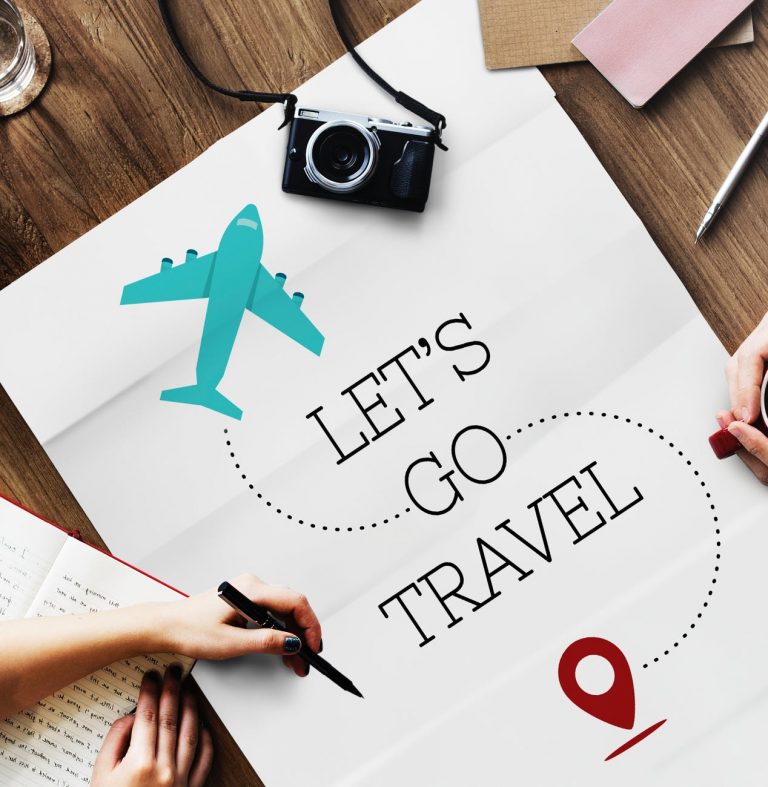
15 top tips on how to travel on a budget
Want to enjoy low-cost travel? Here are the best ways on how to travel on a budget and how to save money while on the road Recently I was asking some of my friends why they don’t travel to certain places, and however much some of them told me they are not interested in traveling(…

15 Best tips to packing light: How to travel light
Wondering how to travel light? Check out these practical tips to packing light that will save time, money, and from chaotic experiences while traveling. When I had just started traveling, I had a different definition of packing light. For my trip to Egypt that was going to last for 10 days, I packed items that…

12 Easiest ways to make friends while traveling solo
Traveling solo can be an extraordinary, exciting and liberating experience. Setting your own pace and discovering new cities without having to compromise on your enjoyment makes for some fantastic travel adventures. However, when traveling solo, it’s not unusual to get lonely from time to time and wish that you could share the experience with someone…

10 Best tips for a perfect beach getaway
Planning to go on a beach vacation this summer? Here are the best beach tips you should know for a perfect day at the sea. After those long dull months, we can now finally embrace the good weather and show off our best summer bodies – oh, don’t worry, serve whichever body you have! The…
Leave a Reply Cancel reply
Your email address will not be published. Required fields are marked *
- Cognitive Behavioral Therapy for Fear of Flying
Hypnosis for Fear of Flying
Medications for fear of flying.
- Virtual Reality for Fear of Flying
- SOAR Review
What is Turbulence?
- Small Airplane Statistics
How Safe are Airplanes and Air Travel?
- What is Acrophobia?
- What is Agoraphobia?
- What is Claustrophobia?
- What is Mysophobia?
What is Aviophobia?
- Childrens’ Fear of Flying
- TSA Tips for First Time Flyers
- Celebrities Afraid of Flying
- Fear of Flying Apps
- Clear Airport Security Review
- First Time Flying: Tips on Booking, the Airport, and the Flight
Affiliate Disclosure: We may use affiliate links on this page that lead to Amazon or other partners. If you make a purchase after clicking on a link on this page, we may earn a small commission at no extra cost to you.
Part of the fear of flying is actually a fear of the unknown. If you are flying for the first time—whether for business or pleasure—this includes not knowing what to expect at the airport or while you are in the air.
This step-by-guide spells out everything the nervous first-time flyer needs to know, from booking the flight to navigating the airport to getting situated onto the plane.
We've packed in our best travel tips for first-time flyers based on the collective experience of our staff, so climb aboard and let's get you ready for the flight!
These flight tips cover most major airlines like American, United, Delta, Southwest, etc. For budget airlines like Frontier or Allegiant, you'll see some variance in items like luggage fees, in-flight accommodations, etc.
Boarding procedures, safety instructions, and other instructions as they relate to the safety of staff and the passengers remain relatively standard.
Booking the Flight
The first step in the flying process is purchasing tickets. To book the flight, most people purchase their tickets online through airline or travel sites or their mobile apps. The only thing you have to fear in this step is expensive ticket prices. Otherwise, it is a relatively easy process that you can handle yourself.
Directly through the Airline
In terms of convenience, booking directly through an airline's website is the easiest route. If there are any ticket price changes between the time you book and the time your flight departs, you can usually have that difference refunded with a quick call to customer service.
It's also easier to get better seats and address flight delays, changes, or cancellations when booking direct. Otherwise, you might be referred back to your travel agency, which is another cumbersome step to have to take when you're having problems with your flight.
It's a little extra work on the front end, but for first-time flyers, this gives you added flexibility just in case something were to go wrong.
PRO-TIP: Add your airline's phone number to your contacts and jot down important info like flight numbers, confirmation numbers, etc. in the notes app on your phone.
Just in case something does go wrong, having all of this info readily available will help solve problems faster.
Through a Travel Agency
There are some instances where booking through a travel agency is the better option. Specifically, if you are planning an international trip or one that is more complex than a week-long vacation in the United States, a travel agency can be a big help.
OTA's, that's Online Travel Agencies, are sites like Orbitz, Trivago, Kayak, Booking.com, Expedia, and others.
What's the difference between them?
Spoiler alert - not much. In fact, the majority of these sites are all owned by four or so big players.
Why use an online travel agency?
- One-Stop-Shop, flights, hotels, car rentals, and more
- Good first-time user offers
- Helps to save time and money
- Quick and easy comparison of different airfares and schedules
- See reviews and recommendations from people who have taken the same trip before.
For the most part, they wrap up all of your trip into a single package and help manage the booking and getting you to your destination. All you have to do is pay and print out the trip details.
If problems do arise on your trip, a customer service representative is only a phone call away to get you the help you need.
Direct Flights
Whenever possible, get a direct flight. Layovers only add the potential for more problems. You want the journey to be as simple as possible, and when you only have to board and exit a single plane, you lessen the chance for delays, cancellations, and missed connecting flights.
Layovers and Connecting Flights
If you can't find a direct flight, it's not the end of the world. A connecting flight is where you will travel to one airport to join a different flight that will take you to your end destination. Sometimes you may have multiple stops, but for most domestic flights, it's common only to have one.
A layover is a time in between these connecting flights. For example, if you fly from New York to Los Angeles, you may only fly halfway to Chicago. There you will exit the plane and wait in another concourse until your next flight is ready to depart for Los Angeles.
This can be a quick turnaround or several hours long; it all depends on the flight schedule.
If you must choose a layover, pick one that is at least 2 hours between the time the plane is scheduled to land and when the next one is scheduled to depart. Any less time may result in a missed connecting flight.
What often happens is the plane's wheels will touch down at, say, 10:41 AM. However, the plane won't make it to the concourse for 'x' reason (jetway unavailable, lots of traffic, etc.) until 11:30 PM. By the time you're off the plane, it's almost 12:00 PM, and you're rushing to get to your next flight.
When booking your flight, remember:
- Book a direct flight whenever possible, even if it costs a little more.
- Give yourself at least a 2-hour layover between connecting flights.
- Add more time to your layover if you want to eat, freshen up in the bathroom, etc.
- Red-eye flights are often cheaper but at the expense of traveling at night.
RED-EYE FLIGHTS: You might see a "+1" on some flights, or see flights that fly overnight. These are referred to as "red-eye flights." Any flight that travels through the night is a red-eye.
The downside is obvious; however, these flights are typically cheaper if you can deal with not sleeping well.
Types of Tickets
You may see different ticket types available for purchase. The main differences you're likely to see include the ability to make flight adjustments after purchase, refundability, carry on allowance, seat selection, or boarding group.
Be sure to carefully read the fine print of the ticket you are purchasing. Most airlines will be somewhat flexible on some of these policies. For example, if you need to change your flight weeks or months for departure, most customer service agents are happy to make that adjustment.
Always, always, pack the night before! Get your laundry done a day or two before and make sure all of your electronics are fully charged. You will also want to pack some specific documents and ensure you have the right luggage.
Important Documents
Be sure to have a valid form of ID, such as your driver's license and your passport if you are traveling internationally. The TSA has an article outlining other forms of acceptable IDs, if you are not using something typical, like your driver's license, military ID, or passport.
Starting on October 1, 2020, all travelers in the US, over 18 yrs old, will be required to have a REAL ID-Compliant Driver's License or another form of acceptable identification.
More on the REAL ID can be found on the TSA website .
Even if you plan on using a digital boarding pass on your phone, it may be helpful to print it from your home computer or at the airline's kiosk.
An example of a boarding pass for an American Airlines flight printed at the airport.
Carry On Luggage
Carry on luggage refers to the larger suitcase or bag that you can bring on the plane with you and store in the overhead compartment.
There are restrictions to the size of the carry on you can bring; however, most bags from known brands like Chester, TravelPro, Delsey, and others are compliant for most domestic flights.
International flights have slightly stricter standards, and are the requirements are only slightly smaller than domestic flights. Be sure to check the website of your airline for specific requirements.
If your bag is larger than specified measurements, you will be required to 'check' your luggage, which incurs around a $25-$30 fee.
BE AWARE: Don't go by your luggage manufacturer's advertised dimensions. Some manufacturers will not include the wheels or handles in their product listings. Airlines do take these into account.
If your luggage is questionable, you may be required to place it in this module to check its measurements.
Checked Luggage
If you are traveling for longer than 4-5 days, you'll likely pack a larger suitcase, which you will be required to check-in prior to going through security. These bags have weight limit restrictions, but as long as you're only packing usual items like clothes, shoes, etc. you won't even come near that limit.
There is a $25 to $30 fee for each way when checking your luggage. After checking your luggage, you will not have any access to your bag until you pick it up from the baggage claim at your destination.
TSA has specific restrictions on what you can and can't pack in both your checked and carry-on luggage. Each airline may have additional restrictions on what you can and can't pack.
Personal Items
In addition to your carry-on, you are also allowed to bring on a 'personal item' onto the plane. This has to fit under the seat in front of you and is commonly a purse, small/medium backpack, or diaper bag of sorts.
These bags are subject to the same restrictions as your carry on and also have varying size requirements. It is best to pack items that will be accessed during the flight like snacks, headphones, laptops, power banks, etc.
To summarize, remember:
- Make sure your ID is compliant and up to date
- Your carry on and personal item meet your airline's requirements
- If you are checking luggage, it also meets your airline's checked luggage regulations
Checking In
Before the flight, you are also required to "check-in," which just acknowledges you are still planning to make the trip. If you booked online, you could follow the instructions you get from the airline — you'll get an email or text prompting you to sign in.
This is usually about 24 hours before your flight. If you didn't do so during the booking process, you can usually choose a seat during the check-in process, or pay for your checked bags (if applicable).
Almost all major airlines allow you to perform all of these actions from the app.
As part of this process, you receive a boarding pass—a document that proves that you have purchased a ticket and contains information about you and your trip.
After checking in, your boarding pass is available through the app and can be added to your digital wallet.
You can also print your boarding pass from a desktop computer or at the kiosk at the airport. It's highly recommended to do this just in case your phone dies or has technical issues at the gate.
Arriving at the Airport
How early should i arrive for my flight.
Most airlines and travel experts recommend arriving two ahead of the scheduled departure time for any domestic flight. For International flights, plan for around 3-4 hours ahead of time.
If you are traveling during the peak holiday season, aka Thanksgiving and Christmas, it's advised to add an extra hour or two onto those times because of the influx of families, children, etc.
Remember, you need to account for factors you can't control like traffic, security checkpoint wait times, etc.
PRO-TIP: Signing up for TSA Pre-check, Global Entry (for international travelers), or CLEAR, can save you TONS of time and hassle going through security.
It's basically like getting to go through the VIP line, which is always shorter.
If you are not being dropped off, you will need to pay for parking. You should check the rates and available lots at the airport you'll be departing from. Larger airports usually have 2, sometimes 3, different lots for travelers.
One lot is designated as "daily," for travelers who will not be leaving their car overnight. This gives them a better rate than the "long-term lot," which is specifically for flyers who will be gone for more than a day.
If you are gone for multiple days, park in the long-term lot, or else you'll be paying a lot more money to stay in the daily lot.
When you pull into the lot, you'll likely pass through a gate where you'll receive a ticket about the size of a business card. Put this in your glove box as you'll need it to leave the lot. After coming back from your trip, you'll put the card into the machine on the way out and pay the parking fees.
Lastly, for some major international airports, you may have to ride a shuttle from the parking lot or garage to the gates. It's recommended to tip these shuttle drivers a few dollars as they will typically help you with your luggage.
PRO-TIP: If using an iPhone, drop a pin on the location for where you've parked your car and save it. Otherwise, make a note on your phone on the section, lot number, etc. of where your car is parked. This will make it much easier to find once you get back.
It's recommended to always print out a paper copy of your boarding pass and tickets, just in case the digital copies on your phone become inaccessible.
You can print these out on your computer at home, or you can retrieve them from the kiosk at the airport. If the kiosks are not available or you are having trouble with them, you can talk with one of the airline's representatives to help you.
You will receive all of the tickets and boarding passes for the first part of your flight, so be sure to place them somewhere where they can't be lost. The front pocket of a backpack, wallet, or purse is a good idea. You will want to be able to access them quickly, but keep them secure.
Walk up to a kiosk or customer service rep to check into your flight.
Checking Luggage
If you plan on checking your luggage in, you can do that from the kiosk or by speaking with a representative.
If done from the kiosk, it will print out a long sticker that you will wrap around the smaller, non-extending handle on your suitcase. You will remove the backing to expose the adhesive, wrap it around, and then connect the two adhesive sides together to form a loop.
You'll then need to wait in line until you reach the check-in desk to hand off your bag. Sometimes the representative will be printing out the sticker and putting it on your bag.
After you have landed at your destination, remove the sticker and throw it away before heading home. Having multiple labels on your luggage only increases its chances of getting lost.
Getting Through Security
Depending on the airport, there may be a central security checkpoint for all gates—like in the Atlanta airport—or there may be separate checkpoints for each set of gates, like in the Tampa airport.
Airport personnel can help you find the checkpoint, and there is generally ample signage to point you in the right direction. Regardless, all passengers must go through security, including children.
When you reach the security area, you'll generally wait in line anywhere from no time to an hour or more. Once you get to an agent, they will check your boarding pass and ID to ensure they match.
You will need a government-issued ID such as a driver's license, and as already mentioned above, starting October 1, 2020, it will need to be REAL-ID compliant. If your ID is compliant, you will not be allowed to pass security or board the plane.
If you become a frequent flyer, we recommend that you check out our CLEAR airport security review as a way to gain access and move through life more quickly and easily.
Be Aware: While waiting in line, you may be subject to a random screening. For example, while the author of this article was in Washington DC, his hands were dusted for any remnants of bomb-making materials. Unless you have recently been to a shooting range, near any gun powder, or fireworks, you will not have anything to worry about.
The Screening Process
Next, you will place your personal belongings and any carry-on bag (the one(s) you will keep with you on the plane) in bins that roll along a conveyor belt and under the x-ray machine.
This is the what security screening looks like after you have walked through and gathered your items.
BE AWARE: While waiting in line, you may be subject to a random screening. For example, while the author of this article was in Washington DC, his hands were dusted for any remnants of bomb-making materials. Unless you have recently been to a shooting range, near any gun powder, or fireworks, you will not have anything to worry about.
BE AWARE: The body scanner is a very sensitive machine. Something so much as your boarding pass or a stick of gum can show up on the screen.
Keep in mind this machine will not show any images of what is underneath your clothing - only if a foreign object appears on the outline of your body.
Any electronic larger than a cell phone needs to be removed from your bag(s) and placed in one of the containers. This includes laptops, tablets, and cameras. Be sure to have these items easily accessible and not buried deep within your bags.
After that, you collect your belongings from the bin, put your shoes back on, and head to your gate area.
A Better Solution: CLEAR
If you would like to avoid most of the security screening, consider signing up for CLEAR and check out the review here. With CLEAR, you will only need to walk through a metal detector; all your belongings can stay in their respective bags — no removal of shoes, shorter lines, and less hassle.
Prohibited Items & the 3-1-1 Rule
Airports have strict requirements regarding what you are allowed to have on your person and in your carry-on bag. To find out what personal items you can bring with you on the flight, consult the resources below.
For a guide on permitted and prohibited items, visit this Transportation Security Administration (TSA) website page .
For information about the "3-1-1″ rule pertaining to liquids, visit this TSA webpage .
Finding the Concourse Gate
The "gate" is the area where you wait until time to board a plane. Each concourse in an airport houses several gates. A concourse resembles the wing of the mall in that it usually contains restaurants and gift shops. Any food or merchandise you buy in the concourse area is fine to take on the plane with you.
A terminal is the large main building of a section of the airport. The terminal houses several concourses. Imagine it like a large tree. A terminal is the trunk of the tree with large branches coming off the trunk, these are your terminals. Finally, there are small branches off of those larger ones called gates, where the planes are docked for the next flight.
It goes Terminal > Concourse > Gate, so in the picture the gate is L8. This is gate 8, in concourse L. According to this map of Chicago O'Hare Airport, concourse L is in Terminal 3. Large international airports have multiple terminals, but generally will not reuse concourse letters.
When at the gate, you are free to sit wherever you please. When it is time to board, passengers line up and present their boarding documents to a gate agent.
If you are using a digital boarding pass, it is scanned straight from your phone. Just ensure your brightness is high enough and have your paper one ready in case your phone has trouble scanning.
You will then walk through a "jetway," or "jet bridge" which connects the gate to the outside of the plane.
A jet bridge waiting for an airplane to dock on a sunny day.
An airplane that has been docked to the jetway on a rainy day.
Valet Checking your Carry On
For smaller aircraft, typically ones flying in or out of small regional airports, you may be required to 'valet check' your luggage. Don't worry, this doesn't cost you any money, and is a common practice.
Usually, an attendant will walk around the gate area, passing out small red or yellow tags that will attach to the top of your luggage. This will vary from airline to airline, but generally, if it has wheels, you will valet it.
After scanning your boarding pass, you'll leave your carry-on at the top of the jetway where it will be stored in the belly of the aircraft for that flight only. You will still take your personal item with you to your seat.
After the flight lands, your bag will be waiting for you at the top of the jetway. It may take a few minutes for the crew to unload all the bags and make them accessible.
Boarding the Plane
Passengers board the plane according to the group number on their ticket. Different airlines have different ways of doing this, but for most first time flyers, you will be the last to the second-to-last group.
Once you make your way onto the plane, read the seating labels found around eye level just below where the handle is for the overhead storage compartments. You'll see row numbers, often with letters indicating the seat number.
If you are having trouble getting your bag into the storage area or can't find your seat, flight attendants will be standing by to assist.
There will also be an icon indicating the window or aisle for you to determine which seat is yours.
Planes have markers at about eye level so passengers know which letter on their boarding pass refers to which seat.
After locating your seat, place your luggage in the overhead compartment, ideally wheels first. You can take your backpack, purse, or whatever your personal item is with you to your seat. It will need to be placed under the seat in front of you for takeoff and landing.
For those sitting in the front-most seat of economy you will not have a seat in front of you. Instead, look for the overhead compartments that are reserved for your personal items.
Pre-Flight Procedures
Now for the fun part, the flying itself. For some people, this is where the fear and anxiety begins setting in. But if you know what to expect when you fly, you will hopefully be able to better manage the fear before you are in the air.
Passengers board the plane, find their seats, and store any carry on baggage in the storage bins above the seats.
The crew relays safety instructions (or they are presented in a video on screens behind each seat), and the Captain gives a brief message to passengers along the lines of the weather in your destination city, any expected weather or turbulence issues expected and how long the flight is expected to take.
A safety card is in the seat in front of you to let you know what you need to do in the rare event of an emergency.
People that are already experiencing fear and anxiety when they fly tend to fear the worst during safety instructions. This is something you can learn to overcome by educating yourself on flight safety statistics and recognizing that the fear is irrational.
Accidents are very rare, so safety measures are seldom needed; the crew addresses them in the unlikely event they are necessary. If an emergency does occur, the crew is well-trained and equipped to assist passengers.
The Takeoff
The Captain then "drives" the aircraft on the ground to get in position for takeoff. Before takeoff, passengers must fasten their seat belts and remain seated until instructed otherwise.
When the pilot gets the clearance to take off, the plane will begin accelerating along the runway before becoming airborne. This is the part some passengers dislike because the plane is leaving the ground, and the body is angled upward.
Others have a feeling of exhilaration as the plane accelerates into the air. The acceleration and takeoff are likely to be a little bumpy as you move across the runway.
During the Flight
When the plane reaches a certain altitude, passengers are free to move about in the cabin and use the restrooms. Many planes have a video screen on the back of each seat with on-demand music, TV programs, and movies for entertainment. Wi-Fi is usually available as well, so you can take care of personal or business-related tasks.
The crew will also serve snacks and drinks. Depending on your ticket, food and drinks may be complimentary.
If you're in the coach section (typically the cheapest) section, you'll generally get a snack like pretzels or cookies and sodas or water. You can still buy additional food items or alcoholic beverages if you prefer.
If there is turbulence and moving around is not safe while in the air, the crew will instruct passengers to remain seated until notified otherwise. Turbulence is nothing to fear—it is caused by fluctuating air pressures and is a normal experience of flying.
The Landing
Likewise, when you are close to landing, the crew will require that passengers be seated and buckled in.
Some people fear this part of the journey because the plane will often slightly roll (turn) and change altitudes in preparation to descend and land on the airport runway assigned to the flight.
When the plane lands, the Captain drives to the gate, where passengers use the jetway to exit the aircraft and enter the destination airport.
Post Flight Procedures
Exiting the plane.
Similar to how you boarded. Exiting the plane is essentially the same but in reverse.
After the plane has exited the runway, there may be a wait until a gate is available for the plane to dock. This is dependent on whether or not flights are running behind and the availability of a jetway.
You should remain buckled until the crew gives you the okay to unbuckle. If sitting near the rear of the plane, you will be better off staying in your seat as it will take a while for everyone ahead of you to get off the plane.
Be courteous to other passengers and help when needed.
Baggage Claim
If you checked any luggage, you would then head to the baggage claim area. Airport signage will direct you to baggage claim, or you can get assistance from airport staff. Shortly after landing, luggage is placed on a carousel for passengers to pick up.
Final Thoughts
Once you have experienced the air travel process for the first time, you will at least have addressed the fear of the unknown, and hopefully will enjoy any future flights. Good luck, and if you are interested in reading some additional tips for first-time flyers, click here .
First Time Flying | Resources
- Airport Terminals
- Fear of Flying Statistics
Written by Fly Fright Staff , Staff Writer
Fact Checked
Our team of writers and editors rigorously evaluate each article to ensure the information is accurate and exclusively cites reputable sources.
You may be also interested in...
Alaska Airlines Flight 1282 – What Happened?
9 common commercial flight myths – debunked, 7 common carry-on mistakes, 6 reasons your flight keeps getting delayed, us federal air marshals – are they on every flight, 5 common reasons people believe car travel is safer than air travel, how many flight attendants are on a plane, what are the safest airlines, 4 cognitive behavioral therapy methods to overcome fear of flying, anxiety attacks on a plane – 4 strategies to prevent and resolve, using virtual reality to conquer fear of flying.

Ultimate Air Travel Guide: Essential Tips for First Time Flyers

You’re going on your first flight! HOORAY! I’m so excited for you! Right now, you might be feeling excited, nervous, overwhelmed, overjoyed, or a myriad of other emotions. How do you book a flight anyway? How do people get around airports without getting lost? What if there’s turbulence? What should you bring on the plane? This post answers all these questions plus offers lots of extra tips for first-time flyers. My hope is that this post helps prepare you and gives you some peace of mind leading up to your first flight.
This post contains affiliate links. Should you decide to purchase something from one of my affiliates I will receive a small commission at no extra cost to you. Check out my Disclaimer for more info.
TRAVEL BASICS Transport: CHEAP FLIGHT S & BUSES Transport: AIRPORT TRANSFERS Accommodation: HOTEL DEALS & CHEAP HOSTELS Things to Do: TOURS & ACTIVITIES Getting Around: RENTAL CARS Safety & Health: TRAVEL INSURANCE
Table of Contents
How to Save on Your Flights
There are lots of hacks to help you save money on your flights. I recommend using Secret Flying as well as comparing flight prices on websites such as Kiwi and Google Flights. You can read a breakdown of how to find good flight deals here.
The Benefits of Travel Insurance for Flying
It’s also a good idea to get travel insurance before a trip. Not only can you get coverage for medical emergencies, but you can also get trip cancellation and interruption coverage. That way if you need to cancel your entire trip, or go home early for whatever reason, you won’t lose a bunch of money. Travel insurance can also cover you for lost and damaged baggage and so much more. You can look into travel insurance options here.
Optional Tip: Pre-Book Your Airport Transfer for Your Arrival
To make your arrival smoother it can sometimes be easier to pre-book your airport transfer to your hotel from your arrival airport.
The other option is to grab a taxi, Uber, or skytrain from the arrival airport to your accommodation without pre-booking anything. It’s all up to you and how prepared you want to be on arrival. If you want to take public transport, you can always look up directions and bus routes before you go on your trip.
Carry-Ons & Luggage: What to Bring on the Plane

When you enter the airplane you can usually have one carry-on, such as a mini rolling suitcase or a backpack, plus one personal item. The personal item can be a purse, for example. As the name suggests, ‘carry-ons’ are any pieces of luggage that you bring onto the airplane yourself. You will store these under the seat in front of you or in the overhead bins.
I deally, you want to have all your valuables in your carry-ons. Things like laptops, money, your phone, e-readers, iPads, etc should all come on the plane with you, not in your checked luggage. This is because checked luggage gets bumped around a lot, sometimes goes missing, ends up in the wrong place, or gets stolen. While this doesn’t happen often, it can happen and that’s why you want all your most important belongings in your carry-ons.
It’s also a good idea to bring a change of clothes, underwear and some basic toiletries in your carry-on. That way if your checked bag gets lost, you have a fresh change of clothes to wear if you need to wait a day or two to retrieve your luggage.
Checked Luggage:
Some airlines may charge you for checking a suitcase and some might not. It all depends on the airline. If you think you can travel to and from your destination with minimal luggage, it may be cheaper to just pack everything you need into your carry-on. If you’re going for a longer time, you may want to bring a suitcase or duffel bag and have it checked through to your destination.
Luggage Tip
Once you’ve packed everything, set up all your luggage that you plan to bring, and take a photo of it all. That way if one of your pieces of luggage goes missing, you can show it to an airline attendant at the arrival airport to help locate it. I do this on every trip and it has saved me from losing my luggage on multiple occasions.
Carry-Ons & Luggage: What NOT To Bring
There are a whole host of things you SHOULD NOT bring on an airplane. The most obvious things not to bring are weapons. However, if you usually bring a self-defense item, such as a pocketknife or self-defense keychain with you, you can usually still put those in your checked luggage.
Airlines do not allow you to bring self-defense items like the aforementioned in your carry-on. This is because they don’t want any dangerous situations to take place during the flight.
Thi s is also why the amount of liquids and gels you can bring on a flight is limited. Liquid explosives can sometimes be disguised as other kinds of liquids such as soda. In fact, in 2006 there was a terrorist plan to detonate a bunch of liquid explosives on flights traveling from the UK to Canada and the USA.
Arrive Early
The general rule of thumb is to arrive 1 hour early for domestic flights and 2-3 hours early for international flights.
Personally, I like to give myself lots of extra time. I’m that person who arrives 2 hours early to domestic flights and 3-4 hours early for international flights. Some may think this is going overboard but I tend to be a pretty anxious person, so arriving early gives me some extra peace of mind. It means I can check my baggage, go through security, and then relax before the flight. I usually just read, grab a coffee, or do some work on my computer while I’m waiting to catch my flight.
Parking at the Airport
You can park at an airport in a specific parking lot for people taking flights. The airport will allow you to leave your car there for the duration of the trip, but you do have to pay for it , of course.
The other option is to take a taxi, Uber, bus, or get a friend to drop you off at the airport so that you don’t have to pay for parking at your departure airport.
How to Navigate an Airport

Your first time navigating an airport may be a bit overwhelming. When you first arrive you will need to find the check-in counter with the name of the airline you’re flying with. Then you will go through security and need to find your gate.
Your gate number will either be located on your flight ticket or if you get there quite early, your gate number might not be announced yet. If that’s the case, you can look up at the tv screens placed throughout the airport. Find your flight number on your ticket. It will be a few letters, like AC for Air Canada for example, followed by a few numbers. Look up at the screens, find your flight number and once your gate has been chosen, it will show up there so you can go wait for your flight closer to your gate.
If you want to hang out in the airport and eat a meal, or grab a coffee, just make sure you are back to your gate before your boarding time, not your flight’s take-off time . It’s definitely not a good idea to go somewhere super far away from your gate for a meal, knowing you may have to run back to board.
Keep Your Passport or ID on Hand
Make sure that you triple-check that you have your passport or ID before leaving your house! Once you’re at the airport, you may be asked to show your passport (for international travel) or ID (for domestic travel) at check-in, security, and at your gate when boarding. It’s best to keep your passport or ID handy, so you can pull it out and show it when needed. You can buy special RFID blocking passport belts to protect you from theft when traveling. These can be purchased online or at airports.
At the Airport: Checking In
When checking in, you will need to show your passport or ID and then you will be given your flight ticket. Make sure you go to the same check-in counter that matches your airline! Checking in can be done at a counter with a staff person or through a self-serve computer. You will also need to weigh, pay for, and check any large luggage that you won’t be bringing as a carry-on.
At the Airport: Going through Security
Next, you will need to go through security. Depending on your airport, you may be asked to remove your shoes, jacket, belt, and jewelry when going through security. You will also be asked to remove any electronics like laptops, from your carry-on luggage, to put it through the scanner separately.
Any small liquids you have need to be visible as well, so you will have to remove those. Any larger liquids you have with you will likely be thrown out. You can read about liquid bottle size allowances here.
Sometimes airport security may select you to be part of a ‘randomized search’ . They will scan your body using a large wand-like scanner. This is to check for illegal objects or substances.
Additionally, if something looks like it may be a large liquid, weapon, or illegal item on the scan of your carry-on, a staff member will open your carry-on with you so they can go through and find what that item is.
I accidentally brought a pocket knife that I carry for self-defense through in my carry-on once and had to run back to add it to my checked bag. Luckily this happened at a small airport and was no big deal, but if it happens at a large airport you’ll have to just leave the items behind.
Boarding the Plane
Make sure you are near your gate close to the boarding time. The airline staff will first call people with children, elderly people, and people with disabilities to board first. Next, airline staff will call people up for boarding zone by zone. You can find your zone on your flight ticket. If you’re having trouble finding it, you can ask the airline staff.
To board the flight, you will need to show your flight ticket to the airline staff. Next, you will enter the aircraft and find your seat. Rows are numbered and each seat has a letter. Once you and the people who have booked the seats beside you are in the aircraft, you can sometimes ask them to switch seats.
Generally, people who have window seats probably won’t want to switch. However, on long flights, I usually offer the window seat to the person beside me so that I can have the aisle seat. This is because I like being able to get up and go to the bathroom or stretch my legs when needed without having to ask anyone to move.
If you have a larger carry-on you will need to stow it in the overhead bins. It doesn’t have to be directly over your seat, as long as you remember to grab it before exiting the plane. For smaller carry-on items you can just slide them under the seat in front of you.
In-Flight: Safety Demonstration
At the beginning of the flight, your flight attendants will perform a safety demonstration. There are also safety booklets in all the seat pockets. They will explain what to do in a variety of different emergencies.
You will learn where the life jackets are located, where emergency exits are, how to exit onto water via a slide, and what to do if air pressure changes too much and you must use an oxygen mask.
Flight attendants will also point out that there are air sickness bags in the seats in front of you too.
It’s always better to be safe than sorry. That’s why airplanes have so many protocols. However, don’t let this frighten you. Flying is actually very safe, much safer than driving a car in fact.
In-Flight: Noise, Turbulence & What to Expect Flying to Feel Like

Airplanes make a lot of noise. Whether it’s the constant hum of the air conditioner and filtration system, or the engine and wheels during take-off and landing, you can expect noise. The take-off and landing are the loudest parts of the flight. The rest is more just like white noise.
People talking and people flying with children or pets will also contribute to the level of noise on an airplane. If you’re sensitive to noise or think it may disturb you while you try to sleep on the aircraft, bring earplugs for your flight.
Turbulence & Seat Belt Signs
Turbulence usually just feels like minor ‘bumps’ when flying. These ‘bumps’ can happen suddenly and may give you a rollercoaster-drop sensation. Even when turbulence feels quite bad, it usually doesn’t mean anything horrible is happening. Turbulence is a very normal part of flying and pilots are trained to deal with it properly.
When experiencing turbulence, pilots may turn on the seat-belt signs which means you need to stay seated with your seat-belt fastened. For this reason, it’s a good idea to use the times when the seat-belt signs are turned off to use the restroom and stretch your legs.
Air Pressure
As the plane gains altitude the air pressure changes. Air pressure in the cabin is always kept at a safe level but it gets adjusted while the plane climbs. This can cause an ear-popping sensation. Apparently, this sensation, that you may have felt when driving up a mountain, is a big reason why babies cry on flights.
You can manage this sensation by chewing gum during take-off if it really bothers you. If any serious problems occur with air pressure or oxygen on the plane, the masks will drop and you will have to fasten them according to the instructions of the flight attendants.
In-Flight: Snacks, Drinks & Meals
Snacks and drinks on a flight are common and usually consist of water, sodas, tea, coffee, pretzels or small cookies. Usually, you won’t get a full meal on a flight unless it’s more than just a few hours long, or it flies during a mealtime.
Unfortunately, there are a lot of jokes out there about bad airline food for a reason, so don’t go on a flight expecting a five-star meal. I personally think it’s kind of ridiculous when passengers complain about the food because we should all know by now that airplane food isn’t great.
If you have any dietary restrictions you can let your flight attendants know and they may be able to accommodate you. Additionally, you may also be able to pre-order the meal you want to have when booking your flight, especially if it’s a long one.
Personally, I always like to bring some extra snacks with me in case I get hungry. If you do this just don’t bring anything containing nuts since passengers who have severe nut allergies could go into shock simply from being in the same vicinity as nuts. This is just a common courtesy that I like to practice.
Related article: How to Order Vegan & Vegatarian Food in Spanish and Explain Other Dietary Restrictions
In-Flight Tips for First Time Flyers

Be Respectful of Flight Attendants
Flight Attendants deal with a lot of rude and upset passengers, especially when flights are delayed or there are babies crying or other loud passengers. It can be a stressful job and in many countries, flight attendants only get paid once the aircraft is moving, not during boarding, or after landing.
Be respectful to your flight attendants. If there’s an issue, they will help you, but please don’t be rude about it as they really can’t control a lot of things that many passengers expect them to control. Being respectful is just the right thing to do.
Be Respectful of Other Passengers
Additionally, for everyone to have a good flight, it’s important to also be respectful of other passengers. You don’t want to be the person that others are complaining about for being too loud, drunk or rude.
Make Sure You Have Everything You Needed for the Flight within Reach
Before you place your carry-on in the overhead bin, make sure you have everything you need for the flight in the seat pocket or in a separate bag under the seat in front of you. This could include things like your laptop if you plan to work on the flight, a book to read, earplugs, a travel pillow, headphones etc. This will just make it easier for you to enjoy your flight without having to open up the overhead bins and rummage through your luggage partway through the flight.
Staying Hydrated & Stretching Your Legs
Apparently, for every glass of alcohol you have in the air, it’s worth two on the ground. Due to air pressure changes, altitude, and how dry the air is in an aircraft, you can get dehydrated quickly. Personally, I prefer not to drink alcohol when flying and choose instead to just drink water.
While you can’t bring a bottle full of water through security, you can bring an empty water bottle, and get it filled up at a water fountain in the airport before the flight. You can also ask your flight attendants to bring you a cup of water too.
Additionally, there is a slight risk of developing a blood clot in your legs when flying . While this doesn’t happen very often, it can happen especially if you have other health issues.
To prevent blood clots you can wear loose fitting clothing, stretch your legs and walk around the cabin when the seat-belt signs aren’t on, and/or wear compression stockings. To read about blood clots when flying and how to prevent them click here.
In-Flight: I’m Up so High! What to do if You Get Anxious
Your first time flying can feel surreal and overwhelming. Lots of people have anxiety when flying and while it is common, it’s not much fun. Here are my top tips for first-time flyers experiencing anxiety in the air.
Try to Remember How Safe Flying Is
Try to remind yourself that flying is much safer than driving and other types of transportation. My dad is an aircraft mechanic and he used to remind of how safe flights are when I would get anxious about them as a kid.
Take Deep Breaths & Try to Distract Yourself
Start off by taking deep, slow breaths. Breath in for four seconds, hold for four seconds and breathe out for four seconds. Next, remind yourself that flying is very safe and try to distract yourself. Try watching a lighthearted movie or read a book.
Talk to a Flight Attendant if You’re Really Anxious
If none of that works, don’t be scared to talk to a flight attendant. They are trained to deal with all kinds of situations and it’s likely they have helped anxious passengers before too.
Related article: How to Travel with Anxiety: Managing Symptoms on the Road
Layovers & Flight Connections
If you have a layover, you will be told when you check in that either your checked luggage will only need to be picked up in your final destination, or that you will have to pick it up at your layover, and re-check it to your final destination. Usually, your luggage can just be sent all the way through but it just depends.
If you need to pick up your luggage and re-check it, you will need to go to baggage claim at your layover airport. Once you have your luggage, you will need to go and check it in with your next airline to make sure it also goes to the same place as you. If you don’t need to do this, you can simply go to the straight through to the ‘departures’ section of the layover airport, and wait for your next flight.
I f you have a really long layover, you may want to leave the airport and come back. Just remember if you do this, you’ll have to take the time to come back through security again. Many airports offer a luggage service where you can pay to store your luggage at the airport and then come back and retrieve it later. Just make sure you are back well in advance to make your next flight!
Arrival, Picking Up Baggage & Exiting the Arrival Airport

If your final destination is in a foreign country you will have to go through immigration. This is the part where they may stamp your passport, and ask you questions about what you plan to do in the country. They will want to know if you are traveling for work or pleasure, how long you plan to stay and where you will be staying. These are all normal security questions that you will need to answer.
Once you’ve made it through immigration, you will need to get your luggage and then exit the airport. It sometimes takes a while for all the luggage to be unloaded from the plane. You can find your baggage claim area by looking for the conveyor belt that is showing your flight number on it. That will be the one your luggage should come out on. Once you’ve got your luggage you can exit the airport and grab a taxi, bus, or airport transfer to your accommodation.
How to Deal with Flight Delays & Cancelations
If your flight is delayed you may just have to wait until there is a new boarding and take-off time set up. It could be that you just need to wait an extra 30 minutes, or 5 hours. Flying can be a little unpredictable due to storms, weather changes and other issues.
If something is wrong with the aircraft your flight could get canceled. If this happens, airline staff will usually assist you in rebooking the next available flight to your destination and they can help you if you had a flight connection or layover that will now be missed too. However, you may have to pay for it upfront.
One of the best tips for first-time flyers that I have is to use Air Help if you experience a cancellation or flight delay. Services like Air Help can assist you in getting compensation for delayed and canceled flights.
How to Deal with Lost or Damaged Luggage
If you remember the tip I mentioned about taking a photo of your luggage before you leave, you can use this to show to airport staff if your luggage gets lost. They can then use that photo to help locate your luggage more quickly. You may have to wait a few hours or even a few days for your bags. The airport will call you and you can then go pick them up when they are available. This happened to me on a trip to Mexico once and I was without my luggage for the first three days of my trip.
If your bags or any items in your bags get damaged, then there isn’t much you can do besides making sure you have travel insurance before your trip. If you do get travel insurance, you can make a claim through your provider and get reimbursed for lost, stolen, and damaged baggage.
Related: Travel Insurance Can Cover Trip Interruptions, Damaged Baggage, and More
Info about Fossil Fuels & Optional Carbon Offsets
It’s no secret that airplanes use a lot of fossil fuels to operate . If you want to lower your carbon footprint you can buy carbon offsets through third party organizations before or after your trip. These organizations usually allow you to pay a fee in order to plant trees or install solar panels somewhere so that you can ‘offset’ your flight.
Other Posts You Might Like:
- Affordable Transportation: How to Find Cheap Flights, Bus, and Train Tickets
- Eco-Friendly Travel: How to Have a *Slightly* More Sustainable Flight
- Donating to Algae Biofuel Research as a Way of Carbon Offsetting
- Flying with a Pug: Everything You Need to Know
Did You Like These Tips for First-Time Flyers? Pin the Post for Later!

2 thoughts on “Ultimate Air Travel Guide: Essential Tips for First Time Flyers”
Your tip to show up an hour early for a domestic flight sounds like it would be really helpful to make airport travel easier. I think that another way to improve your airport travel experience is to choose the right airport. My sister is planning a trip this July, so I will make sure she chooses a reliable airport and keeps your tips in mind.
Yes absolutely! And not just choosing the right airport but making sure you know which airport to arrive to because so many cities have more than one airport and arriving at the wrong one can really screw things up!
Leave a Reply Cancel reply
Your email address will not be published. Required fields are marked *
This site uses Akismet to reduce spam. Learn how your comment data is processed .
Privacy Policy // Cookie Policy // Terms of Use // Disclaimer // Work with Me // Contact
- Kale by LyraThemes.com .
Tips For First Time Flyers: Preparing For Take Off
You’re getting on an airplane for the first time in your life and you have no idea what to expect? That’s fine – we’ve all been there at one point in our lives. It’s a nerve-racking experience, and the only thing you can do to make it better is prepare.
This is exactly what we’ll help you do with this comprehensive guide. We’ll take you through your first flight step-by-step, from when you should start packing to how you should properly deplane.
With our detailed travel tips for first time flyers, everyone around you will think you’re a veteran flyer, so keep on reading!
Note: If you are flying with toddlers , that is a whole other story and worth preparing for in a totally different way.
At Home – All The Tips
There are a lot of things that you need to do before you even get to the airport, and we are starting with those!
Pack Your Luggage
If you want your first flight to go smoothly, you should be well prepared and give yourself plenty of time for everything. So, you should pack your bags a couple days before your flight, and not the morning of it.
I like to pack my main suitcase two days before my trip, because that gives me enough time to pack absolutely everything I need, and wash any clothes that I might have worn but I want to bring on my trip.
If you’re bring a suitcase and a smaller bag, I recommend you pack the small bag the night before your flight. Put the items you know you won’t need in the morning inside it, and you can just throw in your toothbrush and phone charger once you’ve gotten ready for the airport.
If you leave everything to the last minute, you’ll have a very stressful morning, and chances are you won’t get to the airport as early as you’d like. Give yourself enough time in the days leading up to your flight, and everything will go smoothly.
Learn About Your Airline
It’s important to be acquainted with the airline you are flying with . Go on their website and download their app, and go through all the important information – luggage sizes, security procedures, baggage restrictions etc.
You should also look for information on how much time you have to check your baggage. Some airlines will stop accepting checked baggage 45 minutes before the plane is supposed to depart, while other will do it even earlier. And you don’t want to be stuck with a 32” suitcase that you can’t bring inside the actual airplane because you didn’t know that you had to check it immediately.
It’s particularly important to pay attention to the baggage size and weight allowances . And if you’re not planning on bringing a checked bag, this is something you need to do before packing. What’s the point of spending hours arranging all your clothes inside a suitcase, only to realize that it’s too big to be allowed inside the cabin?
You can find most of the information you need on your airline’s app, provided they have one. These are actually really useful for getting updates about your flight and checking in online, but we’ll talk about that later.
Read Up On TSA Restrictions And Guidelines (US Only)
Anyone who is flying out from the United States or flying to the United States has to deal with TSA. And they have a lot of rules, so be sure to read up on all of them.
Perhaps the best-known TSA rule is the 3-1-1 rule, in regards to the amount of liquids you’re allowed to have in your carry on bag. You can read all about it here ; the general rule is that you are allowed up to 3.4 oz of liquids, and all of the containers have to fit into a quart-sized ziplock bag . When going through TSA checkpoints, you will need to take out that bag and show it to TSA agents.
You will also have to take out your electronic devices – definitely think about getting a TSA friendly laptop backpack if you usually travel with a lot of tech.
TSA has a long list of items you are and aren’t allowed to have on an airplane, so be sure to go through it. Make sure that you don’t have any forbidden items in your carry on bag, to avoid wasting time on TSA checkpoints.
Get Travel Insurance
This is something you should do before your every trip, and not just before your first flight. I won’t go into too much detail – if you want to know more, be sure to check out my comprehensive guide to travel insurance and why you need it.
Basically, travel insurance is something you need whenever you’re traveling to a foreign country . It will cover most of the medical costs if you get into an accident or suddenly fall ill. And it could save you from bankruptcy if all your pricey electronics were to get stolen.
Weigh And Measure Your Luggage
You can prepare for your flight for days, but what happens when you arrive at the airport and you’re forced to check your carry on suitcase because it’s an inch taller than what the airline allows? That situation is entirely avoidable if you prepare for your first flight properly.
So, once your bags are fully packed and shut, you need to weigh and measure them . I’ve done a very detailed guide on the best (and worst) ways to measure the size and weight of your luggage , so check it out if you’re not sure where to begin.
Once you’ve taken detailed measurements of your bags, you need to cross-reference them with the airline’s baggage size and weight restrictions. And if one of your bags turns out to be too heavy or too big, at least you have some time to decide what to do about it. It’s definitely better to arrive at the airport knowing that you will have to pay an overweight baggage fee than to be blindsided while you’re trying to board.
Leave Early
The general rule of thumb is that you should arrive at the airport at least two hours before your flight for domestic flights, and three hours for international flights. This will give you plenty of time to check-in, go through airport security, grab a snack, run to the restroom and get to your gate.
You might think that’s excessive, but it’s much better to be an hour early than two minutes late. That way, you will be able to deal with things you can’t plan for, like long lines at the security checkpoints.
Pro Tip: If you are taking an Airplane Selfie before you go, be sure to use the write Airplane Caption to go with it!
At The Airport
So, you’ve arrived at the airport two and a half hours earlier – what do you do next?
Prepare All Your Documents
First thing’s first – be sure that you always have your documents on you before you’ve actually entered the airport . If you haven’t already checked in online, you will need to show a copy of your boarding pass / E-ticket, or a physical ticket if you purchased one, and an ID . Your passport is another important item that you want to have handy at all times, and it should be without a passport cover.
Try to keep the important documents (boarding pass, ID, passport) somewhere where they are safe but easily accessible. I normally put them in one of the front pockets of my carry-on bag, or in my jacket pocket if it’s cold enough that I’m actually wearing a jacket.
Time To Check-In
If your airline doesn’t allow for online check-ins, this is the first thing you need to do once you arrive at the airport. Head to the check-in counter; there you will be able to choose a seat, and you can check in any luggage that’s too big for the cabin.
You will be asked to show your ID and ticket (or E-ticket copy) at the desk . Once it is confirmed that both of those documents are valid, you will be issued a boarding pass.
The process is a little bit different if you opted to check-in online. Most major airlines allow for online check-ins 24 hours ahead of the flight , which actually makes your life a lot easier. This is usually done via their website or app; once you’ve checked in online, you will receive a copy of your boarding pass. You can print it out if you want to, but a lot of airlines will allow you to just show them your copy on your phone.
The best thing about checking in online is that you can entirely bypass the check-in counter if you don’t have any large suitcases you want to check. This makes the entire process much faster and just makes the overall experience go smoother.
Another thing to keep in mind is that some airlines have baggage drop-off desks or counters, for people who are traveling with checked baggage but checked in online.
Be On Alert For Updates
Delayed flights are a very common occurrence, so be on alert for any updates about your flight. All airports have those huge screens that have info on all arriving and departing flights, so peek at them every now and then, to be sure that nothing has changed about your flight.
Additionally, most of the larger airlines will issue updates via their phone apps . Which is another pro of having their apps on your phone; the advantage of receiving a notification versus trying to find your flight on one of the dozen displays is undeniable.
Head To Security On Time
You’ve finished with the check-in process, you’ve dropped of your bags and now it’s time to head to security. Yes, that’s the worst part of the airport experience, but it doesn’t have to be time-consuming or uncomfortable if you come prepared.
You will most likely have to stand in line , so why not prepare while you’re waiting? Unbuckle your belt and open up your bag, so that you can start taking out the liquids and electronics as soon as you’re in the front of the line.
But keep your documents handy , as you will be asked to show your ID to security officials.
Keep in mind that you will need to remove your belt, shoes, or anything metallic and entirely empty out the contents of your pockets . You need to place those items inside a container on the scanner belt, and then go through the metal detector yourself.
By the way , if you have any piercings in places you wouldn’t want to show to security agents, either remove them or put in non-metallic jewelry. In case the alarm goes off because you have a piercing in a place that is not visible when you’re fully clothed, you will have to show it to the security agents. If it’s in a really delicate place, you can ask to be taken to a private room and inspected by an officer of your gender.
Stay Calm And Collected
I know that dealing with airport security for the first time is a nerve-racking experience, and you might be tempted to make jokes. But don’t. For the love of God, don’t make jokes about weapons, bombs, terrorist attacks or anything in that realm – airport officials aren’t paid to laugh at your joke, and they have to take anything you say seriously. If you make an inappropriate joke, you will most likely be detained and questioned. And depending on what you said, you might even face criminal charges.
There’s no reason to be nervous if you don’t have any forbidden items on you. Stay calm during security check, be nice to the officials don’t say stupid things and you’ll be done in minutes.
Go To Your Gate Early
Once you’ve successfully passed security, all that’s left is to go to your gate and wait to board the plane. Boarding usually starts 30-45 minutes before the airplane is supposed to take off, but that depends on the airline. And once you’ve gone through security, you are officially in the secure area of the airport, also known as airspace. If you leave airspace, you will have to go through security again.
If you’re finished with security but your plane is not boarding yet, you have some time to yourself. Charge your phone, go to the restroom, go get something to eat – you can do whatever you want, as long as you don’t leave the airspace . Just make sure to be at your gate on time.
Don’t forget about the duty-free shops – depending on the airport, it could be a couple of convenience stores or a mini-shopping mall within the actual airport. Just be careful when buying food liquids – there are certain rules about items bought in duty free shops, particularly about nips and big bottles of booze. You can learn more about those in my detailed post on nips and airline regulations .
Once the plane starts boarding, passengers are normally divided into groups , in order for everything to run smoothly. Wait until the crew calls your group, show them your boarding pass and just follow everything they say.
RELATED: Wondering if you can leave the airport during a layover? Know the answer in this detailed guide !
Now You Are On The Airplane
You’ve finally boarded the airplane, but what now? Where do you put your carry on bag, and how should you behave so that you don’t give off that you’ve never flown before? Let’s talk about that.
Put Away Your Carry On Bag
So, the first thing you’re going to do when you board an airplane is put away your carry on luggage. If you have two bags, one of them is going in the overhead bin, and the other one is going under the seat in front of you – the latter should be the bag that holds the items you want to access during the flight.
When putting away luggage in the overhead bin , always look if there’s room close to your seat. Some people will put away their luggage in the first empty spot they see, even though it might be 15 rows away from their seat. And that just makes it more complicated to deplane, as they have to walk around the plane and get in everyone’s way.
First time flyers should be aware that you should move out of the aisle as soon as you’ve put away your luggage . You don’t want to get in the way of other people, so once you’ve gotten rid of your bags, get in your seat and fasten your seatbelt.
And that’s most of it – the flight attendants will talk you through the rest of the journey . Stay in your seat until it’s okay to remove your seatbelt, and don’t use any electronics until the crew says that it’s okay to do so.
Check Before Reclining Your Seat
If you want to recline your seat, you need to do it very carefully. First, check if there’s someone sitting behind you – you don’t want to just ram the back of your chair into them. When you’re reclining your seat do it slowly and gently, and don’t recline it too much – just imagine how uncomfortable you would be if the person in front your did the same thing.
Also, if you get the aisle seat, keep in mind that people in the row behind you will eventually get up and walk around. Even if there’s not anyone directly behind you, a person sitting in the window seat won’t be able to move out of the row if your seat is fully reclined. Be thoughtful of your fellow passengers, and don’t do anything that you wouldn’t want to be done to you.
Plan Your Toilet Trips
Once you’re in the air, you will be able to get up and go to the bathroom if you have to. But plan your toilet trips – try to do it before or after the crew starts serving meals, as the food cart usually blocks the entire aisle.
Also , if you see that someone just entered the restroom, stay seated until they exit. You never know how long they’re going to be there, and it’s more comfortable to wait in your seat than in the tiny space in front of the restroom door.
If you get to the airport on time, you will have plenty of time to go to the restroom before you actually board the plane.
Don’t Pester The Flight Attendants
Just because there’s a button that lets you call a flight attendant next to your seat doesn’t mean you have to actually use it. The button is there so that you can alert the crew that you’re having a medical emergency. And if that actually happens, feel free to press it multiple times, to let them know that it’s really urgent.
It’s also okay to ring the bell is there’s something you think the cabin crew should know. Maybe an overhead bin popped open or you’re in the middle seat and the people around you are sleeping and you don’t want to disturb them.
But if you just have a question or want another drink, go to the galley and ask them in person. Or wait until a crew member walks past your seat, and then ask them.
Be Kind To Cabin Crew
You’d think this was a given, but it’s not. J.K. Rowling once said that you can a lot about the person by how they treat their servers, and boy was she right!
Flight attends are people like you, who are just doing their jobs. And you should be kind to them; always say please and thank you , just like you would to the cab driver or a waiter.
And if you’re not kind to those people already, you might want to work on your manners.
Once you Land
The plane has landed and you’re almost done with your first flight. But there are a couple other things to keep in mind, so that you act like a true veteran flyer.
Don’t Stand Up Immediately
https://www.instagram.com/p/B2PKGJhBAch/
Our instincts tell us to get out of our seats once our vehicle stops moving, right? But even after an airplane lands and the seatbelt sign is turned off, the doors won’t be opened for another 5-10 minutes. Yes, you need to collect your luggage, but how long is that actually going to take?
Additionally, think about where you’re seated . If you’re right next to the door, you’ll be one of the first people to deplane anyway, so just sit down and wait until the crew tells you to start collecting your belongings . But if you’re 30 rows away from the door, you won’t achieve anything by standing up as soon as the plane lands. You’ll only get in the way of other people, and you’ll give away your inexperience in flying.
Don’t Clap When The Plane Lands
View this post on Instagram i was quiet when we landed so they had a party for me A post shared by Michael James Schneider (@blcksmth) on Oct 10, 2019 at 10:38am PDT
There are two types of flyers – clappers and non-clappers. And the crew is not a fan of the former.
There’s no reason to clap once your plane has landed, so please don’t do it. It’s annoying, and frankly a little insulting – did you think you weren’t going to arrive to your destination safely, so you’re clapping?
Did you actually doubt the pilot with 20+ years of experience?
The only scenario in which it is mildly okay to clap is if you’ve had a particularly nasty or turbulent flight, and you’re sick to your stomach. But it’s only okay to do it if someone started before you and you’re just joining in.
And even then, it’s questionable at best. Just try not to clap your hands on an airplane at all.
That would be all of our tips for first time flyers. I think I’ve covered everything – be sure to let me know if you have any questions, or if I forgot to mention something important!
Connecting Flights
If you are just catching your next flight at an interim destination, you should just look for the gate of your next flight. If your flight is running late talk to the attendants to see if you need help getting there faster to make the connection. Most airlines are usually open to help you make your connecting flight.
Immigration, Customs & Baggage Claim
Once you leave the plane, what you do next will depend on where you have flown from and to.
I won’t go into detail in this section, but roughly outline the scenarios.
- If you are on a domestic flight that stays within your country, you can go straight to baggage claim to get your checked luggage. The carousel will be on the screen for your flight number.
- If you are on an international flight then you will have to pass through immigration and customs first. Immigration is usually the same everywhere – fill out a form about where are you from, going to stay, whether you have been anywhere they want to know about and if you have anything on their customs list of limited items. Your passport will be checked and if customs is then relevant, you may have to go through there to be either waved through to baggage claim (nothing of importance) or to discuss what you have brought into the country. This part is very country-specific, so be aware of their rules before you leave and you will save time and hassle at your destination.
Pin It For Later!!!
About the author anna timbrook.
Anna is the co-owner of expert world travel and can't wait to share her travel experience with the world. With over 54 countries under her belt she has a lot to write about! Including those insane encounters with black bears in Canada.
Leave a Comment:
Save my name, email, and website in this browser for the next time I comment.
- Overview Guide
- 1 Week Itinerary
- Train Journeys
- Epic Drives
- Stunning Lakes
- Historic Castles
- Lauterbrunnen
- Grindelwald
- Chocolate Tours
- Swiss National Park
- Majestic Mountains
- Spectacular Waterfalls
- Famous Things
- Tasty Fondue
- 10 Day Itinerary
- Cherry Blossoms
- Tokyo Shrines
- Dos and Don’ts
- Osaka Guide
- Osaka Itinerary
- Osaka or Kyoto
- Kyoto Day Trips
- Matsumoto Castle
- Tokyo Luxury Hotels
- Island Hopping
- Best Campsites
- Driving Tips
- Beaune, France
- Barcelona Itinerary
- Spain Itinerary
- Greece Itinerary
- Italy Road Trips
- Berlin Day Trips
- Norway Northern Lights
- Netherlands National Parks
- Mostar, Bosnia
- Best Airlines
- Midwest Ski Resorts
- Florida RV Parks
- Washington RV Parks
- Oregon RV Parks
- Utah Camping
- Texas Camping
- Chicago National Parks
- East Coast National Parks
- Colorado National Parks
- Joshua Tree
- Yellowstone
- Alberta Hikes
- Flashlights
- Water Filters
- Sleeping Pads
- Solar Lanterns
- Tent Brands
- 4-Person Tents
- 4 Seasons Tents
- Backpacking Tents
- Beach Tents
- Cabin Tents
- Multi-room Tents
- Pop-up Tents
- Truck Bed Tents
- Underwear (Men)
- Backpacks Under $100
- Microspikes
- Boonie Hats
- In The World
- New Zealand
- Hardisde Luggage
- Lightweight Luggage
- Luggage Sets
- Spinner Luggage
- Durable Suitcases
- Duffel Bags
- Kids Luggage
- Teen Luggage
- Space Saving Luggage
- Business Carry-Ons
- Garment Carry-Ons
- Suitcases Under $50
- Travel Briefcase
- Zipperless Suitcases
- Rolling Briefcase
- Luggage Straps
- Luxury Brands
- American Tourister
- AmazonBasics
- Delsey Chatelet
- Anti-Theft Backpacks
- Backpacks Under $50
- Baby Carrier Backpacks
- Cooler Backpacks
- Backpacking Backpacks
- Climbing Backpacks
- Backpacks for Back Pain
- Beach Backpacks
- Hiking Backpacks
- Business Travel Backpacks
- Laptop Backpacks
- Backpacks for Tablets
- Commuter Backpacks
- Travel Backpacks (Men)
- Travel Backpacks (Women)
- Waterproof Backpacks
- Wheeled Backpacks
- Down Jackets
- Down Parkas
- Fleece Jackets
- Hardshell Jackets
- Rain Jackets
- Softshell Jackets
- Eco Friendly Jackets
- Gore Tex Alternatives
- Heated Jackets
- Lightweight Jackets
- 3-in-1 Waterproof Jackets
- Parajumper Jackets
- Rain Poncho
- Ski Jackets
- Travel Hoodies
- Travel Jackets
- Winter Coats
- Helly Hansen
- Mammut Jackets
- Patagonia Nanopuff
- Survival Jackets
- Flower Captions
- Waterfall Captions
- Tree Captions
- Sunset Captions
- Sunflower Captions
- Rainbow Captions
- Paddle Boarding Captions
- Hot Air Balloon Captions
- Kayaking Captions
- Airplane Captions For Instagram
- Forest Captions
Useful (and clever) tips for a first time flyer that’ll make it seem *easy*
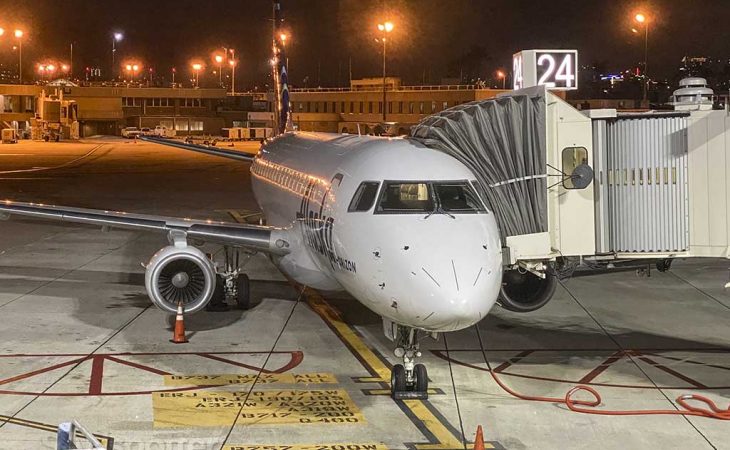
Congratulations! You’re a first time flyer only once in your life, so savor this moment. I clearly remember the very first time I stepped foot on an airplane. It was one of the most memorable days of my entire life.
As a million-mile flyer, my top tips for those who are about to fly for the first time are simple:
- Pack as lightly as possible. There’s nothing worse than showing up at the airport red-faced and flustered because your suitcase is too big for you to handle.
- Arrive at the airport early to allow yourself to move slowly and not feel rushed.
- Limit your intake of liquids before the flight (because having to use the lavatory on the airplane is an advanced-level move).
- Most of all, enjoy the experience! Flying is an amazing thing, and most people take it for granted.
This is just the tip of the iceberg though, so do keep reading for more tips that’ll make your very first flight experience a day to remember (in a good way).
Tips for first time flyers
One of the advantages of being old and crusty is that I’ve flown enough times to have learned all the tips and tricks necessary to get to the airport (and to my destination) as stress-free as possible. These are my most helpful tips for the nervous first time flyer:
1. Before heading to the airport
In my experience, the amount of preparation you do before leaving home can make or break a trip. I can’t count the number of times that I’ve sat at the airport muttering expletives to myself for how stupid I was for not taking the time to prepare better.
Triple check everything!
Triple check that you’ve put everything in your bag that you need before leaving your house. If you need a little help with this, you can see what’s in my carry-on bag to get an idea of the kind of things you may have forgot.
The most important thing you’ll need to bring with you (over anything else) is a valid government issued ID that matches the name on your ticket. I’d recommend a drivers license or a passport. Sorry, student IDs and boba rewards cards are not going to work.
If you’ve already screwed up matching your name to your ticket, don’t worry. I’ve written a full guide explaining how to deal with a misspelled name on an airline ticket .
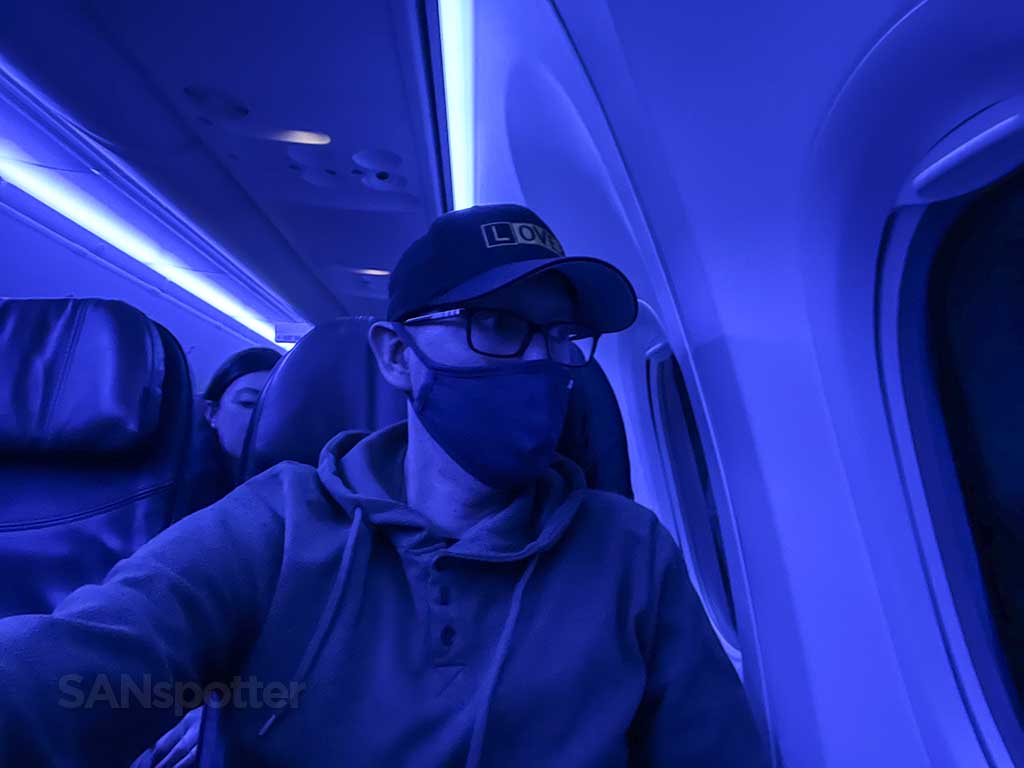
Dress simply
Going through the security checkpoint at the airport will require you to remove any loose clothing (and things like belts and shoes). The simpler your wardrobe, faster you’ll move through the security checkpoint.
Not only that, you’re likely to feel stressed (and flustered) at times as you move through the airport and onto the plane. Ain’t nobody got time for heavy jackets and frilly scarves.
Check in online (if possible)
Even if you have bags to check, checking in online will still save you time at the airport. Checking in online (or via the airline’s mobile app) will allow you to input all of your information before arriving at the airport. The only thing you’ll need to do once you arrive is to sign into the kiosk so that it can spit out a bag tag for you.
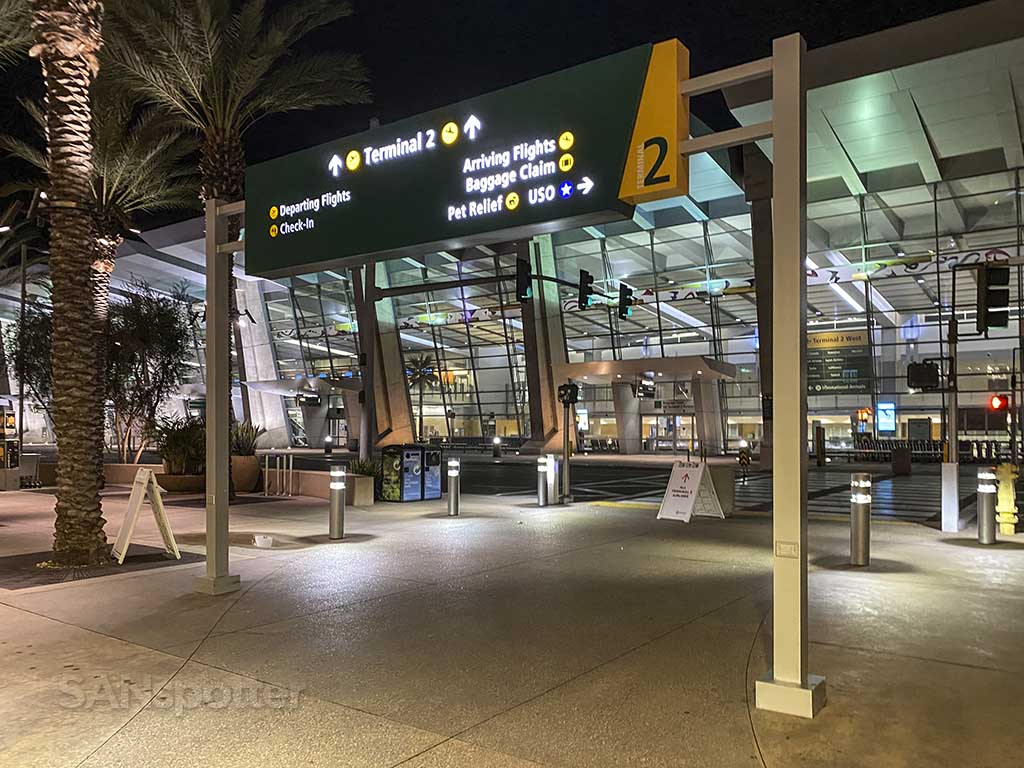
Pack light (and comfortable)
First time flyers often feel the most stressed out in the hours leading up to the flight. Having to manage that stress while pulling two 50 lb suitcases is going to tick you right the heck off. I can promise you that. The lighter you pack, the better.
Additionally, no matter how much stuff you need to bring with you, the important thing is to pack your things in a way that’s most comfortable for you .
Remember: you are going to have to load your bags into and out of cars. You will have to push and pull them around the airport. If putting everything in a cardboard box seems the most natural to you, go ahead and do it. Yes, you can check a box as luggage …
2. At the airport
For the first time flyer, an airport can be a confusing place. T he trick is to focus on one thing at a time and not get distracted by all the sights and sounds. Your first priority when arriving at the airport should be checking in your bags in and obtaining a boarding pass if you don’t have one already. Ignore the Cinnabons. The Cinnabons can come later.
Move as quickly as you can through the security checkpoint
Out of respect for everyone in the long line behind you, be ready move quickly once you reach the conveyor belt at the security checkpoint. Place any loose articles of clothing in one of the provided bins, and make sure everything is out of your pockets.
If you’re flying with medication, you don’t have to worry as long as it’s in the original container with the prescription printed on the label. You may be selected for secondary screening if you use a pill container without labeling.
Eat before you board the plane
Since you’re not likely to served any amount of substantial food on the airplane, it’s best to eat before boarding the plane. You know how I just told you to hold off on the Cinnabons? Well, this is the time to gorge yourself.
To help pass the time as you’re sitting there ingesting 3000 calories worth of cinnamon rolls, you might be interested to learn all about why airport food is so expensive . It’s fascinating.
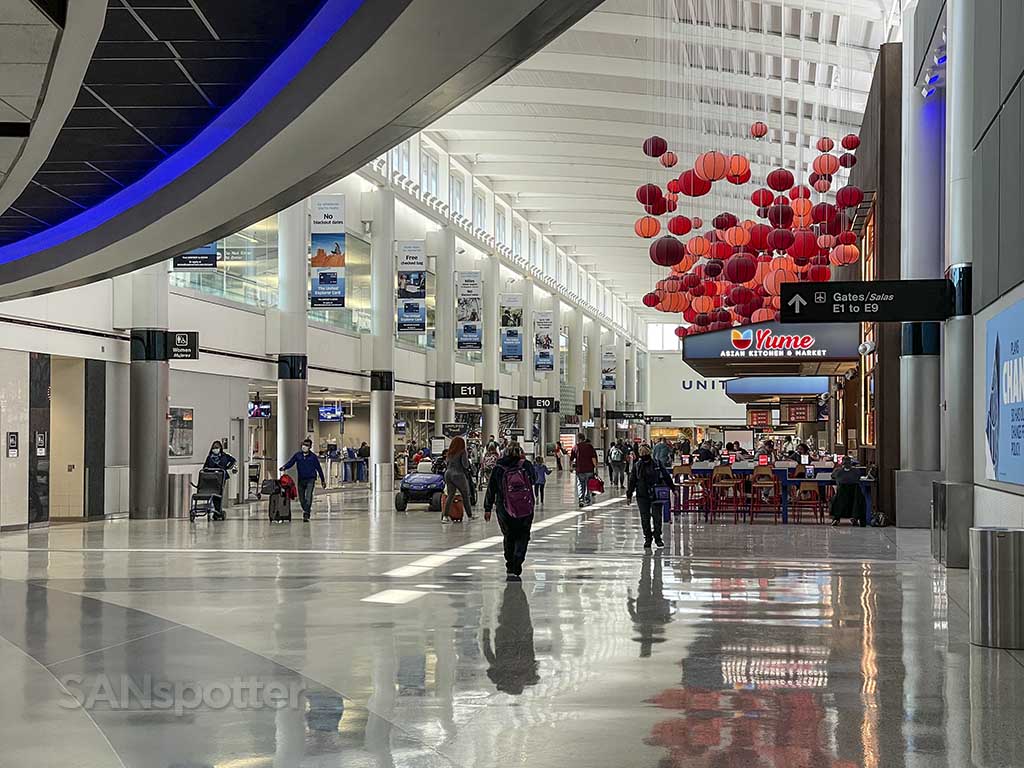
Be at the gate at least 10 minutes before boarding begins
You don’t have to spend all your time at the gate waiting for your flight to start boarding. However, I do recommend that you be there at least 10 minutes before they start the boarding process.
This is when the gate agents are most active. If there are any announcements that need to be made in regards to the flight (such as delays), this is when they tend to do it.
It’s good to know what’s going on so that you can adjust accordingly (if necessary).
Wait until your row / zone number has been called to board
Do not rush the gate as soon as they start the boarding process! Stay back as far as possible until your zone number has been called. Doing otherwise will just create confusion and chaos in the boarding area, and clog up the boarding queue.
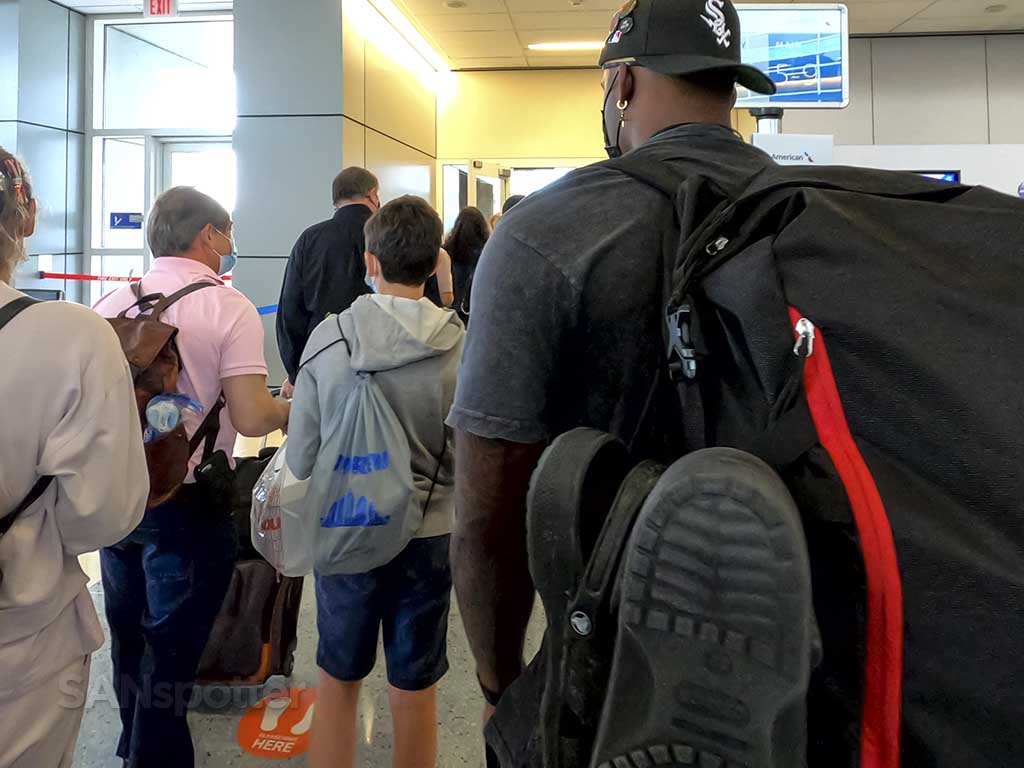
I sometimes prefer to wait until nearly everyone else has boarded the airplane before I board myself. It’s much calmer that way. However, I don’t advise this if you have a somewhat larger carry-on bag, since you will need to find a place to stow it.
In that case, you want to board with your designated zone number so that you’ll have a chance to take advantage of any open overhead bin space. It disappears fast!
3. On the plane
I still remember the first time I stepped onto an airplane. It was a Republic Airlines Boeing 727 at Detroit Metropolitan Airport (DTW), and I was massively upset about the security personnel confiscating my plastic toy gun.
Come to think of it, I think it was my mother who was the most upset. She had no idea that I put it in the suitcase before we left the house, and boy did she look shocked (and scared) when they found it. Sorry mom!

Avoid putting things in the overhead bin if possible
If possible, use the space under the seat in front of you to place your carry-on bag. This will allow you easy access to it (and all its contents) for the entire duration of the flight.
You’d be surprised how large of a bag you can fit under an airplane seat . If you’re curious, my Swiss Gear carry-on easily fits under the seat (even when packed to capacity).
Don’t speak to your seatmate unless spoken to first
I realize this makes me sound introverted and cold, but nothing irritates me more than a chatty seatmate who can’t get the hint that I don’t want to talk. Sure, like conversation is fun and pleasant sometimes, but I guarantee nobody wants to hear your life story and how you got to this exact moment.
Small pleasantries are fine, but make sure you understand the signs of someone not wanting to talk to you. It’s not personal. It’s just the way that most people are these days.
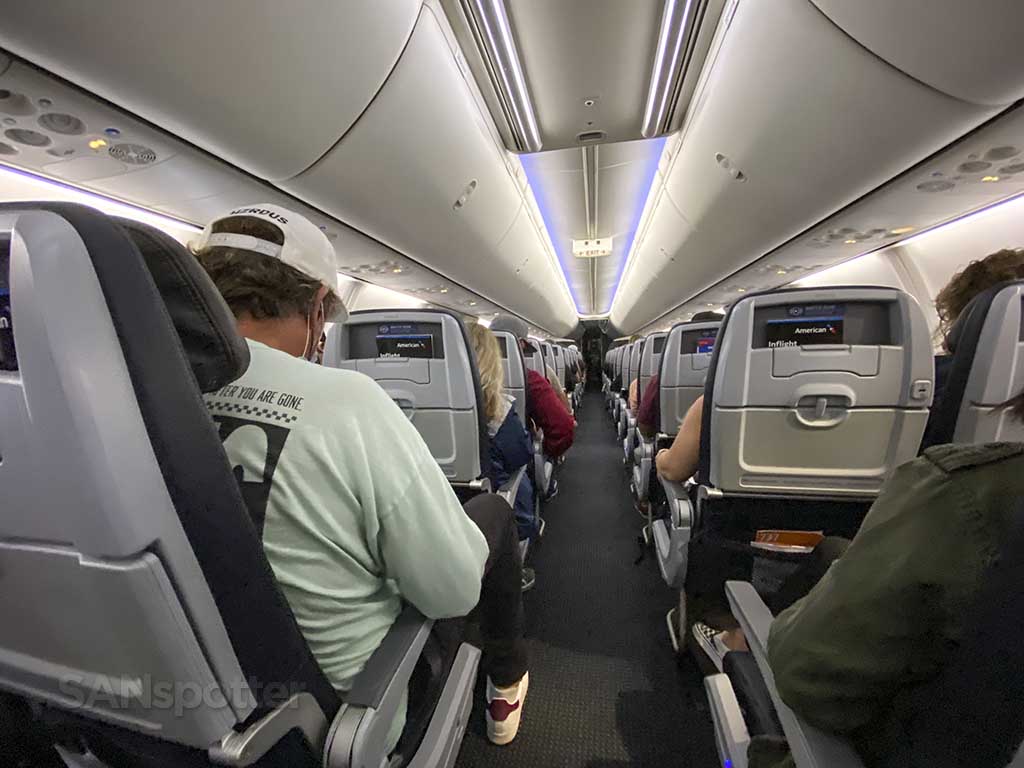
Be prepared when the snack cart arrives at your row
I’m not a flight attendant (nor do I have any desire to be one), but I do know one thing: nothing would grind my gears more than having to repeat all the drink and snack choices over and over for every passenger.
They usually make an announcement beforehand in regards to what snacks and drinks are available. There’s also usually a menu in the seat pocket in front of you with a list of everything. Be nice to your flight attendant and have your mind made up by the time he or she asks you what you would like.
Mind the seat recline
Yes, it’s perfectly OK to recline your seat to your liking. However, it’s extremely rude to do it with no consideration of the person behind you. Have a quick look back before you let it rip. If the person sitting behind you looks stressed out clacking away at a laptop, be respectful and limit your recline. The same goes if they’re trying to eat.
If everything looks good, east back gently. Don’t slam it back. You’ll be quickly identified as and inexperienced first time flyer by doing otherwise. They’ll also probably hate your guts for eternity.
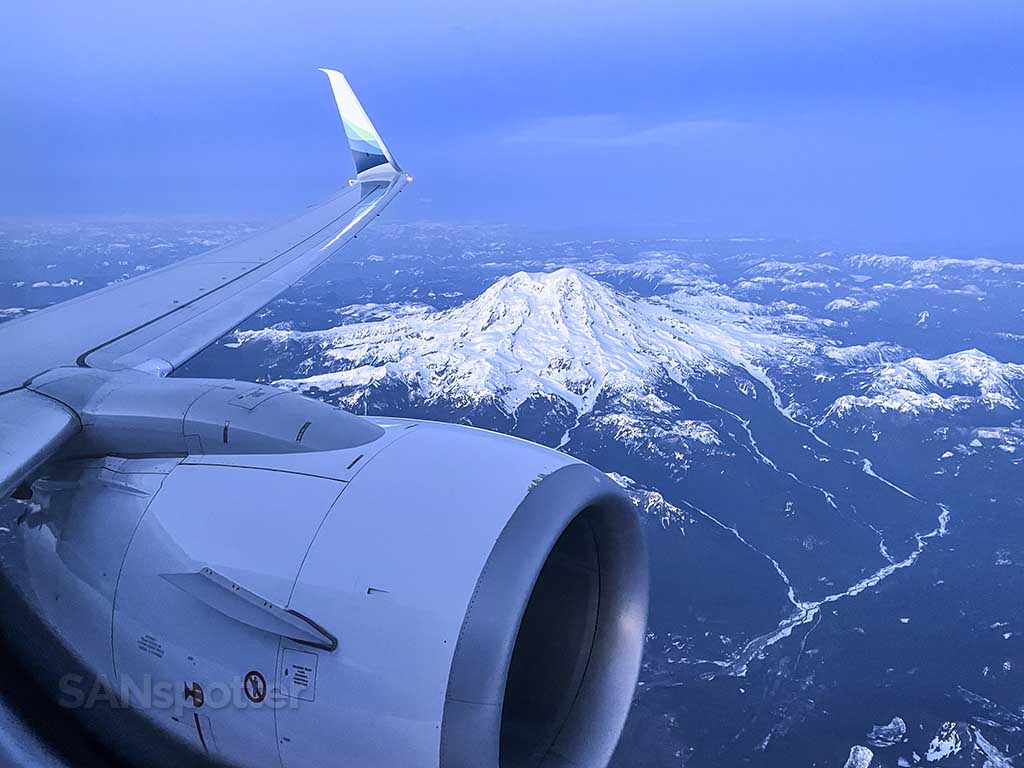
4. Connecting to another flight
Despite how complicated and scary it may sound, connecting from one flight to another is an extremely simple process. It’s not any more complicated than what you had to do to get on your first flight.
Making connections (even at major airports) doesn’t usually take that long. For example:
- A short layover in Detroit is super easy
- A short layover in Minneapolis can be complicated, but easy if you plan ahead
- A short layover in Phoenix is hardly ever a problem
- DFW minimum connection times are lower than you might think
- A 1 hour layover is plenty of time in Denver
- A 1 hour layover is plenty of time in Seattle too
- A short layover in Atlanta isn’t that bad (but you need to hustle)
- 1 hour is the ideal time for a layover in Chicago (ORD)
Check the flight information displays
The first thing you need to do after stepping off your plane and finding a connecting flight is to use the flight information displays that are scattered throughout the terminal. All flight departures will be listed alphabetically, and it’ll tell you not only the departure gate, but the scheduled departure time as well.
It’s also smart to take advantage of the mobile app of the airline that you’re flying. Most airline mobile apps will alert you automatically to your connecting gate information.
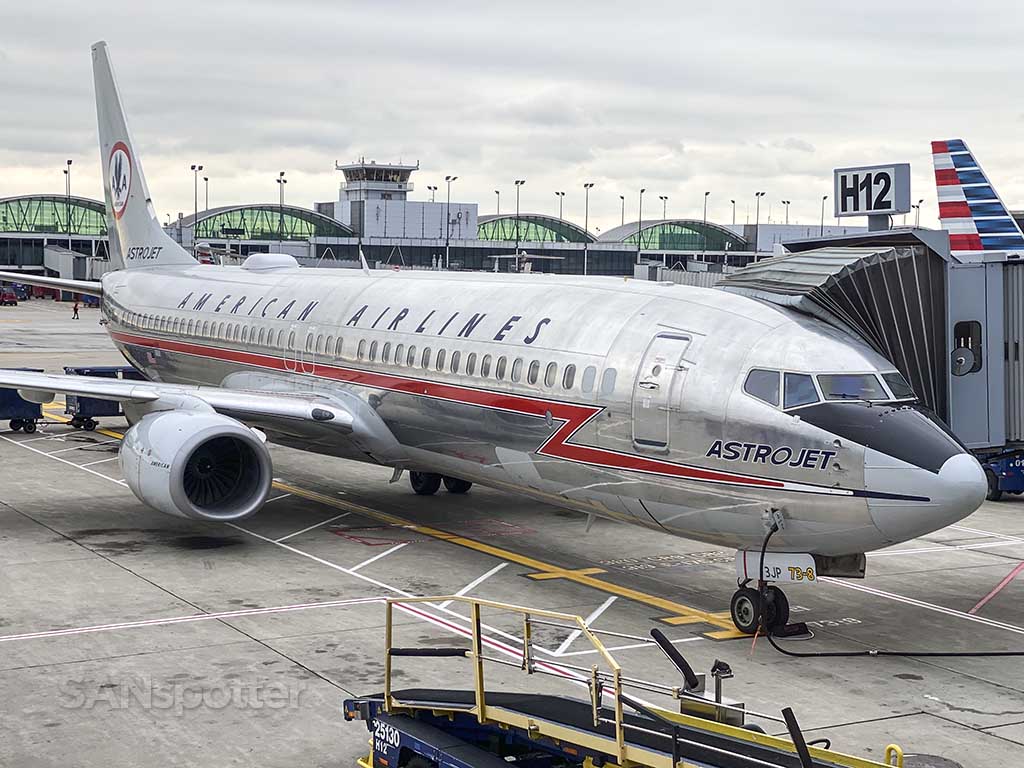
5. Arrival at your destination
See? Flying for the first time wasn’t so bad, was it? The truth is that it’s a really difficult thing to mess up, because there will be airport and airline personnel everywhere to help you out if you get confused. Here are a two final tips to keep in mind:
Be patient when deplaning
You will exit the aircraft from the same door that you boarded it from. That means that the people at the front of the airplane get to get off first, while everyone in the back will have to sit and wait.
One of the most important things to learn about air travel is that patience is key. There will be a lot of sitting around and waiting. And this is especially true if you’re seated at the back of the airplane.
Just stay seated, and have your bag (and your body) ready to move once the people ahead of have cleared the way. If you feel like you need more time, that’s ok too. Just stay out of everyone’s way as you wave them past.
Pro tip: you will look like a total buffoon if you try to hurry up and beat everyone ahead of you. It’s not a race. Just wait your turn.
There’s no rush to collect your checked bags
Easily one of the most frustrating things about flying is retrieving checked bags after a flight. To locate the baggage carousel, just follow the signs for “airport exit” and “baggage claim.” They’ll be everywhere.
However, it’s important to know that it can take up to 30 minutes for your bags to arrive. Therefore, take your time. As a matter fact, now might be a pretty good time to grab another Cinnabon. Because well, you totally deserve it.
Other stuff you might like:
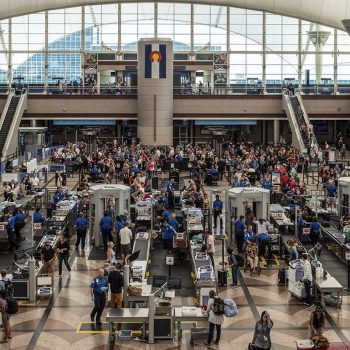
Do airport scanners detect drugs? (I won’t judge you for clicking on this)
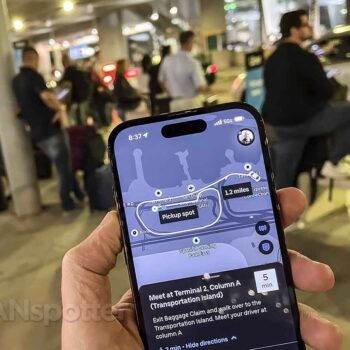
How to use Uber at the San Diego Airport (caution: it’s a bit different)
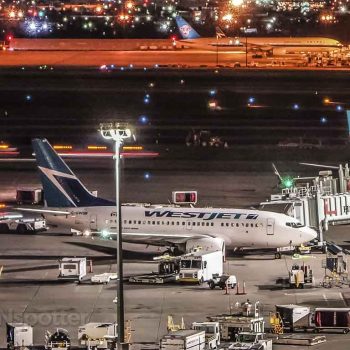
Is a 1 hour layover enough time in Toronto? Not always. Here’s why:
Comments (4).
This is so helpful! I’ll be flying for the first time ever for a trip in January at the tender age of 23. This is the first First Time Flyer guide I’ve seen that didn’t make me even more anxious about everything. Thank you Scott!
Scott (SANspotter)
You’re very welcome Caleb! Enjoyed your trip!
If you’re travelling with a laptop, camera, or anything with a battery larger than those found in tablets, triple check their power rating, know where on the sticker the power rating is, and preferably take the battery out or know how to take the battery out. TSA officers will see the battery on their scanners, some are lax, others will try and make a fuss about it. The numbers on the stickers don’t lie, though.
This applies to economy class, but don’t go with your favorite or even second favorite drink when the catering cart comes around. You’d get a sip of coke or pepsi at best if you ask for the popular drinks, but your chances of getting the whole can is much higher if you ask for a canada dry.
The seats in economy class (I seem to fly a lot of economy, don’t I? lol) seem a lot wider than they are long. Know how to loosen the seat belts, exploit the headrests (American economy seats at least let you adjust them), etc. to make yourself comfy. Just don’t hog the armrests (leaving the center armrests for the poor soul in the center seat is a good idea) and be gentle when reclining; you’d hate to have your hot coffee splashed onto your laptop when the guy in front reclines, right?
Getting to know the flight attendants on long haul flights can be advantageous. At the least you would spark a nice conversation the next time you head to the restrooms, sometimes you may find yourself with an upgraded meal, better service, or all sorts of friendly tokens if you take the time to see them as fellow humans and not as your personal assistant.
Oh, and just avoid LGA. And EWR. Screw it, if it’s not JFK, just fly to IAD/BOS and take Amtrak to New York.
All really good tips Kelly! Thanks for taking the time to write this out – I’m sure it’ll be helpful to many.
Give a Comment Cancel Reply
This site uses Akismet to reduce spam. Learn how your comment data is processed .

First Time Flyer Tips
Explore Today's Deals
Tips to Help you Navigate the World of Flying
If you are flying for the first time, or even just a little rusty, don't be afraid. Everyone has to have their first flight experience! More likely than not, you will love the experience and learn how to be a more efficient traveler for future flights.
There are several things to consider before embarking on your first flight , including packing, how you get to the airport/how early you leave, what you need to present to the ticket desk, how to easily get through security, what to expect on the plane, and how to deal with delays, cancellations and other unexpected events.
To help ease your journey, here are some essential tips for first-time flyers:
1. Plan and Prepare
Before your flight, make sure you have all your travel documents such as your passport , boarding pass, and identification . Double-check your flight details, terminal, and gate information. Arrive at the airport well in advance to allow for unexpected delays.
2. Pack Smart
Be mindful of baggage restrictions and pack accordingly. Keep your essentials like medications, important documents, and a change of clothes in your carry-on bag. Avoid packing prohibited items in both your carry-on and checked luggage.
3. Dress Comfortably
Choose comfortable clothing and shoes for your flight. Layers are a good idea as temperatures can vary on the plane. Slip-on shoes can also make going through security checks more convenient.
4. Security and Check-in
Follow security procedures by placing your liquids in a quart-sized bag, removing your electronics from your bag, and cooperating with security personnel. Check in online if possible to save time at the airport.
5. Be Mindful of Health
Stay hydrated during the flight by drinking water, and avoid excessive caffeine and alcohol. Walk around and do simple exercises to prevent stiffness and improve blood circulation. Consider using a neck pillow for added comfort.
6. Familiarize Yourself with Flying
Understand the basics of flying, such as cabin pressure changes during takeoff and landing. The feeling of ear discomfort can be eased by chewing gum, swallowing, or using specialized earplugs designed for air travel.
7. Entertainment and Essentials
Bring along entertainment options like books, music, or movies to pass the time. Don't forget essentials like headphones, chargers, and any necessary medications.
8. Respect Cabin Crew and Fellow Passengers
Follow the instructions of the cabin crew and treat fellow passengers with courtesy. Keep noise levels down and be mindful of personal space.
9. Relax and Enjoy the Experience
Take a deep breath, relax, and enjoy the experience of flying. It's a unique opportunity to see the world from a different perspective. Use the time to unwind and reflect.
Remember, flying for the first time can be a bit overwhelming, but with these tips, you'll be better prepared to have a smooth and enjoyable journey. Bon voyage!
The FAQ section below will help you to navigate your first flight experience, check it out! Before you do, you might want to familiarize yourself with some of the terms used for air travel and check out this handy flying checklist that summarizes what you should know before you leave the house.
Find more help here for your journey through the airport
Home » Travel Tips
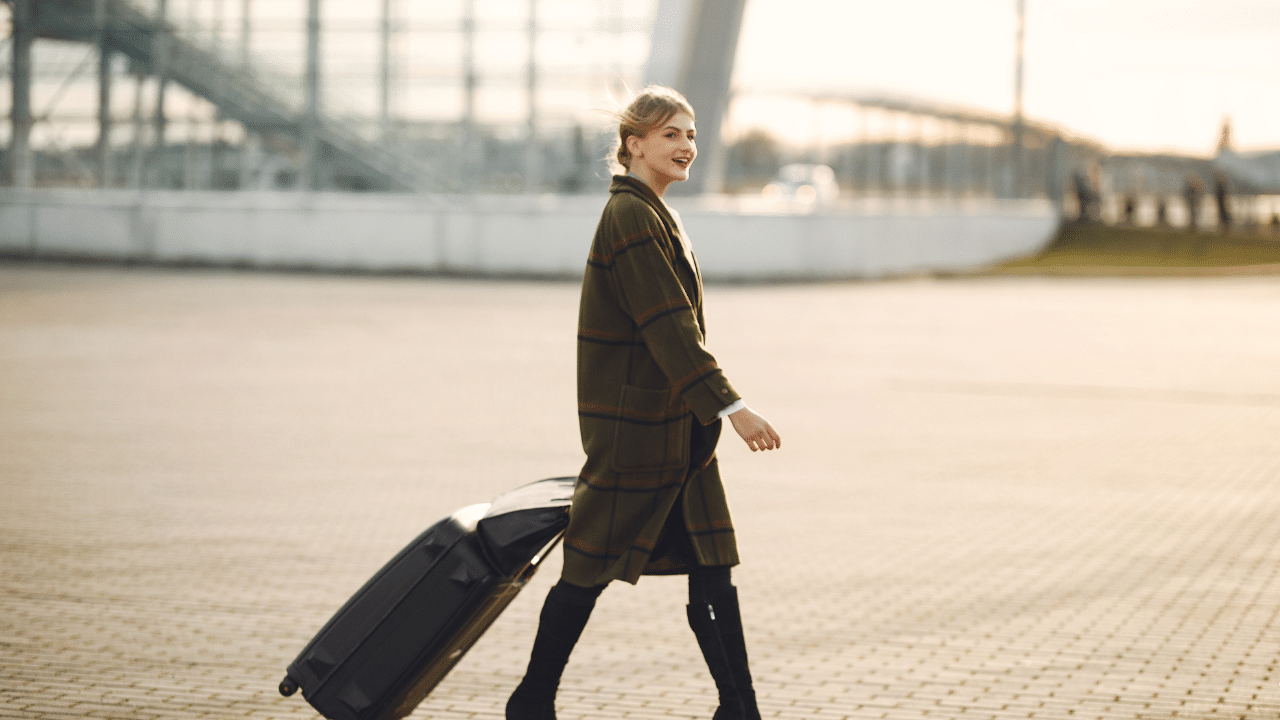
15 Essential Tips for First-Time Flyers + Must-Know FAQs to Navigate the Skies with Ease
Gearing up for your first-ever flight? Whether you’re headed international or somewhere closer to home, taking your first flight can feel a bit daunting. Of course, that doesn’t mean it has to be. Flying isn’t half as scary as some first-timers think it is. But we’re all about making travel easier, including for the uninitiated. So, we’ve compiled a list of the best tips and answers to the most frequent questions for first-time flyers. It doesn’t matter if it’s your first time at 30,000 feet. This essential guide for first-time flyers will make it feel like the 30th time.
Table of Contents
15 tips for first-time flyers, first-time flyer faqs, 4 tips to go from first timer to frequent flyer.
Flying comes with its fair share of do’s and don’ts, and figuring out what they all are can be super stressful when you’re thinking of flying for the first time. So rather than scouring the internet, we’ve compiled a list of 15 of the most essential tips for first-time flyers to help you conquer your first flight with ease.
10 DO’s for First-Time Flyers
From the obvious to the obscure to the easily forgotten, here are ten tips every first-time flyer can do to make their first flight more stress-free before even leaving the house.
Do: Check-in Online

Make your trip easier by checking in online. Most airlines allow you to check in 24 hours before your flight. You’ll then receive a digital boarding pass with your flight number and gate. A digital boarding pass allows you to skip the long check-in lines at the airport and will often update itself if your gate number changes.
Do: Arrive Early at the Airport
Unexpected traffic delays and long security lines are just a few reasons you should plan to arrive at the airport early . The rule of thumb is it’s best to arrive at least two hours before your flight. However, this can change depending on several factors, like whether the flight is domestic or international and what time of year you’re flying. Plan to arrive even earlier if you’re heading out on an international flight instead of a domestic one. Big international airports can be a hassle due to their sheer size. In addition, longer check-in and security lines can make navigating the airport a slog. In short, it’s better to be safe than sorry.
Do: Keep Your ID Handy

From check-in to boarding the plane, your ID will make an appearance several times as you make your way through the airport. So it’s important to have it readily available. The last thing you want is to be fumbling to get your ID out of however many zippered pockets it’s tucked away in while the TSA officer stares you down and the growing line behind you starts grumbling in your ear. Having your ID easily accessible will speed up the process of moving through the many checkpoints and help you get through security faster.
Do: Wear Shoes That Are Easy to Remove
Unless you have TSA PreCheck, you must remove your shoes during the security check. Wearing shoes that easily slip off, such as sandals or sneakers, is a must for saving time and getting through security quickly. While you’re at it, plan to wear socks with your shoes if possible so you’re not walking over the cold and presumably dirty airport floor with your bare feet.
Do: Pack Essentials in Your Carry-On

This is one of the most essential tips for first-time flyers we can share. Imagine the airport loses your luggage; just like that, your laptop, contacts, medicine, and all your clothes are gone. That’s why it’s a good idea to pack all those essentials in a carry-on so they travel with you on the plane. If you don’t have a carry-on, try fitting these items and a few clothes in your personal bag, which all airlines allow passengers to bring aboard. A personal item must fit under the seat in front of you. While it doesn’t seem very impressive, you may be surprised just how much you can fit in such a small space.
Do: Check That Your Baggage Fits the Airline Requirements
Baggage requirements differ by airline, so unfortunately, there isn’t a one-size-fits-all you can apply to every flight unless you’re always flying with the same carrier. That goes for checked baggage and carry-on luggage, but almost all airlines allow a personal item that fits under the seat in front. As for checked bags and carry-ons, it varies. Sizes, weights, and what is included for free can change from carrier to carrier and based on your ticket fare. Always look up the requirements and double-check that the luggage you bring fits them so you don’t have to pay a fee or throw things out because you’re over the weight limit.
Do: Pack Layers for the Plane

Airplanes can often get chilly, especially if you have a seatmate with the air on full blast. Plan to bring a few layers, such as a cardigan, jacket, or even a blanket, onto the plane with you. Another thing to keep in mind is where you’re flying to. Suppose it’s a pleasant 69 degrees in Florida, and you’re heading to a frigid 19 degrees in New York. In that case, you’ll want to have something for deboarding and heading to the parking garage. The reverse is also true. Being able to shed some layers in the airport restroom before heading outside into the blistering heat will make your weather transitions more comfortable.
Do: Stay Up-to-Date on Your Itinerary and Flight Status
Flight statuses change all the time. Sometimes, your plane might be delayed getting in, or it could be delayed at the gate. Whatever the case is, it can affect when you’re scheduled to depart. So, it’s best to keep an eye on your flight status. The most convenient place to check is online/on the airline app. It’s helpful to know before you leave the house and even while wandering the airport if your flight is on schedule so you can be at the gate when it’s time to board.
It’s also helpful to provide your flight information to anyone picking you up. By tracking delays and your estimated arrival time, they can coordinate when to arrive instead of being forced to circle the lot while waiting for your plane to land.
Do: Bring Your Own In-Flight Entertainment and Comfort

Flights can be long, and not every flight or every airline promises in-flight entertainment—unless you’re flying JetBlue . So bringing your own is a must. Pack your phone or tablet with your favorite movies or shows already downloaded so you can watch offline. Not every airline provides free Wi-Fi either. This is also a great time to download your favorite playlist, podcast, or audiobook, and nothing beats a good old paperback.
If you plan to sleep the hours away, don’t forget the little things to make nodding off a bit easier, like a neck pillow, noise-canceling headphones or earplugs, and an eye mask. You can spend your first time at 30,000 feet nodding off among the clouds.
Do: Pack Food and Water
Hydration is key when traveling, especially on long international flights. Pack an empty water bottle, plastic or metal, and fill it up after security. Just be sure there’s nothing in it on your way through, or you’ll have to dump it/throw it away. This can also help you avoid purchasing water at the airport, where it’s more expensive—and if this is your first time through the airport, you’ll be unpleasantly surprised by how much. Additionally, you’ll have a full bottle of water for the airplane, so you don’t have to rely on the flight attendants for a drink.
Speaking of which, if the idea of pretzels or nuts as a complimentary snack doesn’t make your mouth water, consider bringing some of your favorite snacks aboard the plane. Homemade trail mix, your favorite cereal in a baggie, granola bars, and even candy bars can be brought through security in a sealed bag or container.
5 DON’Ts for First-Time Flyers
Just as every good list of tips has its do’s, there are quite a few important don’ts that all first-time flyers need to keep in mind. So before you buckle up, and even before you pack up, here are five key tips for things that first-time flyers should NEVER do.
Don’t: Forget Your Travel Documents

Your travel documents are your gateway to the world. If you leave them behind or lose them, you could be denied boarding or barred from entering your destination. So before you leave, do a document check.
- Driver’s license (or other accepted REAL-ID )
- Travel visa
In addition, double-check that you have digital versions of your boarding pass, travel itineraries/confirmations, and travel insurance. Keep in mind that while you can get a physical copy of your boarding pass printed at the airport, some airlines charge a fee to check in and have your boarding pass printed at the airport.
Don’t: Overpack
Overpacking is a cardinal sin of flying. And while it’s easy to forget, this is one thing that immediately costs you—quite literally. Airlines love charging overweight baggage fees; you could even get stopped at security if your carry-on bag is too overstuffed. So, to avoid the additional fees and added stress, be meticulous about your packing list, even downright cutthroat if you have to. Focus on reusable pieces you can layer or mix and match, and don’t pack twice as many outfits as you’ll actually need for your trip.
Don’t: Forget to Weigh Your Bags at Home

This tip for first-time flyers does a bit of piggybacking off the last one: Don’t forget to weigh your bags at home. If you overpack, you risk exceeding the permitted weight limit and getting hit with excess baggage fees. These often cost more and sometimes even double the original baggage fee! You don’t need anything fancy here, just a regular scale to give you a ballpark estimate of how much your bag weighs and ensure it’s coming in under the weight limit for your airline.
Don’t: Leave Your Bags Unattended
This is a universal rule you’ll hear shared over the airport loudspeakers from time to time. And while it seems pretty commonsense, you may be surprised how often it happens, between quick trips to the restroom and last-minute food runs. Leaving your bags unattended may seem innocuous, but it poses a major security risk to the airport and could result in security confiscating your bags. So, to prevent that and avoid getting caught up in security issues, always keep your bags with you at the airport.
Don’t: Ignore the Safety Briefing

If it’s your first time on a plane, then one thing you shouldn’t do is ignore the safety briefing. Flight attendants go over this before every flight. While you might see seasoned flyers checked out during this time, the information conveyed is invaluable for first-time flyers. The safety briefing outlines what to do in case of an emergency and where the exits are located, a key piece of information to know in the unlikely event that the plane is evacuated.
Now that you’re well-versed in all the must-know tips for first-time flyers, you may still be left with some questions. That’s normal. Flying can be a lot, and it’s not always easy knowing what you need to know. So here are some popular questions that often come up for first-time flyers.
Do I Need Travel Insurance?

After all the time and money you put into your trip, you don’t want it all to go to waste. In that regard, travel insurance is a great addition to any flyer’s checklist, especially if you’re dealing with the anxieties of your first flight. Travel insurance can offer added peace of mind as you try to navigate this new experience.
Some travel cards come with insurance coverage for travel purchases made on that card. However, it’s important to note these insurances often have limited coverage. You might feel more comfortable getting separate travel insurance for your trip depending on the amount of time and money you put into it.
Next Vacay Pro-Tip: Travel insurance isn’t the only way to protect your trip. Set yourself up for success by arriving early, planning for possible setbacks like missing your flight , and setting aside an emergency cash fund for any unforeseen expenses that crop up.
What’s the Security Screening Process Like?

First-time flyers might be anxious about the screening process, but in truth, it’s nothing to be nervous about. Travelers without TSA PreCheck enter the standard line and must present a license (or other approved form of ID) and their boarding pass to the TSA agent. Have these out when you get there. After getting waved through, you’ll go through the screening process. This involves removing your shoes and putting your items on the conveyor belt to pass through the X-ray.
Once all your items are prepped for screening, you’ll wait for the TSA agent’s OK and step into an X-ray machine. Directions are usually posted on the machine so you know exactly where and how to stand. If there are any bulky spots on your clothes or you’re wearing your hair in a bun, you may be waived to the side for a pat down. Don’t be nervous. This happens more often than you might think. Once you’re checked over and cleared, you can gather your items, slip into your shoes, and you’ll be on your way.
How Do I Get Through Security Screening Faster?
Making sure you’re ready to go through security ensures you get through smoothly when it’s your turn. Double-check that your liquids don’t exceed 3.4 ounces and all fit in a clear, quart-sized bag. Don’t forget to empty your pockets and remove any extra layers before going through screening. Electronics and your personal item go in security trays. Shoes go directly on the belt. In addition, try wearing an easy hairstyle and non-bulky clothing to avoid a pat down.
What’s the Best Luggage to Travel With?

The best luggage to travel with is a carry-on bag . Why you might ask? The answer is many reasons. The first is that carry-on luggage goes on the plane with you, thus eliminating the hassle of checking a bag, including picking it up upon arrival or having the airline lose it entirely. It also cuts down on costs, as flight prices rarely include baggage. Lastly, it’s a great reminder to pack light and only take what you need on your vacation.
Where Should a First-Time Flyer Sit?
There’s no one-size-fits-all seat for first-time flyers. It all comes down to what will be most comfortable for you. If you’re worried about turbulence, try nabbing a seat in the middle over the wings of the plane. If you want more legroom, try the emergency exits. However, bear in mind that you have to be over 16 years old to sit in the emergency exit rows, and you’ll be expected to assist in case of emergencies. If you’re worried your seat could make or break your first flight experience, check out these pro tips for choosing the best seats on a plane.
What’s the Difference Between a Nonstop and a Connecting Flight?

Despite both getting you from point A to point B, nonstop and connecting flights offer very different experiences. Nonstop flights mean exactly that. There are no stops between your first and final destination before you arrive at point B, meaning you travel in a relatively straight line. On the other hand, connecting flights often involve a detour, a point AB if you will, at which you usually have to deboard and board another plane to reach your final destination.
As a first-time flyer, purchasing your first flight and choosing between a nonstop flight and a connecting one can be challenging. While nonstop flights offer convenience and less stress, they can be pricier, and depending on the route, there are fewer available. In contrast, connecting flights provide many more options and flexibility with departure and arrival times. Still, the stress of having to catch a connecting flight could get your vacation off to a shaky start.
How Does the Boarding Process Work?

Most flights begin boarding 30-50 minutes before departure. Domestic flights usually board closer to the departure time. In contrast, international flights begin boarding a bit earlier to accommodate the larger plane sizes.
Airlines often board in groups, which they designate on your boarding pass. When your boarding group is called, you’ll line up with other passengers in your group to board the plane. You’ll scan your boarding pass one last time with the gate agent and then pass through the door to the jetbridge to board. Most airlines will close the gate door 15 minutes before departure to ensure they remain on schedule, so here’s an important tip for first-time flyers: Don’t be late!
Travel pros can make flying look effortless. Want to know how they do it? It doesn’t take much to get good at flying. And once you’ve ingrained the tips for first-time flyers into your brain, all that’s left is a few extra steps that can take you from an anxious first-timer to a calm and collected frequent flyer.
1. Join an Airline Rewards Program
Airline loyalty programs deliver significant perks , including free checked bags, priority seat selection, complimentary upgrades, and more. If you plan to turn your first flight into the first of many flights, joining an airline rewards program, or several, will ensure you get the most out of your miles. Joining is free and usually hassle-free. You can get set up in minutes and immediately start earning points with your very first flight. Some airlines, like Delta, even let you do it before by earning miles through partners, online shopping portals, and more. An airline rewards program is the way to go if you want to make future travel more comfortable and rewarding.
2. Get a Travel Credit Card

Travel credit cards are even more flexible than airline rewards programs, allowing you to earn points on travel and non-travel-related purchases. Travelers can choose between airline credit cards, hotel credit cards, and non-branded travel cards. Non-branded are the most flexible for earning and redeeming points as they work with various partners, not just one specific airline or hotel. While utilizing travel rewards is a bit of an art, it’s one worth learning to save hundreds of dollars on your future trips.
3. Apply for TSA PreCheck / Global Entry
Signing up for TSA PreCheck and/or Global Entry is your ticket to a stress-free security check and customs process. These government programs require an interview and application fee but include noteworthy benefits, like expedited security and customs lines and reduced wait times. If you want to decrease your time at the airport, TSA PreCheck and Global Entry are the way to go.
If you’re considering both, Global Entry is the better option. The application fee costs $100, only $22 more than TSA PreCheck, and includes TSA PreCheck as one of its benefits. So, whether you’re leaving the country or coming home, Global Entry makes getting through the airport a breeze .
4. Sign up for Next Vacay

Want to save big on your first flight and every flight after? Here’s the biggest tip for first-time flyers: Sign up for Next Vacay.
Rather than stressing over finding the perfect flight—on top of taking your first flight and making sure it all goes off without a hitch—leave the flight searching to the professionals. Next Vacay has an entire team dedicated to finding the best deals to destinations all over the world and screening those deals for price, comfort, flexibility, and more. On top of all that, our team delivers those hand-vetted deals directly to your inbox, so you don’t have to do anything except book.
It’s never been easier to save money and travel the world. So start dreaming bigger and traveling farther than ever before…with Next Vacay .
Get Secret Flight Deals
Related Posts
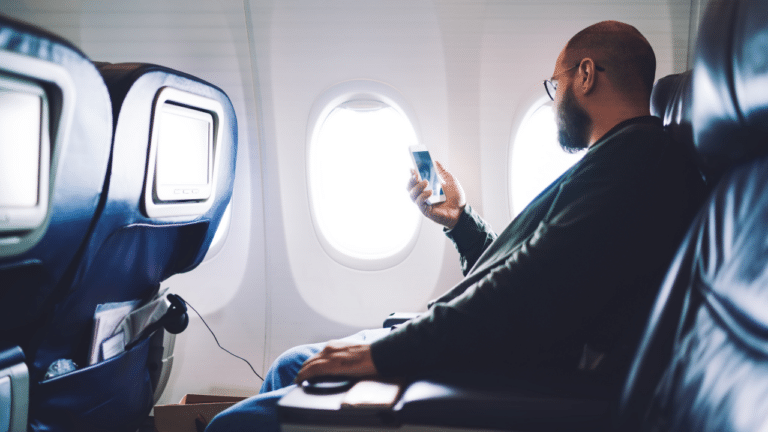
A travel & food blog
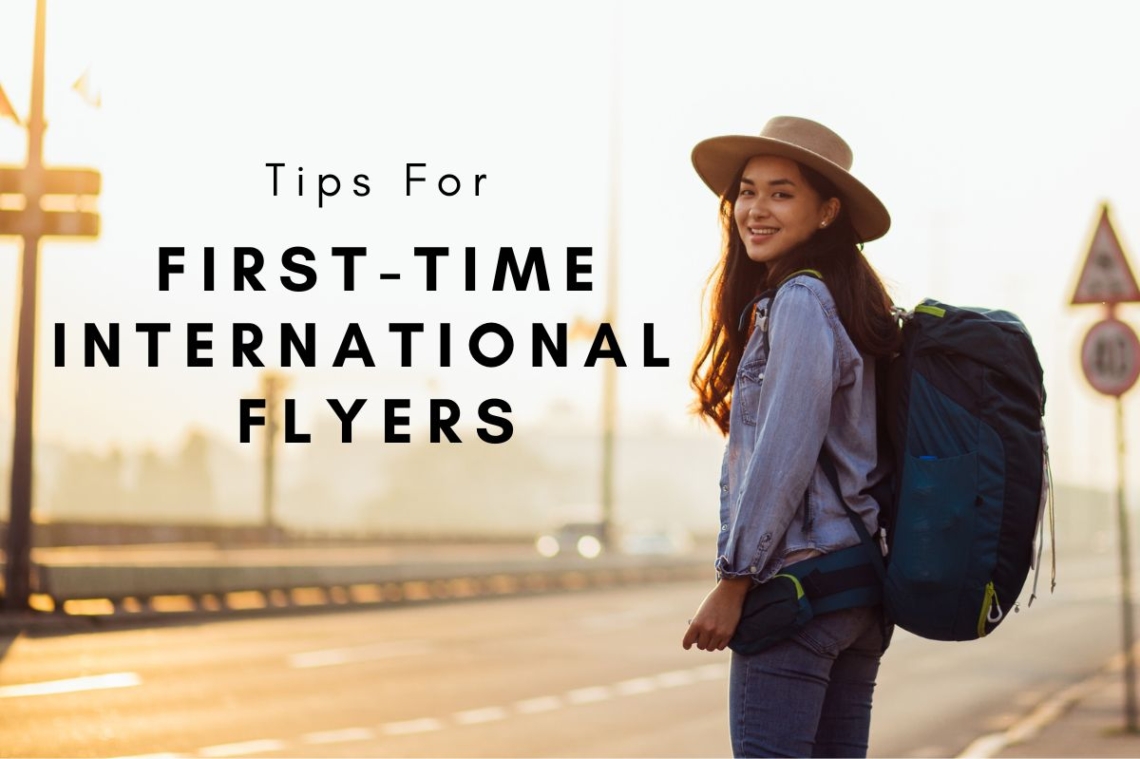
15 Essential Tips for First-Time International Flyers
If it’s your first time to get on an international flight, you might be feeling worried and stressed. Don’t worry – this is perfectly normal! Flying internationally can be daunting, but as with everything else, it gets easy with once you’re used to it. Here we’ve compiled the best tips for first-time international flyers you should read before your trip!
P.S. Make sure to book your tickets early! You can get cheap flights by booking months ahead or during off-season travel. If you’re willing to travel at night, red-eye flights are also much cheaper compared to regular-hour flights.
Other immigration requirements
2. keep a screenshot of everything, 3. get to the airport early, 4. inform your banks where you are going, 5. pack your essentials in your carry-on, 6. dress comfortably, 7. bring your book/kindle/movie, 8. stay hydrated, 9. choose a good seat, 10. sleep well in flight, 11. be smart in handling conversations, 12. pay attention to arrowheads and signs, 13. check what you can and can’t bring to your destination, 14. plan for leaving the airport after arrival, 15. have fun, 1. prepare your travel documents.
The documents you should bring at the airport are: ID, passport and visa (if required), itinerary, and other pandemic-related paperwork if necessary. A travel wallet comes in handy for organizing and packing your documents in one place.
Please enable JavaScript

Many countries require a passport with 6 months validity. If you’ve had your passport for a while, check that it still passes this requirement. Otherwise, you may need to schedule for a renewal ASAP.
This might seem like an obvious tip, but it’s not uncommon for people to overlook this and only realize they are holding an outdated passport at the airport.
Countries have different visa requirements. Some will require you to get a visa in advance, and some countries offer visa upon arrival.
If you’re living in the Philippines, take note that ASEAN countries are usually visa-free for the first 30 days. Other Asian countries like South Korea and Japan will require you to process your visa weeks in advance.
Many countries require proof of onward or return flight. Some may also ask for proof of hotel booking and itinerary. It’s easy to find this information in tourism websites and even social media.
With the pandemic, some countries have put up additional requirements , such as proof of vaccination and/or declaration via a health application.

Keep a digital copy of your important documents such as passport and visa, so you have a back-up in case your papers get lost. Screenshots of your hotel bookings and itinerary are also helpful in case you find yourself without online connection.
For international flights, you should be at the airport at least 3 hours before your check in. If you’re traveling on holidays and peak season, you may need to arrive at least 4-5 hours earlier because of long queues.
The Philippines immigration is particularly strict on first-timer flyers doing leisure travel, so it’s best to give time allowance in case you are held up in the immigration office.
Tell your banks where you are going (dates and country) to ensure your credit cards and debit cards will still work to get out cash. Finding yourself with declined transactions and no cash in hand can be a hassle.
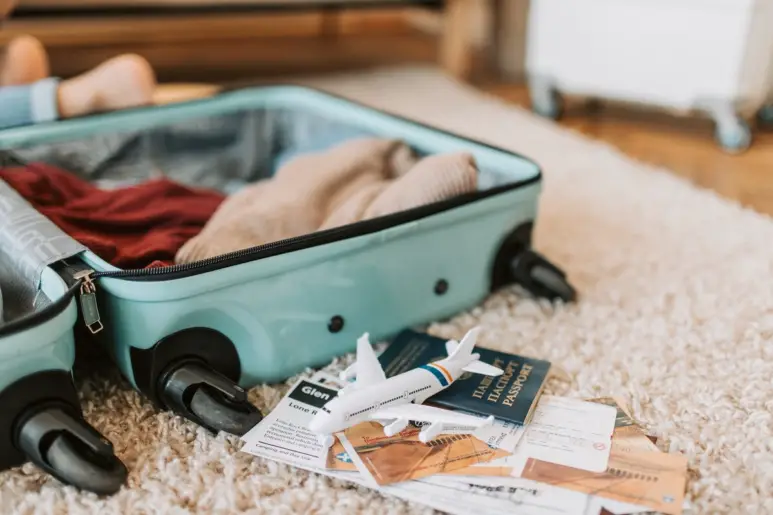
Your documents, money, and other essentials such as phone, powerbank, and charger should be packed in your carry-on. A set of overnight clothes and toiletries also come in handy in case you get stranded. If you have multiple connections, a pair of extra underwear and socks will help you feel fresh and clean on arrival.
Another thing that you should remember to pack is any necessary medication you might need.
There is no dress code at the airport so you can dress comfortably, but it’s also good sense not to wear anything too revealing, which airport security might find issue with. There had been instances of women wearing small tops that were not allowed to get on the flight.
Bringing a shawl or jacket or dressing in layers are also recommended since most airports are chilly.
There’s a lot of waiting in airports. Having a good book or movie in your phone or laptop makes a lot of difference when you’re waiting at the boarding area and during your flight. Oftentimes, flights get delayed and those extra hours will be more tolerable if you have entertainment at hand.
Bring an empty water bottle with you and refill it inside the airport, so you can avoid expensive water bottles at the airport shops.
It’s best to choose either the window seat or the aisle seat. The middle seat is usually cramped, which can be uncomfortable especially in long flights. Choose the aisle seat if you’re someone who needs to go to the toilet a lot.
If you have pre-booked your seats, make sure they are not located in front of emergency exits because those seats do not recline.
Eye mask, earplugs, and neck pillows are great for sleeping during your flight. Having a neck pillow is particularly useful because it offers support and it prevents your head from flopping around while you sleep.
Be polite with the airport and immigration staff, they can make the airport experience easier or harder for you.
Feel free to make small talk with people; maybe you’ll even meet a new travel acquaintance! But stop talking if they appear disinterested. If the person comes across as suspicious or creepy, be smart — do not answer personal questions, such as where you are staying in your next destination, and firmly cut off the conversation.
If you’re uncomfortable with a fellow passenger and you believe your concerns are right and valid, the flight attendants are your friend. Flag one down and let them know your situation. They may be able to help you find another seat depending on the seat capacity.
On the other hand, it’s equally valid to avoid conversations if you do not want to talk to other people. Keep your headphones on and do your own thing.
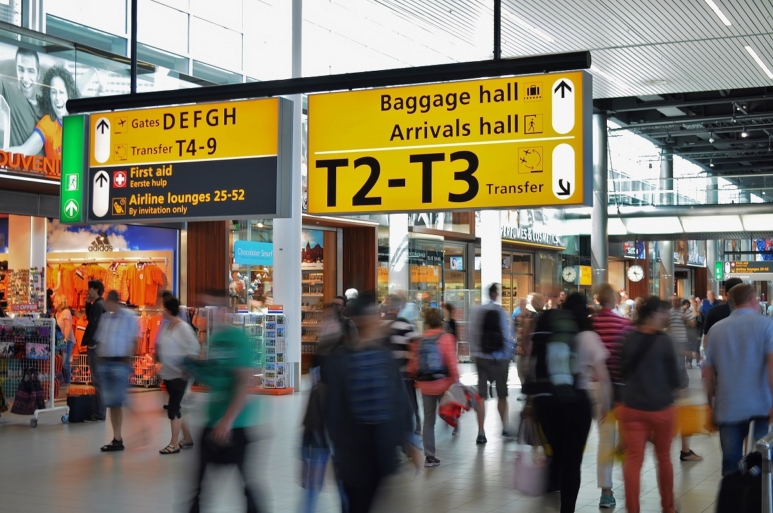
International airports can be disorienting. If you’re arriving on a non-English-speaking country, you don’t have to worry. Almost always there are English signs and arrowheads to help you get your bearing. Most are positioned overhead, while some may be obscured behind columns.
If you still get lost, don’t be afraid to approach airport employees for help.
Do your homework and check what items you can and can’t bring to your destination. For instance, Maldives is a popular tropical destination but what most people don’t know is that it’s a Muslim country , so items like alcohol and idols of worship are not allowed into the country. These items will be confiscated and given back on your departure date.
It’s a good idea to be familiar with the various transport services available in the airport so you can get to your hotel or resort. Even if something goes wrong with our pre-arranged pick-up, you know what your options are. Research about the taxi services, public bus routes and schedules, and availability of riding apps such as Grab.
Going on an international flight for the first time can be daunting, but try not to worry too much and don’t forget to enjoy your trip!
That ends our list of essential tips for first-time international flyers! Do you have anything to add? Let us know in the comments section below!
Get discounts on your travels!

Enjoy discounts with KLOOK using our promo code: TARALETSANYWHERE

Katherine Cortes is a long-time backpacker and a freelance writer/editor. She likes beaches, snorkeling trips, and relaxing staycations (preferably with bath tubs!).

Leave a Reply Cancel reply
Your email address will not be published. Required fields are marked *
Save my name, email, and website in this browser for the next time I comment.
Notify me of follow-up comments by email.
Notify me of new posts by email.
This site uses Akismet to reduce spam. Learn how your comment data is processed .


- Destinations
- United Arab Emirates
- United Kingdom
- United States
Tips For First-Time Flyers
Getting ready to jet off on your first holiday is something we all look forward to, but the process of reaching your destination may not always be so luxurious. For many travellers, flying for the first time is an anxiety inducing experience, but there is no need to be nervous about the start of your journey, as you can set your mind at ease with a simple bit of preparation. These top tips for first-time flyers will ensure you can board your plane without any jitters, so don’t miss out!

Image: The Excitement of Taking Off into the Skies on Your First Flight
Travel savvy trips, travel insurance.
One of the most widely spread travel tips that everyone should live by is to get travel insurance, and even though some travellers believe that they will be responsible and can do without travel insurance, trust that this is a mistake you only make once, and it’s even better if you don’t make the mistake at all. There are a million variables when travelling that will influence your trip, many of which will be completely out of your control, and this is where the importance of travel insurance is clear. Even if you are only embarking on a short trip, no one wants to face the struggle of having to fork out more money on your trip than you expect. In the case of flight delays, cancelations or unexpected changes, travel insurance will be a complete life saver. The peace of mind that comes with having travel insurance will make every trip so much better, and in the case of needing medical assistance, having this in place will take a huge load off your shoulders.
Online Shortcuts
One of the most stressful parts of taking a flight is ensuring you are checked in on time, but this next pro level flying tip is guaranteed to save you a world of hassle. The key to skipping all this effort is to make use of a very new and nifty feature many airlines offer. If online check in is available for your flight, you definitely do not want to miss out on this opportunity to make your flight a hundred times more convenient. Most online check ins open 24 hours before the flight, which gives you plenty of time to do this before you arrive at the airport. This will allow you to skip right past the queues, and more importantly, avoid those feared middle seat assignments. An online check in will give you all the details you need such as your flight and gate number all conveniently on your digital boarding pass. Travel made easy!

Image: The Bliss of Skipping the Lines and Enjoying a Drink After a Carefree Boarding
Loyalty perks.
Here’s another insider hack for first time flyers, join an airline loyalty program, not only will this give you a range of perks when flying, but this will also give you a great excuse to plan some more trips! These loyalty programs often give flyers points for every flight as well as other perks like access to fancy airport lounges and priority boarding. If you are a really frequent flyer, you may even be able to enjoy a free flight every now and then. If you are lucky, this simple membership may even get you upgraded to better seats once in a while and provide quite decent discounts that will put more money in your pocket for your holiday.
Preparing For Your First Flight
Luggage laws.
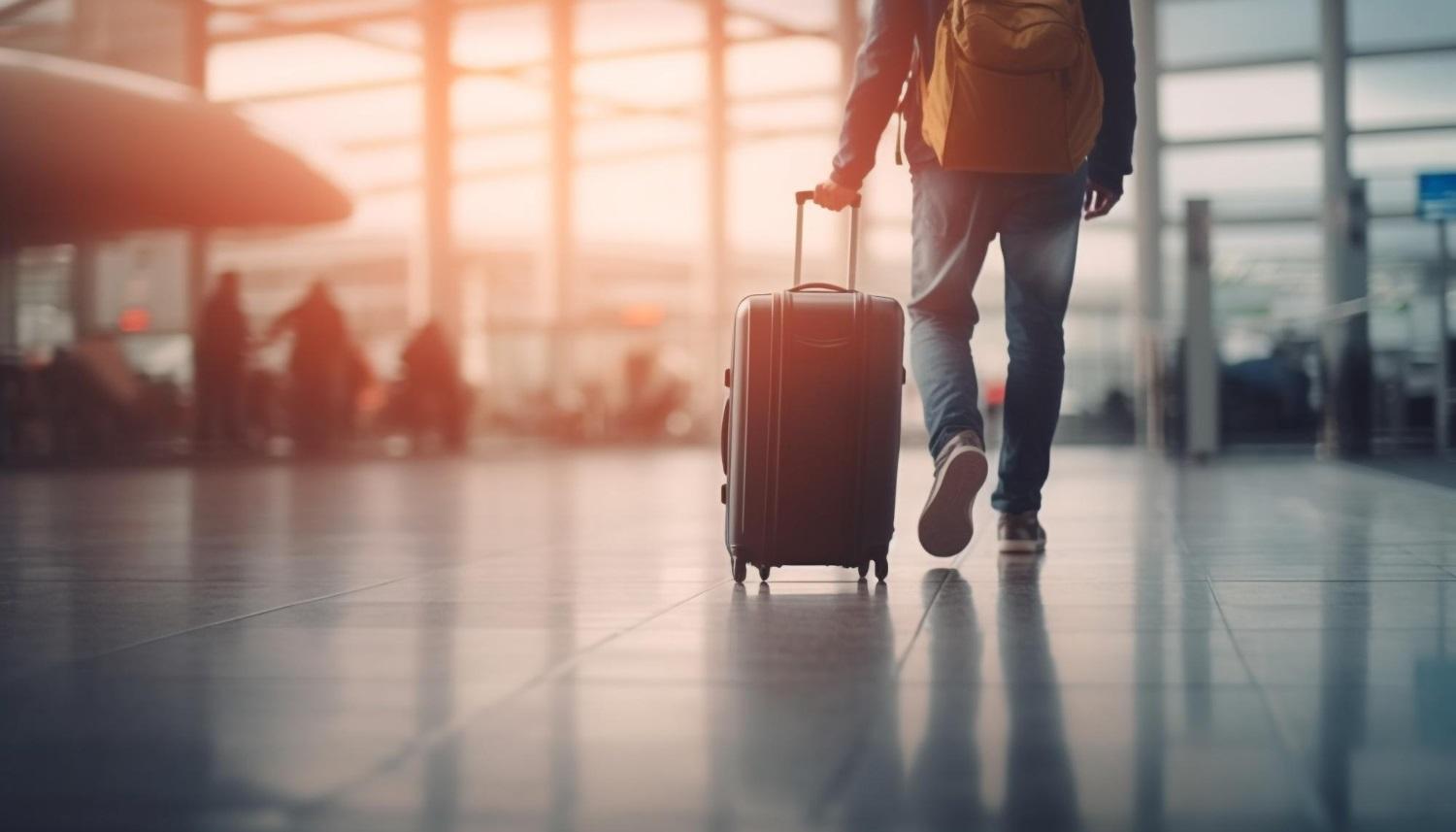
Image: Travelling with The Correct Amount of Luggage to Avoid Extra Baggage Fees
Carry on rules.
One thing that makes some flyers nervous is that once you say goodbye to your luggage, you will not be seeing it again until the pickup terminal at your destination, and you simply have to have faith in the fact that it will show up where you are. There are some ways to mitigate this stress though, and this brings us to the universal carry-on laws when flying. The golden rule is that you should pack anything that will be hard to replace in your carry on, and this can conveniently be placed in the overhead storage compartment of your seat. In the rare event that your bag does miss its destination, at least you can ensure that all your important documents, prescription medicines and other crucial items do not get lost and trust us when we say that it’s not fun being stuck without these in a foreign place.
Items you’ll also want to have close to you during a flight will include things like your laptop, headphones and maybe a book to keep you entertained. When putting things like contact lens solution in your carry on, remember to bring a travel size bottle, and keep in mind that your checked carry-on luggage should be able to fit in the overhead compartment space or underneath your seat.

Image: A Flyer Enjoying Listening to Music on Her Carry-on Headphones to Stay Entertained During a Long Flight
As you can expect, time is of the essence when catching a flight, and there are general time rules for flights that everyone follows. Catching a flight is nothing that getting onto a bus or train, and due to all the lengthy check in, scanning and boarding processes, it’s recommend that you show up to the airport at least 2 hours before your flight takes off, and for international flights, it’s better to be on the safe side and arrive at least 3 hours prior.
Last Minute Advice
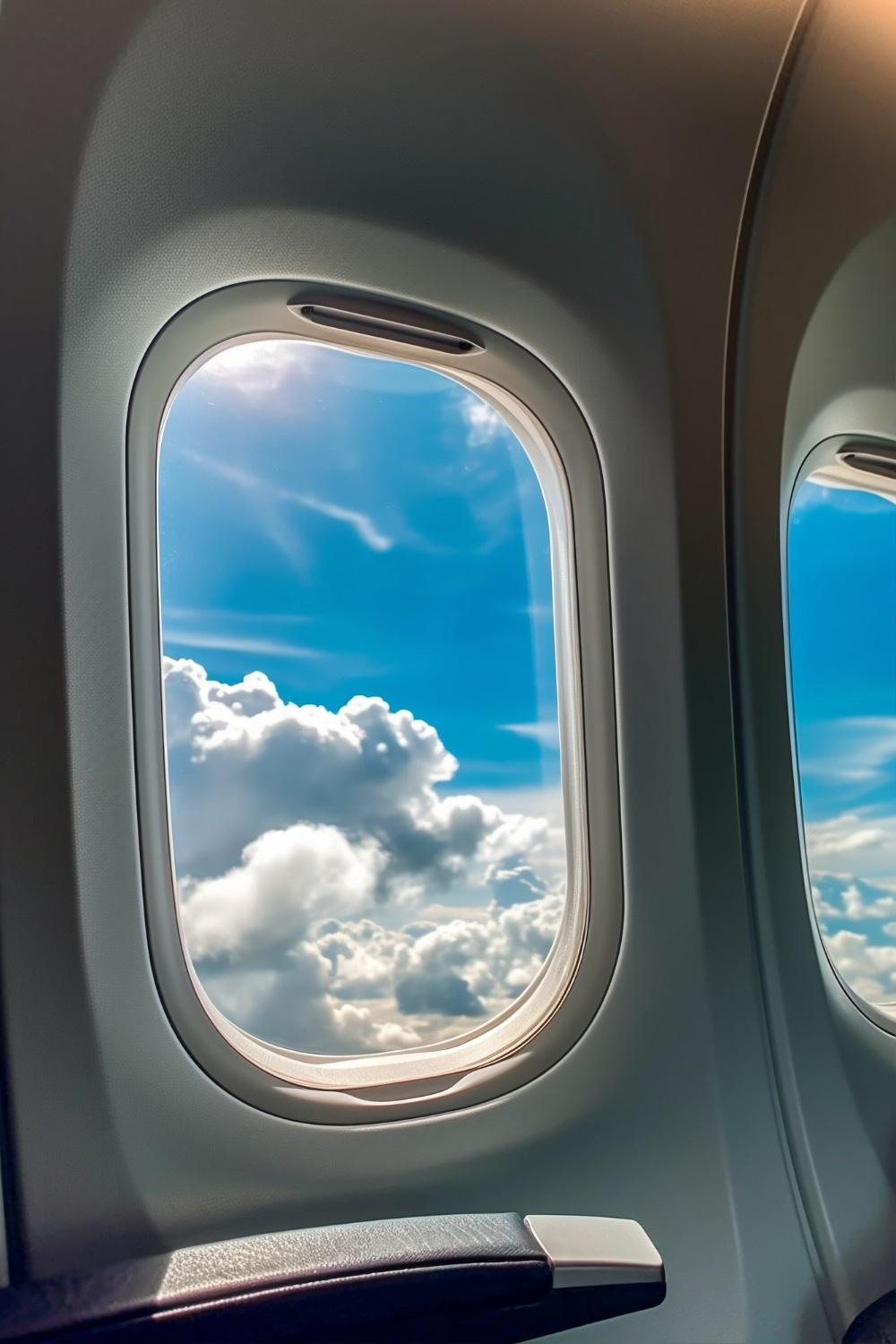
Image: The Gorgeous View You Can Look Forward to When Embarking on Your First Flight
Embarking on your first flight is often something that leaves one feeling quite nervous, but by simply remembering these tips for your flying, you will be set to have a great travel experience.

You May Also Like

A Family Travel Blog That Reviews Leading Hotels Around The World.
We are a family of 4 - mother, father and two children. Our aim is to travel the world and review all travel opportunities to help other families.

Top Rated Hotels

Subscribe to our family travel blog Newsletter
If you want the latest information on the best Hotel Executive Club Lounges, Hotel Kids Clubs and other travel information, be sure to sign up for our free newsletter full of tips and great travel ideas.
Executive Club Lounges

Travel Blogs

- Privacy Policy
- Terms and Conditions
- Cookie Policy
- Work With Us
- HTML Sitemap

10 Helpful Tips For First Time Flyers
Planning to go on your first flight? Then read this helpful list of tips for first time flyers just for you.
I know that flying for the first time can make some people really nervous. That doesn’t have to be you. Nerves can often be calmed when your big questions are answered such as: when should you be in the airport if your flight is at XX o’clock? What can you bring and what can you NOT bring to the airport?
It’s normal to have many questions. And there’s no need to be embarrassed to ask them!
But if you want a clear list of flying for the first time tips, then you’ve come to the right place.
Read on to see our list of advice for first time flyers based on our own experience as a traveling family of six, below.
THIS ARTICLE MAY CONTAIN COMPENSATED LINKS. PLEASE READ OUR DISCLAIMER FOR MORE INFO. THIS POST WAS WRITTEN BY JILL GREISING-MURSCHEL , A FAMILY TRAVEL AND RV LIVING EXPERT.
Tips for First Time Flying
Are you getting ready for a flight? Is it your first time flying? Don’t worry, we’ll guide you through it with this list of first time flyers tips, followed by tips for flying with your kids for the first time.
1. Book Your Flight Ahead of Time
Try not to wait until the last minute to book a flight. You’ll be stuck paying WAY more than if you booked your flight at least one month in advance. Two or three months early will often give you an even better price.
2. Pack Well
Decide if you are going to ‘check a bag’ or two, or take a small suitcase or carry on bag that will fit in the overhead carry-on compartments or you’ll be leaving in the check in counter. If you choose to travel light and use a small carry-on suitcase, you can also carry a purse or small laptop bag as well. It’s a way to make your time at the airports faster, but it also limits you on what you can bring.
Per TSA regulations if you’re flying within the USA, your carry-on luggage or checked bag cannot have any containers larger than 3 ounces carrying liquids such as hair spray, toothpaste, etc.
If you’re going on a long flight, then be sure to leave room in a carry-on suitcase or backpack for great travel accessories for long flights .
3. Learn the Dos and Don’ts
What can you bring and what is not allowed? If you’re bringing your dog, will you be visiting pet-friendly airports along the way? What’s the maximum baggage weight? Can you bring your child’s stroller on the plane? These are the technicalities that are important for every traveler.
You wouldn’t want to have problems with the weight limit when it’s minutes before the boarding, right?
It only takes a few clicks on your airline app, which you hopefully downloaded when you booked your flight, to find out the technical rules for the flight you’re taking.
4. Prepare Important Documents
Some important documents are absolutely needed for you to get on your scheduled flight.
These can include passports, identification cards, travel visas, a negative test, boarding pass, and others depending on the type of flight, whether it’s an international or domestic flights you’re taking and where you are traveling to and from.
Especially if you’re going on an international flight with connecting flight where airport security is stricter, so you must prepare these documents carefully. Keep them all in a separate document pouch or wallet, and make sure to bring multiple copies of each in case any get lost or damaged.
5. Check-in Online
Airlines these days offer online-check in as an option. You can check-in 24 hours before your flight and choose a seat if your ticket allows you to. This will save you time since you won’t have to line up at the airport to do the traditional check-in process.
I’ll say that this is one of the best advances in the flight process so far since it’s convenient for every passenger. Just remember that if you’re going to check a bag, and not fly carry-on only like our family often does, you will need to arrive with enough time to check your bag.
6. Wear Comfortable Clothes
Flying is just like any other form of travel—it can take super long. So even if there are good seats, it wouldn’t take away the fact that you’ll be sitting there for hours.
Dress in comfortable clothes anytime you are flying. I always suggest dressing in layers, because many planes can be cold to fly on, while the airports can be very warm.
7. Bring In-Flight Essentials
These are typically what you’d also bring as classic road trip essentials . A book, snacks, download a great podcast or watch an in flight movie.
Of course, don’t forget your neck pillow and noise-canceling headphones with a cord , so that you can plugin to in flight entertainment which most airlines now have.
8. Get to the Airport Earlier
Never plan to arrive there just on time, give some extra time for unexpected factors like traffic, long lines through security, or anything else that might come up.
Giving yourself extra time is also one of the really important first-time flying tips that we can think of. By arriving earlier, you can have the time to familiarize yourself with the actual airport, grab a bite to eat, and feel rest assured that you made it on time. You can then use this as a reference for your next flight.
9. Use Any Help You Can
Airport staff and employee such as flight attendant is there to guide you. If you feel like you’re lost, don’t worry and ask the nearest worker for directions.
They won’t hesitate to help and can get you where you need to be asap.
10. Drink Water
While in the airport and on your flight, remember to stay hydrated. Especially if it’s a particularly long flight.
Tip : Bring an empty water bottle then fill it up ONLY when you’re beyond security. This is protocol actually. Doing this can also save you some money since not all flights offer free drinks on board.
Really, everyone else that you see in the airport has experienced going on their first flight. Some may even be going on their first flight at the same time as you.
So don’t be too anxious about it. If you’re a little nervous about the flight itself, then relax into your seat and turn on some music or listen to a podcast when it’s time for take off and landing. That way you can stay calm and remind yourself that flying is so much safer than driving.
Tips For Flying Long Hauls With Kids
We’ve talked about tips for flying with toddlers in a previous post , but now we’ll share some additional tips that are more general on taking long flights with kids for the first time.
1. Be Flexible!
2. Get sleep ahead of time, and be prepared to nap when the kids sleep on the plane.
3. Drink coffee or caffeine if you can when you aren’t sleeping to be attentive.
4. Don’t plan to get ‘anything done’ while on the flight such as reading your favorite book or getting work done. The kids will need you.
5. Flight attendants can become your best friend. Ask if you need something like a snack, extra water, or a pillow for the kiddos.
6. Long layover with kids? Find an airport playground or an area for them to run around and burn off their energy.
7. Try to board the plane early with other families, even if your youngest is a bit older than 2 years old. They’ll often say yes and then you can get everything organized and situated on the plane with your family before it’s too busy.
8. Plan for enough time to get through security with your kids.
9. Bring enough snacks on the plane to keep the kids full, and fill your water bottle at the airport before boarding.
Tips for Flying Now: What to Expect
The current situation is kind of different from before, with more protocols and requirements. Here are some tips for first time flyer i n this current situation.
1. Wear Face Masks
This is a requirement for air travel nowadays. So be sure to have one for everyone in your family when you arrive at the airport.
2. Additional Requirements
More documents may now be required for flights. Like a negative test, which is usually needed if you’re flying internationally between countries.
Pay close attention to this since it may be different for every flight.
Also, remember to take note of the additional guidelines for international travel by reading this post by the U.S. Department of State .
3. Monitor your flight status
With these challenging times, canceled flights are not really unexpected . So make sure to constantly monitor your flight status to avoid spending money and time to get to the airport, only to be informed that you won’t be having the flight that day.
We hope that you’ll enjoy your first flight experience with little to no confusion about the whole process. Don’t be anxious, maybe you’ll even learn to love flying after your first experience!
4. Understanding Baggage Claim
Going through baggage claims can be a bit overwhelming for new travelers, especially if you’re going through connecting flights. But with some basic understanding, the whole process is actually pretty straightforward.
First, make sure to double-check your bag tags upon arrival at the baggage area. It’s best to look for your luggage as soon as it comes out onto the carousel and take note of any damage that may have occurred during the flight.
The post 10 Helpful Tips For First Time Flyers appeared first on Let's Travel Family .


An official website of the United States government
Here’s how you know
Official websites use .gov A .gov website belongs to an official government organization in the United States.
Secure .gov websites use HTTPS A lock ( Lock A locked padlock ) or https:// means you’ve safely connected to the .gov website. Share sensitive information only on official, secure websites.
Travel Checklist
Before packing.
- Start with an EMPTY bag (make sure all pockets and compartments don’t have any items in them)
- 3.4 ounces or less per container
- 1 quart size, clear, plastic, zip top bag (all liquids must fit in bag)
- 1 bag per passenger
- Review the prohibited items list for both carry-on and checked baggage.
- If purchasing a baggage lock, be sure to look for those that are TSA recognized.
- Tape a card with your name and contact information on your electronics.
When Packing
- Pack items in layers (shoes one layer, clothes one layer, electronics one layer, etc.)
- Firearms are only allowed in checked baggage and must be unloaded, placed in a locked, hard-sided container and declared to your airline.
- All fireworks contain explosive materials and are not permitted in checked or carry-on baggage.
- Do not pack items such as box cutters, utility knives, and razors in carry-on luggage. Razor blades intended for shaving that are enclosed in a safety cartridge in which the blade cannot be removed are permitted.
- Pack large electronics on top layer of carry-on for screening accessibility.
- Place your 3-1-1 bag with liquids, gels and aerosols in the front pocket of your carry-on for accessibility.
- If traveling with a pet, be sure to bring a leash so carriers can be properly screened.
Before Leaving for the Airport
- Give yourself enough time to arrive at the airport early.
- Wear easily removable shoes.
- Passengers with a disability or medical condition may call ahead to the TSA Cares toll free helpline at (855) 787-2227 .
Before Entering the Checkpoint
- Eligible passengers look for the TSA PreCheck® lane for expedited screening at participating airports.
- Have your ID and boarding pass out for inspection.
In Standard Screening Lane
- Remove the 3-1-1 liquids bag and place it in the bin.
- Ensure pockets are empty (keys, tissues, currency, wallets, cell phones, etc.) and remove bulky jewelry (valuable items can be placed in carry-on).
- Remove your shoes and place them directly on the X-ray belt.
- Remove personal electronic devices larger than a cell phone from your carry-on bag and place them into a bin with nothing placed on or under them for X-ray screening. (E.g. laptops, tablets, e-readers and handheld game consoles.)
- Remember to check the bins and collect all belongings after going through screening.
Download PDF version
I've traveled to over 80 countries by myself. Here are 8 things I do to stay safe.
- After traveling solo since I was 18, I've hit over 80 countries.
- I've made my fair share of mistakes, but I've learned how to stay safe while traveling alone.
- Simple measures, like sharing my location, have helped me avoid unwanted situations.

I've been traveling on my own since I was 18. After visiting over 80 countries and 13 years of trial and error, I've learned a few important safety tips.
Although flight prices seem to be rising ahead of the summer surge, they're significantly cheaper than this time last year, so I'm itching to plan my next trip.
I follow these rules everywhere I travel — it doesn't matter how upscale or "safe" the destination is supposed to be.
Although some situations are unavoidable, here's what I do to stay safe and alert while traveling solo.
I always share my location and itinerary with someone close to me.
Before a trip, I always share my flight and hotel information with my mom. I've also gotten into the habit of sharing my live location with her (indefinitely).
Other than the fact that it gives her a sense of security, I know that if anything were to happen (or if she doesn't hear from me when expecting to), she would have enough information to make a few calls and confirm I'm safe.
It only takes a few minutes but can make a huge difference in the long run.
Wearing a flat crossbody or belt bag under my clothing is key.
I always avoid wearing backpacks and those trendy see-through bags — there's no need to make someone curious. I don't like having my purse and valuables super exposed because it makes me a prime target for pickpockets.
Although it's easier to wear belt bags in colder environments when I'm wearing layers, I can still manage in lighter clothing.
Lululemon's Everywhere Belt Bag, Athleta's Pacesetter Run Belt, and Peak Gear's Travel Money Belt have been my go-to for traveling . They're small and thin enough to wear under my clothing but can hold my essentials (cash, credit cards, a phone, my passport, and copies of my ID).
I don’t wear my expensive bling or designer pieces.
I typically want to look good for photos, but wearing expensive clothing and stand-out jewelry always attracts unwanted attention.
Wearing shiny necklaces and a stack of bangles while sporting a Gucci tracksuit makes it look like I have money, which is the opposite of what I want someone to think when I'm traveling alone.
It also means I'm less likely to successfully negotiate or barter a good price on items in markets.
There are basic things I research about each city or town I’ll be staying in.
I'm a super spontaneous traveler. Although I usually have a list of places I want to visit, I rarely follow a day-by-day itinerary.
Regardless, once I know where I'm going, I always take time to plan which area to stay in and book hotels in advance . I try to find the best neighborhoods, then I explore a list of hotel options and select them based on reviews, location, and overall vibe.
I also always ask the front desk staff if there are any areas I should avoid once I check in — not everything is online.
Sometimes, I'll even look for female-oriented hotels or ones with mostly female staff members because that makes me feel a little more comfortable.
Looking lost or scared is asking for trouble.
How you carry yourself is a big deal. If I'm lost, I typically use the Maps.me app, which allows me to use maps even while offline.
I try to pop into a coffee shop — or even a bathroom stall — to look at the map and get my bearings. If I can't find a place to make a pitstop, I'll walk to a more populated area with lots of traffic.
If worse comes to worse, I'll just hail a taxi to take me back to my hotel.
Looking lost makes it pretty obvious you're a tourist and gives the impression that you're willing to accept help from anyone. Unfortunately, some people take advantage of situations like that.
For the same reasons, I also never walk around looking frightened, even if I'm freaking out on the inside.
There are different transportation apps all over the world, so I make sure I have the right one.
Not everywhere has Uber or even many taxis. I always look up popular transportation apps wherever I'm traveling and download them on my phone.
I usually even enter and save my credit card information, so I'm ready to roll and don't find myself stuck when I reach the destination.
I make sure I have enough cash with me.
I've traveled to places where credit cards aren't widely accepted, or I can't withdraw cash from ATMs.
To avoid that panic, I always carry cash and exchange it for the local currency at the airport or hotel.
I don't keep it all on me when I'm exploring — I just carry some with me and leave the rest safely locked in my suitcase.
I've learned to not say yes to everything.
When I travel alone, I'm bound to meet new people, and sometimes they invite me to parties or for drinks. But I always politely decline.
Nothing good has ever come from drinking with strangers in a foreign place, in my experience. And I always want to be clear-minded enough to pick up on strange or dangerous situations.
I don't even share my plans with strangers I meet, and I never post my real-time locations on social media.
It might seem obvious, but I also don't accept rides from strangers because then they'll know my whereabouts.
- Main content
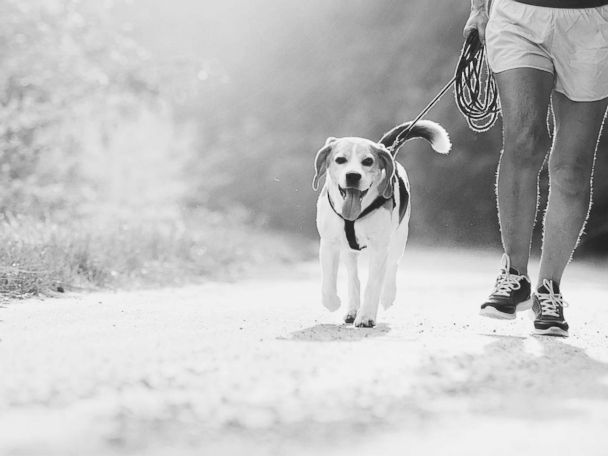
Lifestyle News
When and where to see june's full strawberry moon, 105-year-old graduates from stanford, justin timberlake arrested, charged with dwi, school district votes to ban phones for students, kevin costner addresses rumors about his love life, mom's attention helps save daughter's vision, gay couple speaks out after filing lawsuit against new york city for ivf benefits.
Their lawsuit claims the city violates civil and constitutional rights.
Jason Momoa, daughter arrive in theme on motorcycle at 'The Bikeriders' premiere
Momoa spoke about his passion for motorcycles at the event.
Barack Obama says Michelle told their daughters to avoid a career in politics
The former president and first lady are parents of two.
Chef Gordon Ramsay shows bike helmet after serious accident: 'I'm lucky to be here'
The father of six shared a vital safety reminder for any bicyclist.
Latest Lifestyle Video
2nd largest us school district to ban cellphones, mom and nicu babies were celebrated with a graduation ceremony, what makes finland the happiest place on earth new program shares secrets, 105-year-old takes home stanford master's degree, ‘gma’ helps theme park enthusiasts find unclaimed cash, taraji p. henson shares advice for kids struggling with their mental health, what to know about june's full strawberry moon and what it means for you, 1-year-old communicates adorably with sister who is deaf, 105-year-old stanford university student earns master's degree, family surprises daughter with mariachi at graduation ceremony, this brother shaved his head to support his sister before her chemotherapy, chef frances tariga cooks up okoy, her filipino fritters, latest lifestyle headlines, cancer survivor writes book about finding love and strength through fatherhood, ‘the dad gang’ builds safe community for father’s day, macedo method's new hack for solving the mealtime marathon, camels escape from petting zoo at ohio amusement park, toronto mom goes viral for skateboarding at 43, the ali forney center boasts largest shelter for lgbtq+ youth in us, how to stand out while looking for a new job, best glam products for summer, challah back girls bake and break bread for good, bestselling author isabel allende releases first-ever children's book, celebrating jewish heritage month, part of the pack: goat goes for a walk with a couple of dogs, memorial day deals for the entire family, some women say they are going into debt from bridesmaid duties, more grandparents are raising their grandchildren, and support is crucial, florida school bus driver spreads positivity on his route, by the numbers: working from home and the rise in online shopping, this summer’s road trip essentials, on the water for dragon boat racing, adelaide zoo welcomes cape porcupine brothers, the right stuff: mother’s day favorites, by the numbers: millennials & generation z wealth, man proposes to girlfriend while scuba diving off fiji coast, mix it up with some of our favorite blenders, baby gorilla gets tickled by mom at texas zoo, eco-friendly products you can use at home, mortgage rates back above 7%, ‘intersectional environmentalist’ addresses racial inequity in environmental issues, going green in the kitchen, the power of us: plastic-free school lunch, the right stuff: rock out while you work out with these headphones, ask alexis: taxing social security checks and saving money on summer camp, surviving the spring showers, 5 monkeys found hidden under passenger seat of truck driven by alleged smugglers, woman builds custom 'dog train' to take disabled pups on daily rides, freshening up bathroom essentials, how to view the solar eclipse safely, how to get motivated to jump-start your spring cleaning, author talks debut memoir 'the mango tree: a memoir of fruit, florida, and felony', police chase runaway ostrich in south korea, how to have a more climate friendly easter, dog frolics through snow in lake george, the best travel accessories for your spring break vacation, by the numbers: chocolate prices spike before easter, actress tabitha brown on her career, new book and staying motivated, find the best pillow for the best sleep, tips to help your kids’ sleep routine, dishing on hollywood's best beauty devices, how to eliminate grocery waste, get a head start on spring cleaning with these must-haves.
- Zoo weighs, measures all of its animals in adorable event
- Cutest baby animals from around the world
Suggested Interests

IMAGES
VIDEO
COMMENTS
Arrive at the airport early. Most airlines recommend arriving at the airport three hours before an international flight or two hours before a domestic flight. If you're a first-time flier, give ...
First Time Flyers Tips: How to Board the Plane. 27. Listen for Announcements. Approximately an hour before your flight departure, start listening for boarding announcements. The exact time they begin boarding should be listed on your ticket, but depending on if there are any delays, this time may change. 28.
Prepare your inflight entertainment by downloading shows, movies, books, or podcasts. Dress properly for the flight with a light sweater and check the weather in your destination. Prepare your foreign currency if necessary. Check in online 24 hours before your flight or arrive early at the airport.
Checking your bag at the gate means your full-sized carry-on bag will travel with the other checked bags during the flight, rather than in the overhead bin. 3. Arrive at the airport two hours ...
24 Keep your passport, ID and boarding pass handy. There are many first time flyers tips and this one is important. You want to decide on one place to keep your passport, ID and boarding pass and keep them there at all times. This needs to be someplace that you can easily retrieve and then put away quickly.
First time flyers tips: Make sure to check in online as soon as the check in opens. This will allow you to select your preferred seats. ... She travels full time with her husband and is passionate about creating in-depth travel guides. Cory published her first book on Japanese customs and manners because she's obsessed with everything Japan ...
In-flight accessories can really make the difference. Bring a travel pillow, sleep mask, blanket, ear-plugs or whatever you need to stay comfortable. 13) Bring your own entertainment. Create a music playlist on your phone, take a book to read or bring a device to watch your favourite TV shows and films on.
Best Tips for First-Time Flyers. 1. Check-in online. Most airlines allow you to check in online up to 24 hours before your flight. This will help you avoid long lines at the airport and give you a better chance of avoiding a middle seat assignment.
Travel tip: Bring an empty water bottle to fill up once you pass security. 29. Listen to the Safety Briefing. Listening to the safety briefing on the airplane can help calm your nerves during a flight, especially if this is your first time flying!
Arrive Early. A tip for first-time flyers that most airlines will tell you themselves is to arrive early for your flight. The recommendation is to arrive at the airport 2-3 hours before your flight is scheduled to leave. If you know you live somewhere with a busy airport, you may want to adjust that accordingly.
With this post, you'll get all the necessary tips for first-time flyers from carry on luggage rules to how best you can handle flying anxiety. So without any further ado, let's look at the best things you should know if it's your first time flying on a plane. Related post: Important travel tips for first time travelers. First Time Flying Tips
We've packed in our best travel tips for first-time flyers based on the collective experience of our staff, so climb aboard and let's get you ready for the flight! These flight tips cover most major airlines like American, United, Delta, Southwest, etc. For budget airlines like Frontier or Allegiant, you'll see some variance in items like ...
There is a boarding time, a gate close time, and a departure time for your flight. You must be at your gate before the gates close which is usually around 15 to 20 minutes before the scheduled departure time. 50. Beware of "Juice Jacking".
That said, you need to allow ample time to get through the sometimes incredibly long security line (which comes after check-in but before the gate area), so cutting it too close could turn your first flight into your first panic attack. If you need to travel a longer distance to get to the airport, give yourself at least another 30-minute buffer.
Boarding the Plane. Make sure you are near your gate close to the boarding time. The airline staff will first call people with children, elderly people, and people with disabilities to board first. Next, airline staff will call people up for boarding zone by zone. You can find your zone on your flight ticket.
The general rule of thumb is that you should arrive at the airport at least two hours before your flight for domestic flights, and three hours for international flights. This will give you plenty of time to check-in, go through airport security, grab a snack, run to the restroom and get to your gate.
Tips for first time flyers. One of the advantages of being old and crusty is that I've flown enough times to have learned all the tips and tricks necessary to get to the airport (and to my destination) as stress-free as possible. These are my most helpful tips for the nervous first time flyer: 1. Before heading to the airport.
To help ease your journey, here are some essential tips for first-time flyers: 1. Plan and Prepare. Before your flight, make sure you have all your travel documents such as your passport, boarding pass, and identification. Double-check your flight details, terminal, and gate information. Arrive at the airport well in advance to allow for ...
It doesn't take much to get good at flying. And once you've ingrained the tips for first-time flyers into your brain, all that's left is a few extra steps that can take you from an anxious first-timer to a calm and collected frequent flyer. 1. Join an Airline Rewards Program.
Here I share 71 first time flyer travel tips. it's understandable to feel a little nervous, but with proper planning and preparation, your journey can be smooth and stress-free! In this travel guide, I'll provide you with all the essential information you need to know before boarding your first flight, from booking your ticket to navigating ...
10. Sleep well in flight. Eye mask, earplugs, and neck pillows are great for sleeping during your flight. Having a neck pillow is particularly useful because it offers support and it prevents your head from flopping around while you sleep. 11. Be smart in handling conversations.
These top tips for first-time flyers will ensure you can board your plane without any jitters, so don't miss out! Image: The Excitement of Taking Off into the Skies on Your First Flight Travel Savvy Trips Travel Insurance One of the most widely spread travel tips that everyone should live by is to get travel insurance, and even though some ...
Tip 14: Distract Your Mind in the Air. One of the best tips for nervous first time flyers is to distract your brain once you're in the air. Engaging your mind in an activity will lessen your focus on your fears. Try to find an activity you enjoy for an immersive experience that will take your mind off the flight.
2. Pack Well. Decide if you are going to 'check a bag' or two, or take a small suitcase or carry on bag that will fit in the overhead carry-on compartments or you'll be leaving in the check ...
Before Packing. Start with an EMPTY bag (make sure all pockets and compartments don't have any items in them) Liquids, gels and aerosols packed in carry-on must follow the 3-1-1 liquids rule: . 3.4 ounces or less per container; 1 quart size, clear, plastic, zip top bag (all liquids must fit in bag); 1 bag per passenger; Review the prohibited items list for both carry-on and checked baggage.
I've been traveling on my own since I was 18. After visiting over 80 countries and 13 years of trial and error, I've learned a few important safety tips. Although flight prices seem to be rising ...
Get the latest lifestyle news with articles and videos on pets, parenting, fashion, beauty, food, travel, relationships and more on ABCNews.com